

The PERFECT 1, 2 or 3 Week Australia Itinerary [2024]
- Last Updated: January 30, 2024
Whether you have 1, 2, or 3 weeks in Australia, here are some suggestions for an Australia itinerary that will help you make the most of this huge, diverse, and stunning country!
Planning a trip to Australia can be quite difficult, simply because the country is so huge.
Lots of its best attractions, cities, and natural landmarks are very spread out, so it’s impossible to see everything in a short amount of time.
Australia is also an expensive country to visit, so most backpackers and average travellers won’t be able to visit every single point of interest without spending a lot.
Despite these challenges, planning an epic trip to Australia is definitely possible.
You just have to be smart about your Australia itinerary, sticking to one or two major areas and picking travel routes that are logical.
For example, you won’t be able to fit Sydney, the Great Barrier Reef, Melbourne, Uluru, Tasmania, and beaches and national parks of Western Australia and the Northern Territory into a 1 week Australia itinerary.
To see all those incredible places, you’d need at least one month, and even then you’d be rushing to get everywhere.
What you can do, is pick the areas that appeal to you the most and plan your trip accordingly.
READ MORE: Check out our comprehensive guide with everything you need to know about travelling in Australia !
So you’d be better off picking either the east coast or the west coast and hanging around there if you only have 1 or 2 weeks in Australia.
In this article, I’ll provide a few sample Australia travel itineraries.
Each Australia itinerary will include a few of the country’s best places to visit, while maintaining reasonable travel times.
Whether it’s your first trip to Australia or you’ve been here for a while, there is always something incredible to see!
Table of Contents
How to Get Around Australia
Days 1-2: sydney, days 3-5: brisbane , days 6-7: airlie beach and the whitsundays, days 1-3: sydney, days 3-6: melbourne , day 7-8: the great ocean road, day 9-10: adelaide, day 11: kangaroo island, day 12-14: perth, days 3-4: byron bay, days 5-6: the gold coast, days 7-8: cairns, days 9-10: port douglas and the great barrier reef, days 11-13: cape tribulation and the daintree rainforest, day 14: darwin, days 15-17: kakadu national park, days 18-20: uluru and the red centre, the ultimate australia itinerary travel guide.
Having travelled all around the country, we’re excited to share these epic 1, 2 and 3 week Australian itineraries that’ll cover the best places around.
But first, a tip…
It’s also important to consider how you’ll get around Australia during your visit.
As I mentioned, the country is huge and public transport like buses or trains is expensive.
If you’re staying in one area, it’s worth renting a car for a few days so you can explore and do day trips, but driving from one city to the next may take 12+ hours of driving.
The best way to get around is to rent a car and explore on your own! We recommend Rental Cars , which has the largest range of vehicles for the best value on the market.
Catching cheap domestic flights is the best way to jump from one state to the next, and you can take public transport or drive within smaller areas.
Though every traveller will have their own unique preferences and modify these itineraries as necessary, here are some sample Australia itineraries that will hopefully help you plan your dream trip!
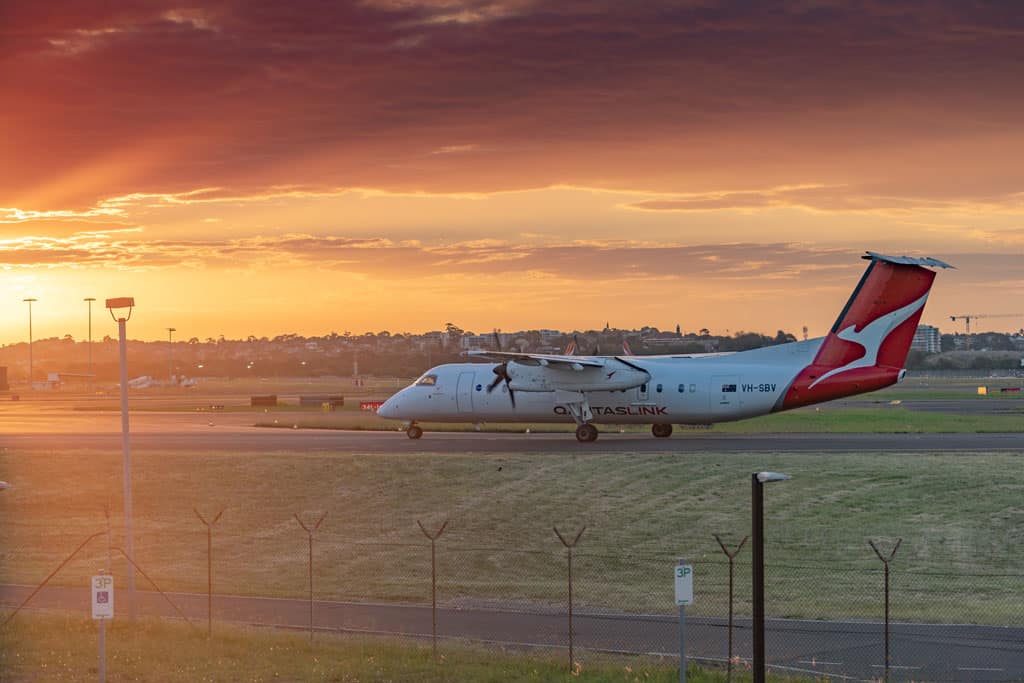
7 Day Australia Itinerary
One week in Australia goes by quickly, but some people can’t afford to take much longer off of work or their other responsibilities.
You can still manage to experience some of the Aussie culture and natural beauty in one week.
In this 7 day Australia itinerary, you’ll be sticking to the middle east coast.
You’ll begin in Sydney, then head up to Queensland to enjoy the Great Barrier Reef.
This plan is perfect for 7 days in Australia because it doesn’t require huge amounts of travel time.
READ NEXT: 25 Amazing Things to Do in Australia
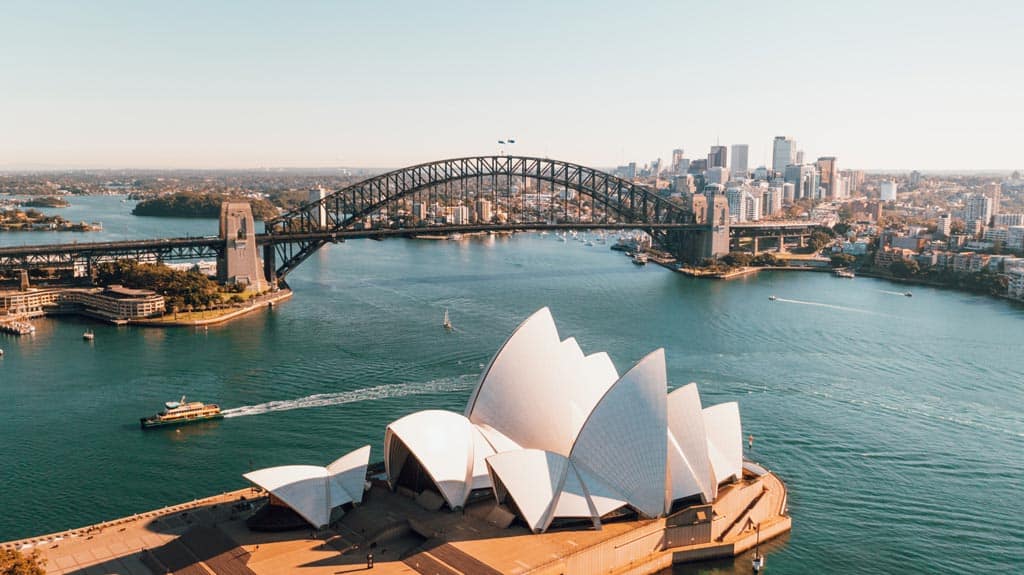
After arriving in Sydney and getting settled, you have two days to enjoy the city.
You can spend one day visiting all the popular tourist attractions, like the Sydney Harbour Bridge, the Sydney Opera House, Sydney Tower Eye, the Royal Botanic Gardens, and maybe some of the museums.
Another day can be spent swimming and sunbathing on one of the city’s main beaches.
The northern beaches around Manly, or the western beaches around Bondi and Bronte are great options for a fun day in Sydney.
Bondi Beach has a very strong health and fitness scene, so they have lots of incredible healthy cafes where all the locals like to fuel up.
Visit Berri Bar Bondi Beach for a refreshing Acai bowl, Porch and Parlour for a healthy breakfast on homemade bread, or Umu for some nourishing organic lunch bowls.
After 2 days in Sydney, you can catch a quick, 1-hour flight up to Brisbane.
Check out this post on how to spend one day in Sydney if that’s all the time you have.
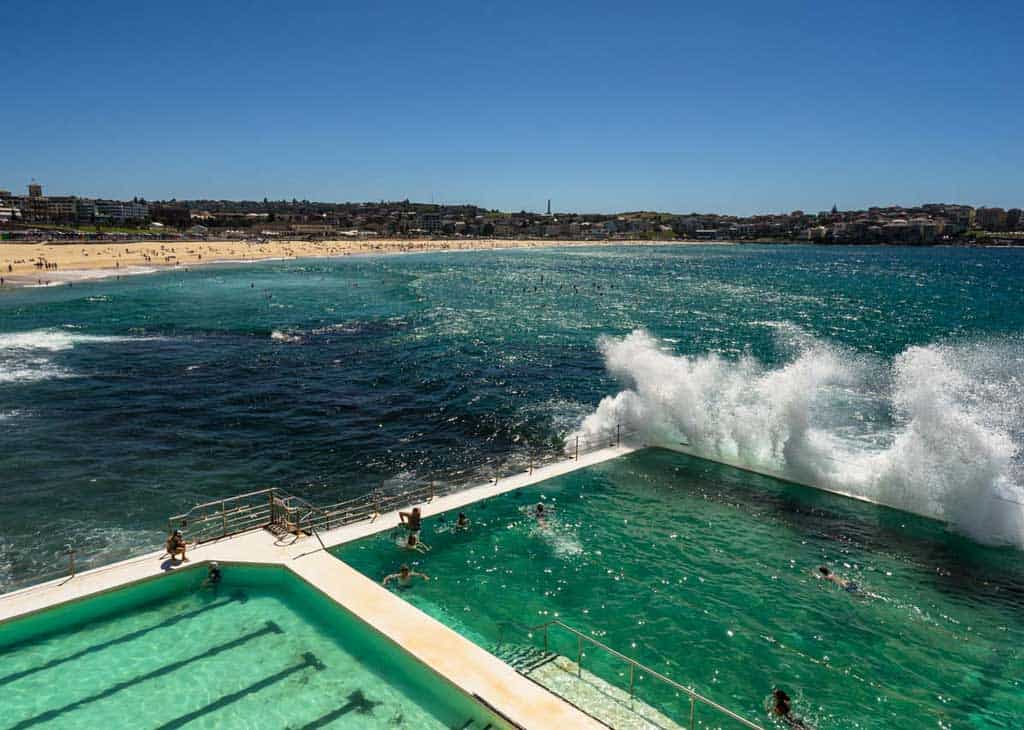
Brisbane is another incredible city to visit in Australia.
After 2 days in Sydney, however, you may be sick of the crowded city streets.
Luckily, Brisbane makes a great gateway for exploring more peaceful areas of Queensland.
There are tons of amazing day trips from Brisbane that allow you to explore nature and see more of Australia, including:
- Burleigh Heads: a charming coastal town with a massive beach and national park
- Hervey Bay: one of the best spots in Australia for whale-watching
- Lamington National Park: full of hiking trails and waterfalls
- Stradbroke Island: a beautiful location that’s great for kayaking, paddleboarding, and trying other water sports
- Fraser Island: the world’s largest sand island
After exploring Brisbane and the surrounding areas, catch another cheap domestic flight from the city up to Airlie Beach.
Read our list of the best things to do in Brisbane for more inspiration!
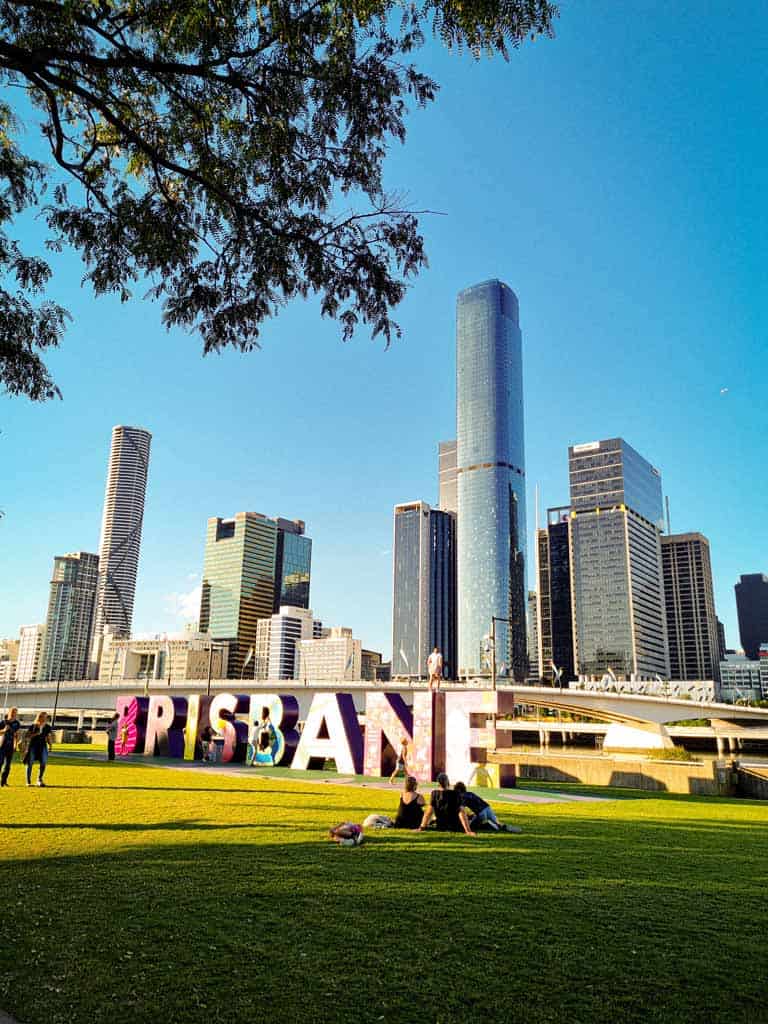
Airlie Beach is known as one of Australia’s most stunning beaches, complete with soft white sand and clear turquoise water.
From here, you can soak in the postcard-worthy views in the Whitsundays Islands and do a day trip to the Great Barrier Reef and the famous Whitehaven Beach.
Book an ocean rafting day tour that include all your snorkelling gear and takes you to Whitehaven Beach and the best locations in the Whitsundays.
BONUS – Booking ahead of time ensures you won’t miss out on the tour, and get the best price too! And just for NOMADasaurus readers, if you use the Klook discount code “NOMADS10” on the website when checking out, you’ll get $10 off your first booking!
Snorkelling, scuba diving, and sailing through the Great Barrier Reef will make an unforgettable ending to your 7 day Australia itinerary.
At the end of your week in Australia, you can fly from Airlie Beach back to Sydney for your departing flight.
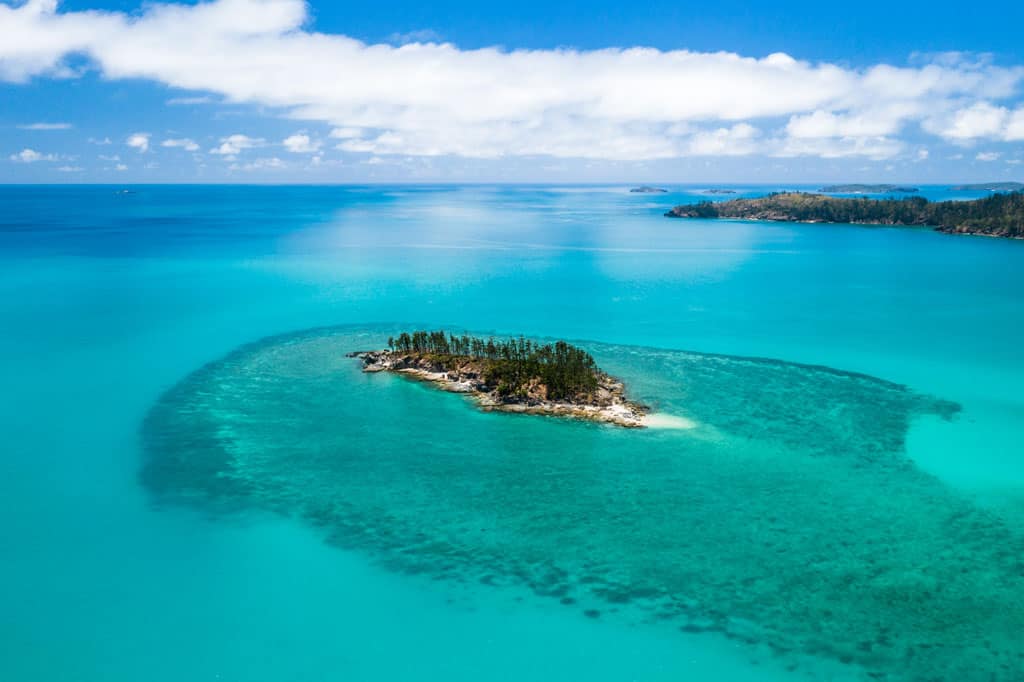
2 Week Australia Itinerary
Two weeks in Australia allows you a bit more time to see different areas of the country.
This two week Australia itinerary will start in Sydney, move down to Victoria to explore Melbourne and the Great Ocean Road , and will then curve up to Adelaide in South Australia and end in Perth in Western Australia.
So with two weeks in Australia, you can still manage to visit 4 states! If you’d prefer to spend more time in one place rather than jumping around so much, you can always modify this.
For example, you could skip Perth and spend a few more days exploring New South Wales, Victoria, or South Australia.
But here is a sample two weeks in Australia itinerary.
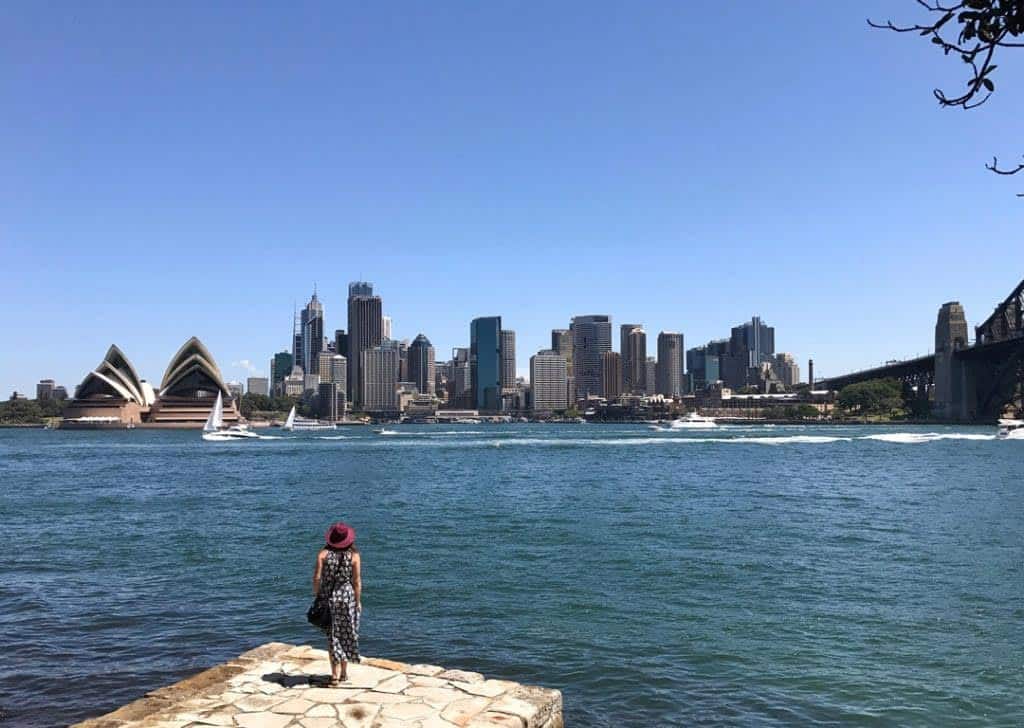
Once again, you’ll fly into Sydney and begin your Australian adventure in the capital city of New South Wales.
In addition to all the touristy stuff like the Sydney Harbour Bridge and the Sydney Opera House and touring a local art gallery, you could spend one of your days in the lush nature surrounding the city.
Two perfect day trips from Sydney are:
The Blue Mountains: Full of waterfalls, scenic lookouts and hiking trails, connected to Sydney by train so you don’t even need a car. Here’s what you should do there .
The Royal National Park: Dramatic coastal scenery with rugged cliffs and secluded beaches. Check out these awesome Royal National Park walks .
After 3 days in Sydney, hop on a plane for a 1-hour flight down to Melbourne.
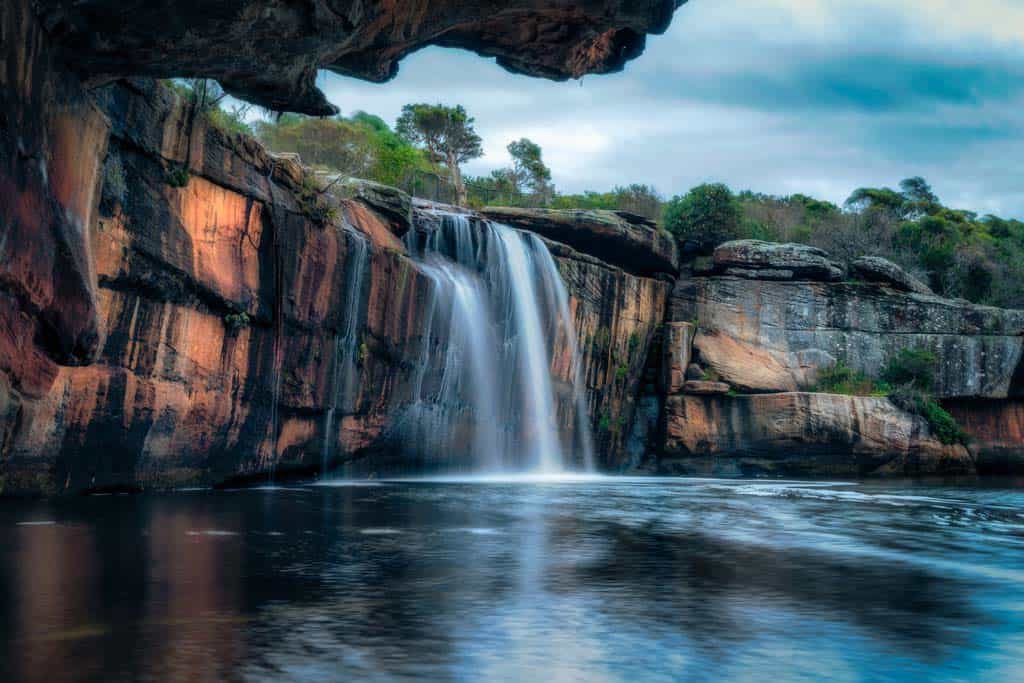
As one of the most vibrant and cosmopolitan cities in Australia, Melbourne is a favourite among travellers and locals alike.
Spend your days in Melbourne visiting street markets, sipping cocktails from rooftop bars, checking out all the cool cafes and restaurants, and experiencing the wild nightlife.
You can also visit St. Kilda Beach in the south of Melbourne, or head to Brighton Beach to photograph the colourful Brighton Bathing Boxes.
Or take a day trip to Phillip Island or tour the Melbourne Cricket Ground .
After you visit Melbourne, continue on to the famous Great Ocean Road.

One of the highlights of Victoria is the natural wonders of the Great Ocean Road.
This coastal road runs for 243 kilometers in total and is full of Australian wildlife, quaint little towns, surfing spots, picturesque viewpoints, campgrounds, and overall gorgeous scenery.
Be sure to see the Twelve Apostles, Split Point Lighthouse, Port Campbell National Park, Apollo Bay, Loch Ard Gorge, and other stunning landscapes along the way.
You can either rent a car from Melbourne and drive the road on your own, or book a day tour .
It only takes one day to see all the best spots along the road, but you’ll need to save some time to make your way back to Melbourne and you don’t want to rush.
You can also stop by the Australian National Surfing Museum in Torquay at the start of the Great Ocean Road.
Fly from Melbourne to Adelaide.
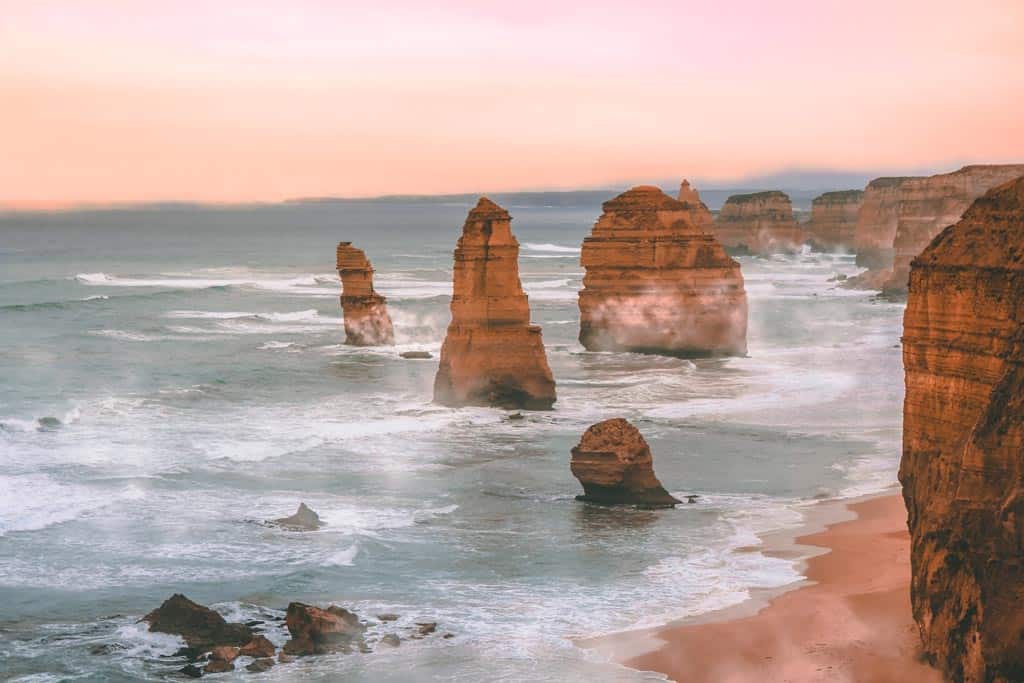
Spend the next days of your two weeks in Australia itinerary soaking in the culture of Adelaide .
Enjoy the delicious food, the museums and galleries, and the laid-back charm of South Australia’s capital.
One of your 2 days in Adelaide should definitely be spent touring a vineyard and wine tasting in the Barossa Valley.
Again, you can either rent a car in the city and drive yourself around the vineyards (make sure you don’t drink too much!), or you can book a day trip.
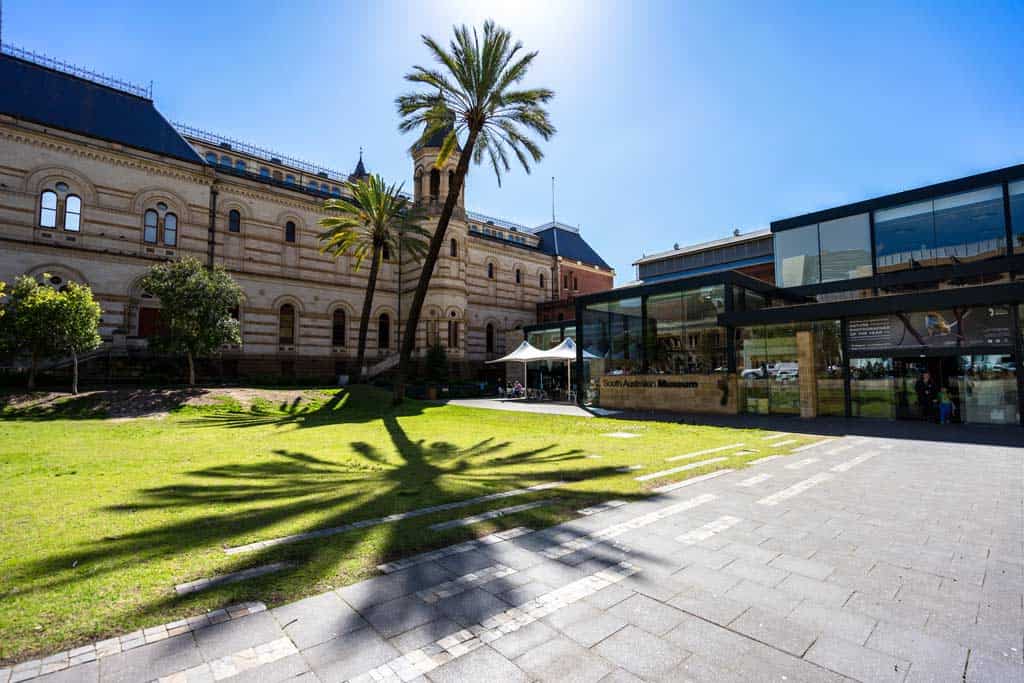
As one of the most unique places in South Australia, Kangaroo Island makes a super fun day trip from Adelaide.
Take photos of the interesting rock formations in Flinders Chase National Park , stroll along the pristine golden beaches, or search for some local animals like wallabies, koalas, and of course, kangaroos.
Head back to Adelaide after Kangaroo Island and hop on another quick flight to Perth to finish up this two week Australia trip.
Read next: 8 Amazing Things to Do in Kangaroo Island, Australia
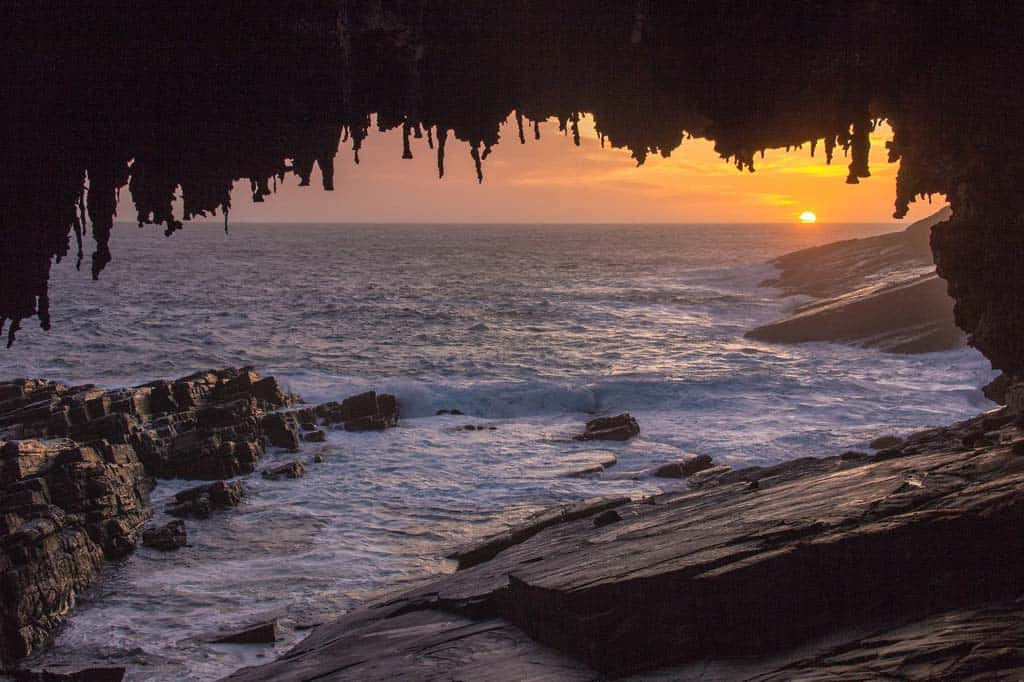
Your last few days of visiting Australia will be well-spent in Perth, the capital city of Western Australia.
Enjoy the beaches, explore the Fremantle Markets, visit wineries and wildlife parks, and more.
You could also treat yourself to one last epic adventure in Australia by taking a day trip to Rottnest Island .
This island is full of fun activities, natural wonders, beautiful views, and cute little quokkas, which are small, native Australian marsupials similar to wallabies.
After a few days in Perth, either catch your departing flight from here or fly back to Sydney if your flight leaves from there.
You could also consider a day trip to Margaret River , one of the top wine and surfing regions in Western Australia.
It’s a 3 hour drive from Perth to Margaret River, so only make the trek if you feel like you have time.
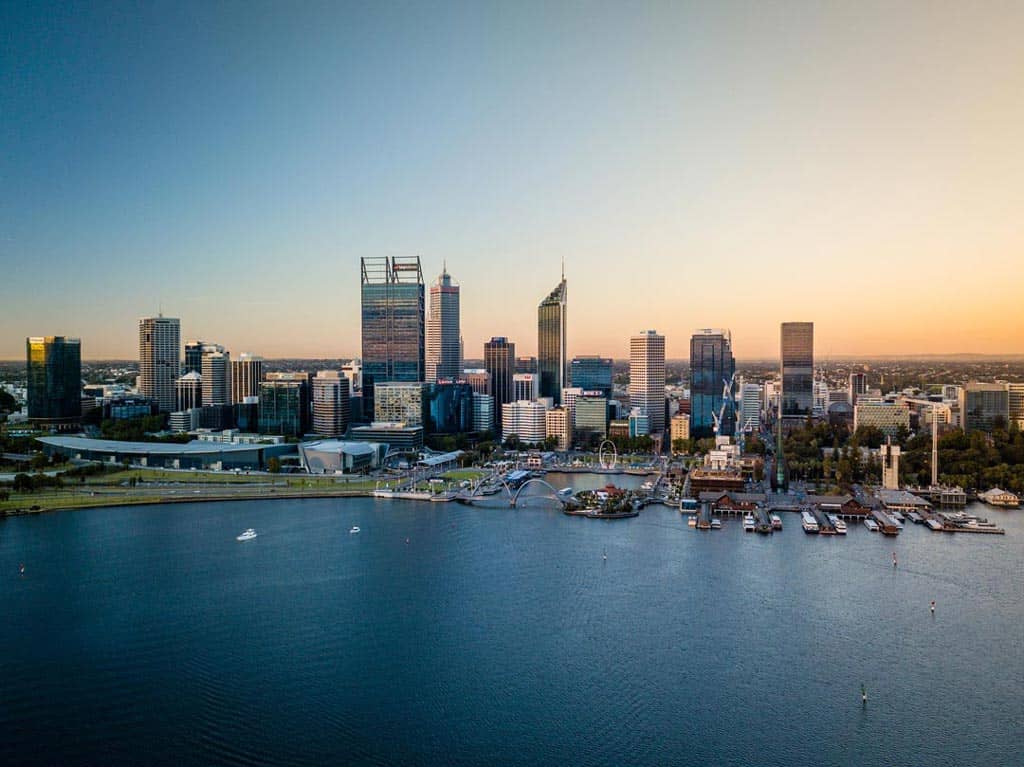
3 Week Australia Itinerary
3 weeks in Australia allows you to visit some big cities and tourist spots, but it also allows you to venture out to more remote and isolated areas.
In this 3 week Australia Itinerary, you’ll visit Sydney and Byron Bay at the start.
Then you’ll head up to The Gold Coast, and tropical north Queensland to the Daintree Rainforest.
Continue your journey up north by travelling to Darwin and Kakadu National Park, and then venture inland to Uluru (Ayer’s Rock).
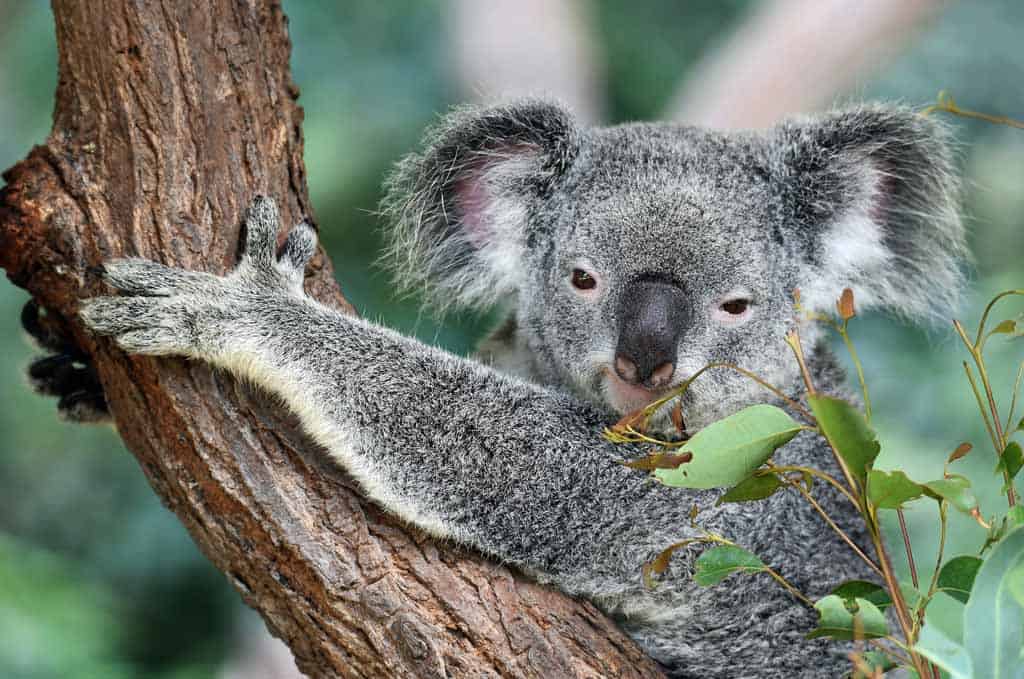
Again, spend your first couple days in Australia checking out Sydney and maybe doing a day trip to the Blue Mountains of the Hunter Valley Wine Region.
Be sure to visit Sydney Harbour, Darling Harbour, and the famous Bondi Beach during your time in Australia’s largest city.
Then fly to Ballina, a small airport 30 minutes away from Byron Bay.
Check out our Sydney to Brisbane road trip guide if you’d prefer to rent a car and drive up the east coast.
Byron Bay is a hub for backpackers, and it is a very fun place to experience when you visit Australia.
From bar crawls and drum circles on the beach, to night markets and street art, to coastal walks and lovely beaches, a couple days in Byron Bay will feel like bliss.
Even if you aren’t on a strict backpacker budget, Byron Bay has so many great hostels that it’s worth immersing yourself in the backpacker scene.
Some of the best hostels in Byron Bay include Wake Up! Byron Bay and Byron Bay Beach hostel.
Both of these have hundreds of great reviews from travellers cost around $30 per night, which is pretty cheap for Australia.
If you want to meet other cool people and take part in all the fun social activities of Byron Bay, you may want to stay in one of these fun hostels instead of a hotel!
You can choose to hang out in Byron Bay for a few more days, or catch a flight from Ballina to the Gold Coast for a taste of the Sunshine Coast surf vibes.
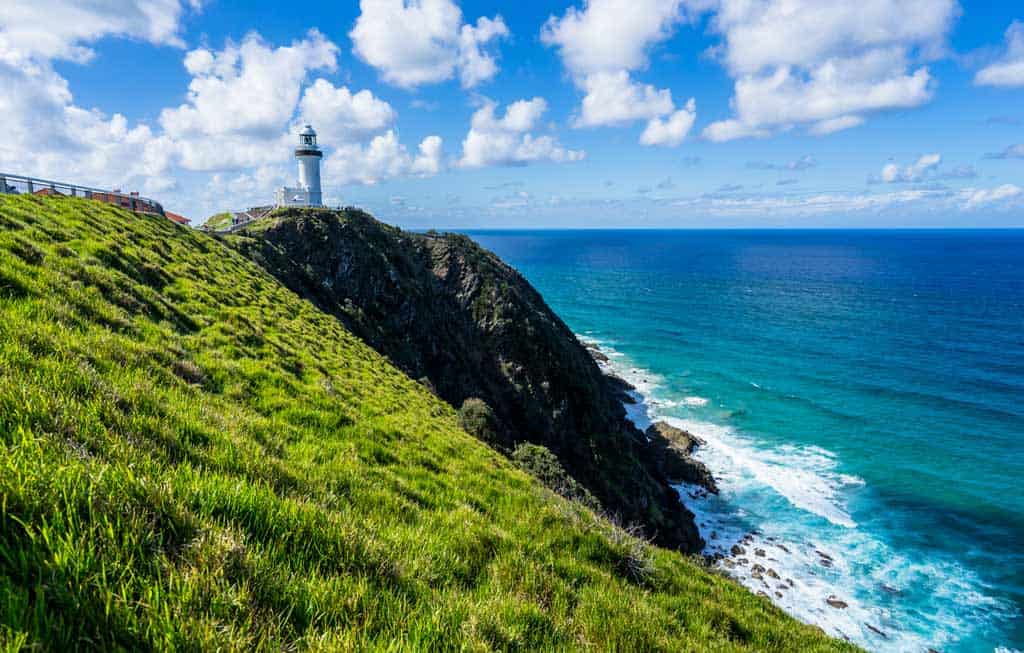
The Gold Coast is one of the best places to learn how surfing when you visit Australia.
You can take a surf lesson from an experienced local and ride the waves, or just relax on the beach, eat some great food, and hit the bars and nightclubs in the evening.
The Gold Coast combines the excitement of the city with the salty air and water sports of a beachside town, so it’s a diverse and fun place to visit.
Fly from the Gold Coast up to Cairns.
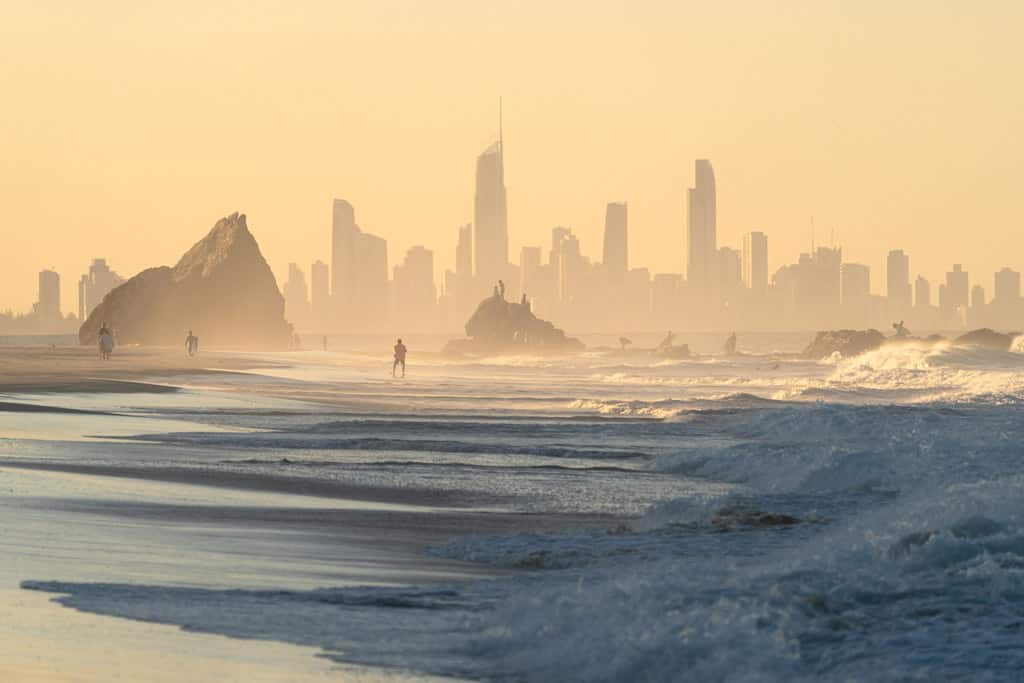
The next few days of your 3 week Australia Itinerary will take you up along the coast of Tropical North Queensland.
This corner of Australia is hot, humid, and jam-packed with rich jungles, Aboriginal culture, waterfalls and the marine life of the Great Barrier Reef.
Keep in mind that during the rainy season, from October to April, you can’t swim in the ocean here because there may be crocodiles and jellyfish.
Cairns is the gateway to tropical north Queensland.
The real beauty lies outside the city, but spend a couple days adjusting to the heat, partying with the many backpackers, shopping at Rusty’s Fruit Market, and swimming in the big public swimming pool called the Lagoon.
Also check out Tjapukai Aboriginal Cultural Park and the nearby Barron Gorge National Park near Kuranda.
Then you’ll take the local bus up to Port Douglas. You can buy your bus ticket from any tourism agency or from the main bus station, and take the Cairns to Cooktown route.
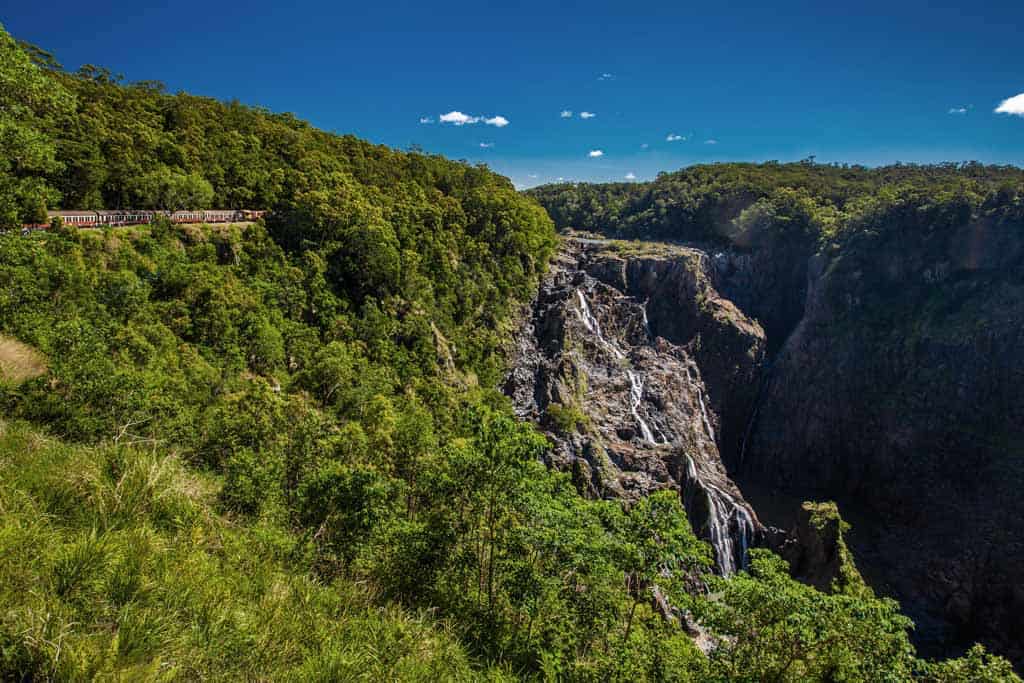
Only about an hour north of Cairns is Port Douglas, a small, relaxed town with one backpacker hostel, a few amazing restaurants, and a nice park lined with palm trees for viewing the sunset.
This is one of the best places to book a Great Barrier Reef snorkelling or diving tour because up here, the reef isn’t as crowded as near Cairns. A snorkelling reef trip is one of the most popular Australia tours and shouldn’t be missed!
So spend one of your days in Port Douglas swimming in the crisp, blue waters of the reef and seeing some incredible, colourful marine life.
From here, get back on Cairns to Cooktown bus and continue north up to Cape Tribulation in the Daintree Rainforest.
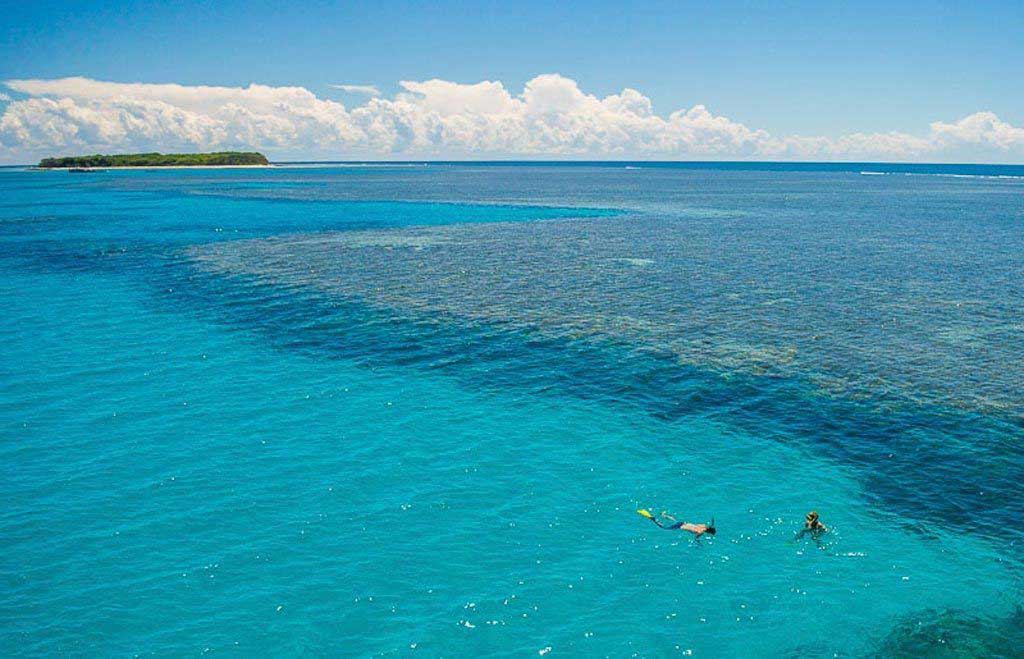
Located in the midst of the jungle, Cape Tribulation is the perfect place to disconnect from technology and reconnect with nature.
There is only one main road running through the town, if you can even call it a town.
Cape Tribulation has a few resorts and hostels, a couple tourism companies and about two shops, and that’s it.
But the powerful presence of the rainforest is more than enough to entertain you for a couple days.
The Daintree is the oldest rainforest in the world, and is one of the true natural wonders of Australia.
Go hiking, ride horses on the beach, book an ATV sightseeing tour, do an exotic fruit tasting at Cape Trib Farm, visit the Daintree Discovery Center, or take a boat cruise on the Daintree River to spot some crocodiles.
Try to avoid visiting Tropical North Queensland in December through February, however. This is the wet season and many roads may be flooded and tours will be closed.
On your third day, take the bus back to Cairns then fly to Darwin.
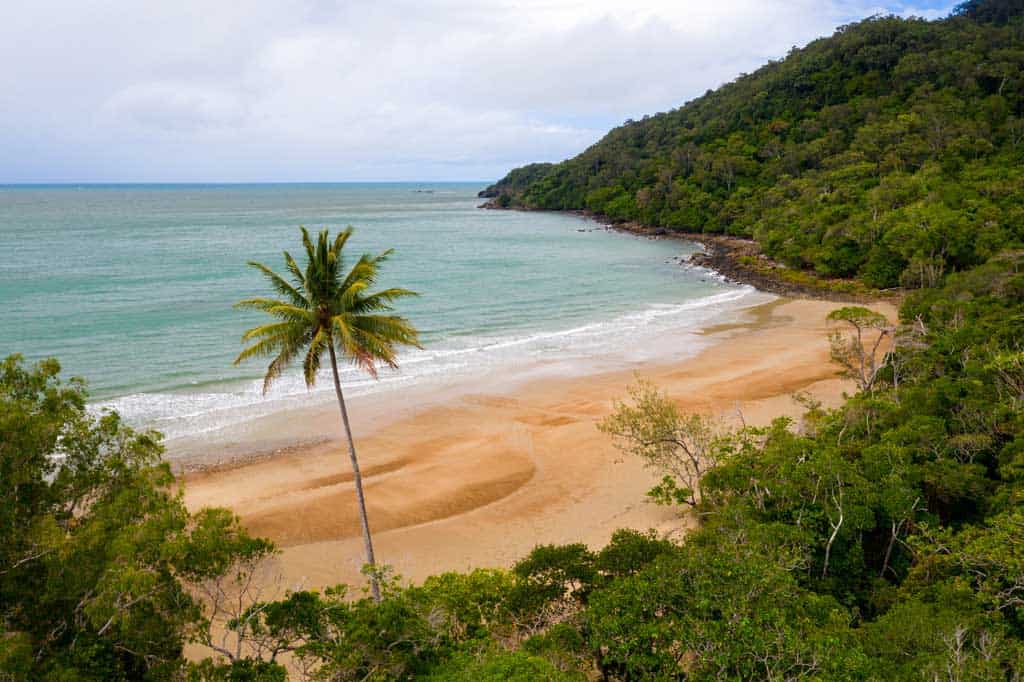
Darwin is the capital city of the Northern Territory, and it is a convenient starting point for a trip into Central Australia and Ayers Rock, in the south of the state.
Use this day to walk around and sightsee a bit, relax and unwind, and plan your journey into Kakadu National Park.
Check out our guide for the best things to do in Darwin!
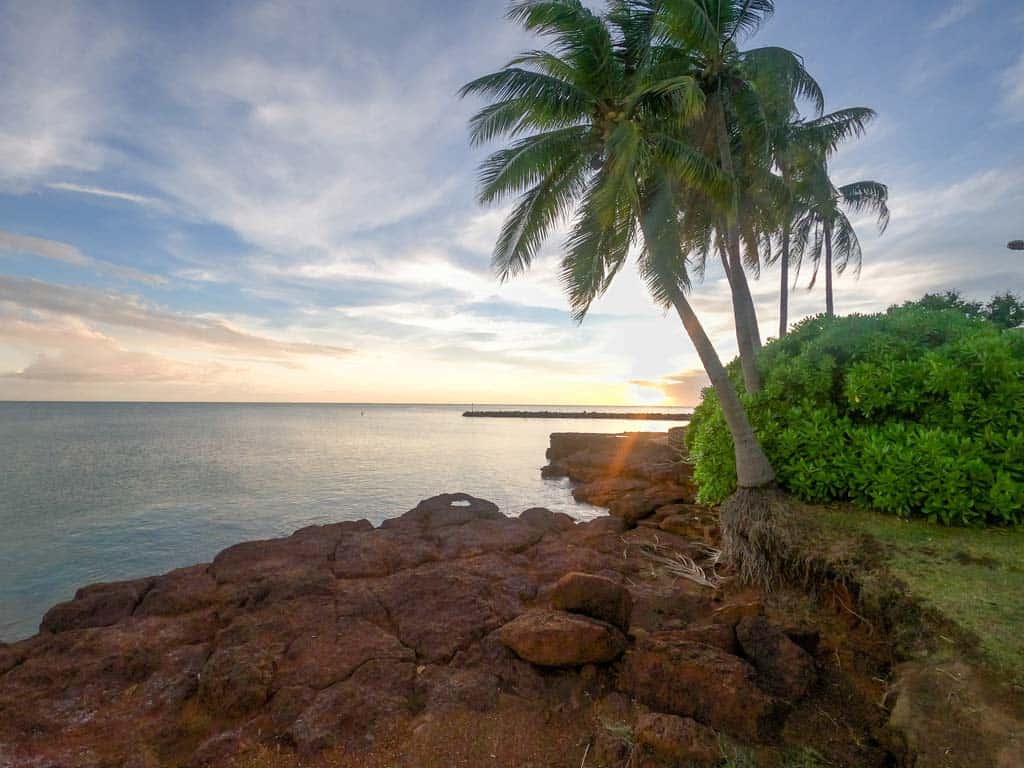
Rent a car in Darwin and spend the next couple days exploring the largest national park in Australia!
You can swim in waterfalls, find ancient Aboriginal rock art, and go hiking through some incredible landscapes.
If you have a van or a tent, you can camp at one of the park’s campgrounds. Otherwise there is a handful of resorts where you can stay overnight in Kakadu.
Most of the accommodation in Kakadu is located in Jabiru, the main town of the park.
You could also book a guided tour to Kakadu as a day trip from Darwin. This is a good option for those who want to take a break from planning and driving. A tour will take you right to the best spots in the park, which is handy because the park is so huge.
After exploring the national park, drive back to Darwin and then fly to Alice Springs at the heart of Australia’s Red Centre.
(Alternatively if you don’t want to keep travelling so much, you could stay in the Northern Territory and explore more natural wonders like Nitmiluk National Park.)
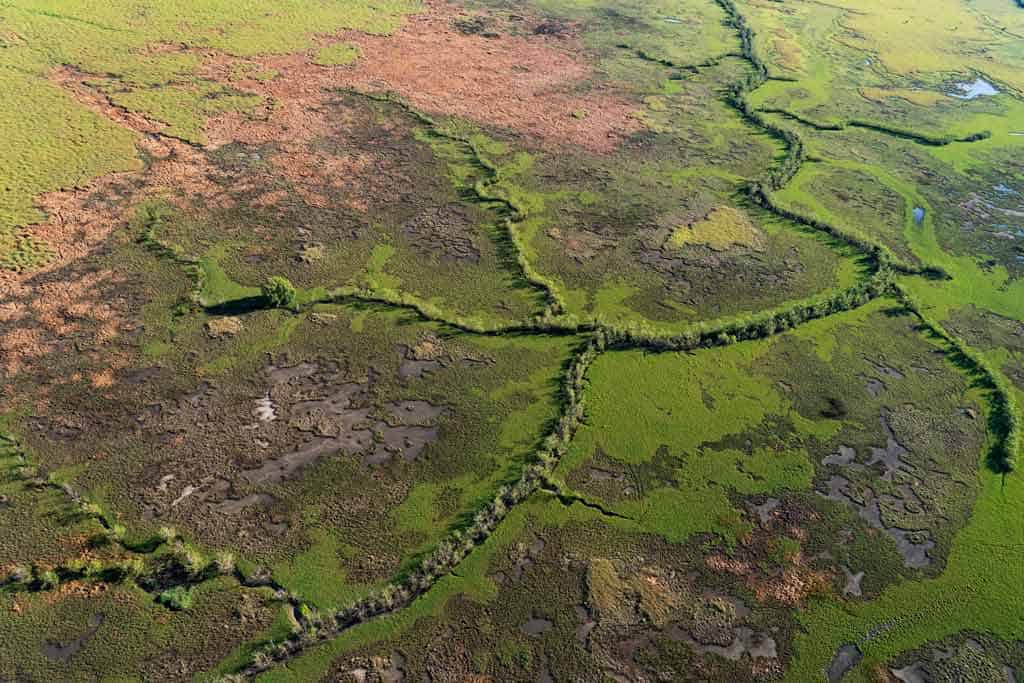
From Alice Springs in the center of the Northern Territory, it’s time to begin your journey to Uluru!
The Red Centre is the central desert area of Australia, consisting of Alice Springs and the UNESCO World Heritage Site, Uluru Kata Tjuta National Park.
Uluru, or Ayers Rock, is a sacred monolith and it one of the most famous places to see on a trip to Australia.
You have two options for getting to Uluru.
Option 1: Rent a car in Alice Springs and complete the 5-hour drive on your own. Keep in mind it’s also 5 hours to get back, so that’s a 10 hour road trip in total. You should also have your own camping gear and pack enough food and water for the road trip.
Option 2: Book a tour from Alice Springs if you are tired of driving. You can choose a straightforward day trip . It’s a bit pricier to do a guided tour, but it takes away a lot of the effort on your part.
Either way, watching the sunrise and sunset bathe Uluru in soft, natural hues is a sight you’ll never forget, so the journey is worth it.
If you are renting a car and doing your own road trip, consider also heading out to Watarrka National Park and Kings Canyon. This amazing spot is a 3 hour drive from Ayers Rock, which is a short drive for the Outback!
READ MORE: Check out all the incredible things to do in Uluru !
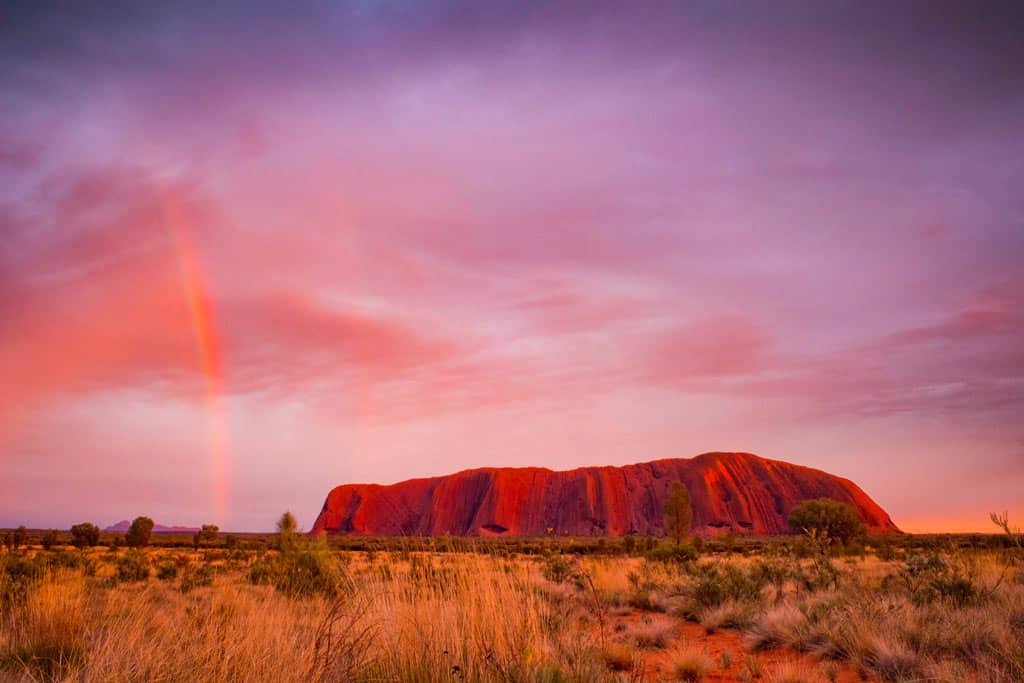
Your final day of the 3 week Australia itinerary will mostly be spent travelling.
Drive back to Alice Springs, then fly back to Sydney for your flight home.
I just want to add that there are many other natural wonders that I didn’t get to mention!
Australia is massive so it’s hard to fit in so many cool places in a short time.
For example, the north of Western Australia is stunning, but it’s very remote and not convenient to add to a few weeks in Australia.
Few Australians even make it out here on holiday.
But riding a camel on Cable Beach , snorkelling with Whale Sharks in Exmouth , or camping in Cape Range National Park are amazing experiences that you can have if you have the time to venture out there.
Tasmania is also one of the most gorgeous places in Australia. The island is home to some of the best hiking and camping in the country , but it requires lots of prior planning and preparation and gear.
You could also road trip around Australia, taking more time to see all the attractions and not having to rush.
But it would take you months or even years to road trip all of Australia!
Regardless of how much time you spend here, don’t stress about seeing everything!
It’s impossible to see everything, and no matter where you go, you’re sure to have an epic time.
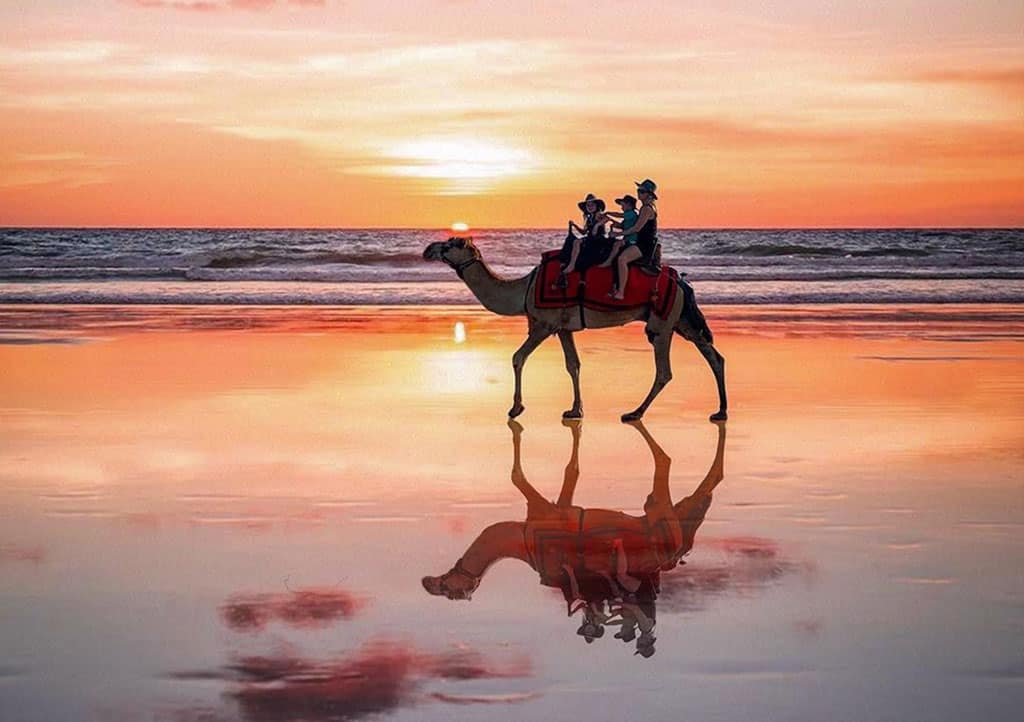
DISCLAIMER: Some of the links in this article are affiliate links, which means if you book accommodation, tours or buy a product, we will receive a small commission at no extra cost to you. These commissions help us keep creating more free travel content to help people plan their holidays and adventures. We only recommend the best accommodations, tours and products that ourselves or our fantastic editorial team have personally experienced, and regularly review these. Thanks for your support, kind friend!
Gabby Boucher
Hi, We’re Alesha and Jarryd!

We’ve been traveling the world together since 2008, searching for the planet’s best destinations and adventures.
Love Travel?
Sign up for our free weekly newsletter for the best travel tips, ideas and deals!
We respect your privacy. Unsubscribe at any time.
READ MORE...
Quark Ultramarine Review – Best Polar Expedition Ship [2024]
30 Awesome Things to Do in Easter Island
The Land of Spears and Smiles – Wogasia Spear Festival on the Solomon Islands
Related Posts
New year, new adventures – an update on our partnership with kathmandu, from tan hoa village to tu lan caves – the local’s role, guide to buying a motorbike in southeast asia, 8 reasons why you should visit tohoku, japan on your next trip, 5 thoughts on “the perfect 1, 2 or 3 week australia itinerary [2024]”.
Have you got any info/tips about Central Australia? Adelaide, Coober Pedy, Alice Springs to Darwin (Stuart Hwy).
Would like more information on all inclusive 3 wk itinerary for family of about 12.
All the best with your research. Have a great trip.
Terrific article. Thanks so much for the insight!
Thank you so much. Glad the article was helpful 🙂
Leave a comment Cancel reply
Save my name, email, and website in this browser for the next time I comment.

Australia Travel Guide
Your ultimate australia travel guide, with tips, and things to see and things to do in australia. great for first-time and returning travelers..
G’Day Mate! Known for its teeming natural and cultural treasures, The Land Down Under has the perfect something for every type of traveler.
There are so many great things to do in Australia .
Relax on the gorgeous beaches along its extensive coastline; embark on an exciting adventure, like going on on a walkabout.
Or try Great White Shark cage diving, or head on over to the cosmopolitan cities of Sydney and/or Melbourne to enjoy shopping, fine dining, and a budding art scene.
This Australia travel guide and list of things to do will help you plan your next vacation.
The only problem with scouring through this Australia travel guide is that once you visit this massive island continent, you might not want to leave!
Popular City Guides
- Visit Australia
Our Highlight
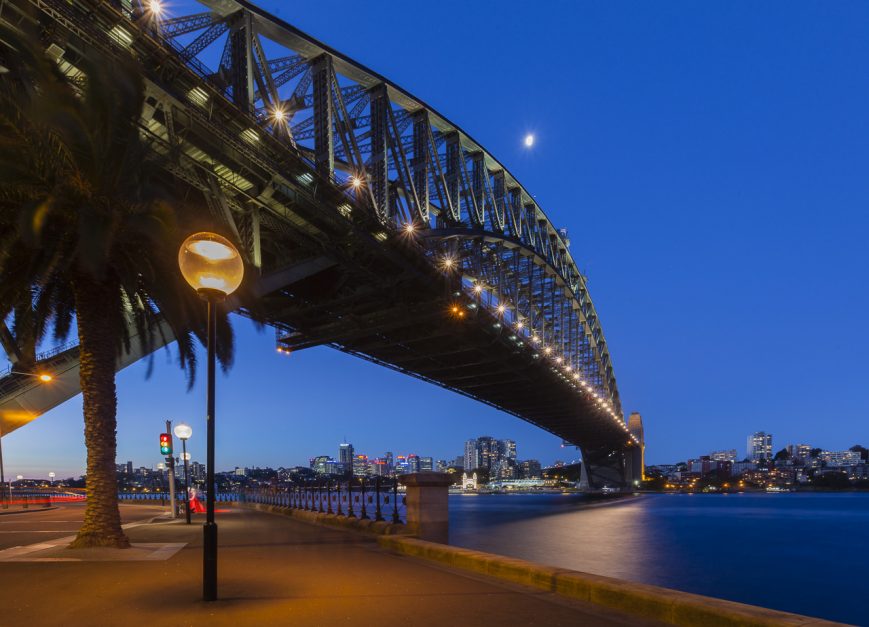
Table of contents
Table of Contents
Fast Facts about Australia
- Australian power voltage is 230 V 50 Hz; Power sockets I
- The local currency is the Australian Dollar (AUD) and is around 1.20 AUD to 1 USD
- Bush fires are common in Australia from late spring to summer; during this period please observe simple safety precautions. Make sure to research risks before travelling and when camping, use only designated fireplaces, while also complying with road warning signs and fire bans.
- The emergency services (police, fire, ambulance) number in Australia (equivalent to 911 in North America), is 000 (Zero-Zero-Zero)
- You can rent a mobile phone from such providers as RebelFone, Vodafone Rental, Landwide and Cellhire.
- In general, if you do not already have a GSM phone, it is less expensive to rent a phone for short stays.
Things to See and Do in Australia
- Take a Helicopter Ride over the Great Barrier Reef – A flight over the reef gives you the opportunity to appreciate just how massive this system is.
- Paddle Board in the Oldest Rainforest on Earth – What better way to spend an afternoon than a lazy float along the river?
- See the wildlife of Kangaroo Island
- Take Flight on a Hot Air Balloon – Step back in time and fly high in the sky as you take in sunrise over the Gold Coast. As you fly over farmland and wide open spaces you’ll spy kangaroos and finish off with a champagne breakfast at a local vineyard.
- Fly over the Flinders Ranges to view the spectacular Wilpena Pound
- Swim with some Great Whites – jump into the water with some of the most majestic creatures of the ocean world.
- Take a Dolphin Swim in Shark Country – get up close and personal with the dolphins of Baird Bay, but don’t stray too far from the guide!
- Take the Ultimate Scuba Adventure – explore this underwater paradise by joining one of the many dive expeditions that explore the reef system on a daily basis. From snorkeling near the safety of a pontoon on the inner reefs to extreme exposed ocean diving out at Osprey Reef, there’s something for everyone to enjoy.
More Australia Travel Guides
- Kangaroo Island Wildlife Sanctuaries
- 12 Amazing Australian Wildlife Experiences
- 23 of the Most Iconic Places to Visit in Australia
- Maria Island – Escape from Civilization in Australia
- Koala Sanctuary – Cuteness in South Australia
- Things to do in Brisbane – Everything You Need to Know
Accommodation
Budget : Hostels in Australia typically go for $20 – $25 AUD per night. But hostels can go as high as $100 AUD per night for a double room. Wake Up Sydney is a popular hostel
You can get private rooms in other hostels for around $50 UAD
Mid Rang e – You can get budget hotels around Australia for $150 AUD. They typically have basic amenities but are clean and modern and include free WiFi.
High End – Australia has some beautiful luxury accommodation around the country. From rainforest retreats to coastal estates. Prices can go for thousands of dollars per night, but you can get a luxury hotel for $300-$500 AUD
- Check out our favorite booking platforms Booking.com , Tripadvisor and VRBO for the best deals on accommodation.
Food : Australia has a wide variety of eateries including fast food, but it is all pricey. The good news is you don’t have to tip in Australia. But expect to pay $20 a meal so budget at least $50 AUD for food per day in Australia.
- Kangaroo meat can be purchased from the supermarket, butcher and is available on restaurant menus as a leaner and healthier alternative to beef or lamb with a 1-2 percent fat content.
- Vegemite, try some! This yeast spread has the same consistency as peanut butter and is an Australian food staple
- Fun Fact: Australia’s former Prime Minister held the Guinness World Record for beer chugging.
The Best Ways to Get Around Australia
Getting to australia:.
Getting to Australia: Australia’s major airports are Sydney, Melbourne, Perth and Brisbane.
Airline fly direct from London, South East Asia and the West Coast of Canada and the United States – Vancouver and Los Angeles
Flights: You can check for the best flights to Australia on Skyscanner .
Transportation:
Australia is a huge country and getting around can take time. We flew between states to get from one city to another with Virgin, Air New Zealand and Quantas.
Buses : Buses are a cheap way to travel between cities. Greyhound is the main busline. But be prepared for long journeys.
Taxis: Taxis start at $4.00 AUD depending on the city. (ranges from $3.50 – $5.00) and then charge 1.50 to $3.00 depending on the city. Check out NUMBEO for up to date fares.
Car Rental: Car rentals are the best option for traveling around Australia. Campervans and Caravanning is still a very popular way to explore the continent. Prices for car rentals start at $25 per day and can go up to $100 per day for a premium car. We’ve used VroomVroomVroom when traveling Australia. You can also compare prices here .
Many people purchase a van to travel around Australia and it is a great option to have the freedom to take your time and save money.
Uber: We have used Uber in Australia and it is an excellent option.
When to go To Australia
Australia has reasonable weather all year round. It is a large country though, so you want to check out each place region by region.
Some part of Australia have tropical or Mediterranean climates, while others are desert and temporal. Northern states are typically warm year-round with two seasons: wet or dry. Southern states have cooler winters.
Australia seasons are the opposite of North America and Europe: December to February: summer. March to May: autumn; June to August: winter; and September to November: spring. We always suggest traveling during shoulder season for cheaper prices and fewer crowds.
Queensland has two seasons, wet and dry. Wet runs from Nov-April and Dry is May-Oct Queensland is split up between two climates the Tropical North and Temporal Queensland. The wet season is hot and humid and you can expect tropical thunderstorms and even hurricanes. That said, we traveled to Queensland in Feb and had mostly sunny skies with just short, intense rains each day. There are far fewer tourists during the rainy season and we found our travels to be very pleasant. See all the things to do in Brisbane The dry season is still hot but there is less humidity: 28 degrees Celcius, (84 Fahrenheit) but nights are cooler. Swimming is better at this time of year with less chance of crocodiles and jellyfish. Crowds are much worse and rates are higher. So it is a trade-off.
South Australia
This is the driest state in the country and it is very large. The hottest and driest months are during the summer in Jan-Feb Late Feb-March is the best time to visit the Capital City of Adelaide Adelaide has wet winters. Summer and high season here is Dec – Feb with an average temperature of 28 degrees Celcius, (84 Fahrenheit) Spring and Autumn are best for shoulder season March-May and Sept – November, temperatures are pleasant and there are fewer crowds March-May is another great shoulder season travel time with temperatures dropping in 15 degrees Celcius (60 Fahrenheit) South Australia has a large portion of the outback in its borders and travel in shoulder season is much more pleasant than the hot summers
New South Wales, Sydney
Sydney typically sees 340 sunny days a year, so you can’t go wrong anytime. Summer and high season here is Dec – Feb with an average temperature of 28 degrees Celcius, (84 Fahrenheit) Spring and Autumn are best for shoulder season March-May and Sept – November, temperatures are pleasant and there are fewer crowds March-May is another great shoulder season travel time with temperatures dropping in 15 degrees Celcius (60 Fahrenheit) South Australia has a large portion of the outback in its borders and travel in shoulder season is much more pleasant than the hot summers
Melbourne possibly has the most changeable weather in Australia. March-May is the best time to visit with a lot of festivals going on. It’s shoulder season right after summer. Sept – Nov is second best. Temperatures are more moderate at these times of the year. Dec-Feb is summer and is peak season in Victoria. Temperatures are hot and the crowds are dense. Imagine having to jockey for a position to see the twelve apostles. That said, we visited Victoria in January and by doing the Great Ocean Walk, we avoided all crowds as we hiked the coast for four days. Go during shoulder season and you’ll be happier. June – August – unlike other cities in Australia – Melbourne is cold and dreary during the winter months.
Ayers Rock is a popular stop on the tourist trail. It’s at the top end of Australia and season are a bit different here. Ayers Rock Wet season : October to April Dry Season : May to September Winter can fall below freezing at night and summer can go above 100 degrees Fahrenheit.
Where to Stay in Australia
- Gold Coast – Peppers Beach Club
- Sydney – Grace Hotel
- Melbourne – Travelodge South Bank
- Daintree Rainforest – Silky Oaks Lodge
- Brisbane – Spicer’s Balfour
- Brisbane – Regatta Boutique Hotel
Australia Accommodation Guides
- Where To Stay In Melbourne – A Guide To The Best Neighborhoods
- 18 Great Things to do in Queensland, Australia
What to Pack for Australia
Due to the sheer size of the continent, the weather in Australia varies significantly depending on where you want to travel.
Northern states experience warm weather year-round while the southern states experience cooler winters.
Australia is also one of the driest continents on the earth with an average annual rainfall of fewer than 600 millimeters.
Remember that Australia’s seasons are opposite to those in the northern hemisphere!
- Pack sunscreen – Australian sun is very strong. Always wear a shirt, hat, sunglasses, and SPF 30+ sunscreen lotion, even on cloudy days.
- Layers – When traveling to different climates remember that layering is the key to effortlessly transitioning from cold to hot climates or vice versa.
- Bug spray – mosquitoes and sand gnats are a nuisance that can be prevented with bug spray and a handy mosquito net. If you visit the Outback, the latter is a must-have. Ticks are also common in the wilderness and, should you be bitten, a pair of tweezers will enable you to remove the pest from your skin.
- First Aid Kit – You may be traveling to remote areas, so have a good stocked first aid kit
- Hiking Gear – for travelers heading up to the Northern Territory, consider packing hiking shoes/trainers, a hat and a water bottle. Also, pack clothes that you don’t mind getting dirty (due to the red dirt of the desert) and avoid packing light colors.
- See our packing tips for travel for all travel gear, camera gear and clothing we pack for travel.
See our packing tips: packing tips.
- Sun is the biggest factor for safety. Drink plenty of fluids, wear sunscreen or sun hats and stay covered up.
- Beaches have a lot of rips and currents so always swim between the flags so lifeguards can see you.
- Swimming on the beaches of Tropical Queensland can have a risk of Crocodiles Talk to locals and follow the signs.
- Avoid swimming at mouths of rivers where crocodiles like to hang out.
- Deadly stingers are a real threat at certain times of the year (Nov-April)
- When bushwalking – wear long pants and high hiking boots to avoid snake bites
- When driving through the outback make sure your vehicle is in good shape and have extra food and water.
Australia Travel Guide: Best Booking Resources
Whenever we travel to we make sure to start with these companies. We have tried a lot of different ones over the years and all of these have consistently proven to be the best when it comes to offering great prices.
We have used every one of these personally and continue to do so.
- Booking.com : This is our go site to when comparing prices for accommodation. It usually has the cheapest prices, especially in Europe and we love their interface. Not to mention you get free cancellation and you are guaranteed the best price.
- Trip Advisor : What we like about Trip Advisor is that we can look at all the reviews and then book our accommodation. TripAdvisor is where we go when we want to compare prices with multiple accommodation providers.
- VRBO : is the main search engine we use when we are looking for a home or apartment rental. It can sometimes be cheaper than hotels and it is the best way to stay in areas that offer a more local feel.
- Hostelworld : With one of the largest databases of hostels in the world, Hostelworld is the go-to site when you are looking for budget accommodation.
- Skyscanner : This is the first place we check for flights. It consistently comes back with the cheapest and best options. It allows us to compare a lot of airlines to get the best price.
- Rome 2 Rio : If you want to see how to get somewhere by plane, train, bus, ferry or car Rome2Rio lays it all out for you as well as related costs.I love how they show it all to you on a Google Map and it works offline.
- Get Your Guide: For all your day trip and city guide needs, we use Get Your Guide. It has the world’s largest collection of things to do with more than 30,000 activities in 7500 destinations.
- World Nomads Insurance: When traveling to Italy you should always have travel insurance. We have found the best bang for your buck is by far World Nomads.
Australia Travel Guide: Related Articles
To browse all our articles and guides about Australia click here.
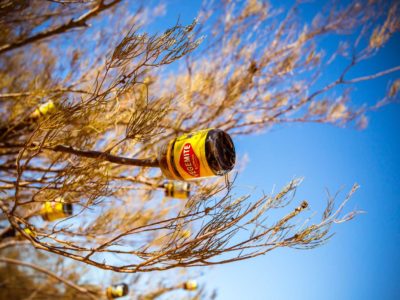
Australian Food: 24 Australian Dishes You Have to Try
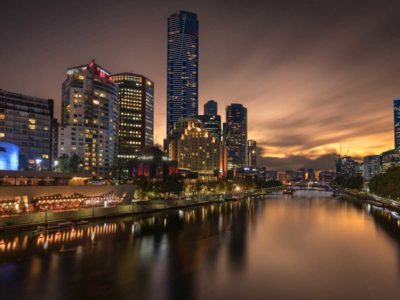
The Best Things to do in Melbourne, Australia
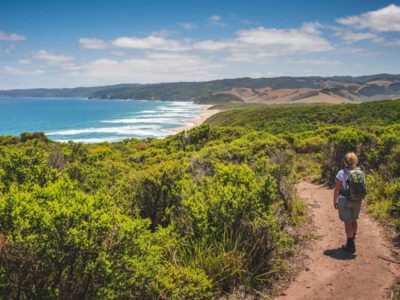
10 Fun Facts About Australia
Travel Guide Australia
Book your individual trip , stress-free with local travel experts
Select Month
- roughguides.com
- Australasia
- Travel guide
- Itineraries
- Local Experts
- Travel Advice
- Accommodation
Plan your tailor-made trip with a local expert
Book securely with money-back guarantee
Travel stress-free with local assistance and 24/7 support
More than most other countries, Australia seizes the imagination. For many visitors its name is synonymous with endless summers where the living is easy. This is where the adventures are as vast as the horizons and the jokes flow as freely as the beer – a country of can-do spirit and laidback friendliness. No wonder Australians call theirs the Lucky Country.
Interesting facts about Australia
Where to go in australia, best places to visit in australia, best time to travel to australia, australian life and culture, the outback, australia’s indigenous people, eccentric australia, gay and lesbian australia, travel ideas for australia, created by local experts.

12 days / from 2900 USD
Explore Western Australia from Perth to Broome
Western Australia is the country's largest state, covering more than a third of Australia. This self drive itinerary allows you to explore sunny Perth, stunning national parks and waterfalls, the remote wild west outback, empty beaches and much more.
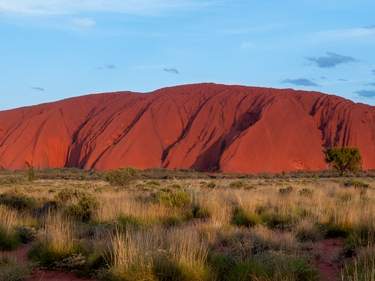
16 days / from 3300 USD
Explore South Australia and the Northern Territory
Explore South Australia and the Northern Territory on this self-drive adventure. Start in Adelaide and make your way over the Ayers Rock, Kings Canyon, and Alice Springs to the Kakadu National Park and ultimately Darwin.

23 days / from 4150 USD
Cross Western Australia to Darwin
Western Australia offers wonderfully remote outback experiences: from spectacular national parks to sandy deserts, pristine beaches to working cattle stations. This itinerary allows you to explore the way from Perth to Darwin in depth and at your own pace, in your own rental car.
- With an area of just over 7.5 million square kilometres, Australia is the sixth-largest country in the world.
- Australia’s population is estimated at just over 22 million, of whom some 85 percent live in urban areas. About 92 percent are of European origin, two percent Aboriginal, and around six percent Asian and Middle Eastern.
- Much of Australia is arid and flat. One-third is desert and another third steppe or semi-desert. Only six percent of the country rises above 600m in elevation, and its tallest peak , Mount Kosciuszko, is just 2228m high.
- Australia’s main exports are minerals, metals, fossil fuels, cotton, wool, wine and beef, and its most important trading partners are Japan, China and the USA.
- At 5614km the dingo fence is the longest in the world, stretching from Jimbour to the cliffs of the Nullarbor Plain. It’s around twice the length of the Great Wall of China.
- Australia ranks proudly ranks second in the Human Development Index , which measures a country’s progress by its life expectancy, education and income. Norway comes first.
- Around 22 percent of Australians are descended from convicts .
For visitors, deciding where to go can mean juggling distance, money and time. With an expanse of places to visit, Australia’s tourism means that you could spend months driving around the Outback , exploring the national parks, or hanging out at beaches; or you could take an all-in, two-week “Sydney, Reef and Rock” package, encompassing Australia’s outstanding trinity of must-sees. These are just some of the top places to go in Australia.
Both options provide thoroughly Australian experiences, but either will leave you with a feeling of having merely scraped the surface of this vast country. Visit Australia and experience the two big natural attractions: the 2000km-long Great Barrier Reef off the Queensland coast, with its complex of islands and underwater splendour, and the brooding monolith of Uluru (Ayers Rock), in the Northern Territory’s Red Centre.
Sydney is the jewel in Australia’s navel. Famous as one of the world’s great gay cities, it attracts LGBTQ visitors from around the world. Melbourne closely follows, but there are scenes in Brisbane and the Gold Coast, and to a lesser extent in Perth, Adelaide, Hobart and Darwin.
Away from the cities, things get more discreet, but a lot of country areas do have friendly local scenes – impossible to pinpoint, but easy to stumble across. However, Outback mainstays of mining and cattle ranching are not famed for their tolerance of homosexuality, so tread carefully in remote destinations.
Discover more places in Australia

- Outback Queensland Travel Guide
- South Australia Travel Guide
- Sydney Travel Guide
- Tasmania Travel Guide
- Victoria Travel Guide
- Western Australia
Blue Mountains (New South Wales)
World Heritage-listed, the Blue Mountains are a wonderland of ancient forests, deep valleys and lookouts from sheer cliffs, all just an hour or so from Sydney.
Travel advice for Australia
From travel safety to visa requirements, discover the best tips for traveling to Australia
- Eating and drinking in Australia
- Getting around Australia: Transportation Tips
- Travel Health Australia
- Sports and Outdoor activities in Australia
- How to get to Australia
- Travel Tips Australia for planning and on the go
- Travelling with children in Australia
- Best time to visit Australia
Tall Timber Country (Western Australia)
These primeval karri forests are one of WA’s greatest natural sights. Get a bird’s-eye view from the Tree Top Walk.
Wilpena Pound (Southern Australia)
There are some fantastic hikes in the Flinders Ranges National Park but few top the spectacular scenery at the elevated basin of Wilpena Pound.
Sport at the MCG (Victoria)
Taking in a game of cricket or, better still, Aussie Rules football at the venerable Melbourne Cricket Ground (MCG) is a must for any sports fan.
Fraser Island (Queensland)
The giant dunes and freshwater lakes of the world’s largest sand island form the backdrop to popular 4WD safaris.
Sydney harbour (New South Wales)
Scale the bridge, take a harbour ferry to Manly or just marvel at the Opera House sails at the most iconic location in Sydney, a shorthand for Australia itself.
Atherton Tablelands
With its rainforest, crater lakes and abundant wildlife, you could spend days exploring the Atherton Tablelands.
You’ll find reliably warm summers at the coast with regular, but brief, heatwaves in excess of 40°C. Head inland, and the temperatures rise further. Winters, on the other hand, can be miserable, particularly in Victoria , where the short days add to the gloom. The best time to travel to Tasmania is year-round: while weather in the highlands is unpredictable at all times, summer is the best time of year to visit Tasmania to explore the island’s outdoor attractions.
Every aspect of Australian life and culture, whether its matey attitudes or its truly great outdoors, is a product of the country’s scale and population – or lack of it. Australia rivals the USA in size, but is home to only 24 million people, giving it one of the lowest population densities on earth. The energy of its contemporary culture is in contrast to a landscape that is ancient and often looks it: much of central and western Australia – the bulk of the country – is overwhelmingly arid and flat. In contrast, its cities, most founded as recently as the mid-nineteenth century, burst with a vibrant, youthful energy.
The most iconic scenery is the Outback, the vast fabled desert that spreads west of the Great Dividing Range into the country’s epic interior. Here, vivid blue skies, cinnamon-red earth, deserted gorges and geological features as bizarre as the wildlife comprise a unique ecology, one that has played host to the oldest surviving human culture for up to 70,000 years (just 10,000 years after Homo sapiens is thought to have emerged from Africa).
This harsh interior has forced modern Australia to become a coastal country. Most of the population lives within 20km of the ocean, the majority of these occupying a suburban, southeastern arc that extends from southern Queensland to Adelaide. Urban Australians celebrate the typical New World values of material self-improvement through hard work and hard play, with an easy-going vitality that visitors, especially Europeans, often find refreshingly hedonistic. A sunny climate also contributes to this exuberance, with an outdoor life in which a thriving beach culture and the congenial backyard “barbie” are central.
Although visitors might eventually find this low-key, suburban lifestyle rather prosaic, there are opportunities – particularly in the Northern Territory – to experience Australia’s indigenous peoples and their culture through visiting ancient art sites, taking tours and, less easily, making personal contact. Many Aboriginal people – especially in central Australia – have managed to maintain a traditional lifestyle (albeit with modern amenities), speaking their own languages and living by their own laws. Conversely, most Aboriginal people in cities and country towns are trapped in a destructive cycle of racism, poverty and lack of meaningful employment opportunities, often resulting in health problems and substance abuse. To give just one example, life expectancy rates for Aboriginal Australians are ten years lower than those of the rest of the population. There’s still a long way to go before black and white people in Australia can exist on genuinely equal terms.
Aboriginal art
Aboriginal art has grown into a million-dollar industry since the first canvas dot paintings of the central deserts emerged in the 1970s. Though seemingly abstract, early canvases are said to replicate ceremonial sand paintings – temporary “maps” fleetingly revealed to depict sacred knowledge. In the tropics, figurative bark and cave paintings are less enigmatic but much older, though until recently they were ceremonially repainted. The unusual X-ray style found in the Top End details the internal structure of animals. The Northern Territory – and Alice Springs, in particular – are the best places to look.
It could be part of the Australian psyche that celebrates renegades. Perhaps it is just the standard set by such utterly odd wildlife as the platypus. Whatever the cause, Australia enjoys eccentricity like few other first-world nations, even down to the playful rough-and-tumble of its slang, Strine. The further you go from the big cities, the quirkier Australia gets. You could base an entire visit around a tour of kitsch sights like the Big Banana at Coffs Harbour, the Big Pineapple at Nambour or the Big Prawn at Ballina; for more inspiration see wilmap.com.au/bigstuff. Country and especially Outback pubs are often reliable outposts of the weird and wonderful. Yet for true glorious weirdness head to small festivals like the World Cockroach Races staged in Brisbane every Australia Day, or Darwin’s riotous Beer Can Regatta in July, with boat races in craft made entirely from beer cans.
Australia is a fixture on the Queer map thanks to its great climate and laidback lifestyle. Sydney is Australia’s gay-friendly capital, especially in March when hundreds of thousands of people pour in for the Sydney Gay & Lesbian Mardi Gras. Despite its reputation as a macho culture, the country revels in a large and active scene: you’ll find an air of confidence and a sense of community that is often missing in other parts of the world.
Sydney is the jewel in Australia’s navel. Famous as one of the world’s great gay cities, it attracts lesbian and gay visitors from around the world. Melbourne closely follows, but there are scenes in Brisbane and the Gold Coast, and to a lesser extent Perth, Adelaide, Hobart and Darwin.
Gay and lesbian contacts
- Pinkboard pinkboard.com.au . Popular, long-running website with useful “Graffiti Walls” full of parties, personal ads and classifieds sections with everything from house-shares, party tickets for sale, employment, and a help and advice section. Posting ads is free.
- The Pink Directory thepinkdirectory.com.au . Online directory of gay and lesbian business and community information.
- DNA dnamagazine.com.au . The nation’s best-selling Queer title, an upmarket lifestyle magazine for gay men.
Tourist services and travel agents
- GALTA (Gay and Lesbian Tourism Australia) galta.com.au . An online resource and nonprofit organization that promotes the gay and lesbian tourism industry with good links.
- Gay Travel gaytravel.com . Online travel agent, concentrating mostly on accommodation.
- International Gay and Lesbian Travel Association iglta.org. Trade group with lists of gay-owned or gay-friendly travel businesses.
The Rough Guides to Australia and related travel guides
In-depth, easy-to-use travel guides filled with expert advice.
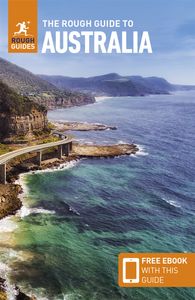
Find even more inspiration here

Planning your own trip? Prepare for your trip
Use Rough Guides' trusted partners for great rates

written by Andy Turner
updated 26.04.2021
Ready to travel and discover Australia?
Get support from our local experts for stress-free planning & worry-free travels.
- Where to stay
- Travel advice

The land down under may seem like a world away, but it’s a dynamic destination that caters to music lovers and fashionistas, urban adventurers and discerning gastronomes, the nature-intrigued and seasoned outdoors explorers. Now reopen to international travelers, Australia beckons with all that it offers. You may come for the very great barrier reef in Queensland and discover scuba diving led by Indigenous guides; or pair Victoria’s ski scene with its wine scene. Maybe you should consider a longer trip...
- Copy Link copied

When’s the best time to go to Australia?
It’s hard to find a wrong time to visit Australia. Winter is June to August, when most of Australia hits a low season. This is the time to ski in the Kosciusko National Park or on Victoria’s Mount Hotham. It’s also the best time to visit northern Australia.
Between May and September the Northern Territory, northwestern Australia, and Queensland offer ideal weather. In summer, these areas swelter, either too humid or too hot, inciting some travelers to make a U-turn to more friendly climes down south.
From September to May, southern Australia is at its peak. Every other traveler looking for antipodean escapades arrives at this time of year, but there’s plenty of land to go around. December to February have most Sydneysiders and Melbournians pumping up the air-conditioning, while braver tourists define new tan lines on Bondi and Manly beaches.
How to get around Australia
They don’t call Australia “the land down under” for nothing. It’s a long flight from just about anywhere. And once you’re here, the various must-see destinations are spread over vast distances, so some logistical planning is necessary.
As of 2022, there were nine nonstop inbound flights to Australia from the U.S., stopping in Sydney, Melbourne, Brisbane, or Perth. Interstate flights are easily accomplished via Qantas, Jetstar, Tiger, and Virgin.
To see the whole continent in under a month is a serious undertaking and will involve trains, planes, a few automobiles, boats, and a ferry or two.
A less daunting project would be to take on the East Coast in one trip, spending time in Sydney and Melbourne, exploring Adelaide and the Great Ocean road by car, taking a car-ferry or flight to Tasmania, popping in to Canberra, and jetting up to Queensland for the tropical experience.
Western Australia is simple to navigate by train, car, or tour bus, but don’t even think about going into the outback alone in summer.
The interior outback, known as the Red Center, is best reached by organized tour, available as luxury excursions, adventure operations, backpacker units, and every other imaginable collective. You can take four-wheel-drives off road, but carry water (five liters per day, per person), bring a high-frequency radio transceiver, and be sure to respect Aboriginal sacred land, national park rules, and animal crossings at dusk and dawn. (Neither party comes out well from an on-road clash with a large kangaroo.)
Food and drink to try in Australia
Foreigners’ overused jokey adage to “throw another shrimp on the barbie” no longer sticks. First of all, Australians call them prawns. Second, Australian gastronomy has surpassed the humble barbecue. It remains a happy summer stalwart in backyards across the country, but what happens elsewhere is more interesting. The country’s food scene has been largely overlooked abroad, and for the most part the global food media have shunned Australia’s culinary experience, focusing instead on its cuddly native critters and extraordinary landscapes. It’s also true that the nation’s food culture is really coming of age. What was a less than inspiring restaurant scene just a couple of decades ago has blossomed in recent years. Restaurants such as Attica, Quay, Sepia, and Flower Drum can stand up to the world’s best.
Culture in Australia
The new year kicks off the traditional cycle, and less than a month later the country celebrates Australia Day. Officially it marks the anniversary of the arrival of the British in Sydney on January 26, 1788. Mindful of the original inhabitants of the land, the day is now simply a celebration of being Australian. Folks light the barbecue, play cricket on the beach, and take to the outdoors. Every happy Australian stereotype comes out on one glorious public holiday. Parties don’t come much more mind-blowing than the Sydney Gay and Lesbian Mardi Gras Parade , the biggest of its kind in the world. Go along to cheer on the sequined, feathered, Lycra-wearing ensemble as they celebrate equal rights.
Hippies, rockers, folk fans, indie types, country listeners, jazz groovers: There are festivals across Australia for every sort of music lover. Travel north to Byron Bay to revel in the stunning bushland setting of Splendor in the Grass , and go to Victoria for the Falls Festival , relocated from Tasmania following a two-year pandemic hiatus. See where Keith Urban started his career at the Tamworth Country Music Festival . There’s Tropfest for film lovers, and the Sydney, Melbourne, or Byron Bay Writers Festivals for the more literary.
Local travel tips for Australia
Australia is a wide, stunning, varied land. To travel around it well requires great research and good advice. Locals love nothing better than spouting off about their favorite places, the best eats, the must-nots and must-dos. “Shout” (buy) a local a beer and you’ll get better insider advice than you could from a guidebook, and probably a really good laugh.
Guide Editor
Kate Gibbs and Laura Dannen Redman


Australia Travel Guide
This Australia Travel Guide aims to provide you with simple and stress-free travel planning information and inspiration for planning a trip to Australia.
On this regularly updated page you will find links to useful posts on The Trusted Traveller, budget information, details on types of accommodation available, information on getting around the country and more useful links to resources around the web.
Quick Facts
Capital: Canberra
Language: English
Currency: $ Australian Dollars which is made up of 100 cents. Coins come in 5c, 10c, 20c, 50c, $1 and $2 denominations and notes in $5, $10, $20, $50 and $100 denominations.
Electricity: 230 volts AC, 50Hz. Plugs with two or three flat pins are standard. Outlets for 110 volts for small appliances can be found in most hotels.
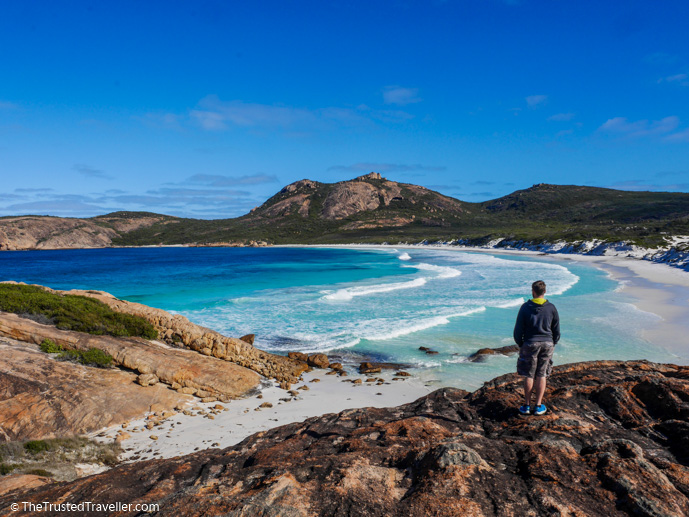
Travel Tips
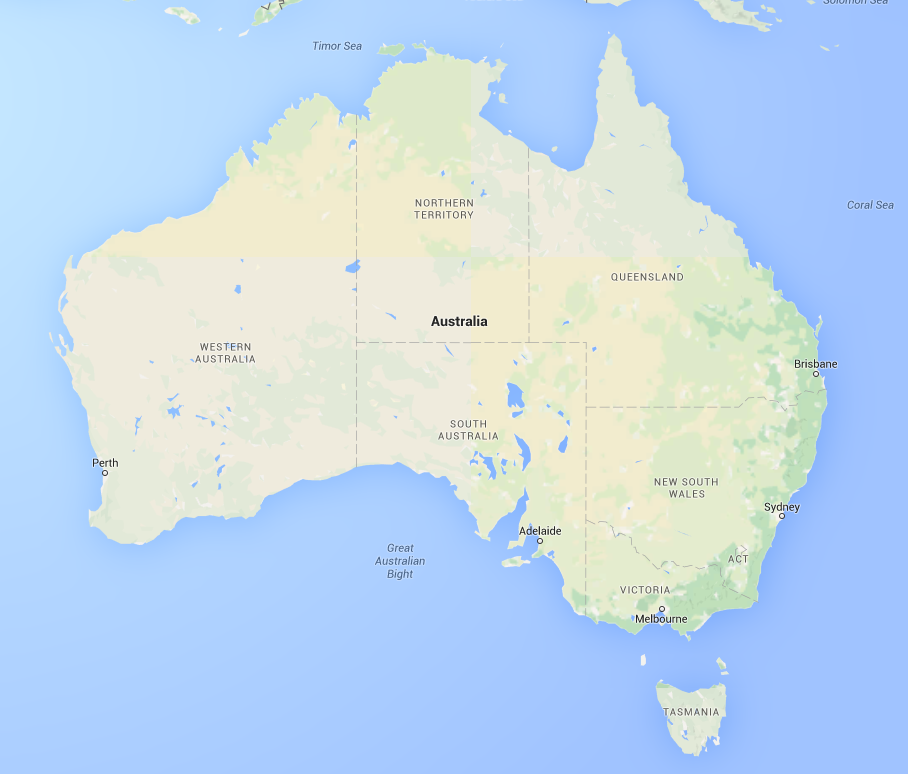
Australia is made up of eight states and territories; Australian Capital Territory (ACT), New South Wales (NSW), Northern Territory (NT), Queensland (QLD), South Australia (SA), Tasmania (TAS), Victoria (VIC) and Western Australia (WA).
It’s coastline covers almost 60,000 kilometres and is surrounded by the Arafura and Timor Seas to the north, the Coral and Tasman Seas of the South Pacific to the east, the Southern Ocean to the south, and the Indian Ocean to the west.
Exploring Australia means you will likely encounter a wide variety of landscapes. From its pristine beaches, densely populated cities, lush rainforest, rugged mountains and deep red outback; there aren’t many countries that offer such a richly eclectic landscape.
Because Australia is so big, the climate can vary depending on which part of the country you are in and what time of the year it is.
Australia is plagued with extreme weather with 40ºc + temperatures not uncommon in the depths of summers and lows of well below 0ºc in winter. Cyclones and flooding cause havoc up north while bushfires are sadly common in the dry south.
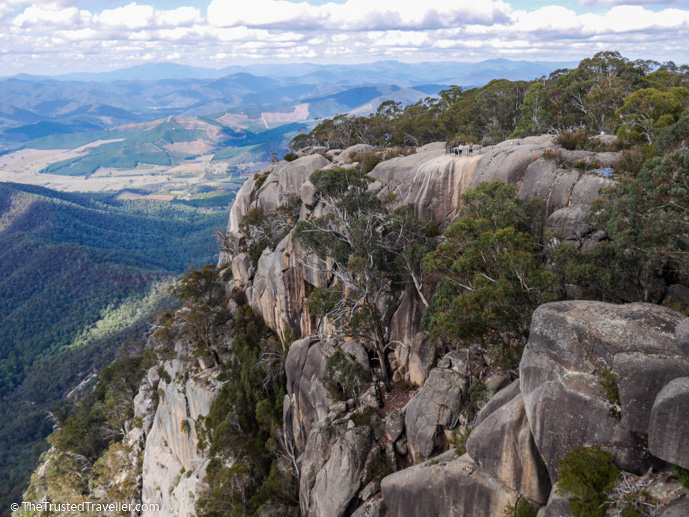
The country is split in two climatic zones: the tropical zone (the north above the Tropic of Capricorn) and the temperate zone (everything south of the Tropic of Capricorn). The tropical zone has two distinct seasons, ‘wet’ (summer) and ‘dry’ (winter), while the temperate zone has all four distinct seasons.
Best Time to Visit
Australia is really an all year-round destination purely because of it’s size.
Spring to summer (October to March) are the most popular times because the majority of the country is warm with hot days and mild nights. Head south for dry heat and try to avoid the tropical north from December to February as it is the wet season with lots of rain, storms and sticky humid conditions.
Autumn to winter (April to September) is a very pleasant time of year to explore the northern and central parts of Australia because of clear warm days and cool nights. You’ll find a little more rain in the south of the country but on average you’ll still get more sunshine. It does snow during the winter months but this is totally confined to the mountains in the south east of the country.
It is always recommend to have a mixture of cash and bank/credit card with you when you travel anywhere in the world and this is no exception in Australia.
ATM’s are available in all cities and towns across the country and credit cards accepted widely too. The exception to this would be in some very small and remote outback towns where it is recommended to have plenty of cash on hand.
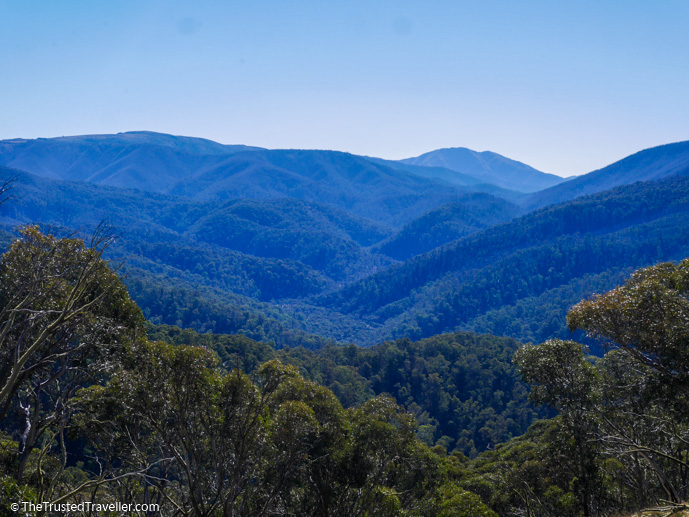
Getting There
A large number of major and budget airlines fly direct to capital cities such as Sydney, Melbourne and Brisbane from New Zealand, the Pacific Islands, Asia and parts of the US and the Middle East. If you are travelling from further afield, you’ll easily be able to find connecting flights through major hubs in Asia, the Middle East and west coast USA.
Remember, Australia a long way from most other parts of the world. It takes almost 20+ hours (with a short stopover) to get from the UK and Europe, and 14+ hours from the US. Asia is a little closer with Singapore and Bangkok about 8 hours away.
I use and recommend Expedia for researching and booking flights all around the world.
Getting Around
Australia is a big country. Bigger than most people actually realise. To give you an idea, if you were to drive from Sydney on the east coast to Perth on the west coast it would take you something like 40 hours without stopping. That is 4,000 kilometres! The same route by air would take you 4 hours.
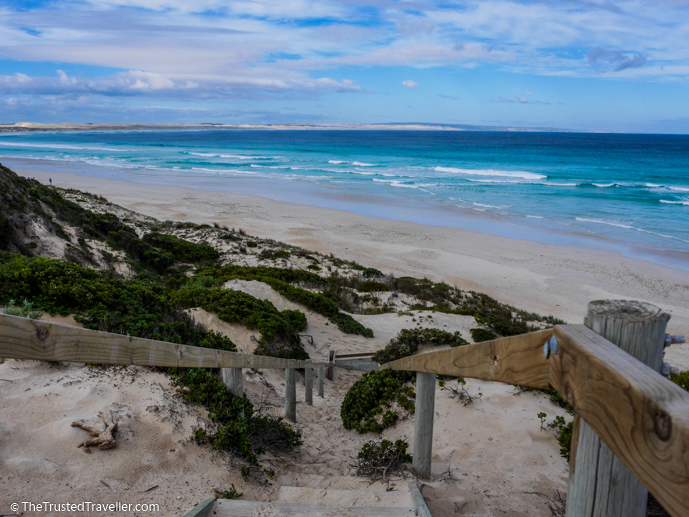
If you are wanting to cover as much of the country as possible in a short time then flying will be the most efficient method of getting around but it will likely cost you a bit too. While Australia does have budget airlines, they don’t offer the crazy low prices quite like other parts of the world so a bit of research and planning is required to do this on the cheap.
Australia’s major air carrier is Qantas who service every capital city and major rural hub. Catching up with Qantas on popularity is the once budget airline Virgin Australia. They fly between all capital cities and a few of the major hubs as well and offer pricing that is comparative to Qantas, sometimes a little cheaper.
Australia’s budget airlines are Jetstar (part of Qantas) and TigerAir. They both offer lower fares with a budget service, so no meals and you pay extra for carry-on luggage, extra leg-room and entertainment. If your flying regional then it will likely be with REX or one of the many other small regional airlines specific to each region.
If you have a bit more time to spare, Australia is a great country to explore slowly by road, whether it be in a car, van or caravan.
Australia has branches of all the worlds major car hire companies with pick up locations in airports, city centres and some regional centres. Most will offer vehicles in a range of sizes to suit your particular needs.
For longer stays it might be worth buying a used vehicle and then selling it when you leave. Cars, vans, caravans and campervans can all be purchased for as little as a few thousand dollars and sold a few months later to another traveller for about the same price ensuring you don’t really loose any money from it. Gumtree and hostel notice boards are good places to find and later sell, these vehicles.
I use and recommend Hertz for researching and booking car hire all around the world.
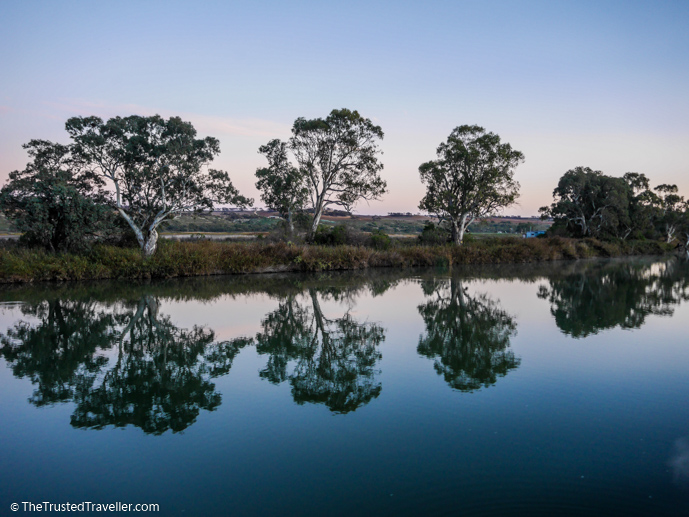
Greyhound have an extensive network of buses that cover major cities and tourist hubs the states of New South Wales, Victoria, Queensland, South Australia and Northern Territory.
In Western Australia there is TransWA which operates a network of road coaches throughout the state helping you get from Perth to some of the more remote areas of the state.
And in Tasmania Tassielink Transit operate the bus network offering regular route services across Tasmania that includes cities, regional areas and access to bushwalks.
I use and recommend BusBud when comparing and booking buses all around the world.
Australia hasn’t got any where near as good a rail system as regions like Europe and Asia however if you are a rail enthusiast then you will find two of the worlds most iconic rail journey’s running across the country.
The Ghan runs through the Red Centre from Adelaide to Darwin and The Indian Pacific from Adelaide to Perth. Both offer options for those on budget (still not as cheap as other forms of transport) to those looking for the ultimate in rail travel luxury. Each journey takes a few days to complete with short stops along the way.
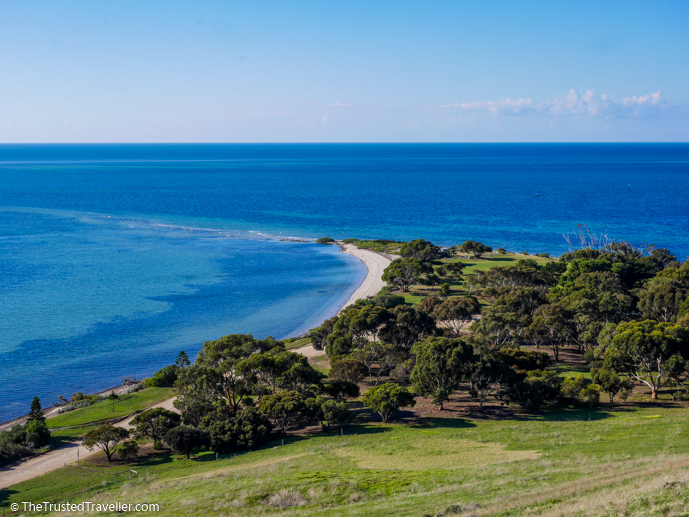
Where to Stay
Australia caters for everyone when it comes to accommodation. Here is a list of the types of accommodation you’ll find.
- Camping/Caravans/Cabins – Most National Parks have at least one bush campsite and every second or third town has a holiday park with campsites, caravans and cabins available. Free camping is also available in some areas.
- Hostels – Take your pick from the hundreds of private and chain hostels located in major cities and popular towns around the country. Accommodation in hostels ranges from multi-bed dorm rooms to private single, double and family rooms, with or without shared facilities.
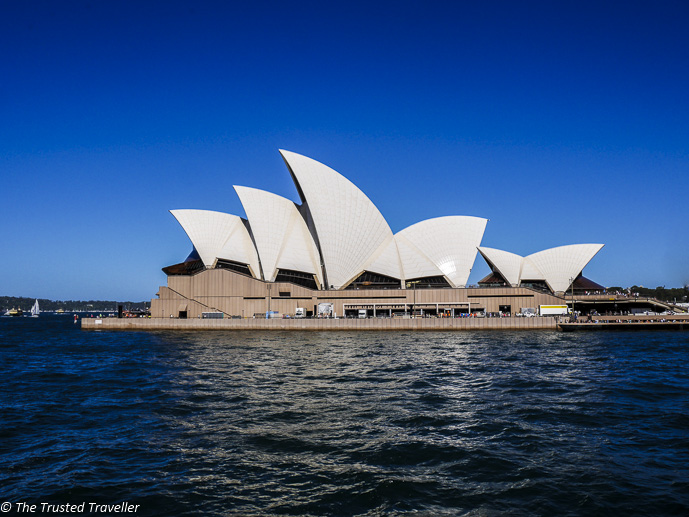
- Budget Motels/Hotels – This type of accommodation is quite popular in Australia and you’ll find at least one or two budget motels/hotels in just about ever town in the country. Most will be clean and functional with private facilities and basic amenities.
- Hotels/Apartments – Just about ever chain hotel brand in the world is represented in Australia’s capital cities and other major towns. The good thing about this type of accommodation is in most cases you know what you are going to get, a clean, comfortable and modern room with a decent array of facilities in the room and on the property. Apartments are great for longer stays as they allow you a bit more space and the option to self cater.
I use and recommend Booking.com for researching and booking hostel, motel, hotel, apartment and resort accommodation around the world, including Australia.
- Luxury Hotels & Resorts – Every capital city and popular tourist area in Australia has its share of 5 star properties, some of which have been named in top lists of accommodations around the world.
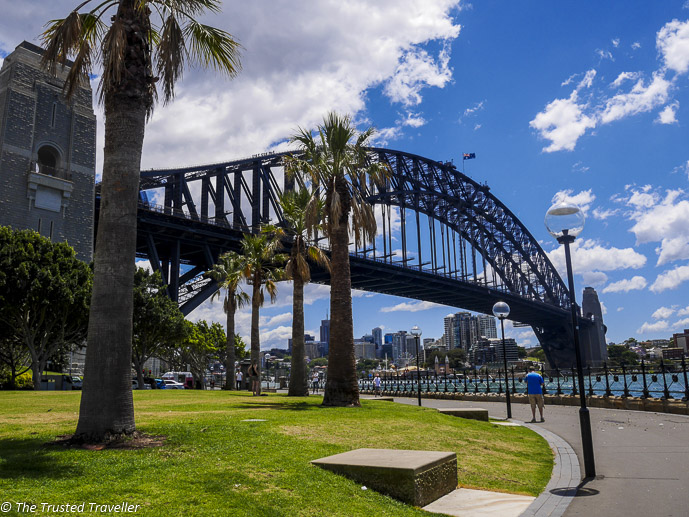
- B&B’s – Small family run style accommodation like B&B’s can be found all over the country in small towns and popular rural locations. Accommodation is simple yet comfortable and the experience usually comes with friendly hosts and a home cooked breakfast each morning.
Eating out in Australia can be expensive in comparison to some other regions of the world. There are ways around this, especially if you willing to stay in self catering accommodation and do some simple cooking from time to time. Eatability offers an excellent website for eating out in Australia. On it you’ll find venues listed by region, cuisine and price with reviews by past diners to help you choose one that suits you.
- Supermarkets – The two big supermarkets you will encounter in most places are Woolworths and Coles. They both offer competitive pricing and just about any grocery item you might be after. In smaller towns you may encounter an IGA which is similar but because of its smaller size you’ll find it a little more expensive. Aldi is a newer supermarket chain which is quickly catching up to the others because of its super cheap prices.
- Fast Food / Take-away – Chain fast food stores are in all major centres of the country and along highways as well. If your looking for a cheap and tasty fast food meal, skip the chains like Maccas (what us Aussies call McDonalds) and go for a local family owned hamburger or fish and chip shops instead. You’ll find at least one of this style of take-away store in every city and town of the country.
- Cafes – Cafes can vary greatly in price and quality depending on the city/town or area of a city/town. Meals range from simple sandwiches and salads to hot dishes made fresh or served from a food warmer. Cafes offer the chance to have a large hot meal at lunch time so in the night time you’ll only need a snack.
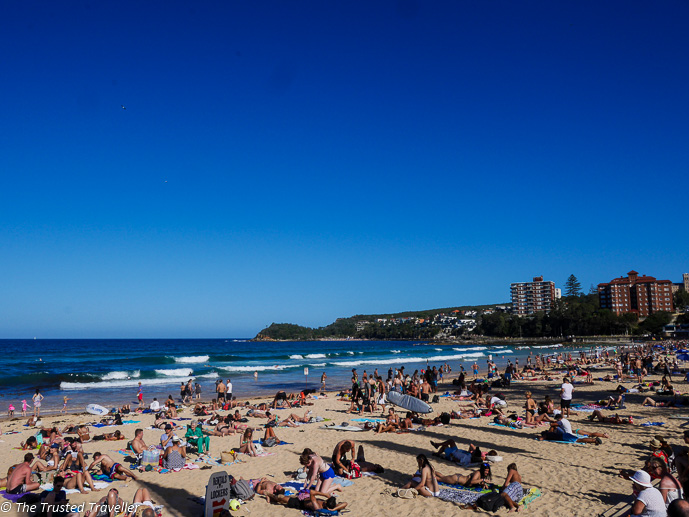
- Pubs – Every city or town in Australia has a decent pub. Some small towns with only a few hundred people in them might surprisingly have multiple pubs. Having a schooner, pot, pint or midi (measurements of beer) at the end of a hot day with a simple bistro style meal is just part of the Aussie way. Pubs can vary widely in price these days as a lot in the major cities have been converted to trendy venues serving food that can rival some four start restaurants. However in country towns the meals are cheap and usually made using local produce.
- Restaurants – Just about every cuisine in the world is represented in a restaurant or two in Australia which is one of the reason why I love it so much. Prices in restaurants can vary greatly depending on the location and quality of the food but there are some good cheap ones out there, you just need to dig a little deeper.
- Fine Dining – Australia has it’s fair share of the worlds best restaurants so if it is fine dining experiences you are after then you won’t be disappointed. Some of the worlds top chefs have been opening new venues in capital cities and sleepy country towns for the past few years giving locals and visitor a taste of the finer side of life.
Read More About Australia
Suggested itineraries.
Long Weekend Travel: 5 Easy Trips from Sydney
Exploring the Grand Pacific Drive
How to Spend a Day in Ben Boyd National Park
Two Week NSW South Coast Road Trip Itinerary
Two Week Sydney to Melbourne Road Trip Itinerary (The Coastal Route)
Port Macquarie Weekend Itinerary
3 Days in the Atherton Tablelands: The Perfect Self-Drive Itinerary
One Week Gippsland Victoria Itinerary
9 Best Day Trips from Melbourne
Three Day Great Ocean Road Itinerary
Things to Do
20 Things to Do in Canberra
Things to Do in the Southern Highlands
35 Free Things to Do in Sydney
Things to Do in Eurobodalla on the NSW South Coast
Things to Do on the NSW Sapphire Coast
Things to Do in Kiama and Surrounds
Things to Do in Jervis Bay
Things to Do in the NSW Snowy Mountains
Things to Do in Port Macquarie
15 Things to Do in Coffs Harbour (and surrounds)
Things to Do on Kangaroo Island
Things to Do in Gippsland Victoria
25 Free Things to Do in Melbourne
The Best Annual Events in Melbourne
Things to Do in Melbourne
Things to Do in Victoria’s High Country
Things to See on the Great Ocean Road
Things to Do in Echuca
Hotel Review: Rydges World Square Sydney
Hotel Review: Fairmont Resort Blue Mountains
Hostel Review: Sydney Harbour YHA
The Best Self-Contained NSW South Coast Accommodaiton
Where to Stay in Port Macquarie
Where to Stay in Melbourne
Where to Stay on the Great Ocean Road
Tours & Attractions
Walking the Sea Cliff Bridge
7 Stunning Lookouts in Australia’s Blue Mountains
Visiting Scenic World in Australia’s Blue Mountains
Visiting the Illawarra Fly Treetop Walk
Finding Peace in Sydney’s Chinese Garden of Friendship
The Sydney Tower Eye Skywalk Experience
Best Things to See Around Sydney Harbour
7 Eurobodalla Culinary Delights That Should Not Be Missed
A Magical Oyster Tour on the NSW South Coast
How to Climb Mt Kosciuszko (outside of winter)
Our Luxury Murray River Cruise Aboard the PS Murray Princess
Our Top 4 Kangaroo Island Wildlife Experiences
7 Things You Can Expect on a PS Murray Princess Cruise
What to See & Do in Flinders Chase National Park, Kangaroo Island
A Tour of the Buchan Caves in Gippsland Victoria
Getting Around Guides
Getting Around Sydney
How to Get to Kangaroo Island (plus the best ways to get around)
Inspiration
5 Reasons Why I Love Sydney
The 16 Best NSW South Coast Beaches
5 thoughts on “Australia Travel Guide”
What a treasure trove of information your blog is! Wow. I am not sure when I’ll be able to get to Australia, but I know that when I finally do, I’ll be using your advice a LOT! 🙂 I’ve been wanting to see this continent ever since I read a book about Australia as a teen, and that was quite a while ago. But it’s always been too far and too expensive to visit. Some day I will, though…
Thanks Jolanta. Really appreciate your feedback. I do hope you get a chance to visit Australia sometime soon and when you do make sure you let me know!
Hi Jen, do you having any info. on Tasmania. We are planning a trip to Tasmania in Sept/Oct 2017.
Hi Mag, Tassie is still on my list of places to visit someday so no sorry, right now I can’t offer you any advice. I hope you enjoy your trip there!
Leave a Comment Cancel reply
This site uses Akismet to reduce spam. Learn how your comment data is processed .

Australia Recommends 2024

Come and Say G'day

G'day, the short film

Discover your Australia

Travel videos

Deals and offers

Australian Capital Territory

New South Wales

Northern Territory

South Australia

Western Australia

External Territories

The Whitsundays

Mornington Peninsula

Port Douglas

Ningaloo Reef

Airlie Beach

Kangaroo Island

Rottnest Island

Hamilton Island

Lord Howe Island

Tiwi Islands

Phillip Island

Bruny Island

Margaret River

Barossa Valley

The Grampians

Hunter Valley

McLaren Vale

Glass House Mountains

Alice Springs

Uluru and Kata Tjuta

The Kimberley

Flinders Ranges

Kakadu National Park

Eyre Peninsula

Karijini National Park

Great Barrier Reef

Blue Mountains

Daintree Rainforest

Great Ocean Road

Purnululu National Park

Cradle Mountain-Lake St Clair National Park

Litchfield National Park

Aboriginal experiences

Arts and culture

Festivals and events

Food and drink

Adventure and sports

Walks and hikes

Road trips and drives

Beaches and islands

Nature and national parks

Eco-friendly travel

Health and wellness

Family travel

Family destinations

Family road trips

Backpacking

Work and holiday

Beginner's guide

Accessible travel

Planning tips

Trip planner

Australian budget guide

Itinerary planner

Find a travel agent

Find accommodation

Find transport

Visitor information centres
Deals and travel packages

Visa and entry requirements FAQ

Customs and biosecurity

Working Holiday Maker visas

Facts about Australia

Experiences that will make you feel like an Aussie

People and culture

Health and safety FAQ

Cities, states & territories

Iconic places and attractions

When is the best time to visit Australia?

Seasonal travel

Events and festivals

School holidays

Public holidays
How to get to Australia's most iconic cities

How long do I need for my trip to Australia?

How to travel around Australia

Guide to driving in Australia

How to hire a car or campervan

How to plan a family road trip

How to plan an outback road trip

Great Barrier Reef Drive, Port Douglas, QLD © Travellers Autobarn
Start planning your trip to Australia
So, you've decided to visit Australia? Great choice! Let's start planning your ultimate holiday.
Link Copied!

First trip to Australia?
No worries our beginner's guide has everything you need to know for the ultimate trip down under., know before you go.

Weather in Australia

Trips and itineraries

3 - 6 day itineraries

7 - 10 day itineraries

Two-week itineraries

Road trips and self-drive journeys
Frequently asked questions.

Plan your trip

Health and safety information
Make your holiday happen.

Find transportation

Getting around

How to get to Australia's most iconic cities and destinations

First timers guide to driving in Australia

How to hire a car, campervan or 4WD in Australia

How to plan a family road trip in Australia

How to plan an Australian outback road trip
About australia.

Why Australia is the best place to visit

A handy guide to the Australian lifestyle

Australian states, territories and capital cities

History of Australia for the curious traveller
We use cookies on this site to enhance your user experience. Find out more . By clicking any link on this page you are giving your consent for us to set cookies.
Acknowledgement of Country

We acknowledge the Traditional Aboriginal and Torres Strait Islander Owners of the land, sea and waters of the Australian continent, and recognise their custodianship of culture and Country for over 60,000 years.
- New Zealand (English)
- United States (English)
- Canada (English)
- United Kingdom (English)
- India (English)
- Malaysia (English)
- Singapore (English)
- Indonesia (Bahasa Indonesia)
- Deutschland (Deutsch)
- France (Français)
- Italia (Italiano)
- 中国大陆 (简体中文)
*Product Disclaimer: Tourism Australia is not the owner, operator, advertiser or promoter of the listed products and services. Information on listed products and services, including Covid-safe accreditations, are provided by the third-party operator on their website or as published on Australian Tourism Data Warehouse where applicable. Rates are indicative based on the minimum and maximum available prices of products and services. Please visit the operator’s website for further information. All prices quoted are in Australian dollars (AUD). Tourism Australia makes no representations whatsoever about any other websites which you may access through its websites such as australia.com. Some websites which are linked to the Tourism Australia website are independent from Tourism Australia and are not under the control of Tourism Australia. Tourism Australia does not endorse or accept any responsibility for the use of websites which are owned or operated by third parties and makes no representation or warranty in relation to the standard, class or fitness for purpose of any services, nor does it endorse or in any respect warrant any products or services by virtue of any information, material or content linked from or to this site.

Australia Travel Guide
Last Updated: April 1, 2024

Australia is one of the most popular travel destinations in the world. It’s known as a major backpacking, camping, road tripping, and diving destination.
Backpacking Australia is considered a “must do” for backpackers. It’s a central highlight on the round-the-world trail. I started coming to Australia in 2008 as a backpacker. It hooked me and, since then, I’ve visited over five times and have crisscrossed the country three times. Every single trip I discover something new about this country to love.
But this isn’t just a country for backpackers. Its huge diversity means every traveler can find something they love here.
Australia is filled with incredible natural beauty: Uluru and the Outback, rainforests and pristine white sand beaches, and of course, the Great Barrier Reef. Sydney’s Harbor Bridge and Opera House are iconic man-made wonders, and Melbourne’s café culture will make you feel like you’re relaxing in Europe . You have surfing, hiking, camping, boating, and a ton of other activities available to you. It makes some of the best wine in the world. Australia has it all.
However, the country’s size and limited transportation options, makes it hard to get around. And it’s not the cheapest place to visit, even if the currency is a tad weak right now.
Fortunately, this extensive Australia travel guide will show you how to save money, plan your trip, and make the most of your time Down Under. Because this country is worth taking the time to explore – and doesn’t need to cost a fortune!
Table of Contents
- Things to See and Do
- Typical Costs
- Suggested Budget
- Money-Saving Tips
- Where to Stay
- How to Get Around
- How to Stay Safe
- Best Places to Book Your Trip
- Related Blogs on Australia
Click Here for City Guides
Top 5 things to see and do in australia.
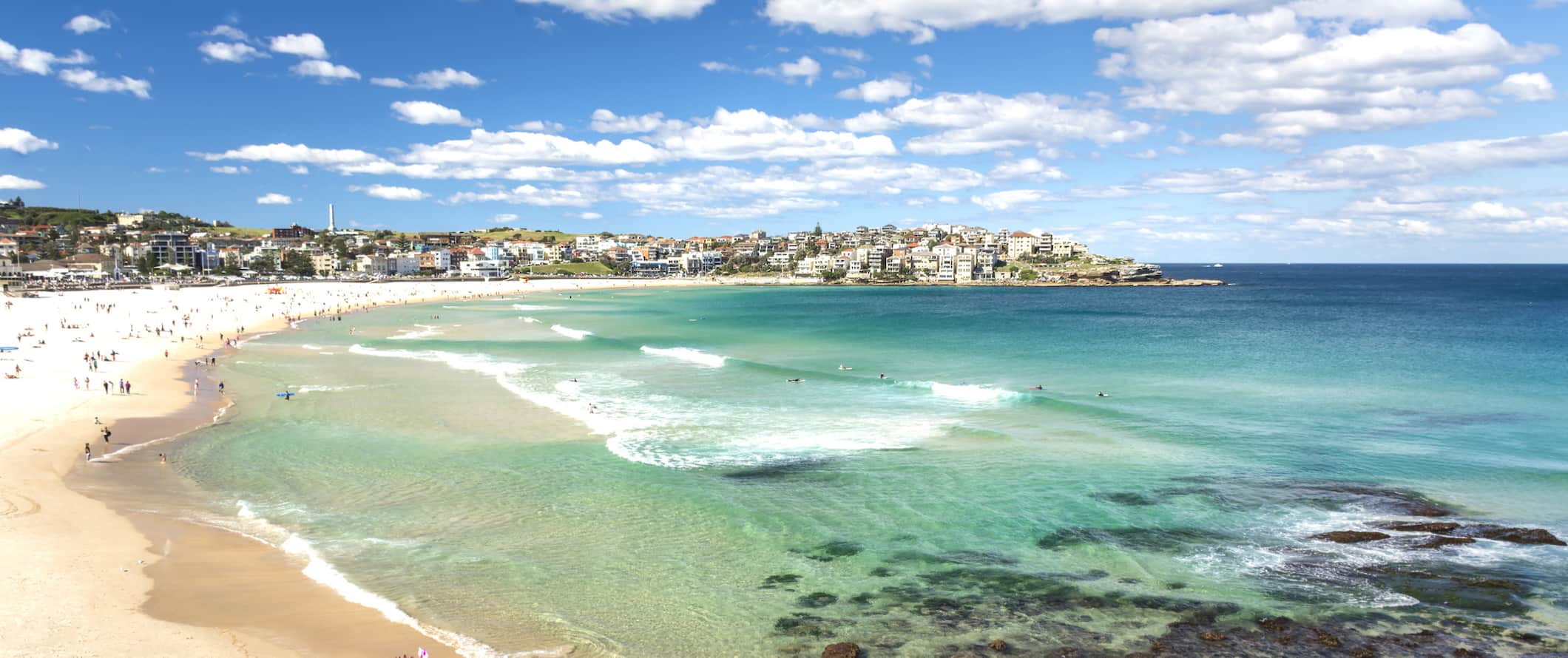
1. See Sydney
Australia’s largest city has a range of activities to keep you busy. Climb the Sydney Harbour Bridge, surf at Bondi Beach, party in King’s Cross, sail across the harbor, visit the Opera House, and take in world-class innovation in Darling Harbor. There’s a ton to see and do here and it’s worth spending a few days here to soak it all in. Other popular beaches nearby include Manly (wide and beautiful), Bronte (small and quiet), Coogee (fun), Palm (chill), and Dee Why (surfing). And, if you’re feeling adventurous, tours that climb the iconic (and massive) harbor bridge cost 250 AUD.
2. Visit Uluru
This beautiful red rock formed over 550 million years ago. Tourists have been visiting the rock since the 1930s and it’s of great spiritual importance to the local Aboriginal peoples. Formerly known as Ayers Rock, the best way to visit is by going as part of a multi-day tour of the area or driving on your own. You’ll be able to walk around the rock, learn about its cultural importance, and watch the rising/setting sun splash against it. Admission is 38 AUD per person and is valid for three days. Note: Climbing on the rock is prohibited.
3. Dive the Great Barrier Reef
Don’t miss diving or snorkeling the Great Barrier Reef. It’s the largest living organism on Earth, spanning some 344,000 square kilometers (133,000 square miles). The reef is brimming with wildlife, including giant clams, manta rays, sharks, turtles, clown fish, and more! Cairns is the most popular jumping-off point for dive trips to the reef. I was blown away by the abundant wildlife and coral. It did not disappoint! Dive trips start around 230 AUD.
4. Explore Melbourne
Melbourne is much more relaxed than Sydney (and, personally, I like it more). This is the place to relax by the river, walk through the city gardens, eat amazing food, enjoy the art, and party in St. Kilda. It’s a fun, chill city with a youthful vibe and a ton of backpackers.
5. Sail the Whitsundays
The Whitsunday Islands are a collection of 74 islands off the central coast of Queensland. They’re one of the most popular destinations in the country. It’s a popular region for sailing trips and since the vast majority of these islands are designated national parks, you’ll find numerous pristine beaches and dive sites here. It’s a postcard-perfect region. Expect to pay between 399-499 AUD per person for a three-day/two-night sailing trip. While expensive, it’s worth doing (I loved my trip).
Other Things to See and Do in Australia
1. explore fraser island.
The world’s largest sand island is a popular spot for camping, swim, hike, and seeing dingoes. You can hire your own 4WD car or take an overnight tour through the island that’s famous for its freshwater lake (and dingoes). The island is beautiful and filled with lakes, hiking paths, and sweeping vistas. Sadly, you can’t go in the water nearby as it’s rough and full of sharks, but there’s plenty of fishing, cool sand dunes, the stunning 75 Mile Beach, and a cool shipwreck for snapping photos. Camping on the island is super cheap too (less than 10 AUD per night!).
2. Visit Cairns
Cairns is Australia’s gateway to northern Queensland. From here you can visit the Great Barrier Reef, the Daintree rainforest, the Atherton Tablelands, Cape Tribulation, and much more. Cairns is a pretty typical tropical city and life here focuses on taking the time to smell the roses. With so much to see, the city deserves a very long stay. Plan to visit for a week, which should give you enough time to explore the area and allows some downtime by the city’s awesome pool.
3. Wander Brisbane’s South Bank
Brisbane is a “business city.” Unlike Sydney or Melbourne, there isn’t a lot of “culture” here. But it’s a popular stop on the backpacker trail due to its location. Be sure to explore South Bank, which has some nice restaurants and decent pubs. There’s also an educational koala sanctuary here as well as a relaxing botanical gardens.
4. Hike the Daintree
The world’s oldest rainforest (yes, it’s older than the Amazon) offers hikes that range from easy to challenging, with dense jungles, beautiful mountains, waterfalls, and lots of wildlife. Spend a few days hiking around and getting out of touristy Cairns. If you really want to get off the beaten path, head up to Cape Tribulation and enjoy some real peace and quiet (just watch out for jellyfish when you go swimming). There are all kinds of day and multi-day trips available here with two-day guided trips costing around 350 AUD per person.
5. See Perth
Perth is Australia’s west coast capital and is often overlooked by most travelers. It’s expensive to get out there from the east coast (it’s a 5-hour flight from Sydney) so most travelers avoid it. But I love it. In fact, it’s probably my favorite city in all of Australia. Perth feels more like a large town than a city and is the best place to have a “Sunday Session” (an Aussie tradition of drinking on Sunday afternoons). From the beaches, food, and beer (be sure to take a day trip to Freemantle), Perth is just awesome.
6. Explore the Outback
No trip to Australia is complete without a trip to the Outback to see crocodiles, valleys, lakes, and the red desert. Find your own Crocodile Dundee as you explore the Red Center and Western Australia. And be sure to visit some of the places I love: Karijini National Park, the Kimberleys, Kakadu, and Litchfield National Park. The landscapes are stunning and there are all kinds of epic hikes to enjoy.
7. Surf on the Gold Coast
Australia is famous for its surfing, and one of the best places to learn is on the Gold Coast near Brisbane. You’ll find world-class waves, a wide beach, and lots of available lessons. If you don’t like the Gold Coast , there is always Noosa, Byron Bay, Bondi Beach, Perth, and, well, you get the idea. There’s a lot of surfing in Australia! A two-hour group lesson costs around 75 AUD. If you don’t need lessons and just want to surf, you can rent a board for around 60 AUD per day.
8. Take a wine tour
Whether you go down to Margret River, Hunter Valley, or the Barossa Valley, you will have many chances to taste Aussie wine right from the source. Visiting the wine country should be on your list of things to do. If you rent a car, you can stay longer or you can do guided tours from major cities. I think it’s best to base yourself in the area and spend about 3-5 days in each area tasting as much wine as possible. Day tours with Colorful Trips that visit three wineries in the Hunter Valley cost 199 AUD.
9. Admire the Ningaloo Reef
The Great Barrier Reef gets all the hype, but the Ningaloo Reef on the west coast is a far better reef system. Because it’s less developed and attracts fewer tourists, there are actually more fish and wildlife here — you can even swim with whale sharks . Plus, at some points (like at Coral Bay), the reef comes so close to the shore that you can swim right up to it on your own. Half-day trips start around 120-225 AUD per person.
10. Visit Western Australia
The most overlooked area in the country is the west coast. Here you can escape the crowds of the east coast, explore the Outback, see the Ningaloo Reef, Coral Bay (one of my favorite spots in the world), Broome, Perth, and the Margaret River. It’s much less developed than the east coast but if you take one piece of advice away from this guide, it should be to visit this part of Australia. It’s the version of the country you picture in your head and is an amazing region for road trips, camping, hiking, and enjoying nature.
11. Tour Tasmania
Despite everyone knowing its name, hardly anyone ever makes it down here. (It’s far from the main tourist trail.) Tasmania has amazing hikes, beautiful bays (Wineglass Bay being the most famous), small towns, and excellent people. It’s just a ferry away from Melbourne too. The island is about the size of Ireland (or West Virginia in the USA) yet it’s home to just under 545,000 people. If you have the time, explore this terribly under-visited part of the country. It’s amazing. The ferry from the mainland costs around 100 AUD each way and takes 9-11 hours.
12. Hike the Blue Mountains
Right outside of Sydney , the Blue Mountains are an awesome place to explore. Over millennia, the ancient sandstone of this national park has been weathered into gorges lined by steep cliffs and separated by narrow ridges. The area is free to visit and you can get there by train, which takes around two hours. Spend the day admiring the magnificent rock formation of the Three Sisters (particularly stunning at sunset and under evening floodlights) and hiking along the paths that offer excellent views of the valley, sheer rock walls, tumbling waterfalls, and magnificent forests. For a guided tour, Get Your Guide offers full-day wildlife-spotting tours for 155 AUD.
13. Learn about pearling in Broome
Broome used to be the largest pearling port in the world. Founded around 1880, pearls were an important commodity used for making cutlery, buttons, and jewelry. By 1900, there were 300 ships here, though the industry fell into decline during World War II (and then, after the war, plastic was invented, which diminished the need for pearls). You can learn all about the region’s rich history at the Pearl Lugger Museum (tours for 30 AUD). If you want a more hands-on experience, Willie Creek Pearls also offers a two-hour boat tour for 129 AUD. You’ll learn about the risks and challenges of the industry while also getting to hold and touch all kinds of valuable pearls.
14. Visit the Kimberley
This area is known for its wilderness, so if you love the outdoors and don’t mind things getting rugged, add this to your itinerary. Located near Broome, this outback region is three times bigger than England that’s filled with stunning gorges, beautiful waterfalls, and a vast desert landscape. It was one of the first areas settled in Australia some 65,000 years ago (Europeans didn’t arrive here in the 1830s). There are all kinds of day trips and hikes here that you can do solo, as well as multi-day guided tours. Expect to pay around 1,200 AUD for a three-day guided excursion. If you’re going solo, popular overnight hikes include Piccaninny Gorge and Lurujarri Dreaming Trail.
15. Explore Kakadu National Park
The enormous Kakadu National Park is a biodiverse nature reserve in Australia’s Northern Territory. It encompasses wetlands and rivers and is home to saltwater crocodiles and flatback turtles, as well as many different bird species. Rock paintings (dating back to prehistory) can be viewed at Nourlangie, Nanguluwur, and Ubirr. You can find a lot of tours departing from Darwin. Be sure to spend at least a night in the park! Three-day tours cost around 735 AUD.
For more information on specific cities in Australia, check out these guides:
- Alice Springs Travel Guide
- Brisbane Travel Guide
- Broome Travel Guide
- Cairns Travel Guide
- Fraser Island Travel Guide
- Gold Coast Travel Guide
- Melbourne Travel Guide
- Perth Travel Guide
- Sydney Travel Guide
- Whitsunday Islands Travel Guide
Australia Travel Costs
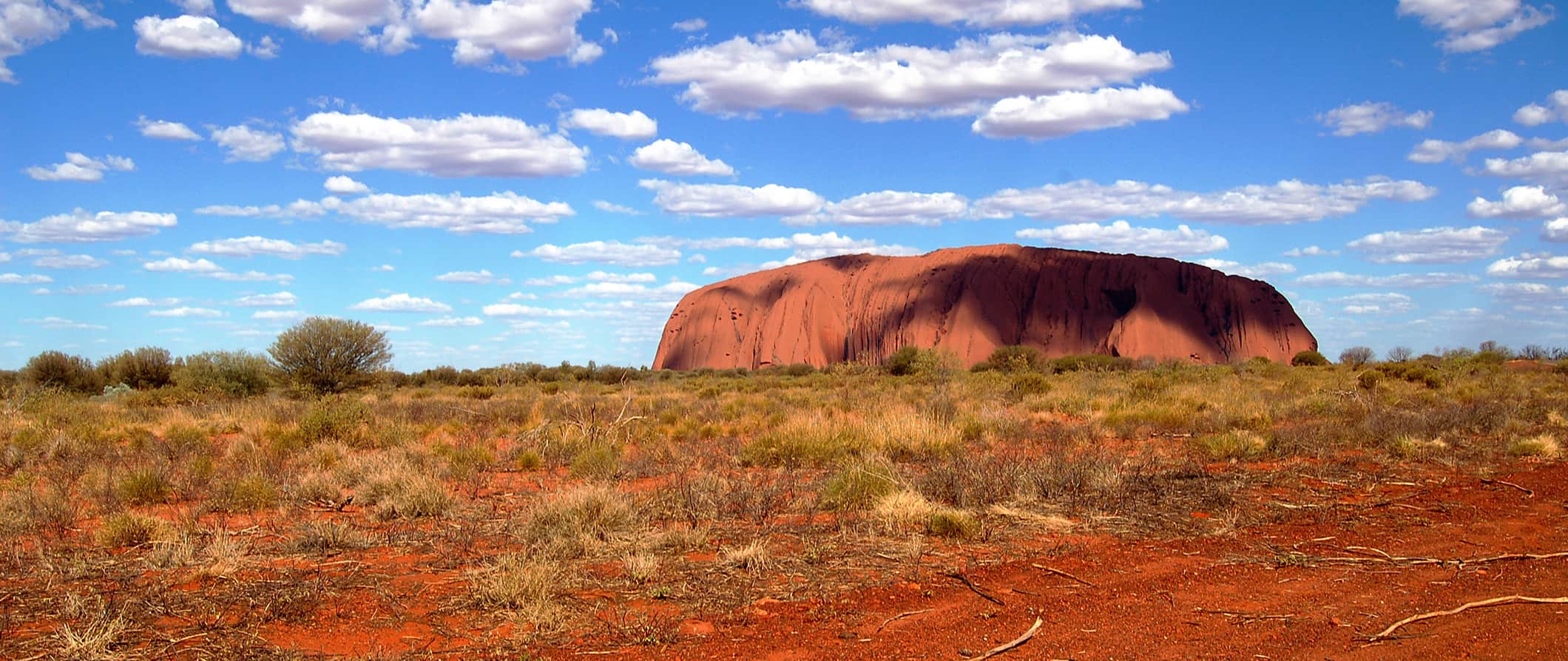
Accommodation – Hostels dorms start around 25-30 AUD per night, though they get as high as 40 AUD in the big coastal cities. Private rooms with a double bed and a shared bathroom in hostels range between 65-100 AUD per night, though in larger cities they can be as high as 150 AUD. Expect basic amenities like free Wi-Fi and self-catering facilities. Only some hostels include breakfast.
For those traveling with a tent, a basic tent plot without electricity starts around 7 AUD, though most are 10-25 AUD per night.
For budget hotels, expect to spend 100-120 AUD per night for a two-star hotel. Amenities usually include TV, Wi-Fi, and AC. Some hotels have a pool.
Airbnb is available around the country with private rooms starting around 40 AUD (though they average closer to 90 AUD). Entire homes/apartments cost at least 140 (though they are usually double or even triple that price so be sure to book early). Expect to pay about 10-20% more in the coastal cities.
Food – Food in Australia is diverse, with each region having its own specialties. While you can find cuisine of all types here, popular traditional choices include BBQ meat (especially sausages), meat pies, fish and chips, seafood, chicken parmigiana (chicken schnitzel topped with tomato sauce, ham, and melted cheese), and, of course, the infamous vegemite on toast.
Food prices vary per region, but generally, you can expect to pay 20-25 AUD for a meal at a casual restaurant. A fast-food combo from somewhere like McDonald’s costs 13-14 AUD while a pizza costs around 16-20 AUD. Chinese, Thai, and Indian food cost 12-20 AUD for a main dish.
If you want to splash out for something more upscale, a expect to pay around 55-70 AUD, including a drink, per person.
A beer is around 8 AUD, latte or cappuccino costs around 5 AUD, and bottled water between 2-3 AUD.
If you cook your own meals, expect to pay around 75-95 AUD per week for groceries. This gets you basic staples like pasta, rice, seasonal produce, and some meat.
Backpacking Australia Suggested Budgets
On a backpacker budget, you can visit Australia for 70 AUD per day. This assumes you’re staying in a cheap hostel, cooking all of your meals, using public transportation to get around, and doing mostly cheap or free activities like hiking and enjoying the beaches. If you camp, you can lower this budget by around 20 AUD per day. If you plan on drinking, add 10-20 AUD to your daily budget.
On a mid-range budget of 200 AUD per day, you can stay in a private Airbnb or hostel room, eat out for a couple of meals, enjoy a few drinks, take the occasional taxi to get around, bus between cities, and do more paid activities like taking surf lessons or going diving.
On a “luxury” budget of 385 AUD or more, you can stay in a hotel, eat out for all your meals, drink more, rent a car or camper van to explore, and do whatever tours and activities you want. This is just the ground floor for luxury though. The sky is the limit!
You can use the chart below to get some idea of how much you need to budget daily, depending on your travel style. Keep in mind these are daily averages – some days you’ll spend more, some days you’ll spend less (you might spend less every day). We just want to give you a general idea of how to make your budget. Prices are in AUD.
Australia Travel Guide: Money-Saving Tips
Australia can be a very expensive country to visit. If you aren’t careful, you’ll blow through your entire budget in no time as activities, food, and transportation all adds up fast here. Fortunately, there are lots of ways to save too. Here are some ways to save money when you visit Australia:
- Drink goon (box wine) – Goon is infamous on the Australian backpacker hostel trail. This cheap box of wine is the best way to drink, get a buzz, and save a lot of money at the same time. Drink this before you go out and save on spending money at the bar.
- Cook your own meals – The best way to reduce your costs is to cook as many meals as possible. Hostels and Airbnbs usually have kitchens and, while it’s not glamorous, it will save you a ton of money!
- Car share – Australia is a big country that can be expensive to get around. If you are traveling with friends, it’s smart to buy a used car or campervan (or rent a new one from one of the many rental companies in the country) and split the costs of gas. You can also hitch a ride with other travelers using sites like Gumtree, Jayride, or hostel message boards.
- Book tours as a package – This country has a lot of exciting activities and tours that eat into any budget. Booking activities together through a hostel or tour agency can get you a discount and save you hundreds of dollars.
- Work for your room – Many hostels offer travelers the opportunity to work for their accommodation. In exchange for a few hours a day of cleaning, you get a free bed to sleep in. Commitments vary but most hostels ask that you stay for at least a week. Check with the staff when you arrive to see if there are any opportunities available.
- WWOOF – WWOOFing is a program that allows you to work on organic farms in exchange for free room and board. Everyone I’ve met who stays in the country long-term does it for at least one month. It’s a great way to reduce your expenses and can a deeper look into local life.
- Stay with a local – Accommodation in Australia is pricey. If you plan ahead, you can usually find a Couchsurfing host that will host you for free. It’s the best way to connect with a local and get insider tips and advice.
- Camp – Camping is very affordable here, with basic tent plots costing as little as 7 AUD per night!
- Bring a reusable water bottle – The tap water in Australia is safe to drink so bring a reusable water bottle with you to save money and lower your plastic use. LifeStraw makes a bottle with a built-in filter to ensure your water is always clean and safe.
Where To Stay in Australia
I’ve been a backpacker here for ages and have accumulated a long list of places to stay. Here are my suggested places to stay in Australia if you’re looking for a hostel:
- Base St. Kilda (Melbourne)
- Space Hotel (Melbourne)
- Wake Up! (Sydney)
- YHA Rocks (Sydney)
- Bunk Brisbane (Brisbane)
- City Backpackers HQ (Brisbane)
- Kimberley Travellers Lodge (Broome)
- The Shiralee Hostel (Perth)
- Aquarius Backpackers (Byron Bay)
- Gilligan’s Backpacker Hotel & Resort Cairns (Cairns)
- Nomads Noosa (Noosa)
- Alice Lodge Backpackers (Alice Springs)
How to Get Around Australia
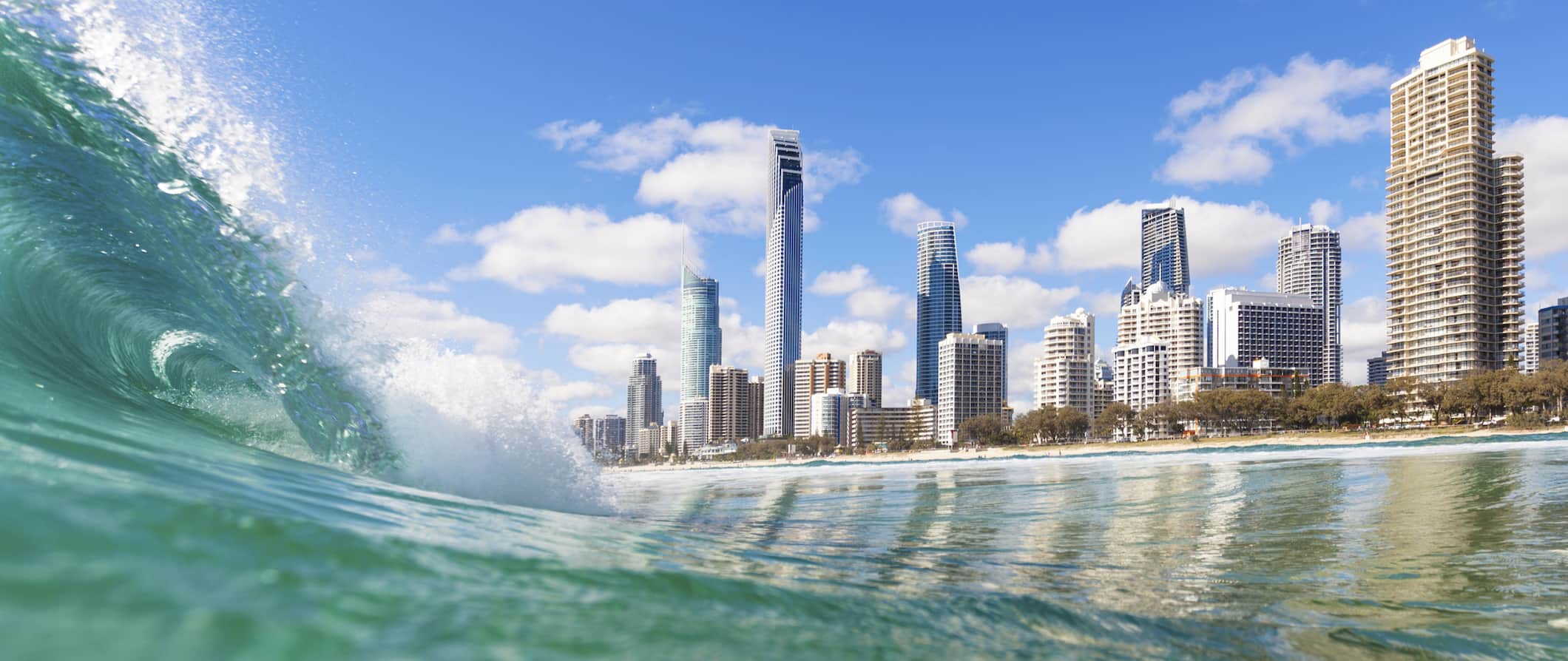
Public transportation – All of Australia’s cities have reliable, affordable public bus systems. In the bigger, cities such as Sydney, Melbourne, Brisbane, Adelaide, and Perth, you’ll even find subways and tram systems. This is the cheapest way to travel the cities. Fares cost between 2.75-4 AUD.
Many cities offer day passes that include unlimited public transportation for under 10 AUD.
Bus – After driving, this is my favorite transportation option in Australia. On the east coast, this will be your cheapest option too. On the west coast, buses are surprisingly expensive as there are not many people moving up and down that coast and there’s limited competition. However, on the east coast, you can find really cheap bus tickets, especially if you book in advance.
The two main bus companies in Australia are:
- Greyhound Australia
Greyhound also offers several bus passes. Their Whimit Passes range from 15-120 days of unlimited travel and are perfect for traveling around on a whim (hence the name). They come in 15, 30, 60, 90, and 120-day passes costing 349-729 AUD.
To find bus routes and prices, use BusBud .
Backpacker Bus – If you want to party with other backpackers as you travel, book a seat on the Magic Bus . This backpacker bus departs with 25 backpackers aged 18-35 for 3-4 weeks of exploring the country’s national parks, camping, bonfires, and non-stop parties and shenanigans.
Trips go from Perth north to Broome or east to Melbourne each month, so you have to time your trip accordingly to line up with the set departure. The itineraries are always flexible so every trip is unique. They try to keep a balance of 50% men and 50% women, as well as a balance of different nationalities, so there is always a diverse group. Prices vary so contact them for departure dates and ticket prices.
Train – Between city trams, commuter trains, and long-distance and trans-continental trains, Australia can be seen extensively by rail. Train lines exist mostly on the east coast with only two other major lines in the country: one goes north/south from Melbourne to Darwin and another east/east from Sydney to Perth.
For reference, Sydney to Canberra takes 5 hours and is 40-50 AUD while the 11-hour trip from Sydney to Melbourne costs over 200 AUD. Sydney to Brisbane takes 14 hours and costs 100-140 AUD.
Beyond the east coast, trains aren’t as plentiful and long-distance trains can be very expensive.
Flying – With Australia spanning over 7,000,000 square kilometers, it takes a long time to get around the country. Flying is one of the most efficient ways to city hop, but it’s not the cheapest. Australia’s major airlines include:
When booked in advance, flights can be very affordable here. Sydney to Melbourne is just 55 AUD and takes 90 minutes while Sydney to Cairns takes 3 hours and costs around 100 AUD each way. To cross the country, flights last around 5 hours. Sydney to Perth, when booked in advance, can cost as little as 150 AUD each way.
When not booked early, however, flights can easily double or triple these prices.
Rideshares – Every hostel has a bulletin board where travelers post rides and websites like Gumtree have active ridesharing sections where people look for cars or riders. I HIGHLY recommend this way of traveling when in the country. CoSeats is another good resource for finding rides.
Car rental – Car rentals start around 40 AUD per day. You don’t need one to explore any of the cities but if you want to travel the country then a car is best. Just remember that they drive on the left here.
Additionally, you can also purchase a car from backpackers leaving the country or locals selling used cars. You can usually find a used car for under 3,000 AUD. It might seem a lot, but there are always backpackers looking to share rides, which can cut down on our expenses.
When to Go to Australia
Temperatures vary across the country (it’s a huge landmass after all), but generally speaking, average summer temperatures range from 20-37°C (68-99°F). Remember that summer is from December-February here in the southern hemisphere. This is the most popular time to visit so expect big crowds and higher prices.
June-August (winter) is the low season. Prices are lower and there are fewer crowds. The temperature dips as well, hovering around 1°C (52°F) in the south while going as high as 30°C (86°F) in the north.
Spring and fall (March-May and September-October) are the shoulder season and the best time to visit. Crowds aren’t as big and prices aren’t as high and the weather is still enjoyable too, rarely dipping below 17°C (63°F).
Note that October to April is also “jellyfish season,” making waters unsafe for swimming or any other water sport. If you’re planning on enjoying Australia’s coast, this probably isn’t the best time to come. The season lasts from October to April in Northern Australia, and then from November to March elsewhere.
How to Stay Safe in Australia
Australia is an incredibly safe place to backpack and travel around. Violent attacks and petty theft are rare here so you’re unlikely to get into trouble.
Most incidents in Australia tend to occur because visitors are not used to the country’s unique climate and wilderness. Be sure you have plenty of sunscreen and stay as hydrated as possible. This is especially true if you’re driving through the Outback. There are long, long distances without any towns in sight, so if you break down, you’ll want to be prepared. Always make sure you have enough gas in your vehicle for long drives.
If you’re hiking, make sure you know what to expect ahead of time. Be on the lookout for snakes and spiders. If you’re bitten, seek immediate care.
If you’re swimming, heed the red and yellow flags. Yellow flags indicate swimming conditions may be dangerous; red flags mean the beach is closed.
Mother Nature in Australia is NOT a force to be reckoned with in this country. Don’t be a hero.
Solo female travelers are generally safe here, however, the standard precautions apply (never leave your drink unattended at the bar, never walk home alone at night intoxicated, etc.). Consult other solo female travel blogs for specific advice.
If you’re worried about travel scams, you can read about common travel scams to avoid here . There aren’t many in Australia though so I wouldn’t worry too much here.
If you experience an emergency, dial 000 for assistance.
The most important piece of advice I can offer is to purchase good travel insurance. Travel insurance will protect you against illness, injury, theft, and cancellations. It’s comprehensive protection in case anything goes wrong. I never go on a trip without it as I’ve had to use it many times in the past. You can use the widget below to find the policy right for you:
Australia Travel Guide: The Best Booking Resources
These are my favorite companies to use when I travel. They consistently have the best deals, offer world-class customer service and great value, and overall, are better than their competitors. They are the companies I use the most and are always the starting point in my search for travel deals.
- Skyscanner – Skyscanner is my favorite flight search engine. They search small websites and budget airlines that larger search sites tend to miss. They are hands down the number one place to start.
- Hostelworld – This is the best hostel accommodation site out there with the largest inventory, best search interface, and widest availability.
- Booking.com – The best all around booking site that constantly provides the cheapest and lowest rates. They have the widest selection of budget accommodation. In all my tests, they’ve always had the cheapest rates out of all the booking websites.
- Get Your Guide – Get Your Guide is a huge online marketplace for tours and excursions. They have tons of tour options available in cities all around the world, including everything from cooking classes, walking tours, street art lessons, and more!
- Rome2Rio – This website allows you to see how to get from point A to point B the best and cheapest way possible. Just enter your departure and arrival destinations and it will give you all the bus, train, plane, or boat routes that can get you there as well as how much they cost. It’s one of the best transportation websites out there!
- SafetyWing – Safety Wing offers convenient and affordable plans tailored to digital nomads and long-term travelers. They have cheap monthly plans, great customer service, and an easy-to-use claims process that makes it perfect for those on the road.
- LifeStraw – My go-to company for reusable water bottles with built-in filters so you can ensure your drinking water is always clean and safe.
- Unbound Merino – They make lightweight, durable, easy-to-clean travel clothing.
- Top Travel Credit Cards – Points are the best way to cut down travel expenses. Here’s my favorite point earning credit cards so you can get free travel!
Australia Travel Guide: Related Articles
Want more information? Check out all the articles I’ve written on Australia travel and continue planning your trip:
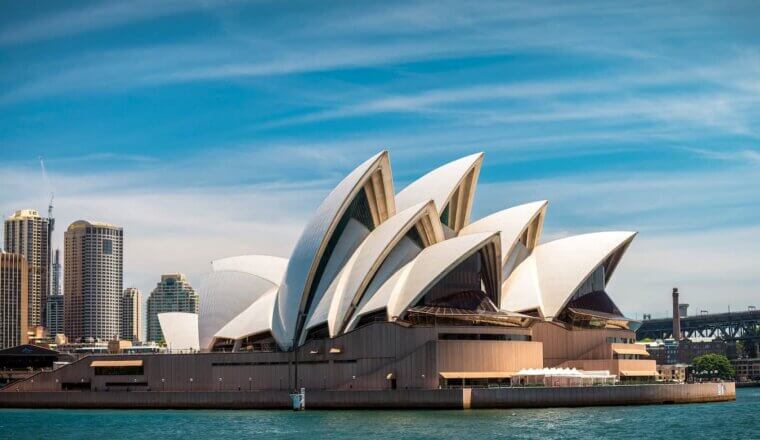
The 7 Best Hotels in Sydney
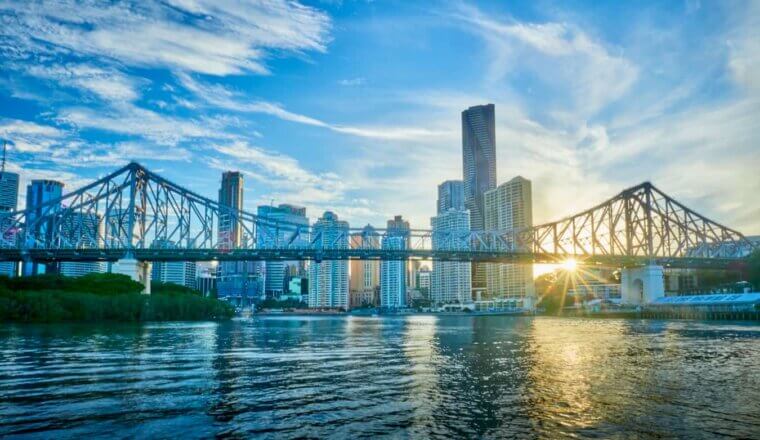
Where to Stay in Brisbane: The Best Neighborhoods for Your Visit
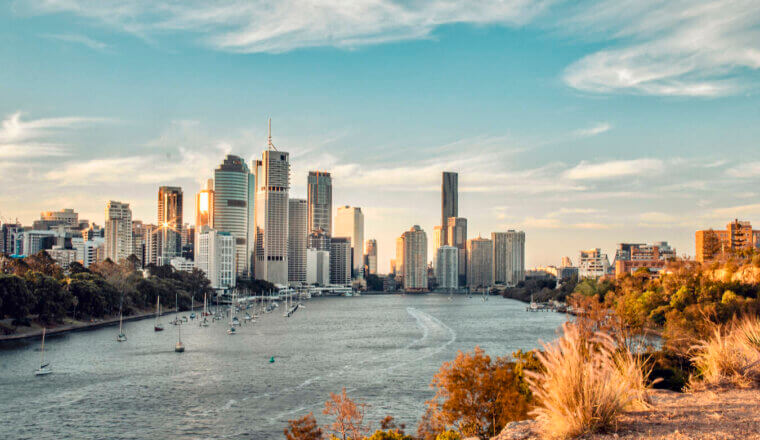
The 6 Best Hotels in Brisbane
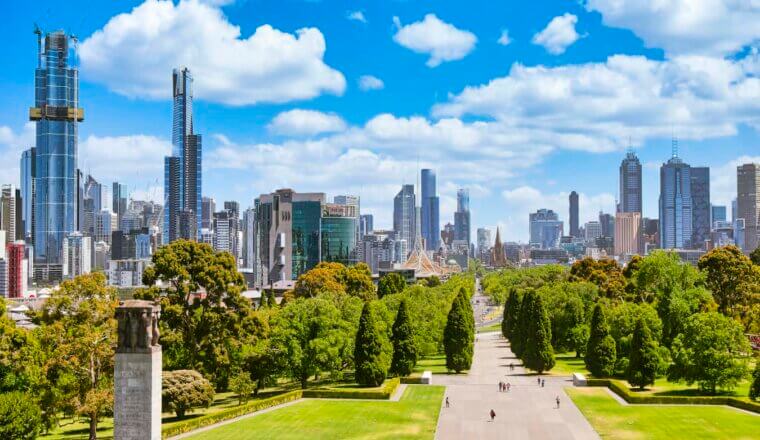
The Best Walking Tours in Melbourne
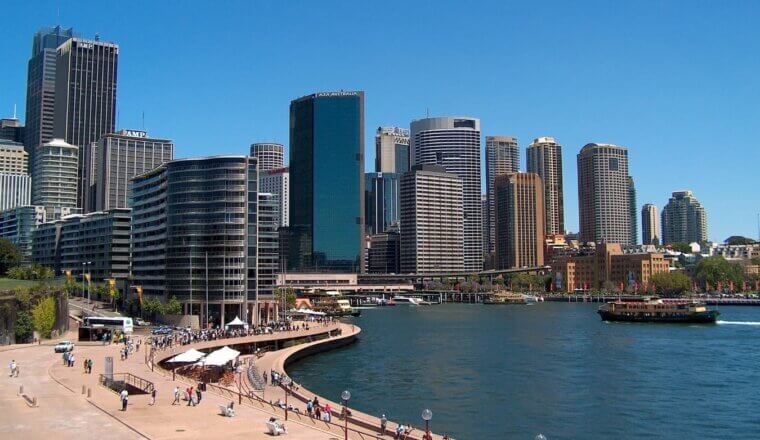
The Best Walking Tours in Sydney
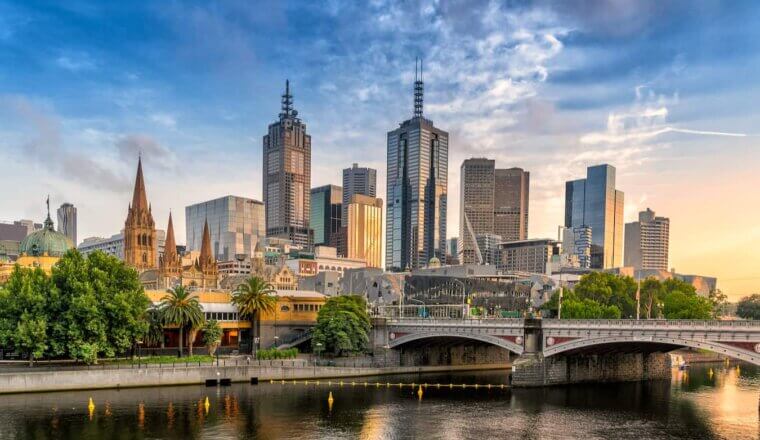
Where to Stay in Melbourne: The Best Neighborhoods for Your Visit
Get your free travel starter kit.
Enter your email and get planning cheatsheets including a step by step checklist, packing list, tips cheat sheet, and more so you can plan like a pro!

- Where To Stay
- Transportation
- Booking Resources
- Related Blogs

Australia Travel Guide
Looking for an in-depth Australia travel guide ?
Then you’re in the right place!
If you’re looking for an adventure, it’s high time you booked a trip to Australia.
From beautiful beaches to breathtaking deserts to astounding mountains to unique wildlife, Australia really does have it all. You’ll find so many true bucket list experiences in this country, whether you’re surfing Byron Bay, exploring the Great Barrier Reef in Queensland, or marveling at Uluru and taking in the desert culture in Alice Springs.
You’re sure to come home with tons of memories and plenty of photos to show your friends and family.
Australia is a huge country and packed with so many incredible things to see and do that it’s hard to get the full experience in one short trip. You’ll want to set aside a fair amount of time to explore this unique part of the world, and there are many easy ways to do just that!
If you have a fair amount of flexibility or just want to take a little life sabbatical and go exploring, look into a working holiday visa. This visa allows 18 to 30-year-olds from certain eligible countries to travel through Australia for up to 12 months while working specific jobs in sectors like Australian tourism, farming, and construction.
This is a great way to really get to know the country while making some money to fund your travels. Head to the Australian Department of Home Affairs website to learn more.
If a working holiday is a bit too much of a commitment, look into tour companies and travel agents that offer travel Australia packages or youth travel backpacking tours around the country. In many cases, these companies will also help with many of the logistics involved in traveling to Australia, from visas to transportation between destinations.
Once you’ve figured out how you’re going to travel around Australia, it’s time to figure out where you’re going to go! Australia’s famous cities like Sydney and Melbourne are of course worth visiting, but there are plenty of other gems to check out.
Australian Capital Territory, a small territory carved out of New South Wales that is home to the capital city of Canberra, has plenty to explore and makes for one of the best day trips from Sydney. Visit the ski slopes of the Australian Alps in the winter, take a tour of Parliament House, or float above the city in a hot air balloon.
Over in Western Australia, you’ll find the lively city of Perth, where you can sip local wine and snap a photo with an adorable quokka all in one day!
Want to visit some of the most beautiful beaches in the world? Head to the Gold Coast on Australia’s east coast where you’ll find bright blue waters, incredible surf, and laid-back vibes.
And if you’re looking for the road trip of a lifetime, consider a drive down the famous Great Ocean Road , a scenic highway in Southern Australia that’s hard to beat.
Keep reading to dive into resources that will help you with planning a trip to Australia in Oceania .
Note: This ultimate guide to Australia travel contains affiliate links to trusted partners!

Australia Map
Use this Australia travel map to begin planning your trip to this incredible country!
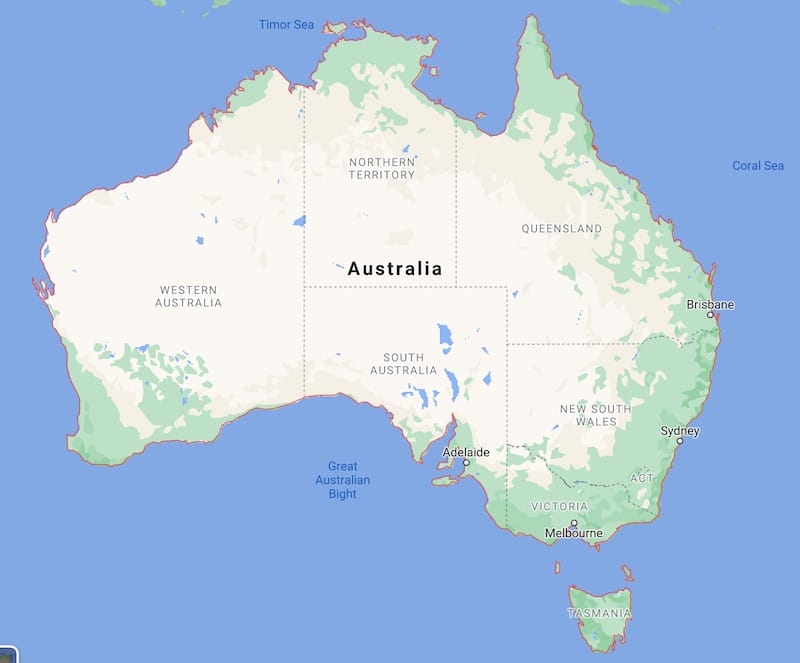
Click here for an interactive Google Map version of the above graphic.
Adventure & Hiking Holidays In Australia
Looking to have some active travel adventures in Australia? Don’t miss:
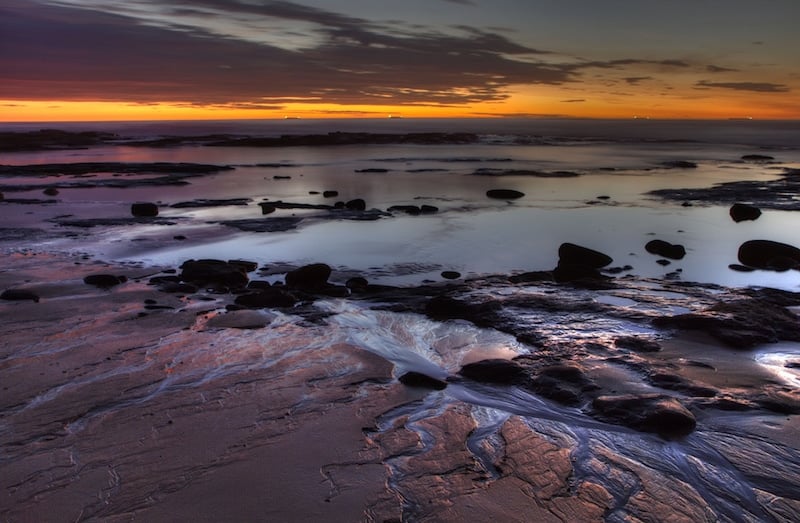
7 Reasons Wollongong Is The Perfect Destination For Adrenaline Junkies
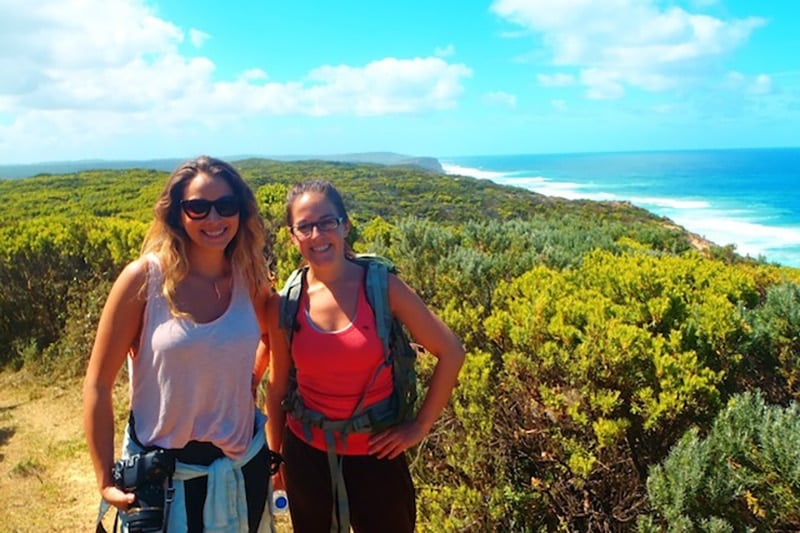
Moving Experiences: Hiking Safaris In Australia
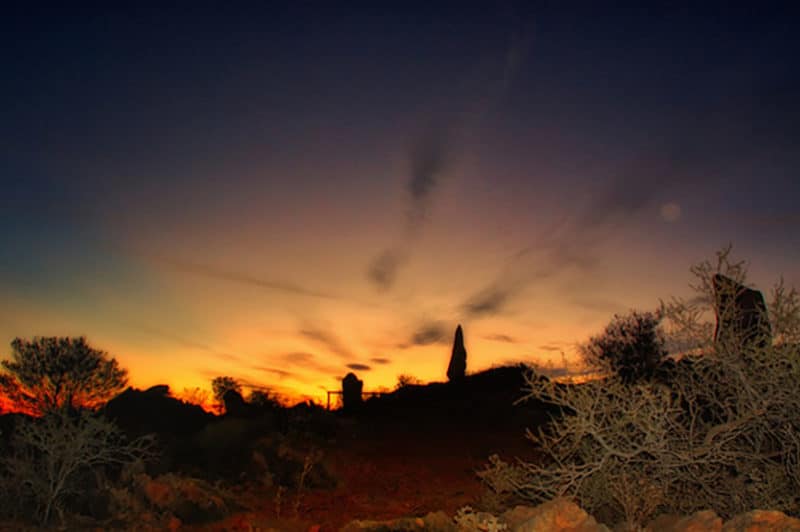
5 Of Australia’s Most Stunning Camping Destinations
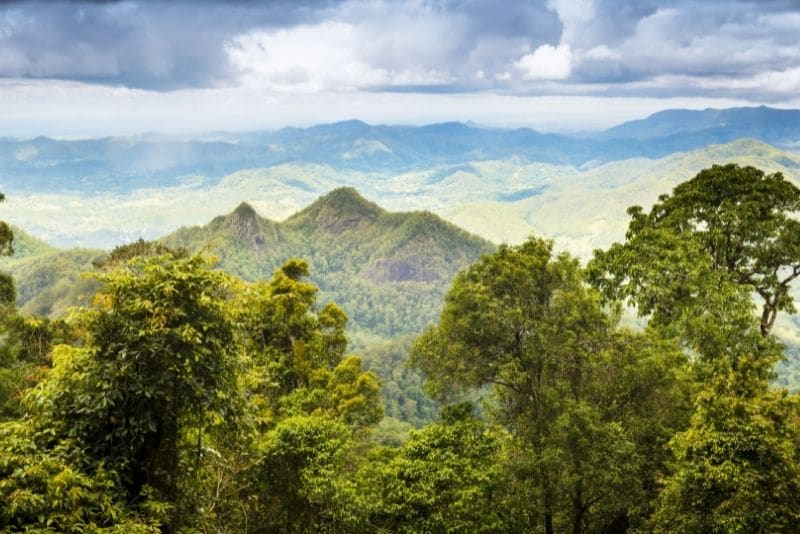
8 Best Hikes In Queensland You Shouldn’t Miss
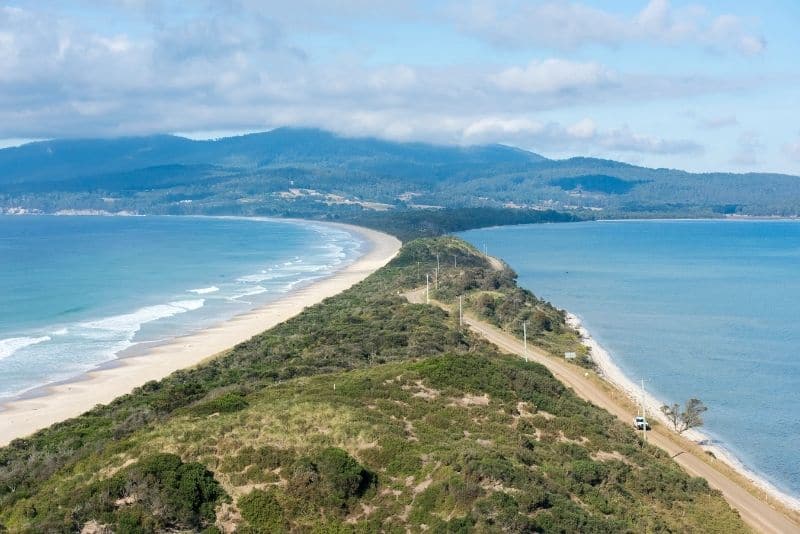
10 Amazing Bruny Island Hikes Not To Be Missed
Australia Road Trip Guide
Looking for the perfect Australia road trip itinerary? These posts can help!
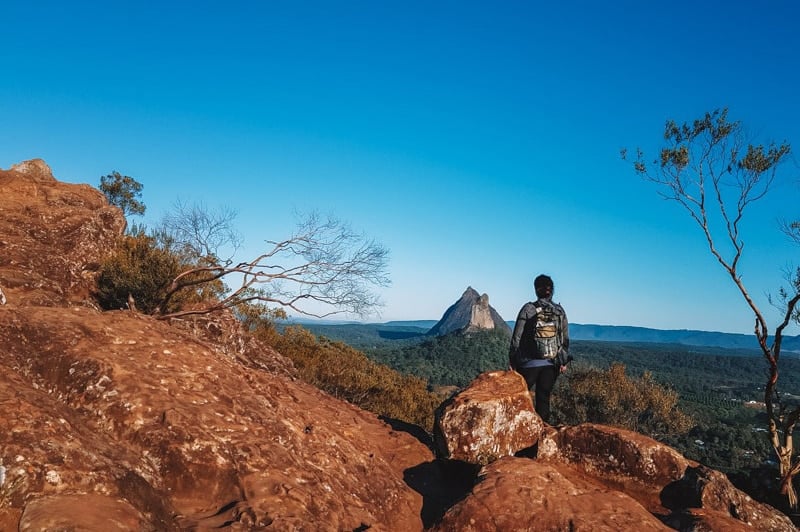
10-Day Brisbane To Cairns Road Trip Itinerary
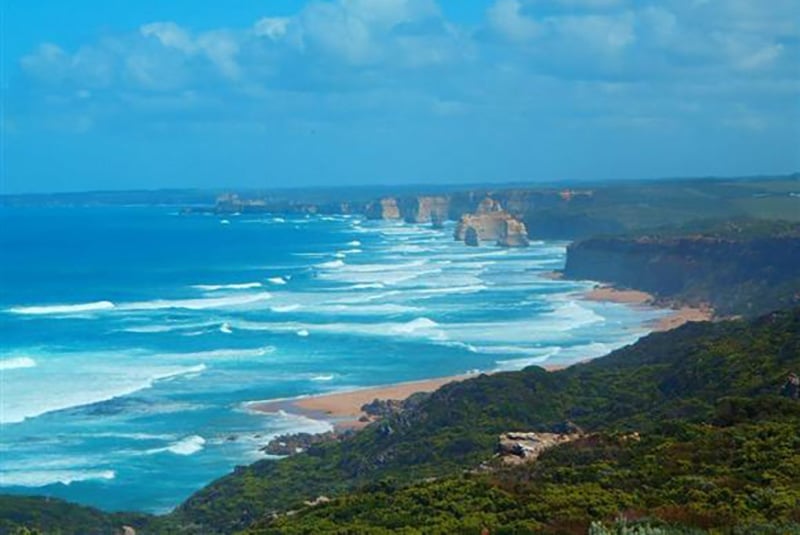
Road Trip From Through Australia: 10 Memorable Moments In Victoria
Australia Travel Tips
The following Australia travel advice can help you plan the perfect trip, whether you’re visiting to experience solo female travel or in a group!
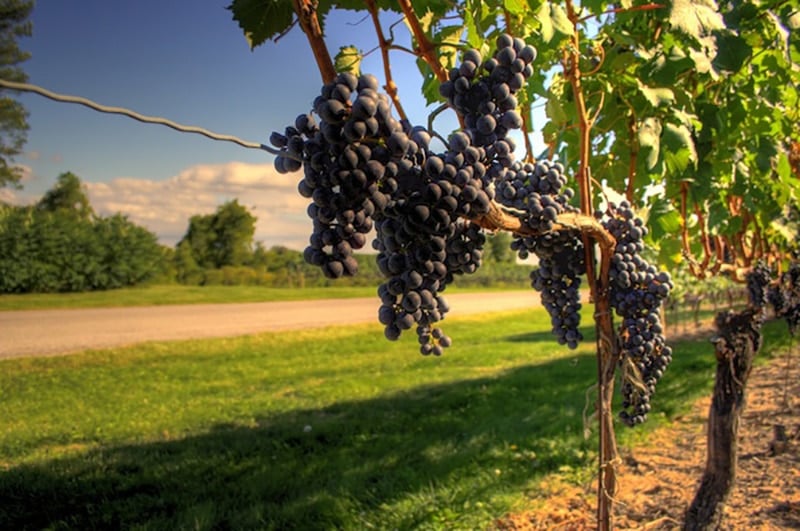
Travel Guide To Solo Travel In Australia
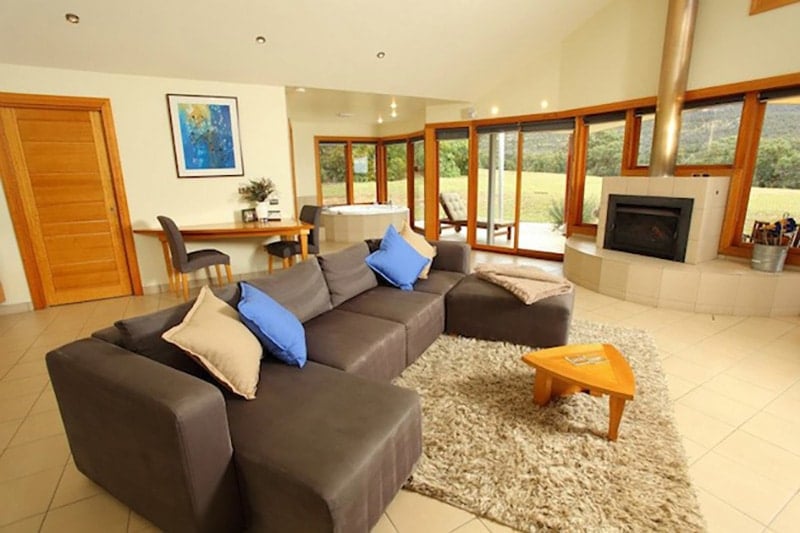
3 Must-Stay Eco-Lodges In Victoria, Australia
Barossa Valley Travel Guide
No Australia guide would be complete without mentioning the Barossa Valley and the many things to do there, like:
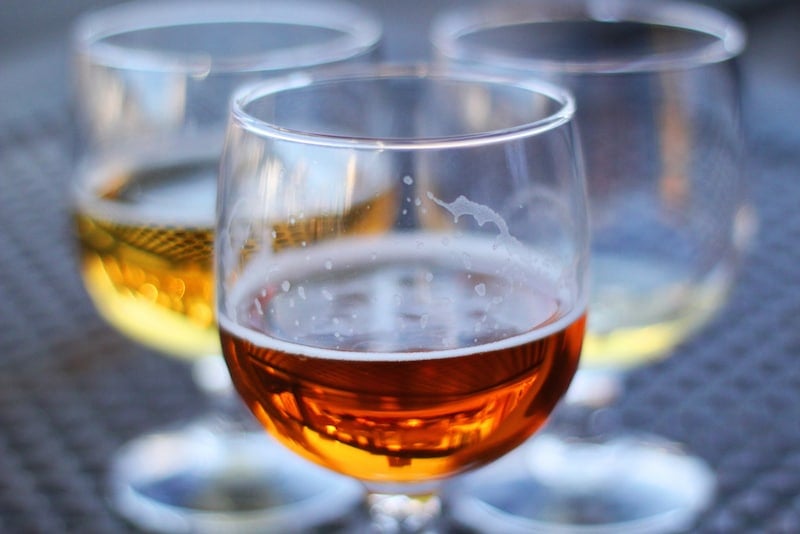
Australia Travel: 5 Things To Do In The Barossa Valley Besides Drink Wine
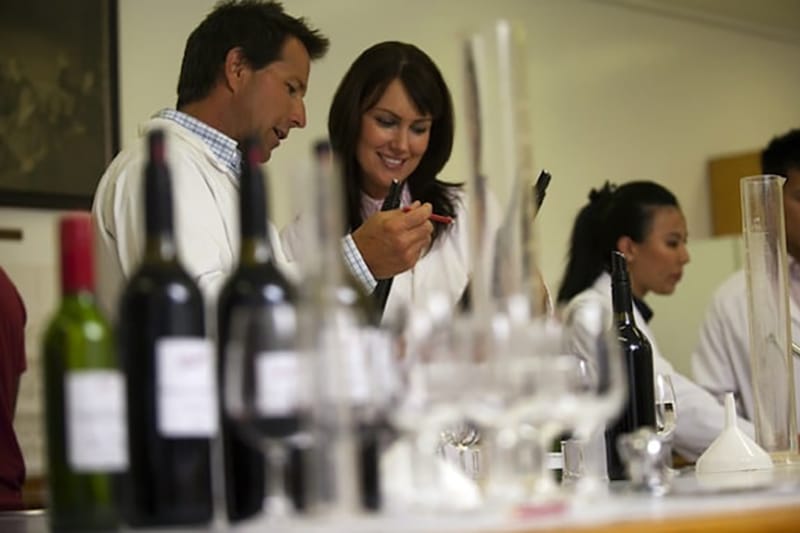
Making My Own Wine Blend In South Australia’s Barossa Valley
Melbourne Travel Guide
Looking for a Melbourne visitor’s guide that can help you plan the perfect trip? Check out:
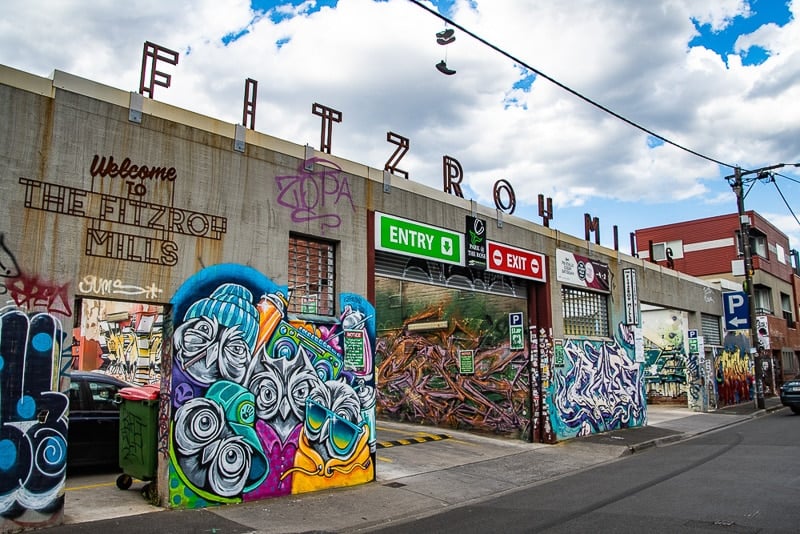
10 Melbourne Hidden Gems & Secret Places (From A Local Guide)
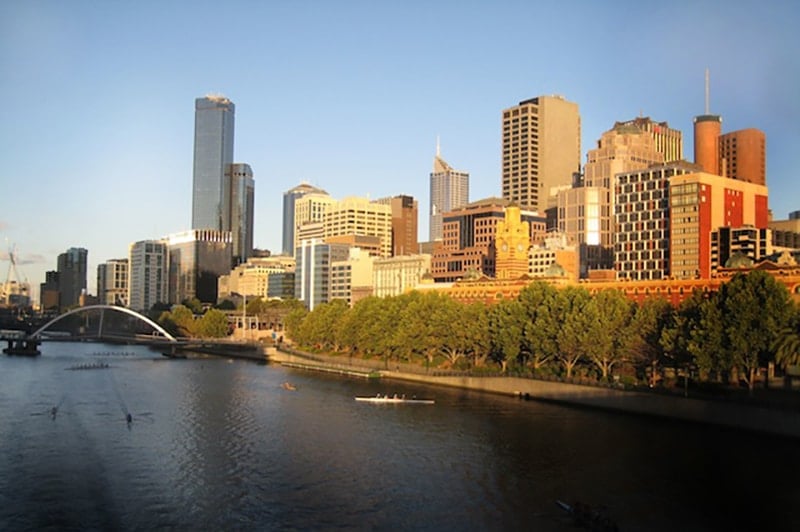
Budget Travel: Top Free Things To Do In Melbourne
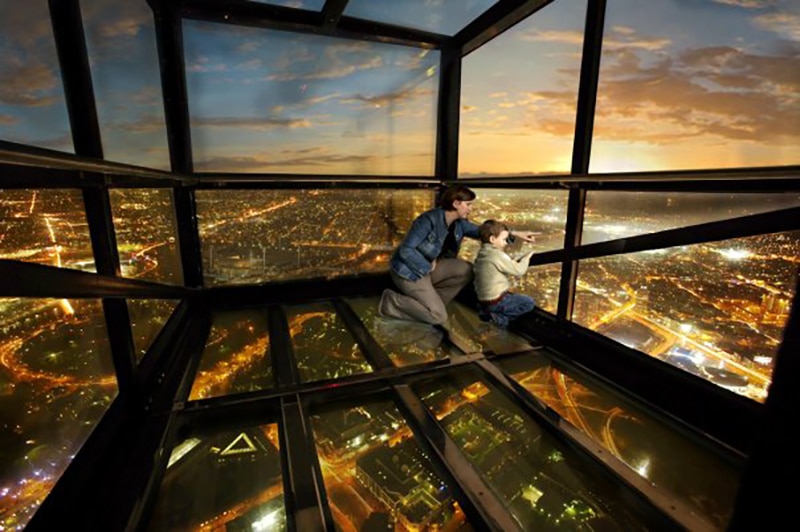
5 Ways To Get High In Melbourne, Australia
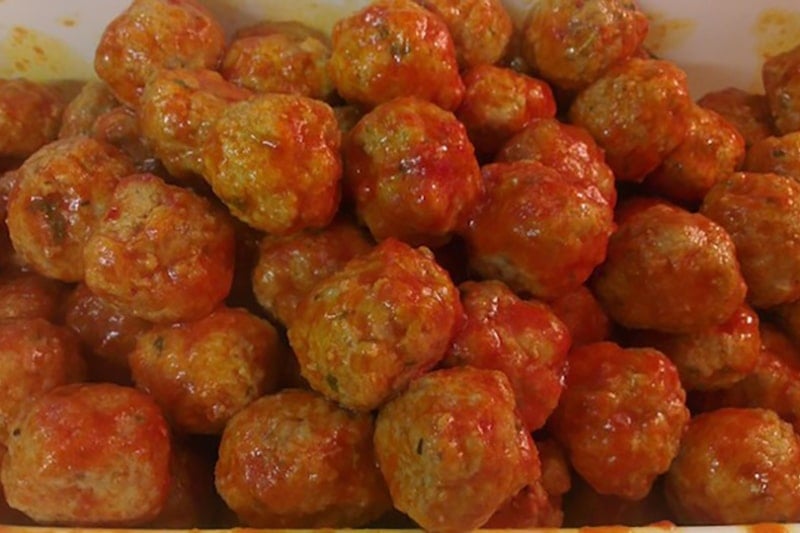
14 Quirky Things To Do In Melbourne, Australia
Sydney Travel Guide
Looking for a Sydney destination guide ? These Australia travel articles can help!
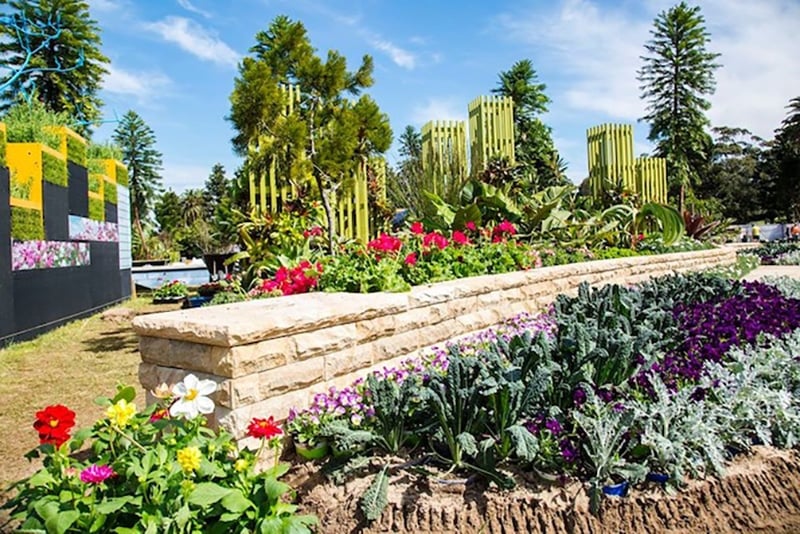
Cheap Australia Travel: Exploring Sydney On Less Than $25/Day

Solo Travel In Sydney: The Ultimate Guide (With Map!)
Kangaroo Island Travel Guide
When traveling Australia , you can’t miss Kangaroo Island. Here is how to have an incredible time!
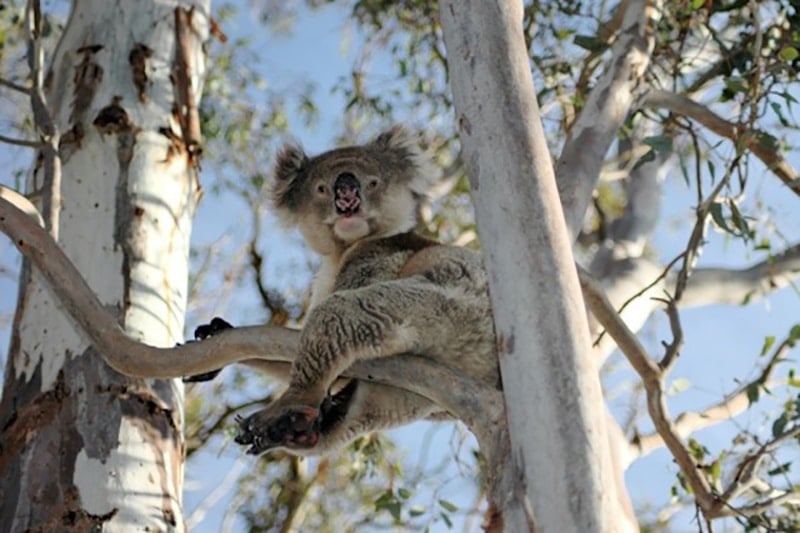
12 Quintessential Experiences To Have On Australia’s Kangaroo Island

Southern Ocean Lodge: Sustainable Luxury On Australia’s Kangaroo Island
Other Places To Visit In Australia
Looking for the best places to visit in Australia ? Here are some other unforgettable ideas:

10 Tasty Food & Wine Experiences To Have In Australia
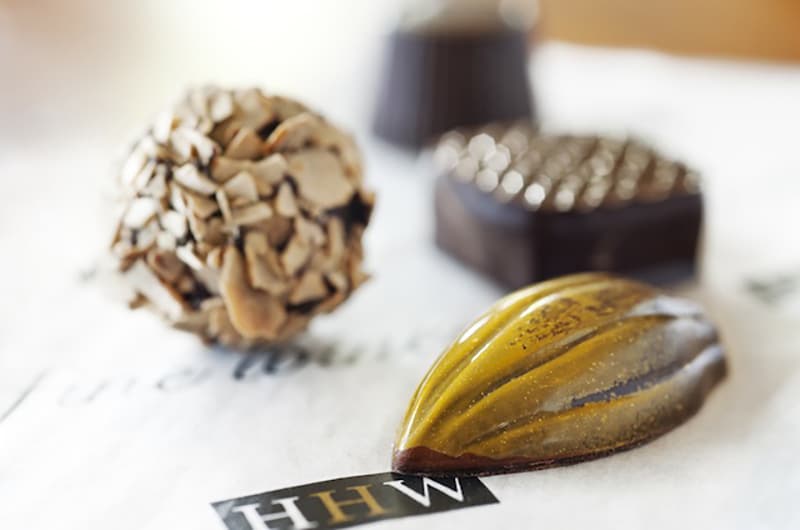
An Epicurious Experience In Adelaide Hills, South Australia
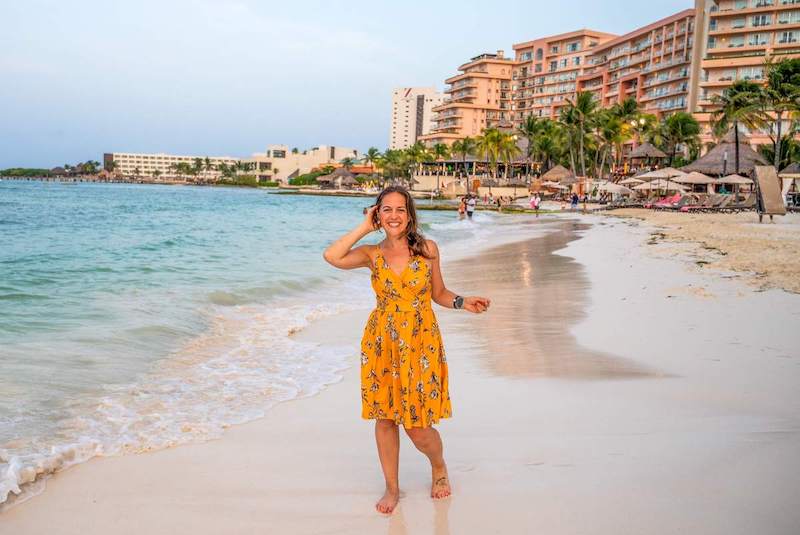
20 Best Beach Destinations For Solo Female Travelers
Best Tours In Australia
Explore local culture with an Australia tour guide through these unique excursions:
- Great Barrier Reef Snorkeling and Diving Cruise from Cairns
- Cape Tribulation, Mossman Gorge, and Daintree Rainforest Day Trip from Cairns or Port Douglas
- Kuranda Scenic Railway Day Trip from Cairns
- Uluru (Ayers Rock) Sunset with Outback Barbecue Dinner and Star Tour from Yulara
- Sunset 3-Hour Cruise from Darwin with Dinner and Sparkling Wine
- Sydney Opera House Beyond the Stage Tour & Harbourside Brunch from Sydney
- Sunset Blue Mountains Wilderness & Wildlife Tour (Without the Crowds) from Haymarket
- Kakadu National Park Full-Day Tour from Darwin with Lunch
Renting A Car In Australia
Need a rental car for your Australia trip?
Use Discover Cars to quickly compare your car rental options.
Australia Hotels
Click here to browse the best Australia travel hotels!
Prefer self-contained stays?
Click here to check out unique local rentals!
You can also use this map to search for local stays:
Australia Travel Insurance
It doesn’t matter if you’re traveling solo or with a group on an Australian tour. When visiting Australia — or any other country in the world — make sure to get travel insurance to protect your health and safety.
In my opinion, the best travel medical insurance for travelers is SafetyWing as they’ve got a large network and offer both short-term and long-term coverage — including coverage if you’re traveling for months as well as limited coverage in your home country).
Additionally, SafetyWing is budget-friendly and offers $250,000 worth of coverage with just one low overall deductible of $250.
With coverage, you’ll have peace of mind as you embark on your Australia travel itinerary.
Click my referral link here to price out travel insurance for your trip in just a few clicks .
Australia Travel Guide FAQ
Okay, now let’s answer some common Oceania travel guide questions that specifically pertain to traveling in Australia .
Q: What are the best things to do in Australia?
One of the best things to do in Australia is to explore the country’s incredible natural wonders. With tons of opportunities for hiking , diving, safaris, and more, you won’t forget the sights you see in this truly unique country.
Australia is home to the Great Barrier Reef, one of the largest living structures on the planet and one of the seven Natural Wonders of the World. The reef stretches along much of the state of Queensland and is so big that it can be seen from outer space.
While diving is probably the most immersive way to experience the reef, you can also explore this natural wonder while staying dry through glass-bottom boat tours and underwater viewing stations.
Australia’s Red Centre, or the Central Australian outback, is also world-famous for its beautiful desert views, iconic wildlife and Aboriginal culture. The desert’s main attractions are Uluru and Kata Tjuta, ancient rock formations sacred to the local Anangu people that have amazed visitors for centuries. Take a tour of the area with an Aboriginal guide to learn more about the land and its significance to the Anangu people.
What’s more synonymous with Australia than kangaroos? You can see these creatures (and many more) in their natural habitat on Kangaroo Island , a large island off the coast of South Australia where the local wildlife roams free. You’ll run into tons of classic Australian animals here, from koalas to wallabies to goannas.
Hike some of the island’s many trails, visit a local honey farm, or book an animal encounter at a wildlife educational park. The island is also well-known for its wineries and you’ll definitely want to do a tasting at one of the many cellar doors.
Now, Kangaroo Island isn’t the only Australian island worth visiting. Explore the many scenic Bruny Island hikes for a taste of adventurous Tasmania — and keep your eyes peeled for the rare white wallaby!
You can’t skip a trip to the beach when you visit Australia! Bondi Beach in Sydney is one of the most famous shores in the world, best known for its clear blue waters, clifftop walk, and world-class surf. Take a surf lesson yourself, or just catch some rays and do some people watching.
Australia is also the perfect place for an epic road trip! Along with the popular Great Ocean Road, a Brisbane to Cairns road trip introduces you to some of the country’s most incredible destinations.
Q: What is the best month to visit Australia?
December through February are generally the best months to visit Australia, as that is when the country experiences summer. This is the perfect time to visit southern Australian destinations like Melbourne and Sydney , as temperatures are usually warm and pleasant.
Things can get extremely hot in the summer in northern Australia, though, since this area is closer to the equator. If you’re looking to visit Darwin and other northern Australian destinations, consider visiting in the winter when temperatures are less brutal and not quite as rainy.
Q: How much does an average trip to Australia cost?
A week-long trip to Australia will generally run you about $2,000 for one person. Costs will depend on your destination, but the average traveler spends about $143 USD per day in Australia on accommodations, transportation, food, activities, and other day-to-day travel expenses.
Since the country is so isolated, your biggest expense will likely be your flight to Australia from your home country. Keep an eye on sites like Kayak to find deals on flights and bring the total cost of your trip down.
Q: Where should I go for my first trip to Australia?
Australia is a huge country and there’s quite a lot to see, particularly for first-time visitors, but there are a few places you absolutely shouldn’t miss.
Sydney , arguably Australia’s most famous city, offers tons of great things to see and do. The iconic Sydney Harbour area is home to the famous Sydney Opera House, probably the most recognizable building in the country.
Even if you can’t get tickets to a show at the Opera House, it’s worth strolling around the adjacent boardwalk and marvelling at the incredible architecture. The Opera House also offers daily tours for those who want a more in-depth look at the iconic building. For a taste of the city’s history, head down to The Rocks neighborhood, featuring 19th-century cobblestone streets and buildings filled with shops, restaurants, and galleries.
The city is also home to tons of great beaches, including the famous Bondi Beach, where you can soak up some sun and incredible views. For a nearby day trip out of Sydney, head to the Greater Blue Mountains Area, a UNESCO World Heritage Centre featuring incredible sandstone plateaus and more.
Looking to road trip your way along the country’s southern coast? Take a ride on the Great Ocean Road, a cliffside highway with amazing ocean views and tons of great stops along the way.
During your trip, you can visit the 12 Apostles , a series of limestone pillars carved out of the mainland cliffs that will take your breath away. You can also encounter local wildlife at several wildlife reserves along the way, or do some seal spotting along the shore. The Great Ocean Road will also lead you to Melbourne, Australia’s cultural capital, a lively city full of fun and quirky things to see and do.
No trip to Australia would be complete without a visit to The Outback. The ancient rock formation Uluru is a truly breathtaking sight and the surrounding Red Centre area offers tons of opportunities for adventure travel . Here, you can explore King’s Canyon, learn more about the local Aboriginal culture, get up close with kangaroos, and swim in real waterholes.
The nearby city of Alice Springs also has tons of great art to check out as well as trails for mountain biking and remnants of Australia’s storied past like original European settlements. Bring your sunblock and get ready to explore this iconic area.
Q: What should I avoid in Australia?
The biggest threat to your safety in Australia is Mother Nature. Thankfully, her wrath is pretty easy to avoid.
If you want to head out to the beach (which you absolutely should), make sure you stick to official beaches designated for swimming. If not, you may run the risk of encountering a shark, crocodile, or one of the other dangerous sea creatures local to the area.
You’ll also want to heed any warnings from lifeguards and always swim between the flags at the beach. Rip currents can develop quickly and cause even the strongest of swimmers to struggle to get back to shore.
And do not forget sunscreen and water! The Australian sun is notoriously strong and you don’t want to end up in the hospital with third-degree burns and a wicked case of dehydration.
If you’re not renting a car during your trip to Australia, you’ll want to avoid the suburbs and stay close to major cities and areas with reliable public transport. Public transit is spotty at best outside of the cities, so you’ll definitely have a hard time getting around.
If you do choose to rent a car, be sure to factor travel time into your itinerary. It can take quite a while to get from Point A to Point B in Australia however you choose to travel, and you don’t want to spend your entire trip on the road. A proper road trip around the country can also take months, so don’t get too ambitious with your plans unless you truly have the time.
This probably also goes without saying, but leave your Steve Irwin impression at home. Any references to Crocodile Dundee, “shrimp on the barbie”, and the like will (at best) earn you dirty looks from the locals.
And you probably wouldn’t appreciate it if someone did the same in your home country or hometown. Just be yourself and don’t be afraid to chat with people. Australians are quite friendly as long as you leave the fake accent at home.
Q: Is Australia safe to travel?
Australia is considered very safe for travelers. Rates of both violent and petty crime are low throughout the country, though it does help to stay vigilant for pickpockets in major cities like Sydney and Melbourne.
Natural disasters can be a bit of a risk here, though — riptides are common at beaches, wildfires are common in the summer months, and there are several dangerous animal species to look out for if you’re out in the wilderness.
UV exposure rates are also very high here, so be sure to use SPF every day, even if you’re not planning on spending a ton of time outdoors.
Keep an eye on the news, heed all road signs and beach warnings, and follow guides when venturing outdoors.
Q: How long can a tourist stay in Australia?
Tourist visas in Australia are generally granted for up to three months.
These can be extended to a full year under certain circumstances but three months is the length of an average stay period granted by the Australian Department of Home Affairs.
If you want to stay longer than your granted stay period, you’ll need to apply for a new visa.
Q: Do I need an Australia travel visa?
All visitors to Australia (other than citizens of New Zealand) need a visa to visit the country. You must apply for a visa before leaving home.
Visitors from most European countries can obtain a free eVisitor visa online and visitors from the United States, Canada and several other European countries can obtain an Electronic Travel Authority (ETA) visa online or through a travel agent for a small fee. If you are applying for an ETA visa, be sure to get your application in before you book travel to Australia.
It’s recommended to view your country’s Australia International Travel Information page for the most up-to-date information on entry and exit requirements. You can also contact the Australian Consulate-General.
Q: Where is Australia?
Australia is a country — that is also an island and a continent — located in Oceania between the Indian Ocean and the South Ocean.
Q: Are credit cards accepted in Australia?
Credit cards — particularly Visa and Mastercard — are widely accepted around Australia, though it is always wise to carry some cash for smaller establishments and in case of emergency.
Q: Can you drink the tap water in the Australia?
It is typically safe to drink the tap water in Australia, though do double check with your hotel to be sure as water sources — and water quality — vary from place to place.
Q: What is the local currency in Australia?
The local currency in Australia is the Australian dollars (AUD).
What would you add to this Australia travel guide?

Enjoyed this ultimate Australia travel guide? Pin it for later!
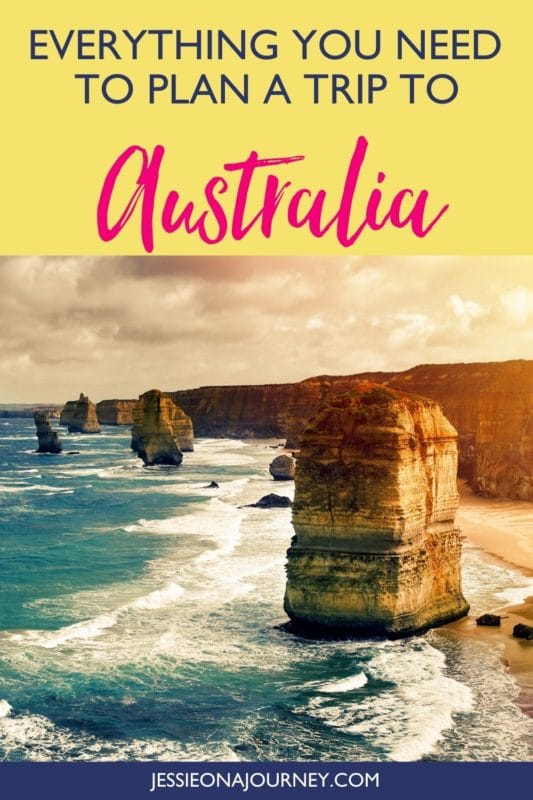
Protect Your Trip »
Best places to visit in australia and the pacific for 2023-2024.
Although costly flights and long travel times can deter some from visiting Australia and its South Pacific neighbors, bucket list destinations like the Great Barrier Reef and the famed Sydney Opera House simply can't be ignored. Should you decide to travel to the region, it's useful to know the best locales to explore – that's where we come in. U.S. News ranked the best places to visit in Australia and the Pacific based on user votes, expert opinions and factors like tourist-friendly accommodations and variety of attractions. Help us determine next year's ranking by voting for your favorite destinations below.
South Island, New Zealand
Great barrier reef, whitsunday islands, sunshine coast, kangaroo island, uluru-kata tjuta national park.

Travelers searching for a once-in-a-lifetime vacation should head to this dreamy French Polynesian island for its romantic overwater bungalows (a favorite among honeymooners and Instagrammers alike), luxe spas and stunning white sand beaches. Here, you can spend your vacation exploring animal-filled coral reefs, an aquamarine lagoon, lush jungles and towering mountains. Some tour operators even offer excursions that include shark and stingray encounters. To save money on your trip to the "Pearl of the Pacific," book a vacation package that combines your flight and hotel room.

New Zealand's largest island is a haven for outdoorsy types. Whether you're hiking around turquoise Lake Tekapo, bird-watching on the Otago Peninsula, stargazing from the University of Canterbury Mount John Observatory, cruising Milford Sound or kayaking in Abel Tasman National Park, you'll enjoy countless impressive panoramas in this world-famous landscape . When you need a break from nature, check out Christchurch's eclectic street art or Dunedin's 19th-century Larnach Castle & Gardens, or head to the wine region of Marlborough for its unmatched sauvignon blanc. Plus, because of the country's low crime rate, New Zealand is a top destination for solo female travelers .

Visitors travel from around the world to catch a glimpse of Tahiti's beautiful natural scenery, which features everything from tumbling waterfalls to soaring mountains. This French Polynesian island in the South Pacific is also home to unique stretches of sand, such as La Plage de Maui (with proximity to a shallow lagoon ideal for swimming and snorkeling), Papenoo Beach (a black sand beach that attracts surfers in droves) and Taharuu Beach (another black sand option that's popular with families). Away from the beach, travelers can stroll through the capital city of Papeete, explore Tahiti's sister island, Moorea, or unwind at one of the island's extravagant resorts.

The Great Barrier Reef is easily one of the world's top natural wonders. Its sheer size – the reef stretches across more than 1,400 miles off the eastern coast of Australia – and diversity of life continuously impress visitors. Even though you won't be able to see the entire reef, a helicopter or glass bottom boat tour, or snorkeling or diving excursion of this underwater marvel makes for an unforgettable vacation. For easy access to the reef and Daintree Rainforest, the world's oldest tropical rainforest, base yourself in Cairns or Port Douglas.

Made up of a collection of roughly 300 South Pacific islands, Fiji is home to some of the most beautiful beaches in the world . For turquoise waters and sparkling white sands, base your stay on the Yasawa or Mamanuca Islands. If you want something more adventurous, spend the day hiking dormant volcanoes, snorkeling around coral reefs or hitting the links at one of Fiji's incomparable golf courses. Just don't forget to save time for learning about Fiji's "bula" spirit and native customs, from firewalking ceremonies on Beqa Island to drinking kava (a plant-based adult beverage).

Located in New South Wales near the foothills of the majestic Blue Mountains, Sydney is part fast-paced metropolis and part laid-back beach town. Here, travelers can spend their days sunbathing at Coogee or Bondi Beach, visiting the museums of Darling Harbour or climbing the Sydney Harbour Bridge. What's more, Sydney features cool neighborhoods like The Rocks and fun events, such as Vivid Sydney (a neon light and music show) and the Biennale of Sydney (a multidiscipline arts event held every other year). Plan ahead to catch a performance at the world-class Sydney Opera House, one of the world's most famous landmarks .

This island south of mainland Australia draws thrill-seekers in droves. Hikers can trek challenging paths at Wellington Park and Cradle Mountain - Lake St Clair National Park. Water lovers can snorkel, kayak and swim at Freycinet National Park. Tasmania is also home to unique critters, such as platypuses, wombats and Tasmanian devils, which vacationers can see during wilderness hikes or visits to animal havens like the Bonorong Wildlife Sanctuary. After a busy day outdoors, unwind with a locally made cider, wine or whiskey in Hobart or Launceston.

Within view of Australia's northeastern coast, the Whitsunday Islands' 74 islands are a great place to go to enjoy water sports like sailing, snorkeling and Jet Skiing. Hamilton Island (the largest inhabited island of Queensland's Whitsundays) is one of the island chain's most popular vacation spots thanks to its plethora of eateries, upscale accommodations and sprawling white sand beaches with crystal-clear water, such as world-renowned Whitehaven Beach. If you'd rather stay active during your visit, check out Long Island, which features about 10 miles of hiking trails.

Queensland's Sunshine Coast, which stretches roughly between Caloundra and Great Sandy National Park, appeals to everyone from foodies to animal lovers to beach bums. In the heart of the region sits Noosa, a popular beach destination known for its year-round festivals, its Steve Irwin-affiliated zoo and its migrating humpback whales, which you can swim with from July to October. Meanwhile, Coolum Beach offers stunning views of Mount Coolum and excellent surfing conditions. What's more, the Sunshine Coast is home to three UNESCO-listed Biosphere Reserves that sit side-by-side, forming Australia's famed biosphere corridor.

As you might expect, South Australia's Kangaroo Island – located off the southern coast of the country – is excellent for wildlife viewing. In addition to being a refuge for its namesake critters, Kangaroo Island is home to echidnas (spiny anteaters), koalas and wallabies. Plus, you'll likely spot aquatic animals like sea lions, whales and little penguins swimming offshore. While you could easily spend the bulk of your visit looking for wild creatures, be sure to save time for a hike through Flinders Chase National Park and a tasting at one of the island's wineries or distilleries.

Melbourne is Australia's events capital, hosting annual activities like the Australian Open and the Melbourne Food & Wine Festival. Even if you can't visit for a major event, the city offers a variety of can't-miss attractions, including highly regarded museums and art galleries, Australia's oldest zoo and public libraries filled with rare books and historical artifacts. For a more leisurely vacation, ride on the free City Circle Tram or sip a flat white at one of Melbourne's many coffee shops. When you're ready to venture outside the city, consider a drive along the scenic Great Ocean Road, which begins in Torquay (60 miles southwest).

If you want your next vacation to be filled with outdoor activities, plan a getaway to majestic Vanuatu. Composed of 83 islands, this South Pacific archipelago offers ample opportunities to soak up its stunning scenery. Soar through Vanuatu's lush jungle on a zip line, watch lava erupt from Mount Yasur (an active volcano), dive to remnants of World War II-era ships or hike through the Millennium Cave to misty waterfalls. When you need a break from heart-pumping adventures, lounge on the powdery white sand at Champagne Beach or Eton Beach or take a refreshing dip in one of the many blue holes.

Australia's Gold Coast, which sits about 50 miles southeast of Brisbane in the state of Queensland, offers travelers the perfect blend of a laid-back beach community and a thriving city. Visitors can explore everything from glowworm caves to wildlife sanctuaries to theme parks – all are located within the city's limits. But the main reason to check out this coastal locale is to ride its top-notch waves. Surfers travel from around the world to hang 10 at beaches like Surfers Paradise and Burleigh Heads. While you're here, consider taking a daytrip to nearby Byron Bay, a popular destination featuring top-notch restaurants, yoga retreats and craft breweries.

Head to New Zealand's capital city to get an eyeful of the country's spectacular scenery both on canvas and in person. Wellington is one of New Zealand's largest cities (by population) and it's where you'll find the Museum of New Zealand Te Papa Tongarewa (an institution that displays an impressive collection of Kiwi art and Maori artifacts), plus nature-focused attractions like the Wellington Botanic Garden and ZEALANDIA ecosanctuary. After admiring the flora and fauna in these urban havens, hike to the top of Mount Victoria for a bird's-eye view of the city and harbor.

The cosmopolitan city of Auckland boasts a diverse population that brings unique flavors and traditions to the local culture. Add Auckland's love for sports (think: rugby and bungee jumping) and natural wonders – black sand beaches, lush rainforests and volcanic peaks – and you've got a must-visit travel destination. Save time for a visit to Rangitoto Island: Hikes on this offshore island include treks through lava fields and the world's largest pohutukawa forest. Meanwhile, no visit would be complete without taking in panoramic views of the city from Auckland's iconic Sky Tower, one of the tallest free-standing structures in the Southern Hemisphere.

Adelaide beckons to nature lovers, culture hounds and foodies. Considered the wine capital of Australia, this city boasts hundreds of wineries, including world-famous vineyards like Penfolds Magill Estate and Jacob's Creek. First-time visitors won't want to miss Barossa Valley, an Australian wine region known for its bold shiraz. Plus, gourmands can sample local meats, cheeses, baked goods and more at the Adelaide Central Market before perusing the exhibits at highly regarded museums like the Art Gallery of South Australia and the South Australian Museum. Before leaving, venture to Waterfall Gully to admire its gushing waterfalls and spectacular city views.

When you think of Australia's Outback, chances are you imagine this UNESCO World Heritage-listed national park. At the center of Uluru-Kata Tjuta National Park lies Uluru (a massive sandstone formation with a red hue) and Kata Tjuta (a group of 36 red geological domes), two sites with cultural ties to the local Indigenous Australian community, called Anangu. Though both locales are breathtaking no matter when you visit, for phenomenal photo-ops, visit at sunrise or sunset.
Vote to Add these Destinations to the Rankings

K'gari (Fraser Island)

Port Douglas

Kakadu National Park

You May Be Interested In

Best Beaches in Australia

Best Places to Visit in Asia

Best Places to Visit in the Caribbean for 2023

Central & South America
Best Places to Visit in Central and South America in 2023

Best Beaches in the World for 2024

Australia & The Pacific
Best Pacific Islands to Visit
If you make a purchase from our site, we may earn a commission. This does not affect the quality or independence of our editorial content.
Recommended
The 28 Best Water Parks in the U.S. for 2024
Holly Johnson|Timothy J. Forster May 8, 2024

The 18 Best Napa Valley Wineries to Visit in 2024
Lyn Mettler|Sharael Kolberg April 23, 2024

The 25 Best Beaches on the East Coast for 2024
Timothy J. Forster|Sharael Kolberg April 19, 2024

The 50 Best Hotels in the USA 2024
Christina Maggitas February 6, 2024

The 32 Most Famous Landmarks in the World
Gwen Pratesi|Timothy J. Forster February 1, 2024


9 Top All-Inclusive Resorts in Florida for 2024
Gwen Pratesi|Amanda Norcross January 5, 2024

24 Top All-Inclusive Resorts in the U.S. for 2024
Erin Evans January 4, 2024

26 Top Adults-Only All-Inclusive Resorts for 2024
Zach Watson December 28, 2023

Solo Vacations: The 36 Best Places to Travel Alone in 2024
Lyn Mettler|Erin Vasta December 22, 2023

26 Cheap Beach Vacations for Travelers on a Budget
Kyle McCarthy|Sharael Kolberg December 4, 2023

- Meet the Team
- Work with Us
- Czech Republic
- Netherlands
- Switzerland
- Scandinavia
- Philippines
- South Korea
- New Zealand
- South Africa
- Budget Travel
- Work & Travel
- The Broke Backpacker Manifesto
- Travel Resources
- How to Travel on $10/day
Home » Oceania » Australia » Backpacking Guide
Backpacking Australia Travel Guide (Tips + Secrets • 2024)
When I ask you to think of Australia, what comes to mind?
Do you dream of hanging out with bouncy kangaroos? Or, driving a van through the outback? Or, maybe your mind takes you to explore the big cities? Or, surfing epic waves along the coast?
All of this and more is possible when you embark on your adventure – backpacking in Australia .
Whether you want to load up a van and hit the open roads or dive deep into the Great Barrier Reef; there is an Aussie backpacking itinerary that will suit every traveller. You just need to get clear on what you’re after and what this magical land down under has to offer you.
Australia is absolutely HUGE (like seriously massive) and it is so diverse. From the bustling streets of Sydney to the wild outback; there is so much to see and do when backpacking down under. It can almost feel overwhelming! But I’m here to help you make sense of it all.
In this guide, I’ll take you through everything you need to know to make the most of your backpacking trip in Australia. From the best itineraries to the boring stuff like travel insurance – I’ve got you covered.
So, without further ado – it’s time to head down under!
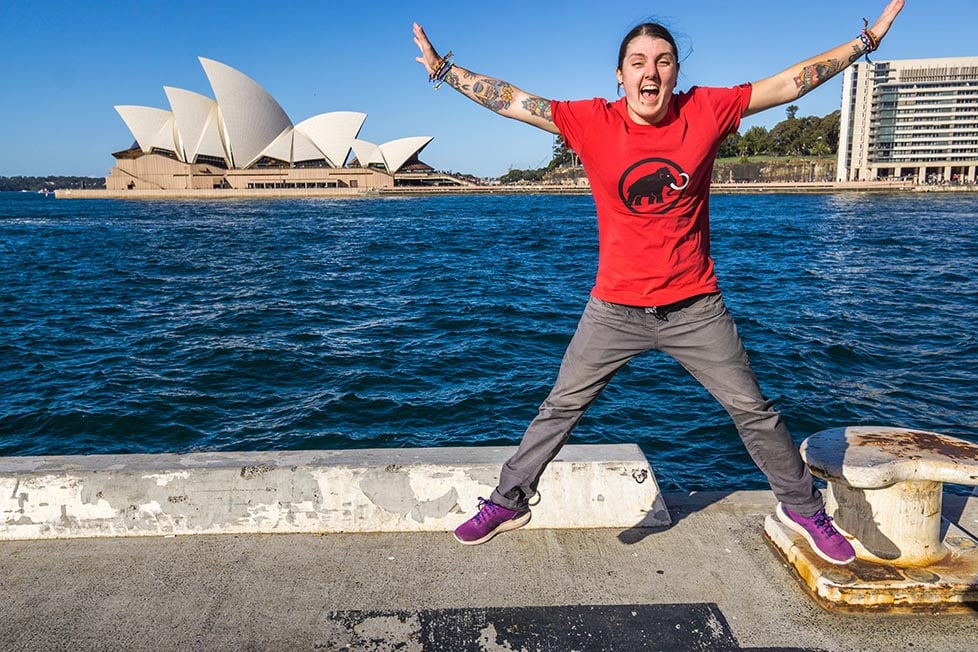
The Broke Backpacker is supported by you . Clicking through our links may earn us a small affiliate commission, and that's what allows us to keep producing free content 🙂 Learn more .
Why Go Backpacking in Australia?
Australia is a huge country with tons of things to do and see! From sailing around the Whitsunday Islands to diving in the Great Barrier Reef to road-tripping just about anywhere, Australia’s got it all.
It’s kinda a rite of passage for any backpacker to visit Australia. We all have that friend who went for a year’s working holiday and ended up staying forever… Why do you think that is?
The country itself is beautiful and there are so many different types of landscapes and wildlife, from croc-infested wetlands to sparse deserts and dense rainforests.
But more than that, Australia has some of the kindest, most welcoming, hilarious people. Anyone who visits Australia feels completely at ease.
There’s a relaxed vibe here. It can’t be described: you just have to go and find out for yourself.
Best Travel Itineraries for Backpacking Australia
Best places to visit in australia, 10 top things to do in australia, backpacker accommodation in australia, australia backpacking costs, best time to travel to australia, staying safe in australia, how to get into australia, how to get around australia, working in australia, australian culture, some unique experiences in australia, faqs about backpacking australia, final advice before visiting australia.
Below is a list of travel itineraries for backpacking Australia. They vary in length and cover the majority of the must-see places in Australia.
When I went backpacking Australia, I had this epic tour planned out. By the time I got to Byron Bay, I fell so madly in love with the people that I’d met in Australia’s amazing hostels that I had to drag myself away after already extending my stop twice. My only regret is planning too much.
I suggest really taking your time. If you like a place, stop for a while! You’ll be pushed for time – even with 3 months – and you’ll encounter places you won’t want to leave. But ride the waves, dude.
Here are some ideas for your itinerary. Just make sure to leave plenty of wiggle room for the enevitable.
10-Day Travel Itinerary for Australia: Tassie
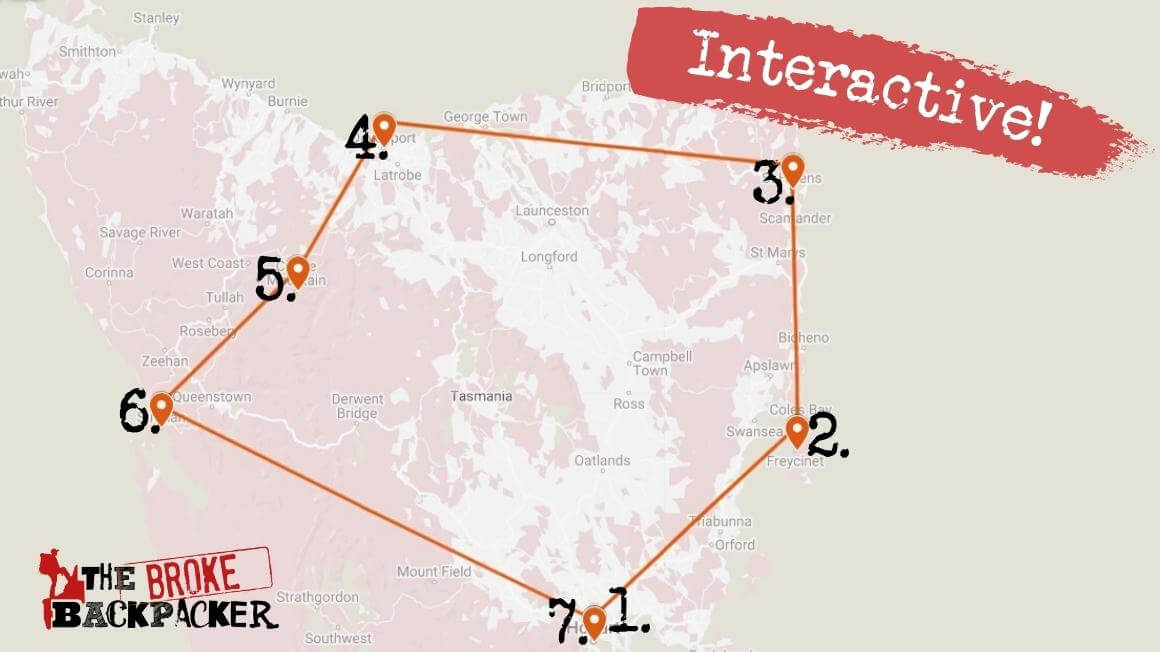
This is the best itinerary for tackling a Tasmanian road trip! You can travel in either direction or pick a city — other than the capital city of Tasmania, Hobart — to begin your route.
Starting in Hobart, the capital of Tasmania. This is the capital city and it’s best known for its port which is the gateway to the Arctic. It’s not a very interesting city, to say the least, so you’ll only want to spend a day or so getting orientated before moving on to the next destination, Freycinet National Park .
What’s most notable about Freycinet is the pink granite peaks, the private bays, and white sand beaches. It’s a great place to relax and enjoy some peaceful nature and wildlife.
Once you have had your fill of Freycinet, head over to St Helens , another big port city known for its deep-sea fishing. If you enjoy fishing, you’ll love it here. It’s also a good spot for diving enthusiasts, or if you just fancy lazing by the beach, the Bay of Fires is pretty epic.
Next up, is Devenport . This city is often overlooked by tourists as it’s just another port city, but because it’s so quiet you can really get a feel for Tasmanian culture.
Then, you’ll want to head to Cradle Mountain , the best place to visit in Tasmania for wildlife. Here you’ll see epic landscapes and also (if you’re lucky) Tasmanian devils, quolls, platypus, echidna, wombats, and the black currawong.
Once you’ve had enough nature, head over to Strahan , the gateway to the Tasmanian Wilderness World Heritage Area and Franklin–Gordon Wild Rivers National Park.
Once you’ve had enough of Strahan, head back to Hobart to head home.
2-Week Travel Itinerary for Australia: Sydney to Adelaide
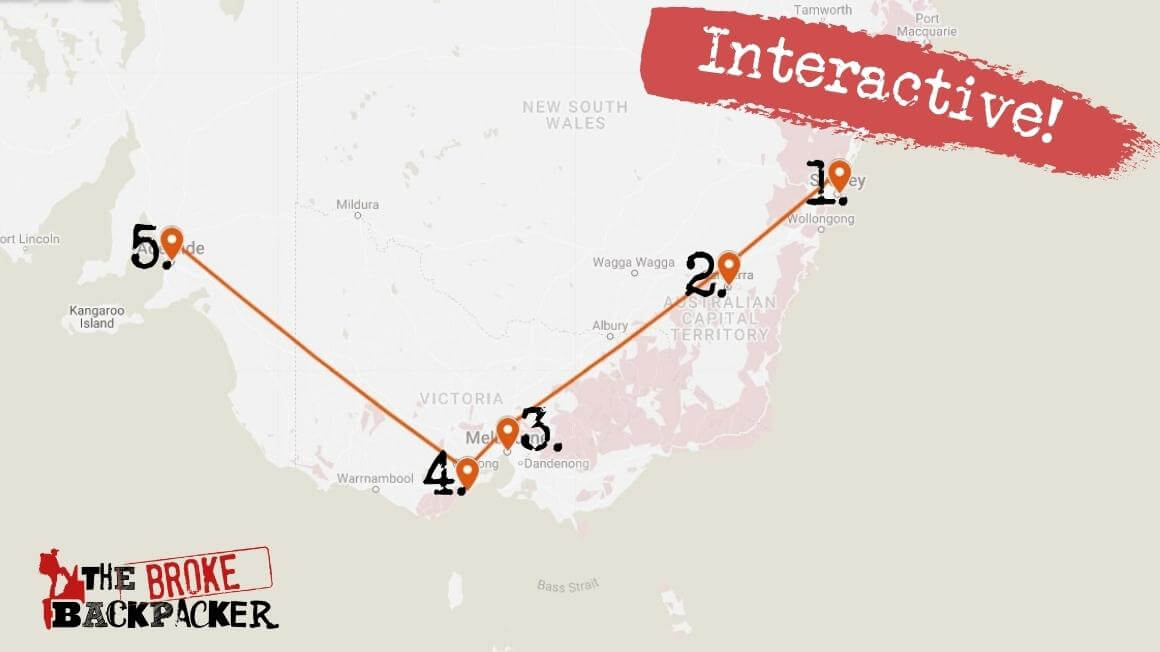
See the best of Australia’s metropolis cities on this 2-week itinerary around the southeast coast! You could start this itinerary off in either ofthe major cities, Sydney or Melbourne . But for the sake of ease, let’s say we’re starting in Sydney .
The fake capital of Australia is home to iconic landmarks: Sydney Opera House and Harbour Bridge. Spend a couple of days getting lost in Sydney and enjoying some of the epic beaches of New South Wales.
Then, make your way south towards Melbourne stopping for a visit to Canberra . Canberra is a huge city that is most known for its government offices. Personally, I don’t think you need more than a day, but the journey from Sydney to Melbourne is long so it’s a good place to rest up.
Departing from Melbourne, travel along the sublime Great Ocean Road and earn glimpses of the stunning 13 Apostles and the Great Otway. Ocean Road is simply breathtaking.
It takes a few days to drive Ocean Road to Adelaide, so I suggest breaking it up. I suggest stopping at Port Fairy for a night and getting some rest here – it’s a small seaside town with not much to see.
There’s also a really great fish and chip shop here called Morriss Road Fish Shop and I had a great bacon cheeseburger… It’s the little things.
After spending a few days traveling on this road you’ll get to Adelaide , Australia’s most relegated and unknown big city.
Adelaide is a hidden gem just waiting to be discovered! This city is saturated with artists, amazing beaches, and tons of wine. After getting your fill here, grab a plane back to Sydney if you’re flying out from there.
3-Week Travel Itinerary for Australia: The East Coast
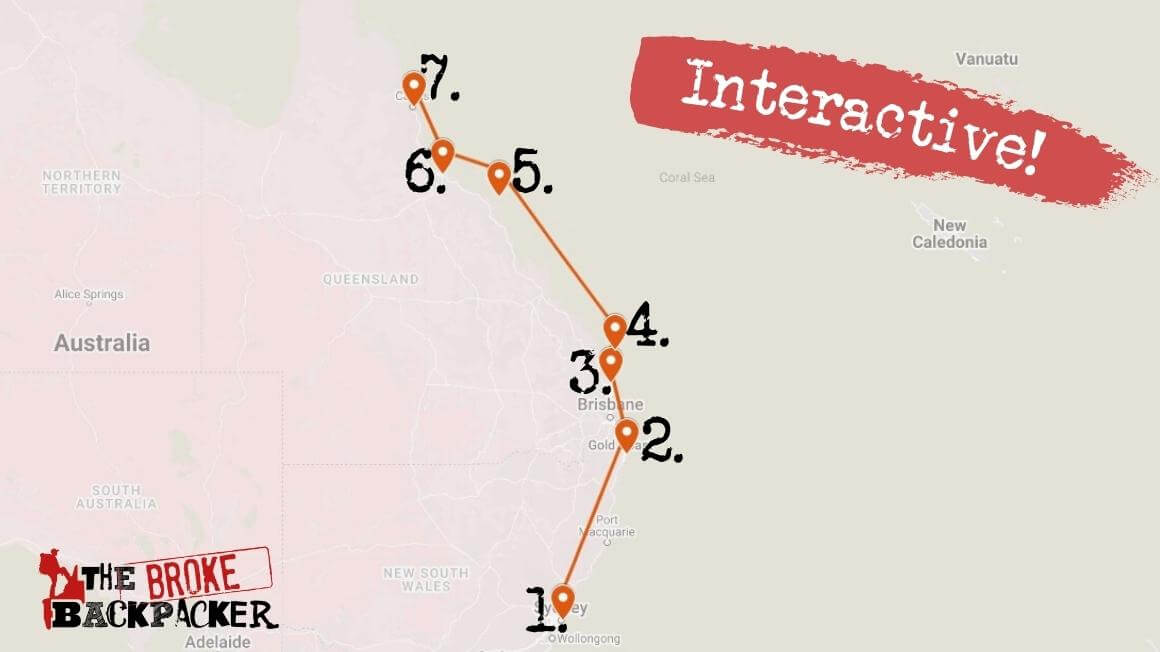
This is the best itinerary for tackling an East Coast Australia road trip! Starting in Sydney, you should spend at least 1-2 days exploring. Take a day trip out to see the Blue Mountains National Park and marvel at the Sydney Harbour Bridge (or climb it, if you’re not scared ).
After Sydney, it’s a long road to Byron Bay , the most famous beach in Australia and a hot spot for surfers. Personally, I found the beach itself crowded and underwhelming – but I met amazing people and spent nights laughing harder than I had in years.
I went on to the Gold Coast from here. I stayed with family and it was one of my favourite memories. But unless you are a passionate surfer or love corny beach towns, it’s not a must-see.
Brisbane is a city that doesn’t get enough hype. I loved Brisbane and I cannot explain why. It’s just got a cool vibe and the nearby Gold Coast is simply stunning. I suggest spending 2 days in Brisbane, but no one would blame you if you wanted to stay longer.
Next, don’t miss Noosa , a world-famous surfing destination. If you don’t like surfing, you can also go hiking in the Noosa National Park and rock climb some cliffs. I met up with people I previously met on the road here and it was well worth it.
Next, you’re going to head to Fraser Island . This unspoiled island is a nature reserve and it’s definitely worth staying actually on the island if you can afford it. You’ll also find plenty of yoga retreats in this area.
You can’t swim in the ocean, but I tell you, you won’t want to because you can see whales swimming in the ocean right from the shoreline! Make sure to check out the abandoned shipwreck too.
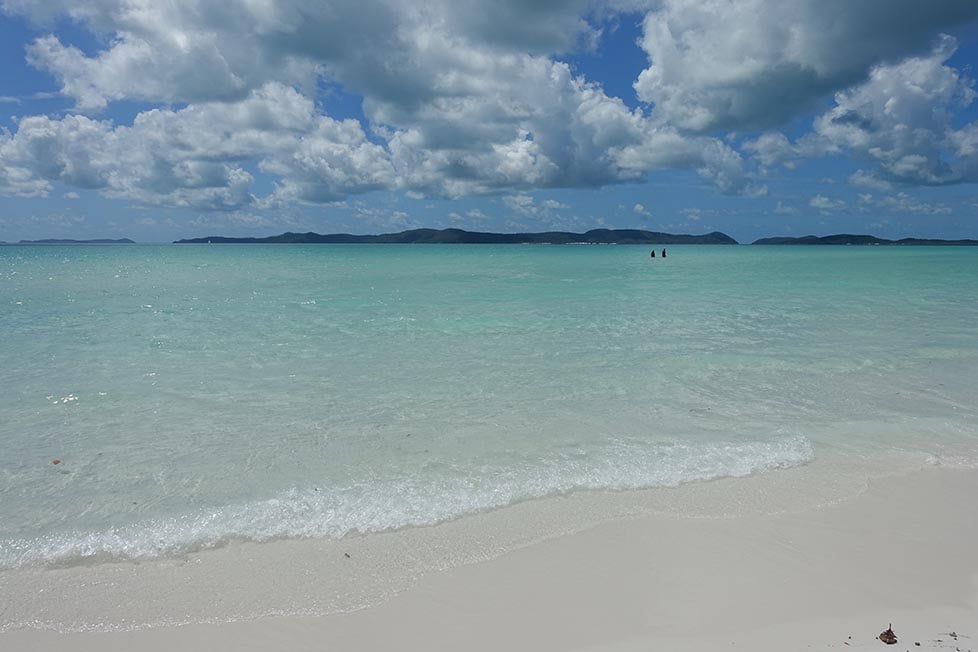
After 2 days on Fraser Island, head to the Whitsundays , my favourite spot on the East Coast. The Whitsunday islands are untouched nature reserves, and you can only access most beaches by boat. This is a ‘take only photographs, leave only footprints’ kind of beach.
The sand is pure white and the ocean is a dazzling blue. You’ll never see anything like it. You could even look at it from up in the clouds by taking a Whitsundays and Heart Reef 1 hour scenic flight . You’ll see the kaleidoscopic colours of the Great Barrier Reef.
Next up, is Townsville . The actual town isn’t that impressive, but people often stop here to go to Magnetic Island. It’s also a great place to stop if you like diving and want to explore the Great Barrier Reef.
Finally, you’ll get to Cairns . This is one of the coolest cities in Australia, in my opinion. It’s surrounded by rainforests and expansive beaches and has a cool surfer-town vibe. Spend a few days chilling out here and then fly back to Sydney.
3-Month Travel Itinerary for Australia: The Land Down Under
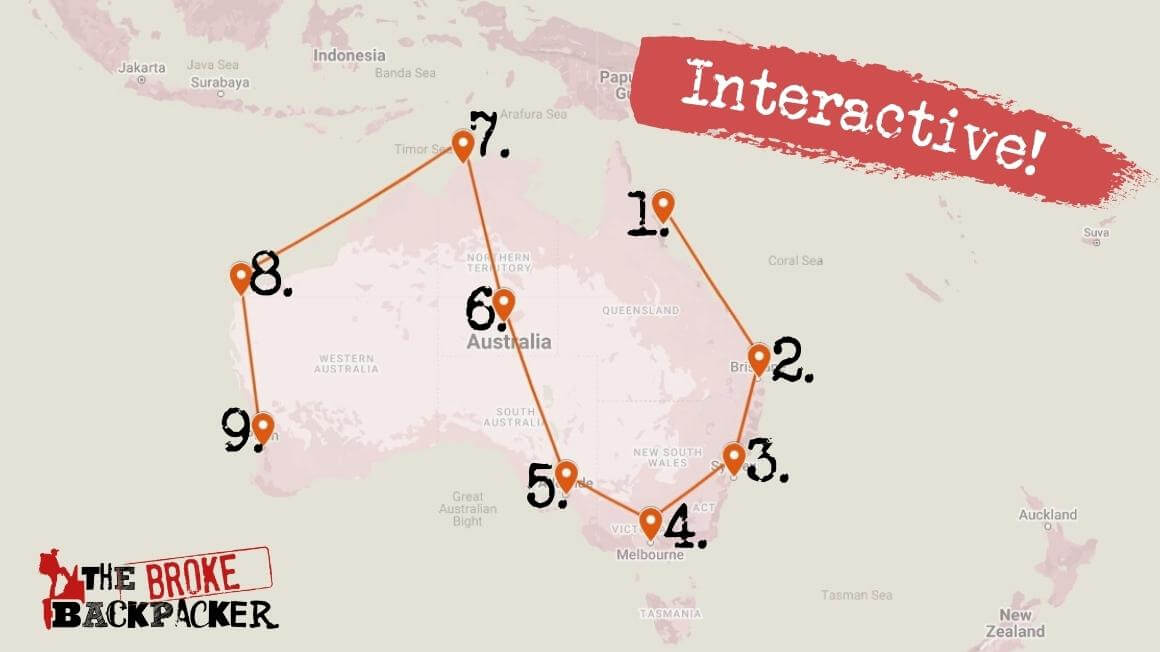
For this epic trip around Oz, this itinerary combines all you’ve seen above, with the addition of a few small-town stops. This route for backpacking Australia is pretty big. If you buy or rent a car , you’ll have complete freedom.
Let’s start by the Great Barrier Reef in Cairns . Make your way down, through Queensland. Surf the Gold Coast , dive Ningaloo Reef , trek Kakadu National Park ; all of this and more is possible on this epic road trip through Australia!
Follow the East Coast itinerary to Brisbane , down to Sydney, then backpacker favourite: Melbourne .
Adelaide , the most underrated city in Australia is the gateway to the outback. Catch the iconic Ghan train to Darwin. The train takes 24 hours – but not in one hit.
It stops in Alice Springs , a large town in the middle of the red desert. Spend at least 3 days!
If you fall in love, how about spending a month backpacking route for Australia in the Outback ? Visit top destinations like the mighty Uluru , Kimberly , and the Nullarbor !
Then, on to Darwin . Many people don’t know that Darwin has the most incredible sunsets in Australia. This coastal city has a relaxed, hippy-ish vibe and is where to learn about aboriginal history (being the closest spot to Kakadu National Park).
Head over to Broome , a beach resort town, west of Darwin. I recommend at least 3 days in Broome, bathing on the beaches lining the Indian Ocean, including the 22 km-long, white sand beach, Cable Beach. Venture into the wilderness or go looking for dinosaur tracks at Gantheaume Point. There are definitely a lot of cool hostels in Broome and some damn fine food too.
After that, enjoy Exmouth for pristine beaches and glistening blue waters. Here is the best place to explore the Ningaloo Marine Park – full of thriving coral reefs and migratory whale sharks.
Perth is a huge city with tons of character. It’s a great base to explore nearby beaches and wildlife. It’s worth spending a few days before flying back to Adelaide to finish your trip.
As you can imagine, a country as vast as Australia is full of unique places to visit. Some major cities are spangly and new, like Sydney and Melbourne. Others date back to aboriginal times and feel strikingly different.
There is so much to unpack and discover that I can give you my favourite places to go in Australia. But inevitably, you’ll discover your own hidden gems.
Let’s take a look at the absolute most beautiful places in Australia !
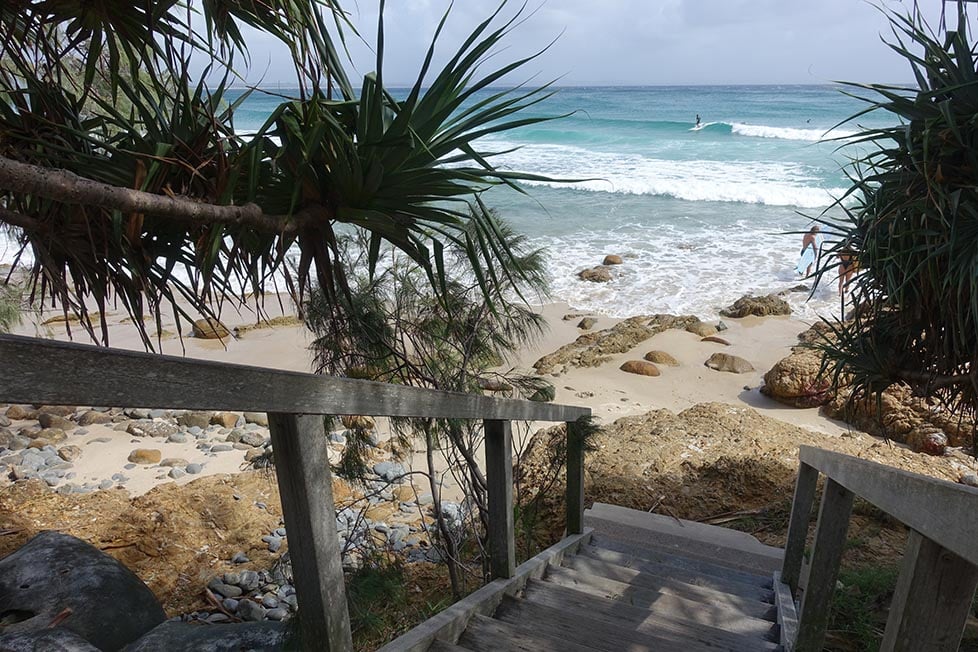
Backpacking the East Coast of Australia
The East Coast of Australia, consisting of the states of New South Wales and Queensland , is the most popular backpacking route in Australia! The East Coast has some of the best infrastructure, greatest thrills, and most beautiful places in Australia. There is so much to do and see on the East Coast of Australia that we at Broke Backpacker had to create a separate East Coast backpacking travel guide to do it justice.
No trip to Australia is complete without a stop in this amazing part of the country.
Traveling 1500 miles from the ever-enchanting Sydney to Cairns affords travelers insane opportunities for adventure. You’ll navigate ancient jungles, go walking in the bush, and (of course) visit Australia’s damn fine beaches.
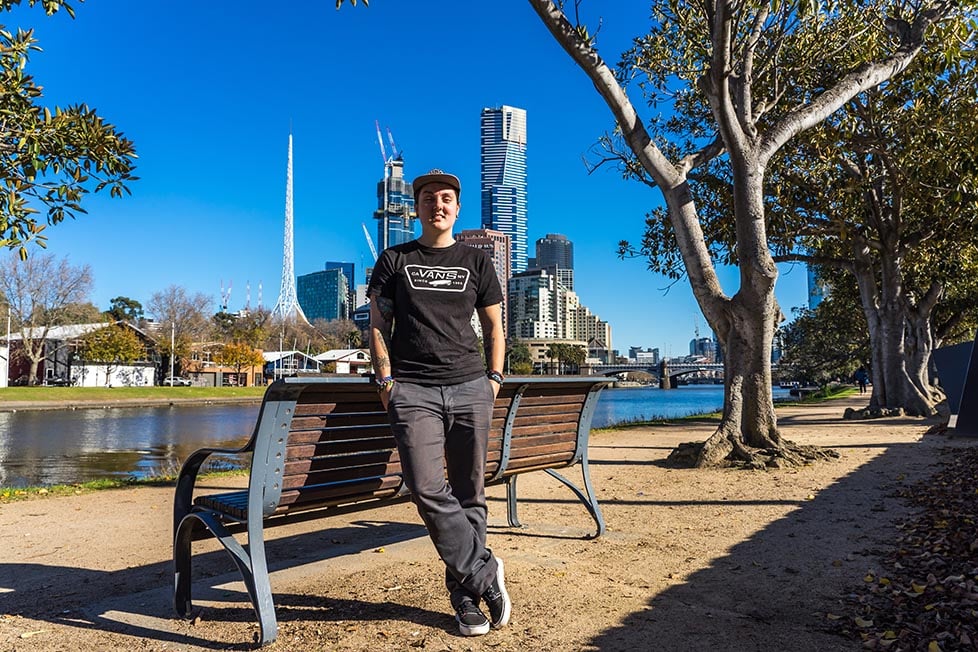
Some other highlights of backpacking the East Coast of Australia include camping on Fraser Island , sailing among the picturesque Whitsunday Islands , and diving at the Great Barrier Reef .
My top highlight was probably feeling freer than I ever had in my life before. Meeting people who you immediately click with and change your plans for. It’s a remarkable experience.
Those interested in backpacking around this part of Australia should best refer to our informative guide where I break down heaps pertaining to New South Wales, Queensland, and everything in between. This includes the usual subjects like accommodation , itineraries , and how to get around .
Note that this guide will also cover locations that are not bound to the coast including the Atherton Tablelands and the Outback . You gotta see the desert while backpacking Australia even if you intend on being a beach bum 99% of the time.
- Sydney Backpacking Travel Guide
- Byron Bay Backpacking Travel Guide
- Sunshine Coast Backpacking Travel Guide
- Cairns Backpacking Travel Guide
Backpacking Canberra
Canberra is the federal capital of Australia and has a rap for being boring as hell. Famously, one former prime minister wouldn’t even live there when he was in office (though he denied any feeling any revulsion to the place). Truthfully, Canberra really isn’t that bad – so long as you know what you’re getting yourself into.
Canberra is a planned community that was designed to be a “garden city”. For this reason, Canberra has an extensive amount of parkland, national monuments, and cultural centers. At the center of everything is the large and artificial Lake Burley Griffin , which acts as a sort of reference point.
Around the lake are Canberra’s most prominent landmarks including both Parliament Houses (the old and new ones), the hallowed Australian War Memorial, and several museums and galleries. The National Museum of Australia, National Gallery, and National Portrait Gallery are all fine cultural centers worth visiting.
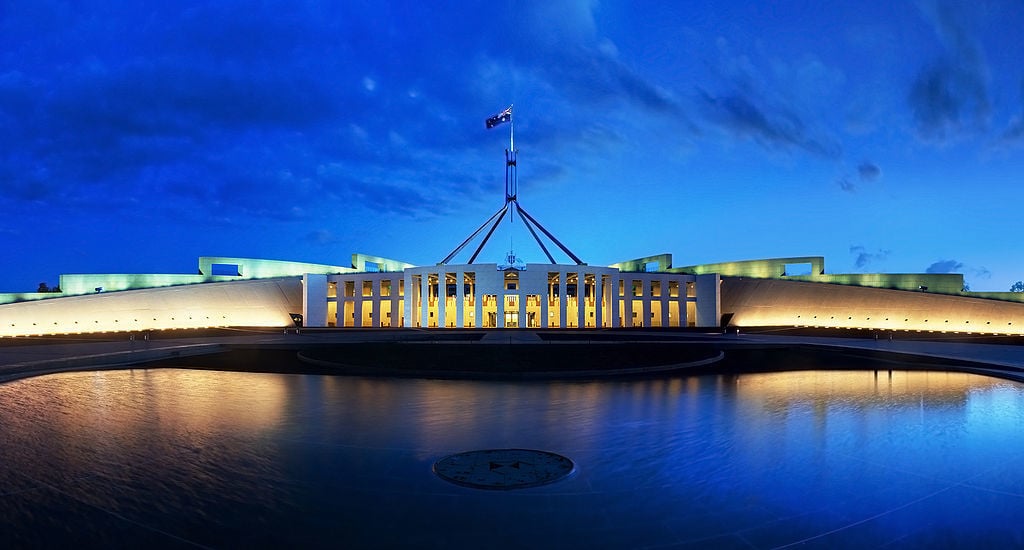
The best way to get around Canberra is by walking or biking. Thanks in part to abundant greenery and lack of traffic, these modes of getting around can be quite enjoyable.
Take note that Canberra is still quite spread out. So getting around on foot is a day’s work in itself.
If you find Canberra’s parklands insufficient, then there are plenty more pastoral sights outside of the city. Namadgi National Park is the northernmost section of the Australian Alps and has lots of outdoor activities. Mountain biking, in particular, is very popular around Namadgi and the highlands of Canberra.
Ultimately, Canberra is a fine city to visit for a weekend . Those backpacking around Australia should come here for the bucolic scenery and small-town lifestyle.
Backpacking Melbourne
Sydney’s greatest rival is the super-dynamic and culturally superior Melbourne . Melbourne is the former federal capital city and, for this reason, was once the center of all things Australian.
Melbourne lead the way in economics, art, sports, you name it, until Sydney rose and began to challenge it. Backpacking Melbourne is a fun and interesting experience.
Melbourne is a huge city with multiple districts. Most of the top things to do in Melbourne are found around the city center – in the CBD and Southbank . The CBD is buzzing constantly with action: here are some of the best cafes, bars, restaurants, and cultural sites in the city.
Flinders Street Station acts as the central nervous system of Melbourne and provides transport to any and all of the metropolitan area. Very close to the CBD are St. Paul’s Cathedral and Collins Street, the latter of which is very fucking cool.
Other notable attractions, like the Shrine of Remembrance, Queen Victoria Market, and Federation Square, are all a short walk away from the CBD.
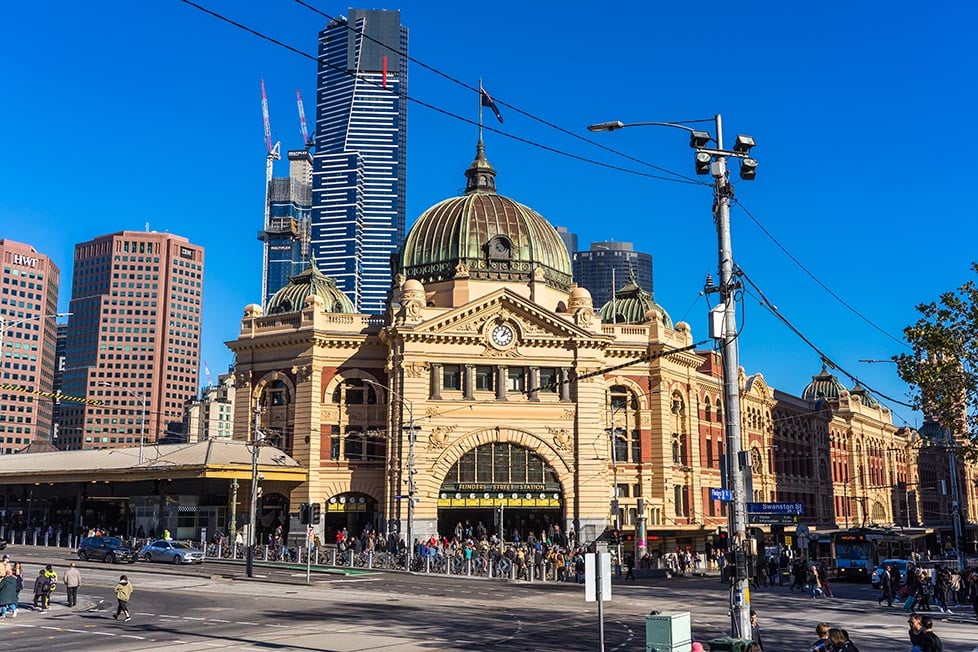
Further outside of the city center are many more districts that make for great day trips. Carlton is a neighborhood rich with Italian heritage and home to the impressive Museum of Melbourne.
St Kilda is the premier beach hangout and has a nightlife that is comparable to the debaucherous King’s Cross in Sydney. Brighton is where you’ll find the iconic beach huts. Finally, Collingwood and Fitzroy are the favorite hipster hideouts in an already hipster-ass iced-coffee kinda city.
Backpacking Melbourne’s pedigree cannot be understated – this is one of the coolest places in Australia. You just have to visit this city and wander amongst its laneways all the while sampling as much music, food, and drink as possible. Be sure to check out some of the best festivals in Australia right here in Melbourne!
As far as sick hostels in Melbourne go, everyone has their opinions. But my favourite is The Village . Get ready to meet a cool bunch of dirtbags.

Backpacking Adelaide
Backpacking Adelaide has had a somewhat dull and undeserving reputation. Just hearing its nickname, “The City of Churches,” leads your mind to those dreary choir songs that make people wanna go meet Jesus sooner.
Although, this nickname was never a reference to the city’s piety. Conversely, as an ultra-liberal city, Adelaide was a place of many places of worship and ideologies. In lies Adelaide’s true self: a forward-thinking and supremely eclectic city.
Adelaide or Radelaide has quietly been one of the best cities in Australia. Here is an amazing art scene, a thriving nightlife, and some of the best city beaches in Australia.
Oh, and did I mention that this is the wine country of Australia? You can’t throw a boomerang and not hit a winery.
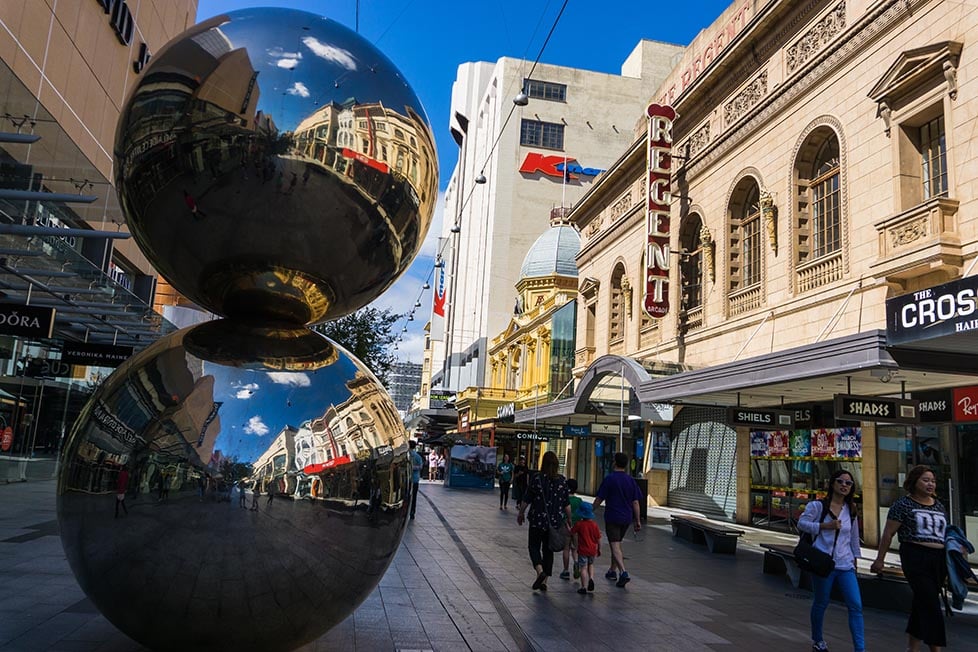
Adelaide is a planned city – the first founded by freemen – and is extremely easy to get around. You can easily walk across the whole city proper in an hour or two.
A tour of Adelaide should definitely include a walk around one of the surrounding parklands, with lovely sights like the River Torres and the Botanic Gardens. For the best food and drink, look around the likes of Rundle Street, South Hutt Street, and O’Connell Street .
Adelaide has some of the best city beaches in Australia. Glenelg is a glitzy beach with lots of clubs and cafes. The most beautiful beaches though are found in the southerly suburbs around Brighton , Port Noarlunga , and Aldinga .
There is wine country everywhere outside of Adelaide. The Clare Valley, McLaren Vale, and Barossa Valley are the most prestigious regions and, between the three of them, produce the majority of Australia’s wine.
Hahndorf in the Adelaide Hills is another popular pastoral town, known more for its beer and German heritage.
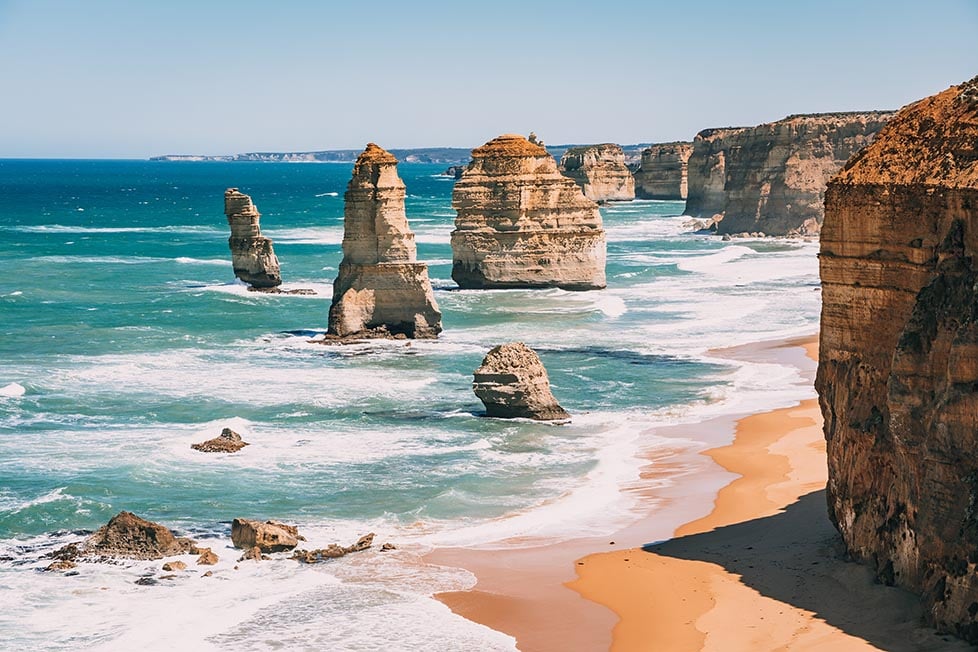
You could fly, but I reckon a road trip from Melbourne is the best and most rewarding way to get here. Driving on the Great Ocean Road is a must-do while backpacking in Australia!
You’ll see several prominent landmarks and attractions while driving along the 150 miles of the Great Ocean Road. The most famous landmarks here are the Twelves Apostles : a group of limestone sea stacks that rise stunningly out of the ocean.
It’s one of many great Australian road trips . But this is one of my favourites.
Backpacking Kangaroo Island and the Yorke Peninsula
Within a day’s drive from Adelaide are the seaside getaways of the Yorke Peninsula , The Fleurieu Peninsula , and Kangaroo Island . Between the three areas, there are over six hundred miles of coastline. Most of these beaches are hardly visited or even touched by any sort of tourist.
The Yorke Peninsula is north of Adelaide. On a map, the Peninsula is easily recognizable due to its distinct shape – like a large tail, leg… or willy (to some people).
Economically, agriculture – not tourism – is the region’s leading enterprise. This has, for the most part, lead to the development of several small rural communities, which make for great backpacker bases.
Popular activities on the Yorke Peninsula include surfing, diving, fishing, and sampling the local produce. The surfing here, in particular, is some of the best in the state. Must-see locations on the Peninsula are Pondalowie Bay , Innes Australia National Park , and Berry Bay .
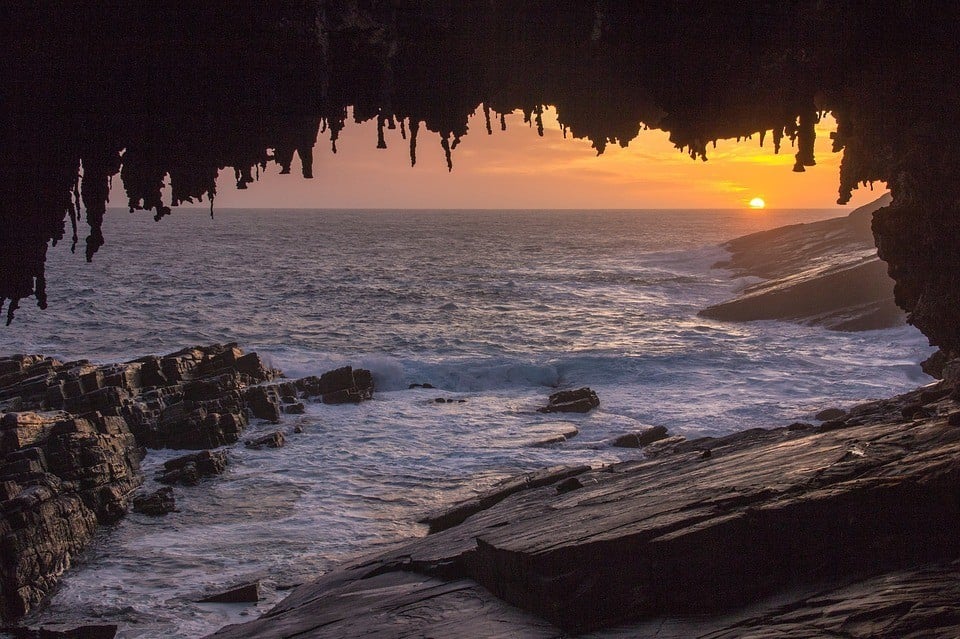
Kangaroo Island is a popular holiday spot for South Australians and is fairly unknown outside of the state. Located across from the Fleurieu Peninsula, it’s Australia’s third-largest island and an important refuge for several threatened ecosystems.
With highlands, rugged coastline, and a number of pristine beaches, the natural setting of Kangaroo Island is some of the prettiest in South Australia. Flinders Chase Park , Admirals Arch, and the Remarkable Rocks are among the most splendid sights on the islands – and shouldn’t be missed.
Arriving at Kangaroo Island is a simple matter of taking a short ferry from Cape Jervis . You’ll find most of the hostels in the largest settlement on the island, Kingscote. Local farm stays are becoming increasingly popular and many resemble hostels in their offerings.
Backpacking Uluru and Alice Springs
Smack dab in the “Red Center” of Australia, leagues away from any other city is Alice Springs . Never before has the term “ middle of fucking nowhere ” been more applicable.
Originally an outpost and then a military refuel base, it now serves as a hub for visiting the many desert wonders of the region, including the famous Uluru , previously known as Ayers Rock , changing it back to its aboriginal name.
Uluru is one of the most recognizable sights in Australia: it’s magnificent. Honestly, words don’t do this massive red rock justice – and the pictures do little either. Uluru is meant to be seen and felt in person; only then will you understand its significance.
As one local told me: “you stand there staring at (it) and then it begins to pulse. Uluru is the heartbeat of Australia.”
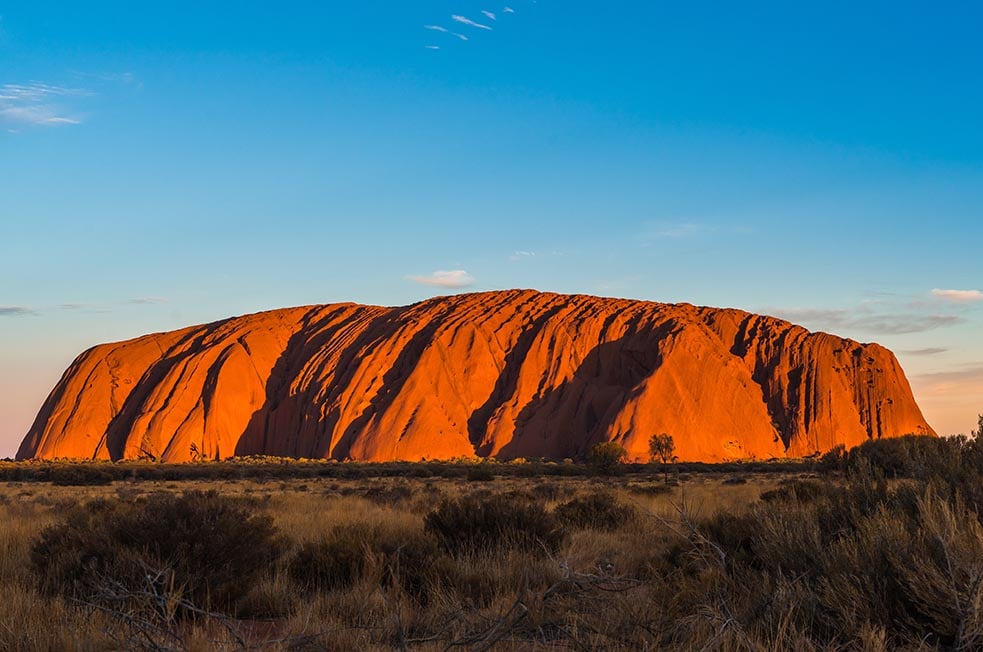
Thankfully, tourists cannot climb Uluru with the restrictions in place right now. The local Aboriginal peoples, who hold the mountain sacred, adamantly requested and (at least for now) the battle is won. Many white Australians are respecting these wishes and you should too; walking around the base of the rock is still plenty enough.
There are other options that are equally as mystical and amazing like the Uluru Stargazing Astro Tour . You’ll get special access to the national park at night with an epic, unfiltered view of the cosmos.
NOTE: Uluru isn’t actually very near to Alice Springs. You’ll have to drive 6 hours to reach it… That’s Australia for you.
There are a number of other hikes around Alice Springs aside from Uluru. Kata Tjuta aka the Olgas and Kings Canyon are both definitely worth visiting as well.
The actual city isn’t much to write home about. Those expecting a weathered and rustic outpost in the middle of the harsh Outback will be upset to hear that the Springs is quite developed.
This infrastructure comes with a number of positives and negatives too including plenty of awesome Alice Springs hostels, swimming pools, and rampant racial tension, to name an unrelated few.
Backpacking Darwin
Darwin is the capital and largest city of the vast and empty Northern Territory . In an otherwise desolate place, Darwin exists today thanks to the booming mining industry and the need to create Asian shipping routes.
By most standards, Darwin is a small city with very few areas and attractions. The Wharf Precinct , Bicentennial Park , and/or one of the few museums may be worthwhile – but that’s about all.
If I’m being honest here, my impression of Darwin is that it serves primarily as a weekend getaway for pent-up miners and a base for backpackers trying to find work. The parties are, predictably, over the top in Darwin as both worker and traveler let loose.
It’s also the gateway to Kimberly , a vast and wild section of West Coast Australia that borders the Northern Territory. Many believe that this region contains the best of Australia’s Outback. With an area roughly equivalent to California and a huge array of natural sites, the Kimberly is a grand Australian adventure .
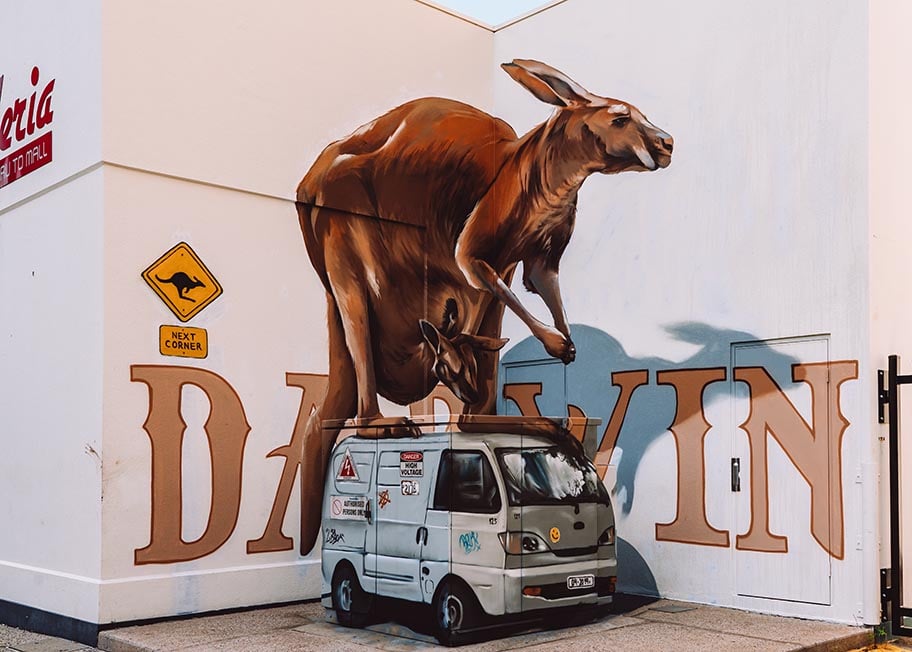
The best part about backpacking Darwin is that it’s very close to some of the Outback’s best locations. Should you journey into the bush, bring excessive amounts of sunscreen and bug repellent: you’ll be miserable without them.
Kakadu National Park is widely considered a staple of the region and is a must-visit for those backpacking Australia. Ubirr , Jim Jim Falls , and the Gunlom Plunge Pool are among the best of Kakadu. Also worth visiting is Litchfield National Park , which is a lovely place full of waterfalls and swimming holes to cool off in.
Further south is the small town of Katherine . Here is the impressive Katherine Gorge , located within the Nitmiluk National Park . Travelers can experience the gorge in many ways from chartering a boat to paddling in a kayak to hiking along the rim of Jatbula Trail. That final option is a 4-5 day one-way hike.
Backpacking Exmouth and the Ningaloo Reef
Of a similar vein to Broome is the small community of Exmouth , located on the remote North West Cape . Here are some stunning beaches, awesomely rugged terrain, and, most importantly, one of the most precious ecosystems in Australia: the Ningaloo Reef .
Like Broome, Exmouth is a quiet beach town that swells in population during the four-month-long tourist season.
There are the usual civilized amenities here i.e. hotels, restaurants, bars, markets, etc. Exmouth also has a couple of city beaches – Town Beach and Mauritius Beach – but these are kind of lackluster. Eager backpackers ought to head directly to Cape Range and the Ningaloo Reef.
Cape Range National Park has some of the most beautiful beaches in Australia as well as some great hiking opportunities. All of the beaches of the Cape Range are seemingly perfect with brilliant white sand and crystal clear waters. Some superlative beaches include Turquoise Bay and Sandy Beach .
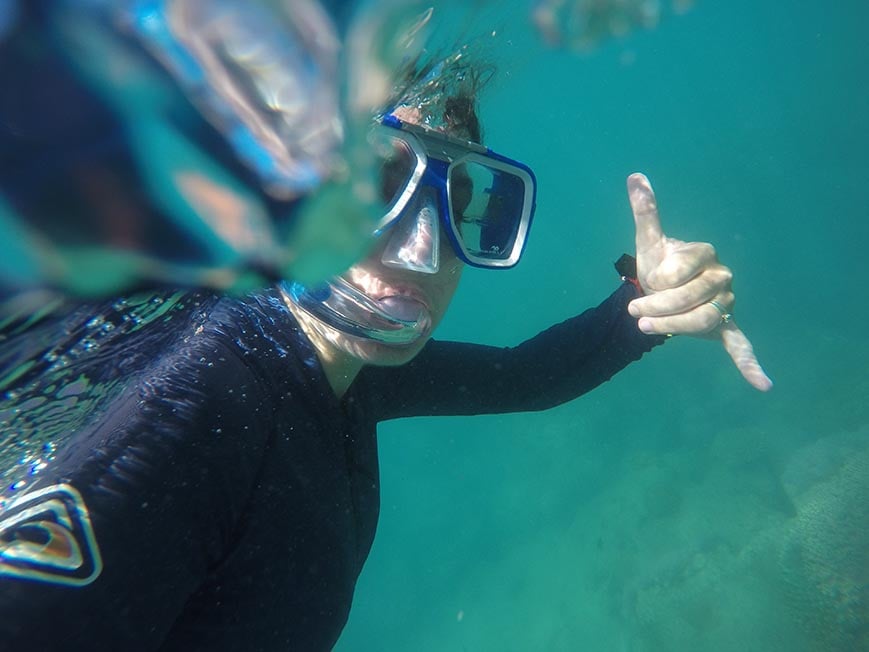
Further inland, Cape Range has some wonderful canyons and gorges that make for great trekking spots. For the most popular hiking trails in the area, visit Charlie Knife Canyon, Yardie Creek Gorge, and Mandu Mandu Gorge .
Should you go snorkeling around Cape Range, chances are that you’ll stumble upon the beginnings of the majestic Ningaloo Reef . It’s home to some amazing marine life including whale sharks!
The coolest part about this reef is that it’s very close to the mainland. Unlike the Great Barrier Reef, which is 150 miles from Cairns, you can literally swim (safely) to the Ningaloo Reef from the beach in some places i.e. Coral Bay .
Having a watercraft will, of course, unlock, more of the Ningaloo Reef. There are a number of sailing companies around Exmouth and Coral Bay, though a kayak may be sufficient enough.
Backpacking Perth
Perth ‘s primary claim to fame is that it’s considered one of (if not the most) isolated major cities in the world. It’s probably a good thing though; if Perth were any more accessible then it would definitely be overrun by now. With a booming economy, an extremely pleasant climate, and some of the most beautiful scenery in the whole country, Perth is certainly in the running for the best city to visit in Australia .
Aesthetically, Perth is great for backpacking since it’s a very attractive city. The CBD , with its ever-growing skyscrapers, rises elegantly on the banks of the Swan River. From King’s Park , which is very charming in its own right, the cityscape is totally laid out before you and yours to take in.
Inside the city itself, there are a few tourist sites of note. London Court is a lovely street built in Elizabethan fashion, complete with Tudor-style homes and coat-of-arms on the doors; obviously, not the most authentic of attractions… but pretty nonetheless.
Also worth seeing is the redeveloped Elizabeth Quay , which is Perth’s answer to the Sydney Harbor.
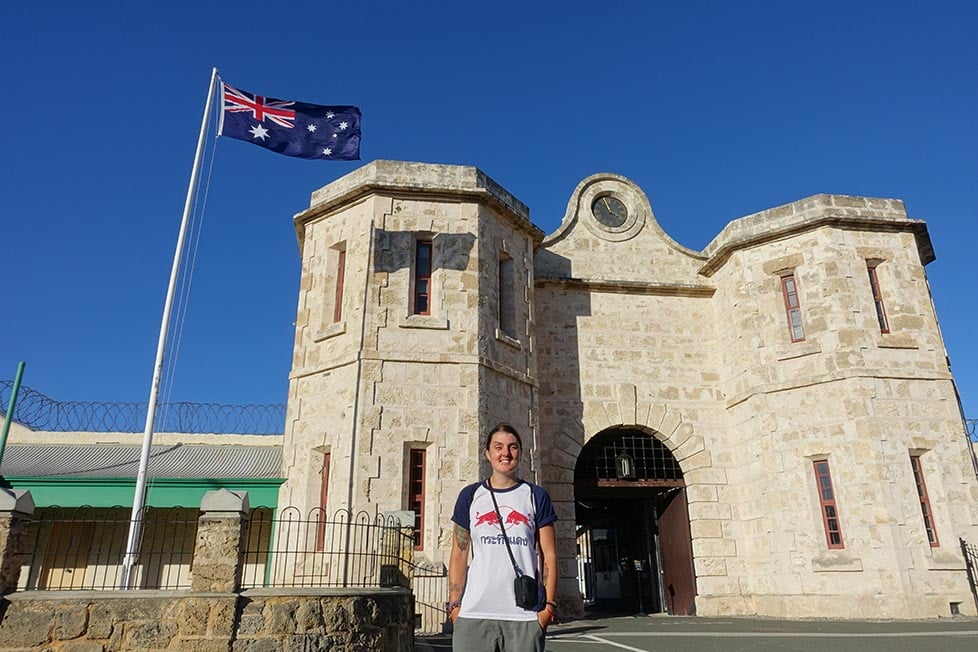
For all its beauty, Perth is worth a weekend visit but, to be honest, the best parts are outside of the city anyways. To the north is Northbridge where you’ll find the best eats and nightlife in Perth.
Adjacent Fremantle is a separate destination in its own right (see the section below) and definitely somewhere worth checking out. From Fremantle, you can book a ferry to the idyllic Rottnest Island for the chance to see the smiling quokkas and some gorgeous beaches.
Speaking of beaches, Perth has some of the best in Australia. Scarborough and Cottesloe are the city’s most famous strips of sand. Mullaloo Beach and Pinnaroo Point are lesser-known but absolutely breathtaking.
Backpacking Tasmania
Off mainland Australia, Tasmania is Australia’s forgotten state – a bit of an afterthought that only evokes images of Looney Toon characters or barbarous locals it would seem.
This is for the best though as backpacking Tasmania is a true hidden gem. This is a paradise, with fantastic landscapes, eccentric people, and some world-class cuisine. Tasmania is one of the best places in Australia and no one knows about it!
Tasmania is an island state, separated from the mainland by the Bass Strait. The majority of the population (40%) lives in the Greater Hobart precinct, which serves as the state’s capital city.
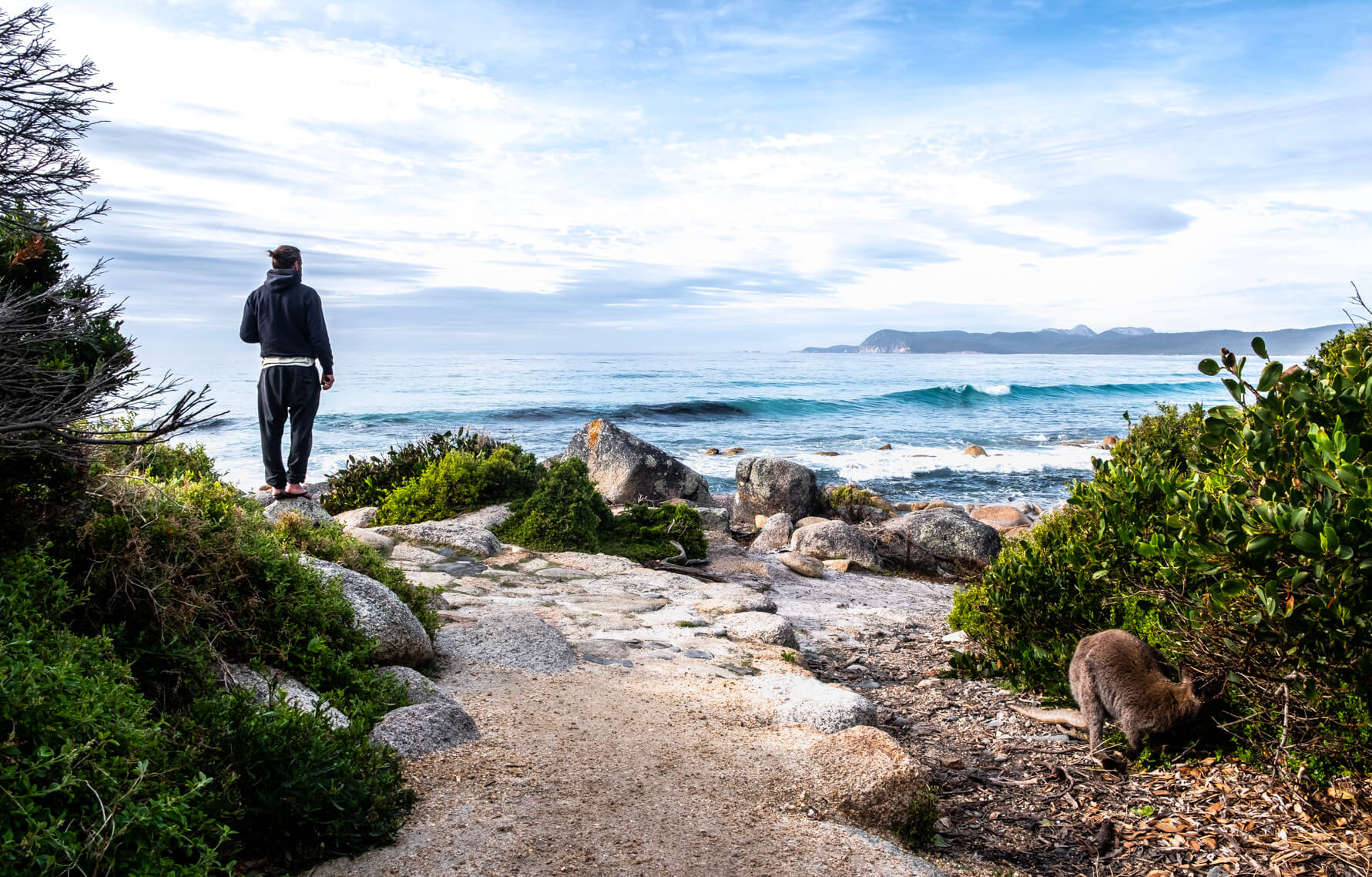
Despite its separation from the rest of mainland Australia, Hobart is an awesome city carrying a similar vibe to Melbourne. Though not as big, there’s a lively undercurrent of culture to be found in its art and music scenes.
There are also heaps of awesome backpacker hostels in Hobart, and you’ll definitely meet some like-minded travelers for the onward adventures in Tassie.
Other settlements of note include Launceston, Bicheno, and Strahan , among other communes of varying sizes. Outside of these urban areas, Tasmania is mostly pristine wilderness, a good chunk of which is protected parkland or heritage site.
Tasmania is home to some very diverse geography. The interior of the island is very rugged, composed of jagged mountains and thick rainforests.
The coastline doesn’t disappoint either as some stunning beaches and bays here easily rival those of the mainland. So varied and stunning are the landscapes that Tasmania is often referred to as Little New Zealand.
Getting Off the Beaten Path in Australia
There’s a lot of nowhere in Australia, which means that there are lots of opportunities to get off the beaten path. With the proper vehicle and supplies, you’ll be able to make your own expeditions into the lesser-visited places of Australia.
Some off-the-beaten-track locations you must explore are Oz’s most mental national parks : the Mungo National Park , known for its alien rock formations and large dunes, and Lake Eyre , the largest and lowest lake in Australia that changes color depending on the water level and salinity.
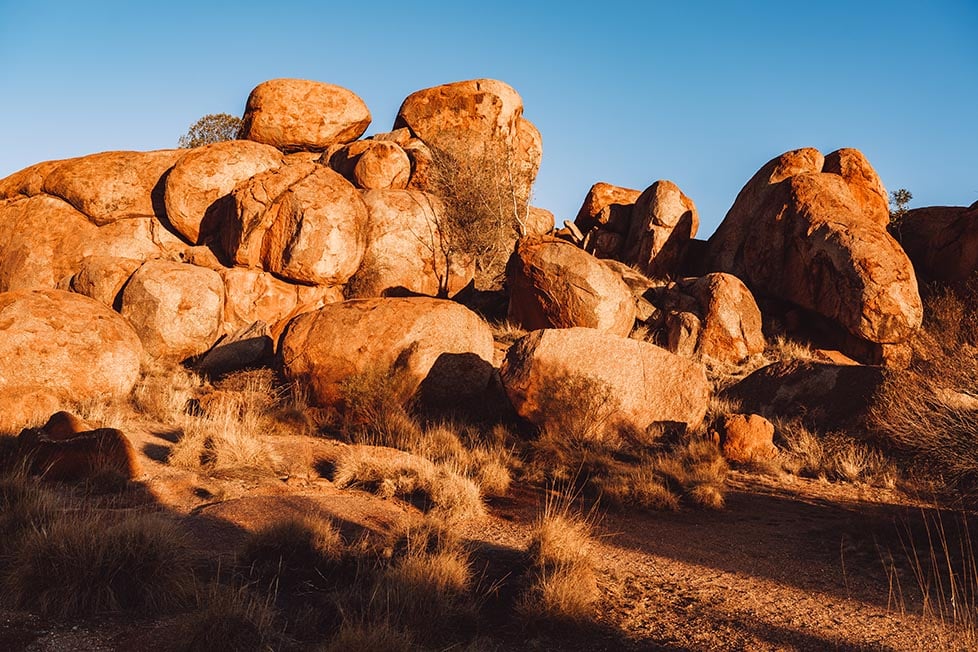
The Flinders Ranges are home to the Wilpena Pound , a huge, natural amphitheater that has to be seen to be believed. Coober Pedy is an old mining town that is famous for its swellings called “dugouts.”
The Karijini National Park is where you’ll find elegant gorges and breathtakingly vibrant rock, which makes this one of the most beautiful places in the outback. Speaking of Outback, you’ve heard of Uluru, but Mount Augustus is the real competitor. It’s larger but less prominent.
So as you can see, there are a ton of places to visit outside of the conventional. So get ready for some of the longest, bumpiest rides of your life as you go exploring the Australian nowhere!

We’ve tested countless backpacks over the years, but there’s one that has always been the best and remains the best buy for adventurers: the broke backpacker-approved Osprey Aether and Ariel series.
Want more deetz on why these packs are so damn perfect? Then read our comprehensive review for the inside scoop!
There are so many things to do in Australia that narrowing it down to just ten of the best was no easy task. However, when you visit Australia, these are my top recommendations to leave yourself with some amazing memories to carry with you forever.
1. Visit Australia’s Outback
No backpacking trip to Australia would really be authentic without visiting the Outback. This is one of the harshest, most inhospitable landscapes in the world, and one of the defining features of the nation.
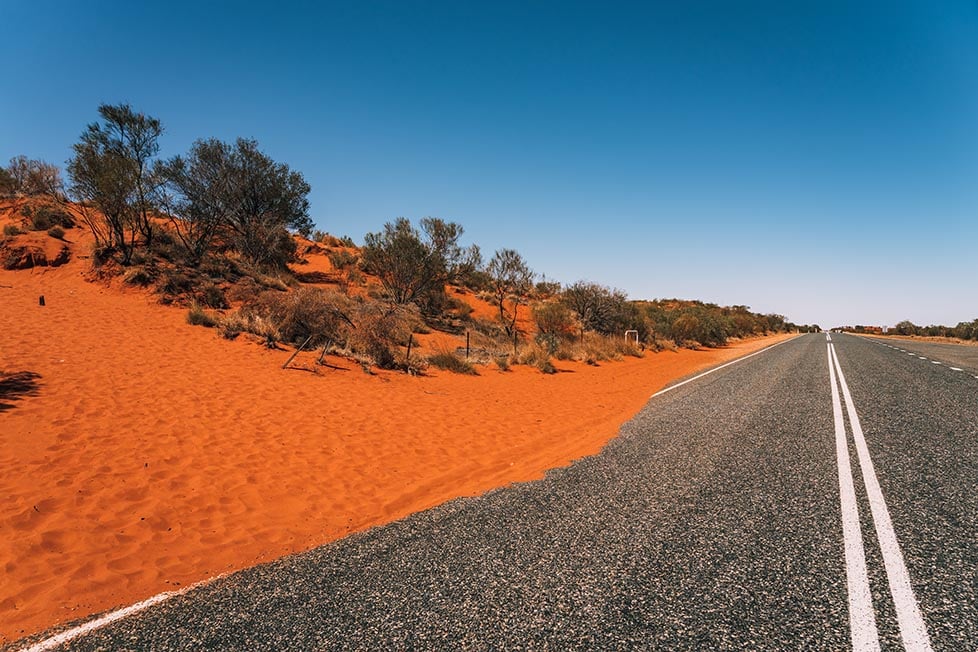
Some of the most beautiful national parks in Australia, like Karijini, are only to be found in the Red Center as well. Rent a 4×4 and go mobbing in the desert!
2. Witness Uluru
Uluru is a true natural wonder and has to be seen in person. Make the long journey to this shrine and feel the power that it emits.
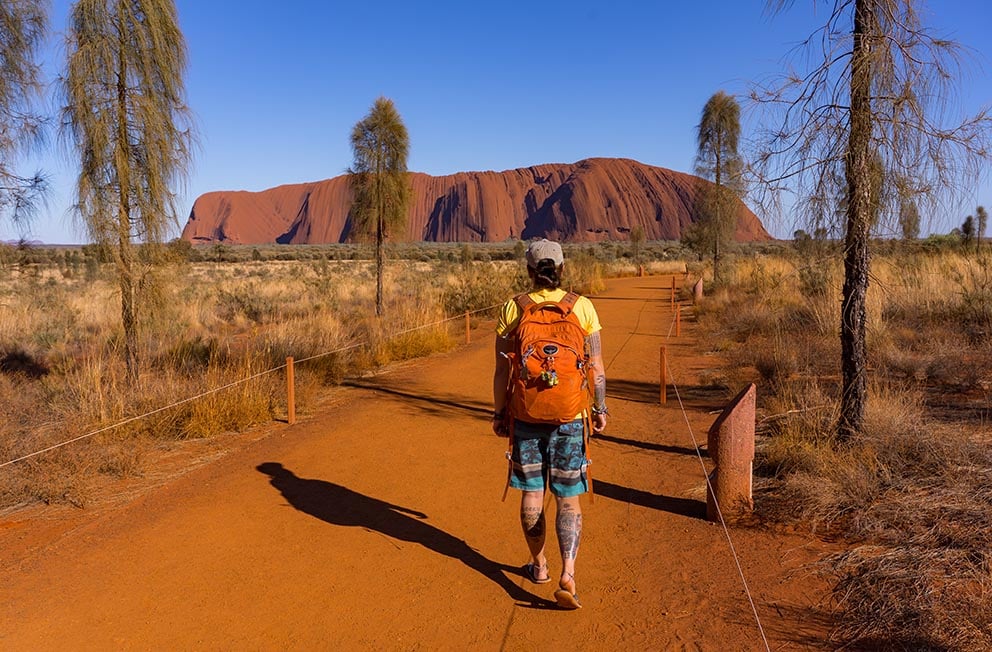
I also recommend taking a camping trip and spending a night sleeping under the stars in a swag bag. Uluru is one of the few places that is not spoilt by city lights and so you’ll see the best night sky of your life.
3. Go Sailing in the Whitsunday Islands
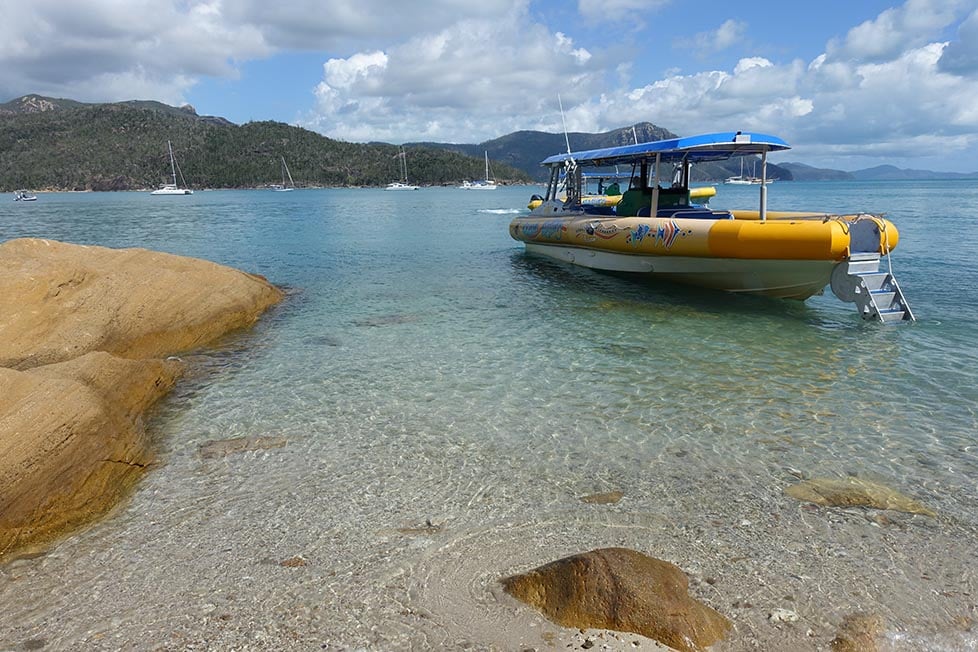
The Whitsunday Islands are absolutely drop-dead gorgeous and are one of the best places in Australia! Sail around the islands and be sure to visit Whitehaven Beach, which is one of the finest in the world.
Airlie Beach is a popular beach and gateway to the Whitsundays and the Great Barrier Reef. I personally struggled to drag myself away from here. It was one of the biggest, happiest memories of my life, smoking a doobie, looking out at the ocean, knowing I’m going to quit my job and travel full-time as soon as I got home.
4. Drink wine in South Australia
Yeeeeahhhh boooooyyy. South Australia is the wine country of Australia and produces some of the country’s most highly regarded vintages.
Visit one of the many wine regions surrounding Adelaide and try as much as you can! Spit or swallow… up to you.
5. Dive in the Great Barrier Reef or Ningaloo Reef
Both the Great Barrier Reef and Ningaloo Reef are amongst the most impressive ecosystems known to man. Diving in either one is sure to be an amazing experience. Enter an alien, underwater world, and be sure to have a waterproof camera !
6. Go surfing
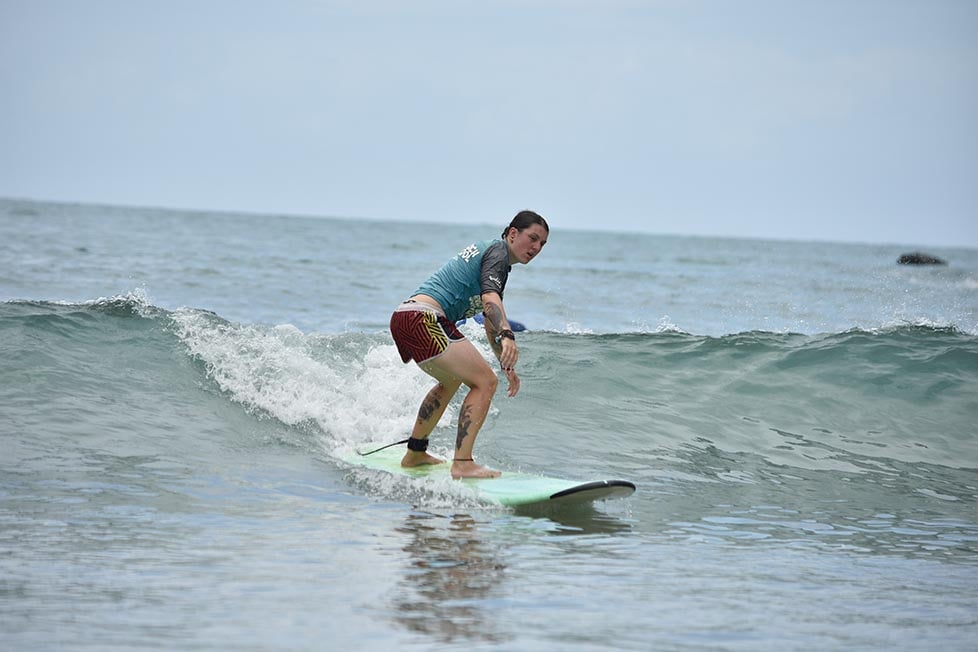
Surfing is one of Australia’s favorite pastimes and is practically the national sport! Anyone planning on backpacking around Australia simply has to try and get on board (see what I did there?). There’s a beach for every skill level and plenty of Aussies who love to show you the ropes.
7. Road trip!
Exploring Australia by car is the truest way to really experience the country. With your own set of wheels, you can go wherever you want and sleep wherever you want. As they say in Australia, “ There’s a lot of fuck-all out there ” so go and find it!
I suggest starting with a road trip around Queensland . It’s arguably the most popular route in Australia.
It’s a huge country, so you might not get to see all of it by road trip. Just heading from north to south will take weeks. Choose an area you want to explore the most, whether it’s an east or west-coast road trip, and go and explore!
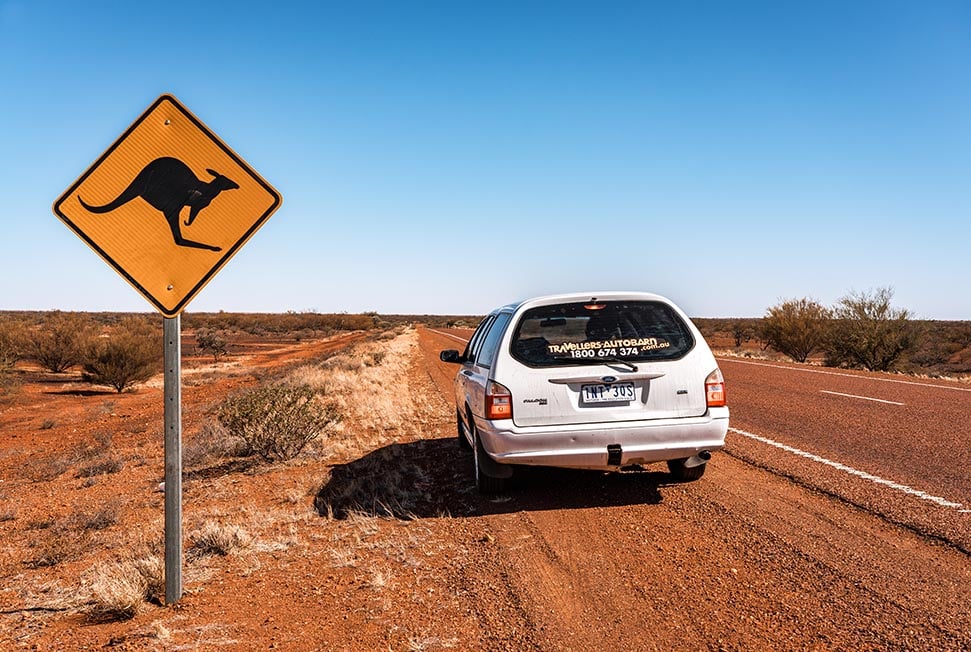
8. Discover Tasmania
Tasmania is one of the most beautiful places in Australia! This island is far more rugged than the mainland and is full of spectacular mountains, forests, and coastline. Journey here to see a different side of Australia.
9. Hike the beautiful national parks!
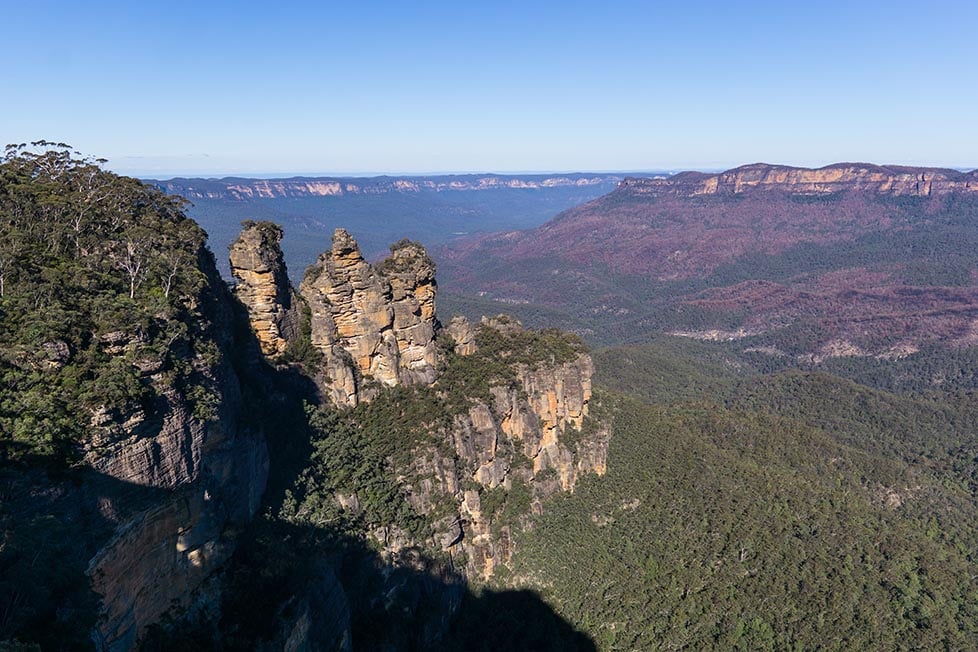
There are many incredible national parks around the country. The most notable are the Blue Mountains, Nambung National Park, Karijini National Park, and Kakadu National Park.
Located to the west of Sydney, the New South Wales darling is the epic Blue Mountains National Park. The town of Katoomba is the gateway to the park, and home to the world-famous Echo Point lookout offers panoramic views of Jamison Valley.
Here you get the best view of the iconic rock formation of the Three Sisters, a sacred Aboriginal site. As well as being an area of outstanding natural beauty, the park has several bushland trails and incredible wildlife.
The Nambung National Park is most well known for its impressive rock formations in the desert, plus there are some stunning beaches near Kangaroo Point and Hangover Bay.
Karijini National Park is a vast wilderness in Western Australia, well known for its Weano Gorge, accessible by a hiking trail that leads to Handrail Pool. Kakadu National Park is a huge wetland in Northern Australia and the best place to see crocs in their natural habitat.
10. Have a fling… or a few… 😉
Hey, Australia is FULL of young, sexy, liberated backpackers, trying to figure themselves out. The chances of you stumbling across other backpackers that you think are mighty fine is very high. Sex in hostels in Australia is inevitable!
Be a slag… do whatever you want. Be free, just please be safe too.
Australia is absolutely chalked full of backpacker lodges and hostels ! These are among the best and most entertaining hostels in the entire world. People from every corner of the globe flock to Australia to party and have one of the grandest adventures of their life, be it in a city, on a beach, or in the Outback.
Australian hostels are of very high quality and are often the recipients of numerous backpacking awards. Most organize lots of events from pub crawls to game nights to communal dinners. There are very few hostels in Australia that I can really speak poorly of (feel free to ask me though).
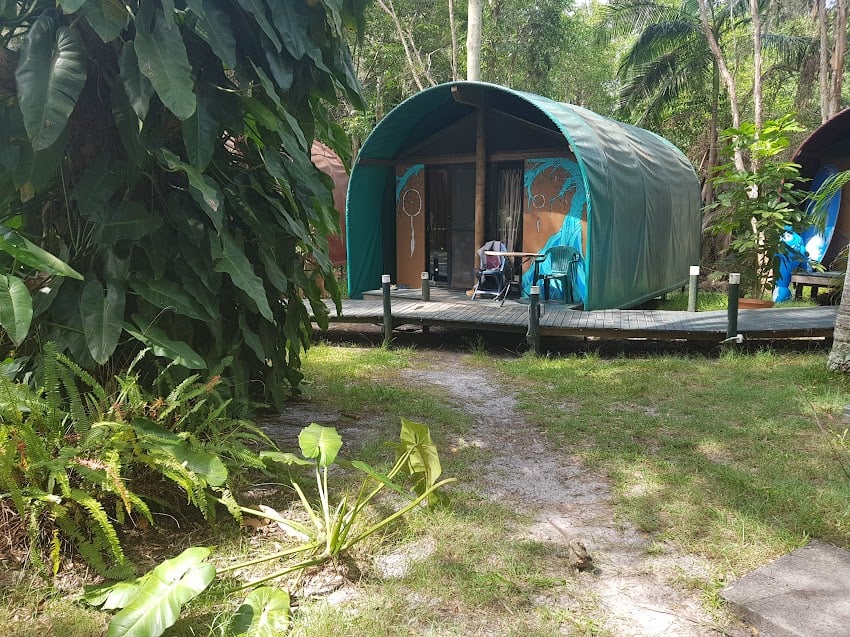
Couchsurfing is, of course, a very legitimate means of staying in Australian cities and is a great way to save some cash. Australians are an extremely welcoming bunch and have no problem inviting you over to their place for chicken parmy and a beer (or ten).
At the end of the day though, the best way to sleep in Australia is by camping, either with a quality backpacking tent or in a campervan. Australia has some of the most pristine and wonderful nature in the world and it needs to be experienced in the purest way possible. There’s nothing like sitting next to a fire in the bush and sleeping under the stars.
The Best Places to Stay in Australia
Not sure where to stay in Australia? Here are a few of my top recommendations!
Traveling to Australia on a budget is doable – if you know a couple of frugal tricks. If you can stick to a regiment, a comfortable backpacker budget in Australia should be around $60-$80 per day . Doing so means sticking to hostels, cooking at home, and drinking goon , amongst other things.
A bunk bed will cost between $15-$30 per night depending on where you are. More popular destinations, like Melbourne and Sydney, are more expensive while most of Queensland and parts of Western Australia will be cheaper. Naturally, solo travel in Australia is often more expensive than when you pick up a travel buddy.
Australian restaurants are usually pretty expensive with the average meal costing around $10-$25 . I strongly advise those that are backpacking around Australia to limit how much they dine out – the food is overpriced as fuck. You’ll save a heap of money if you cook for yourself.
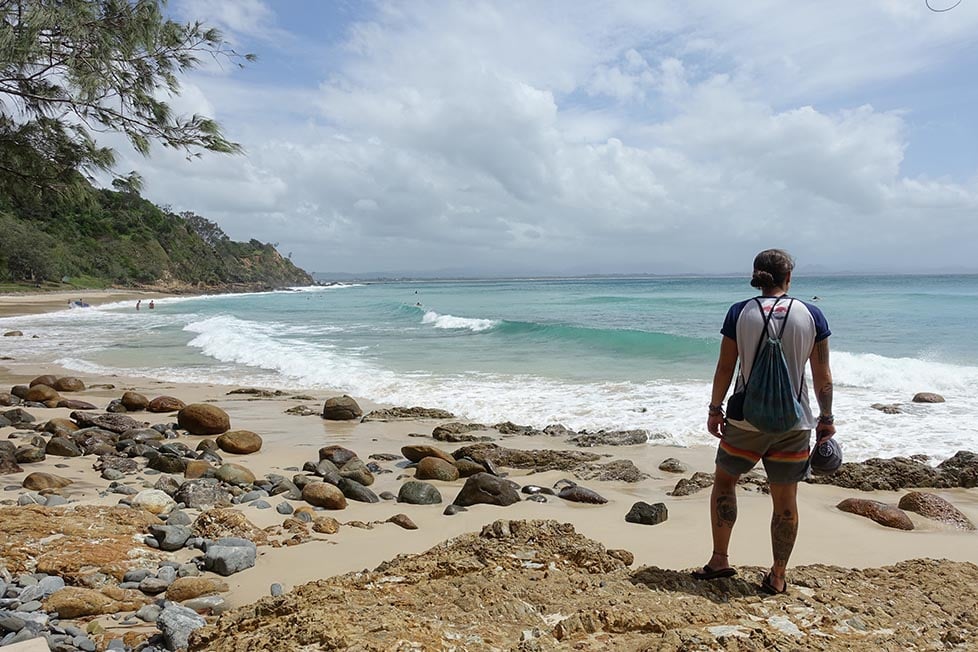
Partying is EXTREMELY expensive in Australia . Seriously, there’s a reason Australians do all the drugs when they travel: they’re too fucking expensive back home.
Cigarette prices are ridiculous and a beer is $7 AUD minimum . If you must drink, buy the cheap and ubiquitous boxed wines AKA goon – these will be your saving grace.
If you plan on participating in any of the classic Australian adventures, like diving at the Great Barrier Reef or sailing in the Whitsunday Islands, you will definitely be paying a pretty penny. The only thing to do is just save up as much as possible and then pick one or two of your favorites to participate in.
A Daily Budget in Australia
So, how much is Australia going to set you back? Here’s a rough estimate…
Money in Australia
The official currency of Australia is the Australian dollar or AUD. As of June 2023, the official conversion rate for the Australian dollar is 1 USD = 1.48 AUD . The value of the Australian dollar has fallen in recent years due to economic changes but the country is still prosperous and expensive by international standards.
ATMs are widely available and pulling out cash via a foreign card is an effortless affair. Most ATMs will charge a withdrawal fee on top of whatever international charges your bank imposes. Best to take out lots of cash at once to avoid paying too much in fees.
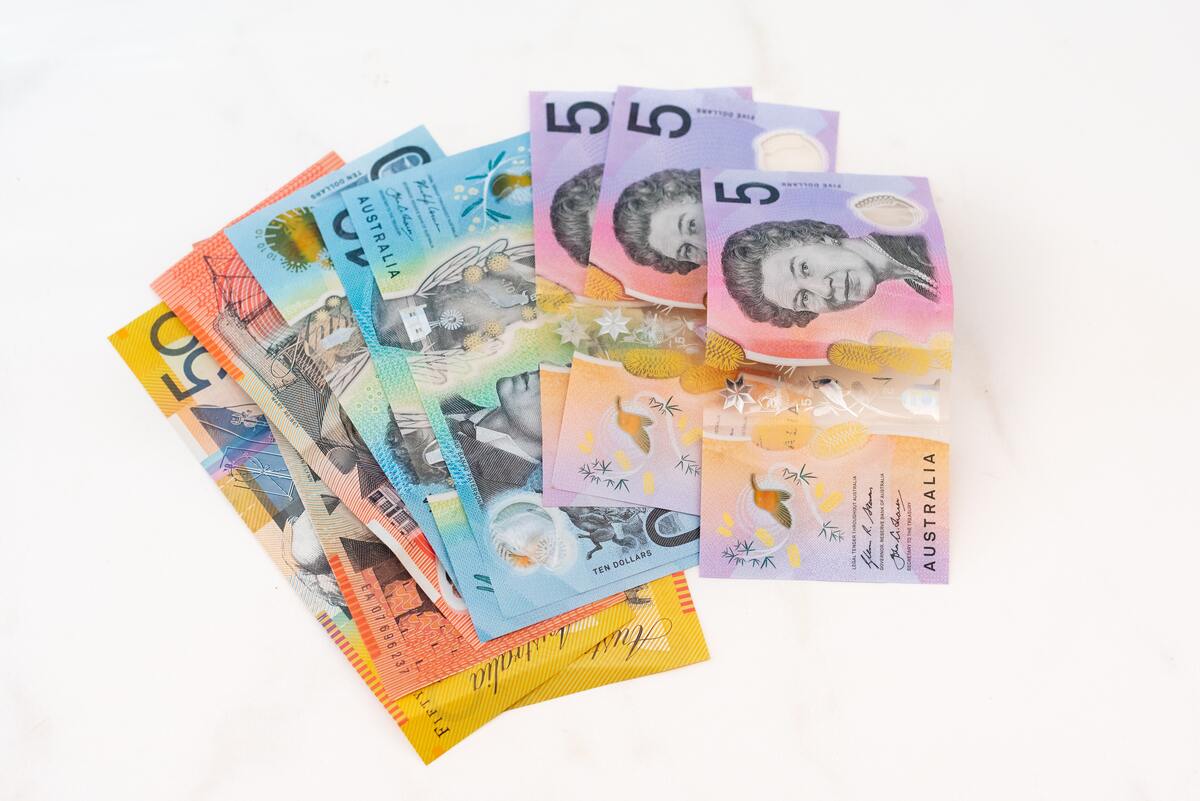
If you’re working in Australia, it’s very easy to set up a bank account. All of the major banking corporations – Commonwealth, Westpac, NAB, ANZ – have basic savings accounts that are very convenient and easy to use for those who are on a working holiday visa in Australia.
If you had a job while backpacking Australia, definitely make sure to do your taxes at the end of the fiscal year! Backpackers are usually entitled to a huge tax return (for reasons that are hard to explain) and it would be a real shame to walk away from a big payday.
For all matters of finance and accounting on the road, The Broke Backpacker strongly recommends Wise – The Artist Formerly Known as Transferwise! Our favourite online platform for holding funds, transferring money, and even paying for goods, Wise is a 100% FREE platform with considerably lower fees than Paypal or traditional banks.
But the real question is… is it better than Western Union? Yes, it most certainly is.
Travel Tips – Australia on a Budget
Australia is a country that can really eat into your wallet if you’re not careful, so make sure to follow these travel tips to save money and have even more fun.
- Camp : With plenty of gorgeous spots, Australia is a great place to have the right camping gear . You can also ask to pitch a tent in people’s yards. If you’re feeling really adventurous and want to save some cash, consider picking up a backpacking hammock.
- Cook your own food: If you are on a tight budget, you can save money by cooking your own food. I recommend bringing a portable backpacking stove .
- Book your transportation early: Both plane and train tickets are much cheaper if you purchase them in advance. This rule does not apply to buses, which you can often book within the day or even an hour.
- Couchsurf: Australians are awesome, but always check the reviews anyhow. Couchsurfing to make some real friendships and see this country from the perspective of locals. You can even ask (new) friends, or even friends of friends. This paid off for me plenty.
- Pack a travel water bottle : Save money – and the planet – every day!

Why You Should Travel to Australia with a Water Bottle
Plastic is a problem. It washes up on Australia’s most pristine beaches and wraps itself around its fragile ecosystems.
You aren’t going to save the world overnight, but you can be part of the solution and not the problem. Being a responsible traveller is getting easier and easier with the support of our incredible network of inspiring individuals and other backpackers.
Plus, buying overpriced bottles of water from supermarkets isn’t fun either. Travel with a filtered water bottle instead, save money and potentially another lovely, little dolphin’s life.

Drink water from ANYWHERE. The Grayl Geopress is the worlds leading filtered water bottle protecting you from all manner of waterborne nasties.
Single-use plastic bottles are a MASSIVE threat to marine life. Be a part of the solution and travel with a filter water bottle. Save money and the environment!
We’ve tested the Geopress rigorously from the icy heights of Pakistan to the tropical jungles of Bali, and can confirm: it’s the best water bottle you’ll ever buy!
Australia has two distinct climate zones: a tropical one in the north and a more temperate one in the south. There are several microclimates found in each of these zones but, broadly speaking, they are still subject to the same sort of seasons.
Note that Australia is in the southern hemisphere. Australian summer ist from December-February and its winters are from June-August .
The south of Australia – New South Wales, Victoria, South Australia, Tasmania, and (south) Western Australia – has a more temperate climate and usually has four seasons. In some places, like Perth and Sydney, these seasons can appear very similar to one another as the weather is pleasant year-round.
In other areas, like Melbourne or Tasmania, the weather is more unpredictable and even harsh at times, especially in the mountains. Melbourne famously gets “four seasons in one day.”
The north of Australia, including northern Queensland, Australia’s Northern Territory, and (north) Western Australia tropical and only has two distinct seasons: hot, wet summer and cool, dry winter.
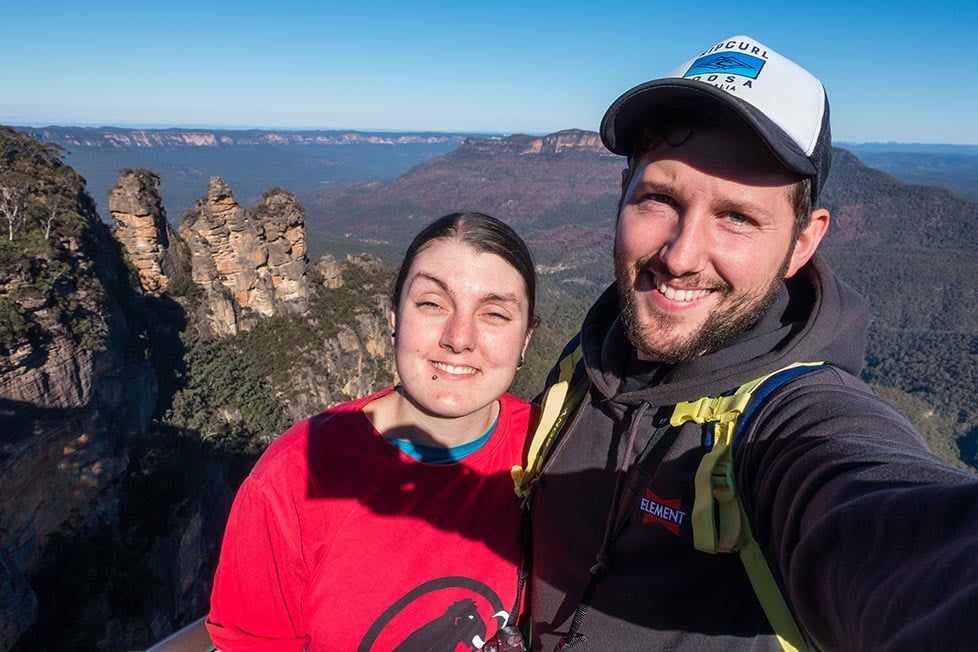
Australian summers – referred to as the big wet – can be oppressively hot and some places receive biblical amounts of rainfall. The deadly box jellyfish also comes closer ashore in the summer resulting in near-complete beach closures.
Summer really isn’t a good time to visit the northern Australia. It’s much better to visit in the winter – referred to as the big dry – when it’s slightly cooler, drier, and devoid of deadly jellies.
Since the north is almost always visited in the winter, demand is very high during this time. Prices will be much higher because of the short supply so be sure to keep this in mind while planning your itinerary.
What to Pack for Australia
If you’re not careful, Australia’s wilderness will smack ya to next Monday. Get your packing for Australia right! On every adventure, there are six things I never go traveling without:

Snoring dorm-mates can ruin your nights rest and seriously damage the hostel experience. This is why I always travel with a pack of decent ear plugs.

Hanging Laundry Bag
Trust us, this is an absolute game changer. Super compact, a hanging mesh laundry bag stops your dirty clothes from stinking, you don’t know how much you need one of these… so just get it, thank us later.

Sea To Summit Micro Towel
Hostel towels are scummy and take forever to dry. Microfibre towels dry quickly, are compact, lightweight, and can be used as a blanket or yoga mat if need be.

Monopoly Deal
Forget about Poker! Monopoly Deal is the single best travel card game that we have ever played. Works with 2-5 players and guarantees happy days.

Grayl Geopress Water Bottle
Always travel with a water bottle! They save you money and reduce your plastic footprint on our planet. The Grayl Geopress acts as a purifier AND temperature regulator. Boom!
Australia has a reputation for being full of deadly creatures that are out to get you at every turn: killer snakes, spiders, crocodiles, jellyfish, hell even kangaroos. It’s important to remember though that death at the hands of these animals is very sensationalized. Statistics don’t back up the hysteria.
Believe it or not, the common bee and wasp, not spiders, are actually the number one killers in Australia. The truth is: Australia and its wildlife aren’t nearly as terrifying as you think.
That being said, it is extremely important to take all cautionary advice with the utmost seriousness. If a sign or a local says that an area is dangerous, either because of sharks or crocs or whatever, then, for fuck’s sake, listen to them!
Australians have become day-to-day experts on what can kill you and how to avoid it. At the end of the day, just follow this easy advice: if you don’t see Australians doing it, then don’t do it.
The elements really are your biggest concern while backpacking in Australia. Not to scare you, but drowning is a risk in Australia as ocean currents are very strong.
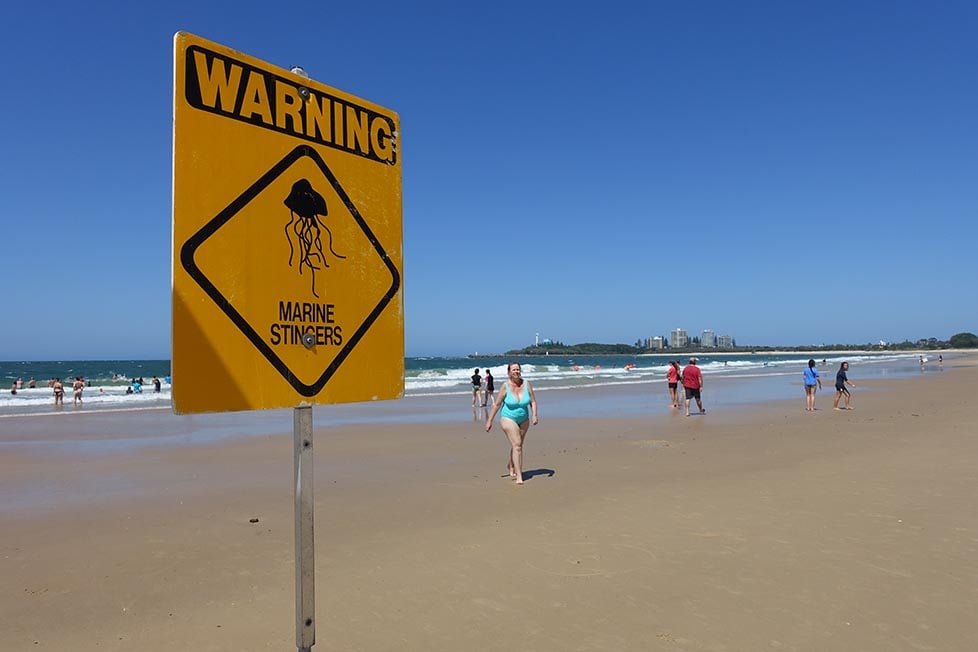
The water may seem calm but, get caught in a wild rip, and you can quickly get submerged or pushed out to sea. Swim in designated areas and check signs for ocean conditions.
As mentioned before, heat is a major problem in Australia. Temperatures can soar to unthinkable heights and atmospheric radiation is a serious threat here. Forest fires caused by dry conditions are a serious problem as well.
Sex, Drugs, and Rock ‘n’ Roll in Australia
Australians LOVE to party. At least once, we’ve seen a group of Australians getting blindly drunk and looking to score.
Some observers may have even thought to themselves: “how the hell are they still doing this?” or “for what possible reason would you do that?” Well, there is one, I assure you.
Drugs and alcohol in Australia are astronomically expensive. On average, a pint of beer is $7-$8 and a spirit is a couple of bucks more maybe. Cigarettes cost somewhere in the late teens; and don’t even get me started on the drugs.
These ridiculous prices are why you see Australians partying all the time outside of their country: everything is just so much cheaper abroad and so they go crazy.
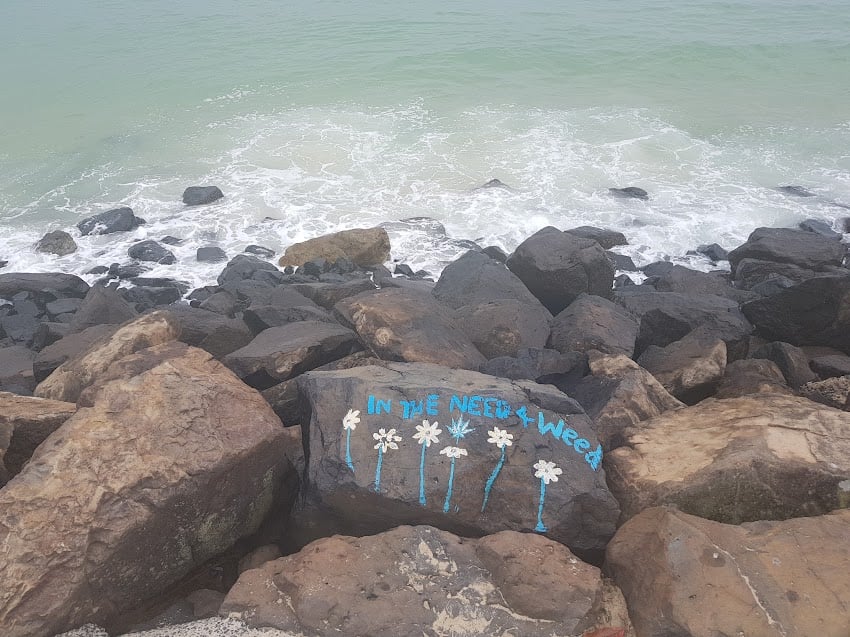
Prices are damned though, Australians still like to have a good time in their native land. Many go out in groups and buy rounds or shouts for one another.
If you plan on drinking with the locals while backpacking Australia, it’s very important to keep up with the shouts. Drinking a beer that someone has bought for you and not contributing to the shout is a dick move.
Be careful when drinking and driving as well. Australia has a zero-tolerance policy when it comes to drunk driving and any BAC over 0.05% will be met with harsh punishment. Random checkpoints are commonly set up at all times of the day to pull over drivers and check their sobriety.
Getting Insured BEFORE Visiting Australia
Traveling without insurance is never a good idea. It’s extremely risky. Check out good backpacker insurance sorted before you head off on an adventure.
ALWAYS sort out your backpacker insurance before your trip. There’s plenty to choose from in that department, but a good place to start is Safety Wing .
They offer month-to-month payments, no lock-in contracts, and require absolutely no itineraries: that’s the exact kind of insurance long-term travellers and digital nomads need.

SafetyWing is cheap, easy, and admin-free: just sign up lickety-split so you can get back to it!
Click the button below to learn more about SafetyWing’s setup or read our insider review for the full tasty scoop.
Getting into and around Australia can be a long and arduous affair. It is a good opportunity to make the most of a layover – many of them being in the Middle East or Asia.
Traveling to Australia from the USA is a 13-hour plane ride and it seems that every Australian city is at least 8 hours drive away from each other; Perth to Adelaide is a 1.5-day journey by car. Should you decide to travel to Australia, you’ll be staring at the back of the seat or an empty road for a while. But the moments in between make the whole trip worthwhile.
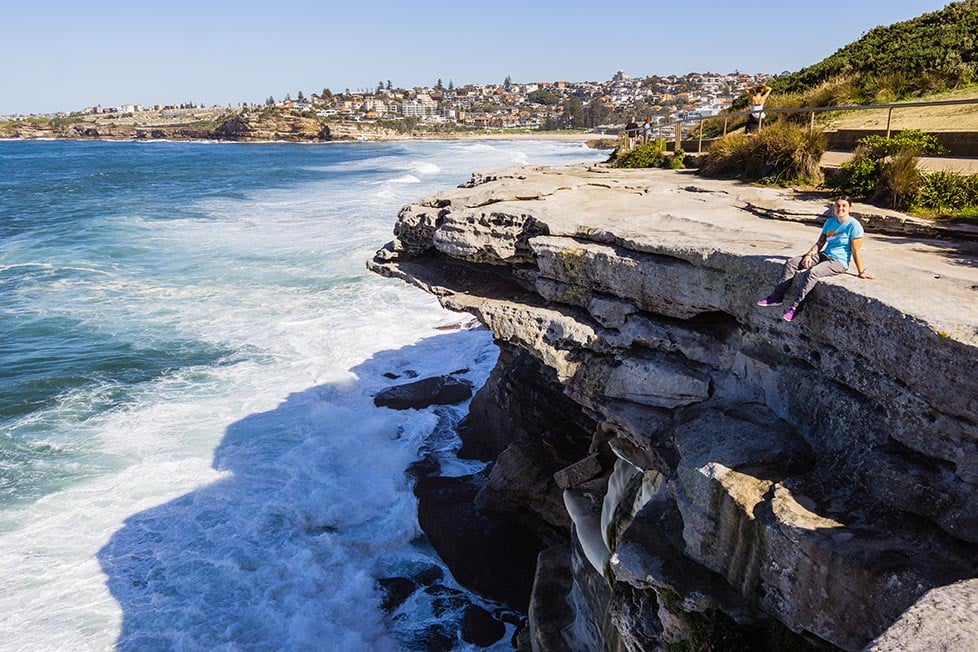
Entry Requirements for Australia
There are several different types of tourist visas available to those who wish to go backpacking in Australia. The three primary tourist visa types are:
- Visitor visa (subclass 600)
- Electronic Travel Authority Visa (ETA) (subclass 601)
- eVisitor (subclass 651)
The 601 and 651 visas essentially function in the same way albeit with different application processes. The 600 is for those who want to stay in Australia for longer than 3 months at a time and for those who don’t qualify for either a 601 or 651. The grand majority of nationalities can apply for all of these visas online.
The ETA (601) and eVisitors (651) are the simplest and easiest visas to acquire. Both enable unlimited entries into Australia within the span of a year – the duration of stay cannot exceed 3 months at a time.
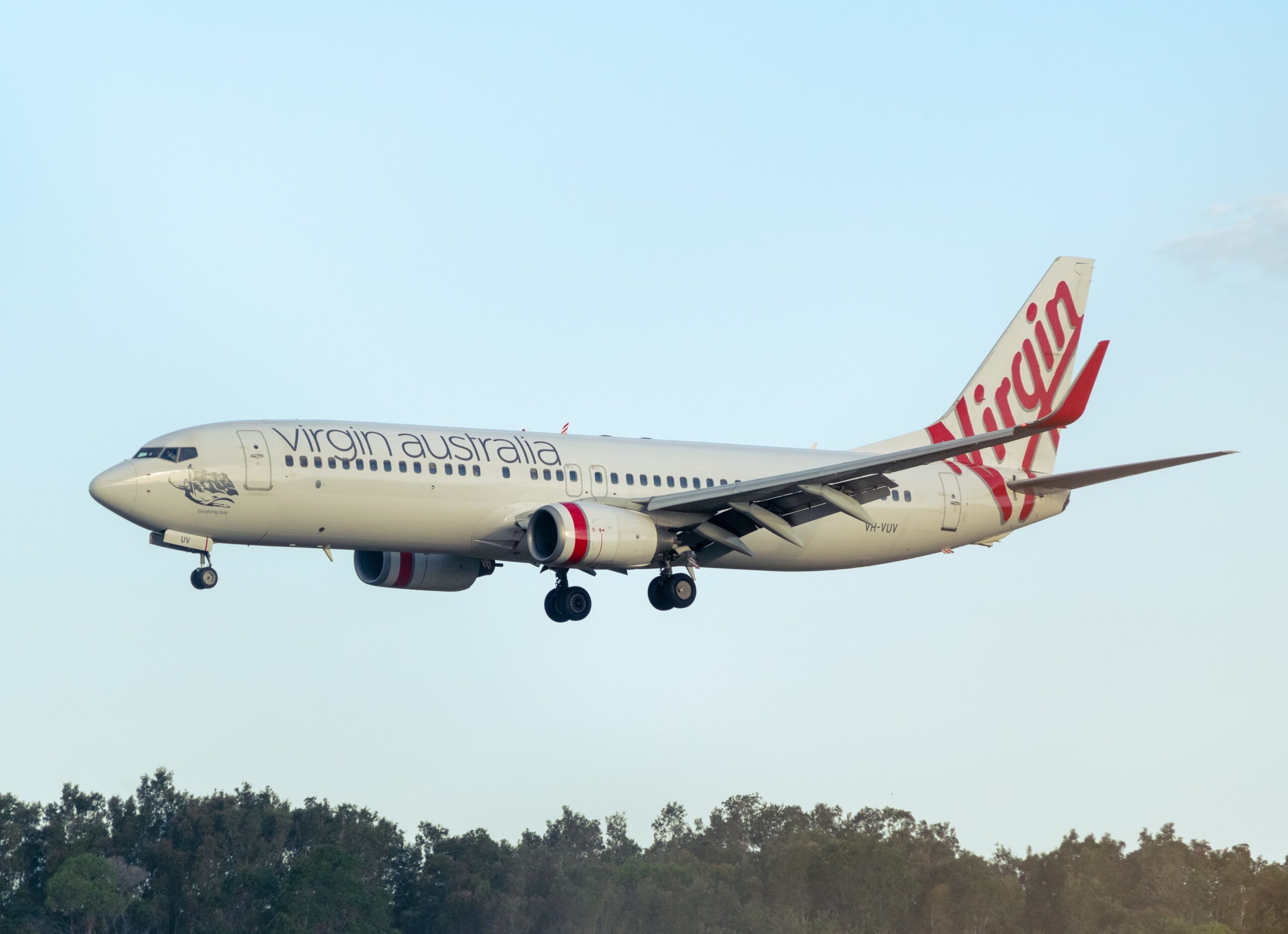
The biggest difference between these two types of visas is that they are only available to specific countries. Americans and Canadians, in addition to several other nations, must apply for an ETA. British, as well as most European citizens, must apply for an eVisitors visa.
The Visitor visa (600) is the most expensive of Australian visas but can grant the most time. Applicants can apply for a 3, 6, or 12-month duration at rates that vary from AUD140 to AUD1020. For any nation that doesn’t qualify for a 601 or 651, the 600 visa is the only means of entering Australia.
If you’re thinking of doing a working holiday in Australia , you’ll need to apply for a 462 or subclass 417 visa.
Upon arriving at customs, your visa will be checked and you’ll be subject to search. Australian customs takes declared items very seriously – so you must do so. Also, note that criminal offenses and felonies may bar you from entering the country.

Get 15% OFF when you book through our link — and support the site you love so dearly 😉
Booking.com is quickly becoming our go-to for accommodation. From cheap hostels to stylish homestays and nice hotels, they’ve got it all!
There are two ways of traveling in Australia and both offer widely different experiences. The first is by public transport i.e buses, trains, and planes and the other is with your own vehicle in the form of a rental car or campervan. The latter option is the vastly superior method.
Using public transport to travel outside and in between the major cities can be a tedious affair. Traveling by bus can be convenient and cheap so long as you’re staying on the East Coast where there are frequent stops.
Bus travel in the bush, which pretty much includes all of South Australia, Australia’s Northern Territory, and Western Australia, can be long and, in turn, pricey.
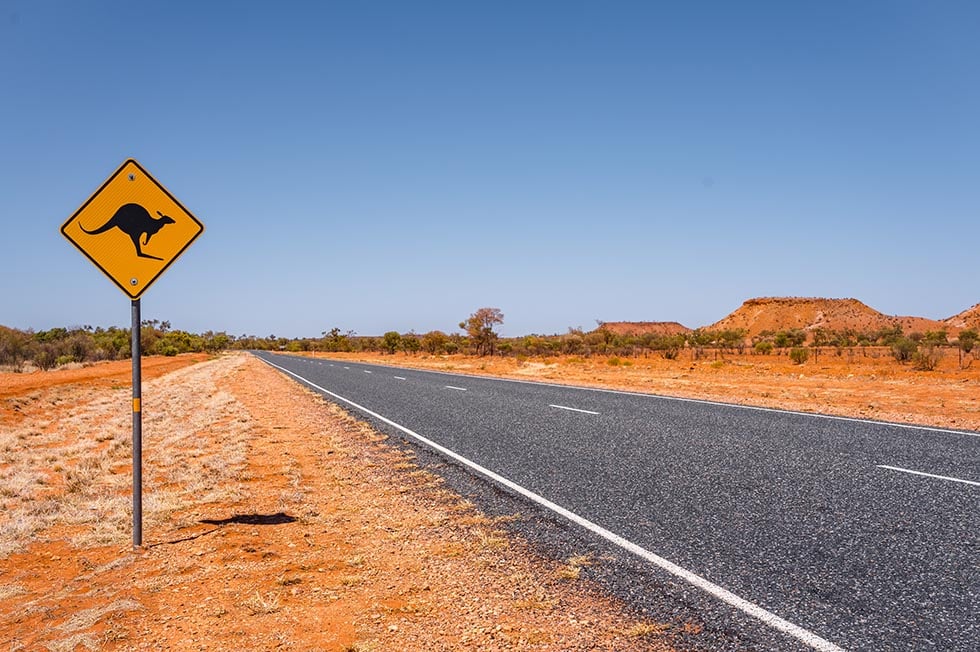
Greyhound does offer hop-on-hop-off travel passes that can certainly be convenient. Check the rates at the official website and weigh the pros and cons of purchasing a pass.
Train travel is possible but this is a more luxurious form of travel i.e. more expensive. Taking the train in Australia is an experience in itself though and some long-distance routes, like the Ghan Train , can be very rewarding.
Flying is the primary means of getting around Australia due in part to the country’s size. Flights are relatively cheap and actually quite convenient.
Traveling by hitchhiking is a common practice in Australia. Make sure to follow the usual rules of the trade though and, as always, use common sense. Be wary of hitchhiking in the Outback – cars may be far and few in between and you could be in real trouble if you’re stuck out there in the baking sun.
Traveling by Campervan in Australia
By far the best way to get around Australia is by having your own vehicle. There are many car rental companies in Australia that offer long-term contracts. Each has a wide variety of vehicle types from sedans to 4x4s to campervans.
Campervans are definitely the most popular way of getting around Australia as they provide both transport and lodging at the same time. Living out of a campervan can be convenient, fun, and cheaper than conventional travel. By having the ability to sleep anywhere you want, you’ll save money and get more out of your Australian adventure.
Thanks to the plethora of rental companies available, it’s a breeze to hire a campervan while backpacking Australia. Most offer good rates, especially for longer periods of time.
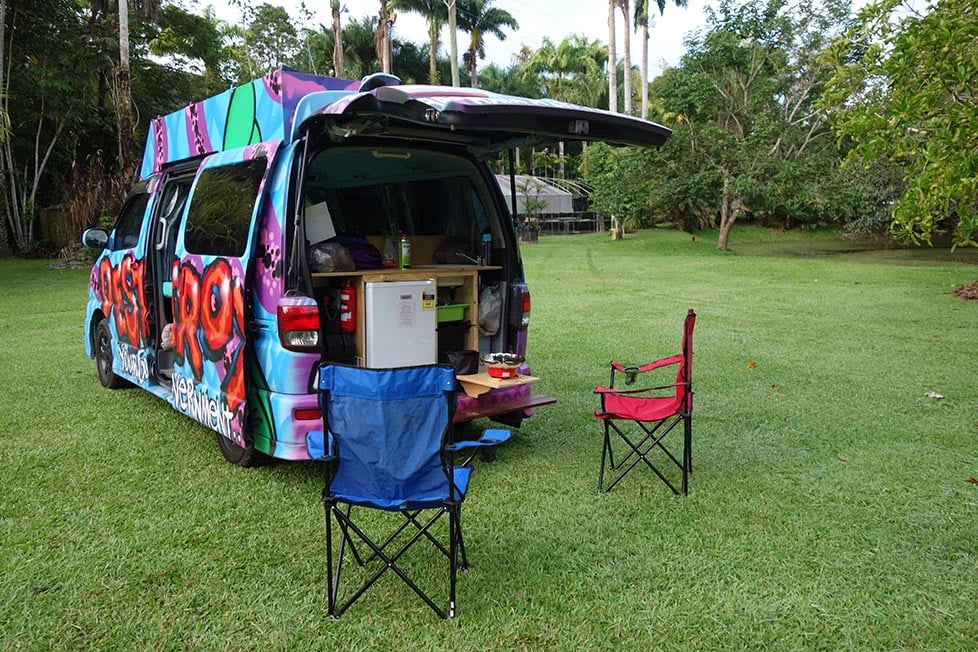
I recommend going with JUCY Campers if you plan on renting a campervan in Australia. Make sure to check the contract though – many rental companies impose certain restrictions on going offroading and over a certain amount of miles per day and charge extra fees for not following these parameters.
If you plan on staying in Australia for a long time (more than 6 months) try buying your own campervan. Doing this will allow you more flexibility and, if you took care of the car, the chance to sell it when you’re done. You can find ads for used campers in many hostels and on online boards like gumtree.com.au.
When buying a camper, be sure to take the vehicle to the shop to get it checked before actually committing. Most auto shops are used to this kind of request and will charge a competitive fee.
Onwards Travel from Australia
Being the world’s largest island and a continent that consists of a single nation, there are not too many ways to get out of the country by land or sea. Luckily, Australia benefits from some very, very cheap international airline routes.
You can continue your backpacking journey in Oceania , but the cheapest and most convenient flights out of Australia are usually bound for Asian destinations. Budget Asian airlines, like AirAsia, in addition to Australia’s own budget airlines – Jetstar and Tiger – make traveling to Asia a breeze.
From any of the major Australian cities, and for as low as $100 sometimes, you can carry on your backpacking adventure in the likes of Indonesia, Japan, India, the Philippines, and even Pakistan! Seriously, you can get just about anywhere in Asia from Australia and for a great price.
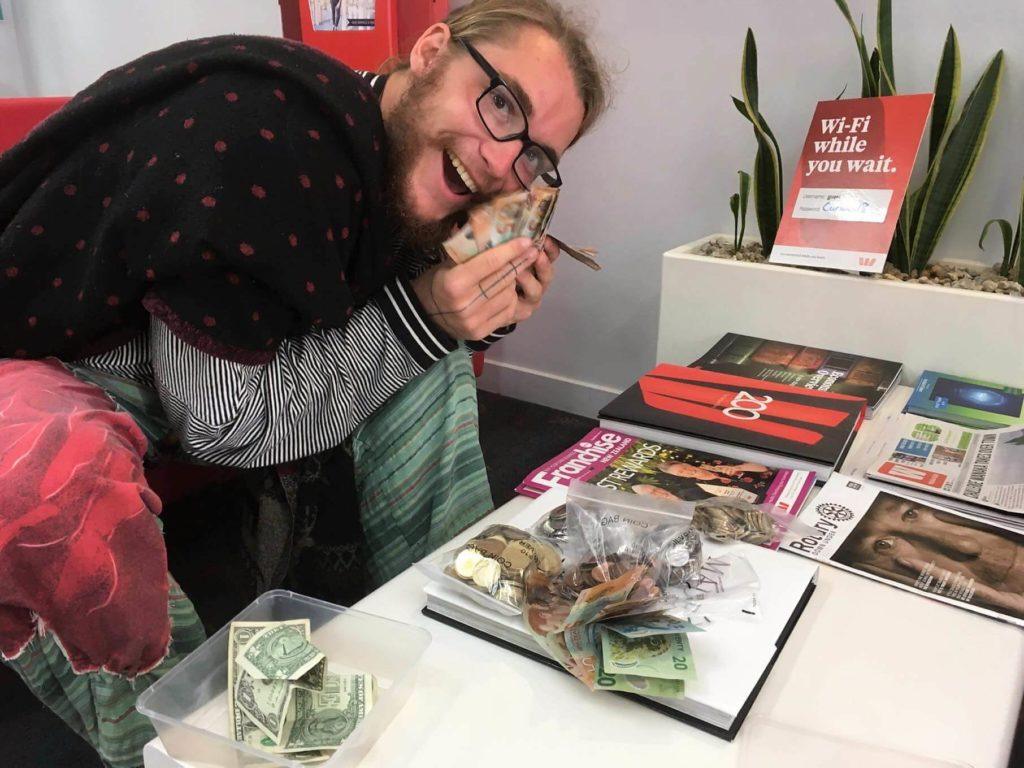
Since AirAsia is so ridiculously cheap and popular, you’ll most likely end up connecting in its place of origin: Kuala Lumpur, Malaysia. Malaysia is a pretty cool spot and backpacking around the peninsula or on the island of Borneo is definitely worth trying.
Otherwise, you can get just about anywhere from Kuala Lumpur. If you aren’t connecting in KL, then you’ll most likely end up in Bangkok, Thailand, which certainly has its own reputation.
Asia aside, you can, of course, head across the Tasman to start backpacking in New Zealand . Backpacking around New Zealand is a very similar experience to Australia in that you’ll be paying the same prices and most likely living out of a campervan. Unlike Australia though, New Zealand has a wildly diverse geography and is much more temperate, both in terms of climate and native personality.
If you really want to go somewhere different, why not consider the Soloman Islands ?!
As a popular gap year destination , most backpackers need to earn a bit of money to continue their travels. They usually end up with fruit-picking jobs in Australia.
The work can be hard and life can be boring at times but the cost of living is quite low and those with a 417 visa will earn an extra year on their visa. If you can manage it, this is one of the best ways to have a working holiday in Australia!
Backpackers are so established in the fruit-picking industry and businessmen are in turn so reliant upon them that it’s usually very easy to find a job. There are dozens of online boards with postings for farm jobs in Australia. Some popular websites are:
- Gumtree.com.au
- Backpackerjobboard.com.au
- Taw.com.au .
When you arrive at your farm stay, you’ll probably be surprised. Many of these farms look like hostels complete with bunk rooms, communal areas, and recreations.
You’ll have to pay for a bed but the prices are very cheap. Sometimes you may have to sleep off-premises, in which case a car really comes in handy; otherwise, there’s always the bus.
You can make a decent living working on a farm. Most clear $600/week on average but a hard worker can definitely make more. Make no mistake though: this is difficult work.
Farming in Australia isn’t pretty but it can certainly be rewarding. You’ll become quite close to both the land and your fellow working backpackers.
Farm work isn’t the only means of making money in Australia. Some of the best jobs for a working visa in Australia include serving, nannying, cooking, and cleaning. If you’re really lucky, you may even find a job in mining. If you decide to work in the city, know that the costs of living will be much higher.

A new country, a new contract, a new piece of plastic – booooring. Instead, buy an eSIM!
An eSIM works just like an app: you buy it, you download it, and BOOM! You’re connected the minute you land. It’s that easy.
Is your phone eSIM ready? Read about how e-Sims work or click below to see one of the top eSIM providers on the market and ditch the plastic .
Working Holiday Visas in Australia
Several nationalities have the option of applying for an Australian working holiday visa, which authorizes travelers to work legally in the country. This visa is an amazing opportunity for anyone who wants to stay and go backpacking in Australia for a longer term.
There are two types of working holiday visas in Australia:
- A Working Holiday visa (subclass 417)
- A Work and Holiday visa (subclass 462)
(If you’re thinking to yourself how stupidly similar these visa titles are, I’m right there with ya.)
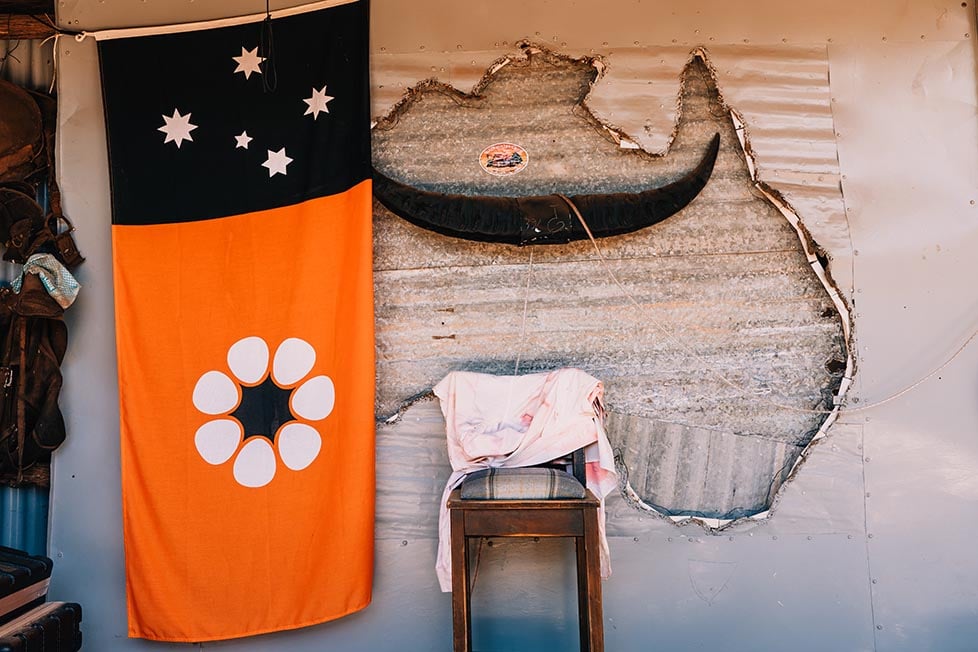
Both visas entitle visitors to the ability to work in Australia for a period of 12 months. Note that the possessor of a 417 or 462 can only hold a single job for a period of 6 months. Certain countries can only apply for a 417 or 462 i.e. the British can qualify for a 417 but Americans must apply for a 462.
To apply for either visa, applicants will need to show that they have at least AUD 5,000 in their bank account. Both visas will also require a bill of clean health and a clean criminal record.
Applicants for a 462 visa will need to provide some key additional details. With the exception of the United States, those applying for a 462 must provide a letter of support from their government.
462 applicants will also have to pass a character test in which they’ll need to prove that they’re of good moral quality. Usually, a certificate of excellence, like a diploma or special certification, will suffice for this.
The most important difference between a 417 and 462 is that possessors of the former can apply for a second year visa given they’ve met some criteria. Unfortunately, American citizens and other 462 applicants can only have a working holiday in Australia for up to a year.
If you’re finding all of this a bit complicated, Global Work and Travel can alleviate some of the visa complications for you. They offer working holidays and internship opportunities in many locations throughout Australia, both of which require the working holiday VISA.
In fact, they’ll support you throughout the entire process; from VISA guidance to finding you the perfect placement. You’ve got to be between the ages of 18 to 35 (30 for some countries) though… Apologies if this isn’t you!
Volunteering in Australia

Australia is volunteering gold – there are lots of different volunteer projects you can join whether it be teaching, animal care, agriculture, hospitality, tourism, or pretty much anything!
For finding gigs, you have several options:
- Workaway is crazy popular!
- Or WWOOF Australia is perfect for anyone interested in working on the land. Organic farms and permaculture are their wheelhouse!
- Most alternative sites to Workaway have oodles of options.
And of those alternatives, I have one favorite at The Broke Backpacker: Worldpackers!
Worldpackers like to put focus on community. They connect you with meaningful volunteering opportunities that really help you feel like you’re contributing to local communities. PLUS their platform comes loaded with nifty features for connecting volunteers too!
And for an extra saucy bonus on top, Broke Backpacker readers get a special discount of $10 – 20% of the annual signup fee!
Just use the discount code BROKEBACKPACKER at checkout or follow the button below and your membership is discounted from $49 a year to only $39. Make Down Under your stomping ground. 😉
Australians are some of the most welcoming, exciting, and unabashed people that I’ve ever met. They have so few worries and give so little fucks that life just seems easier in their presence.
Even immediate dangers, like an impending tidal wave or the jaws of a killer croc, are made insignificant by an Australian’s devil-may-care attitude. 100%, these are some of the coolest people that I’ve come across in my travels.
It can be argued that the Australian attitude derives from their inhospitable environment. An Australian is threatened on a near day-to-day basis either from deadly creatures, ridiculous climate patterns, or people that constantly need to remind them of these last two points. After a while, danger itself just becomes commonplace and desensitizing.
The fact that Australia is so geographically remote as well means that hardly any international presence notices – or really holds – Australia accountable. Combine this with the Australian’s grit and you have a population that just does whatever makes them feel good.
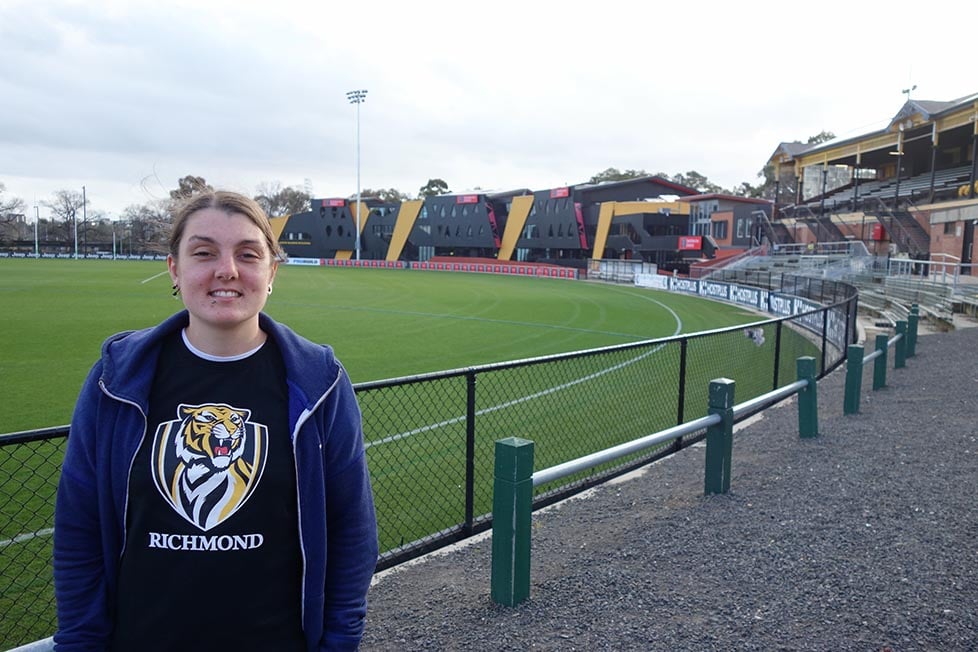
To be fair, Australians who live in their home country are a little different from the ones that you see traveling so much . Rooted Australians are still hard workers and seemingly proficient at any trade involving blue-collar work. The country didn’t become so prosperous because they constantly didn’t give a shit.
We mustn’t forget either that Australia is inhabited by more than just white people and immigrants. Aboriginal people, the original Australians, are also present in modern Australian society, though to a smaller degree.
Odds are you won’t encounter many Aboriginal folks while backpacking through Australia; if you do though, just be respectful, open, and treat them the same as any other Ozzie.
Useful Travel Phrases for Australia: “That’s Not a Knife” Edition
The Australian accent is infamous and has been the subject of a million pop culture references. When asked to impersonate an Australian accent, most foreigners emulate caricatures like Crocodile Dundee or Steve Irwin.
Hate to break it to you, but the way in which many of these icons speak is either over-exaggerated or very demographically specific. Not every Australian yells “G’DAY MATE!” or puts so much twang into their voice when saying things like “like” or “right” or “fight.” These are cultural stereotypes and pretty unfair.
Australians use a lot of slang; so much so that sometimes it can be hard to understand them. You’ll catch on to the colloquialisms fairly quickly but, for a little extra help, I’ve included a list of some popular Australian slang.
- Ta – thank you
- Arvo – afternoon
- Bottle-O – liquor store
- Mozzie – mosquito
- Thong – flip-flops (yep, not the G-string)
- Ute – pickup truck
- Bathers – swimsuit
- Sheila – woman
- Chunder – vomit
- She’ll be right – everything will be fine
- Stubby – can of beer
- How ya goin? – a friendly greeting
What to Eat in Australia
Australian cuisine is heavily influenced by its colonial roots. English, Italian, Asian, and Greek styles are all present in modern-day Australian cooking to varying degrees.
Being a colony of the British Empire, Australian cuisine resembles most that of the English variety. Many staples like fish ‘n’ chips and meat pies are present in both. When dining out in Australia, expect a similar experience as if you were dining out in the UK. Australian food will be hearty, heavy comfort food.
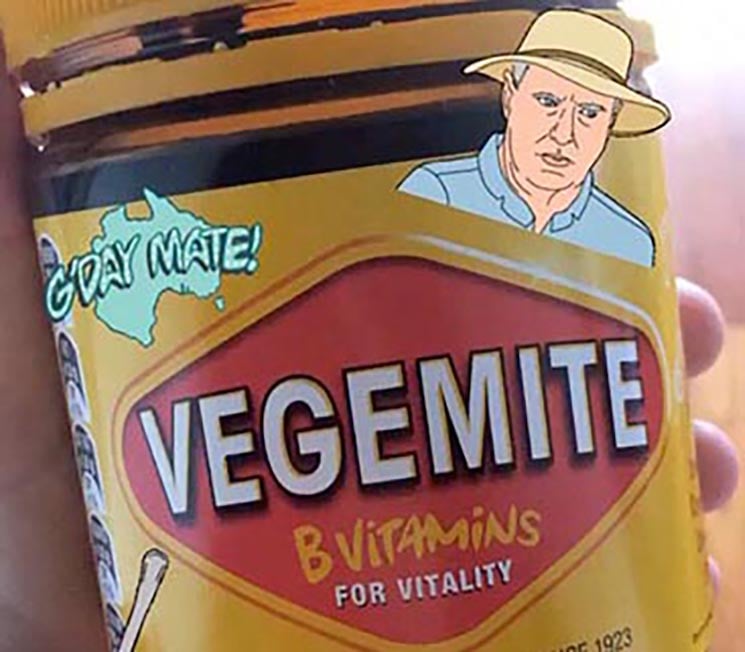
Being a nation of immigrants though, there is plenty more than the usual English fair. Asian cuisines of every shade are present in Australia and are actually some of the best outside of the Asian continent.
Several Mediterranean cultures call Australia home as well and have brought their cuisines with them. Thank the Italians for introducing a strong cafe culture in Australia – coffee in Australia is surprisingly delicious and taken seriously.
Barbecuing is a very important custom in Australia and is perhaps the highlight of the nation’s culinary scene. Aside from the usual BBQ meats, Australians also enjoy the various grilled game.
Kangaroo is healthy and cheap. Other more exotic meats like emu, alligator, and even grubs are available in speciality markets.
Must-Try Dishes in Australia
Below is a list of Australia’s most popular dishes.
- Meat Pie – Pastry, meat… self explanatory
- Chicken Schnitzel – The German fave
- Kangaroo – the dead, cute, bouncy guys
- Vegemite – a rite of passage – no spoilers
- Pavlova – the dessert that hits after a BBQ
- Anzac Biscuits – a little cookie treat for you sweeties
- Lamingtons – the cake you don’t need, but want
- Tim Tams – the old Ozzie classic
- Barramundi – your new fave fish dish
- Emu – big bird, long neck… you know the guy
A Brief History of Australia
Aboriginal Australians arrived on Australia’s mainland between 40,000 and 70,000 years ago. Their traditions relating to music, art, and spirituality are among the longest surviving in human history. Before the arrival of the British, the number of Aboriginal people living in Australia was between 300,000 and 1 million.
In 1770, Lieutenant James Cook claimed the land for Great Britain, after the Dutch first sighted Australia in 1606. In 1788, a fleet of 11 boats arrived in Botany Bay to establish New South Wales as a Penal Colony.
Furthermore, convicts were sent to all states, but South Australia became a free colony in 1836. More than 162,000 convicts were transported to Australia from Great Britain.
Australia began to look like a desirable location after the discovery of gold and the kickstart of its economy. The Eureka Stockade at Ballarat, in 1854, was a rebellion against taxation. Some see this as a crucial event in the evolution of Australia’s democracy.
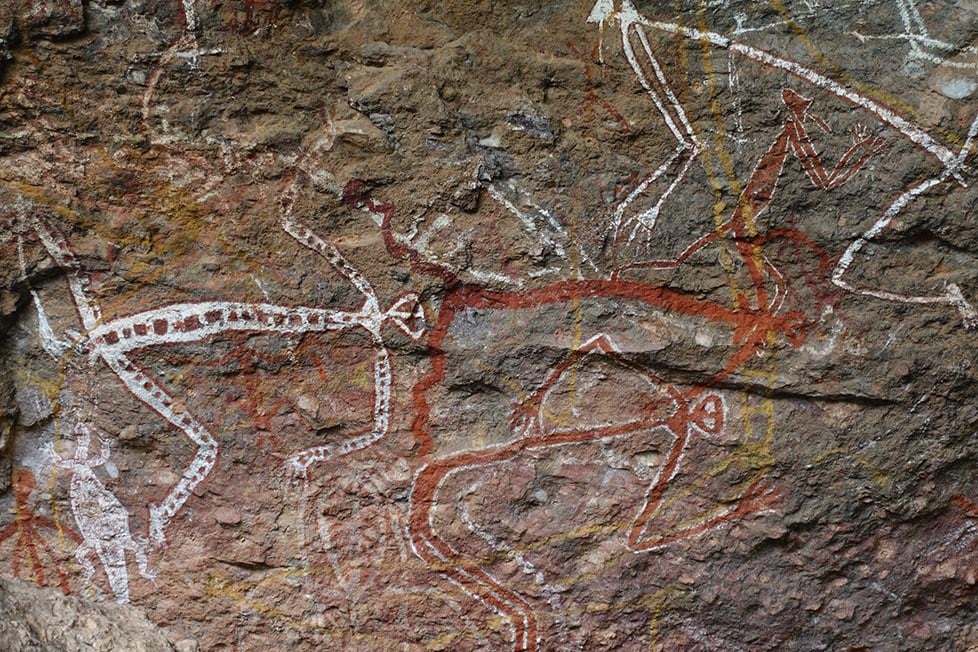
Chinese immigration began during this period with 50,000 Chinese establishing roots in Australia.
In 1901, a federation of all of the states, the Commonwealth of Australia was created. The creation of Canberra marked it as the capital city of New South Wales, with a temporary parliament in Melbourne.
The Australian and New Zealand Anzac Corps took part in the World War I Gallipoli Campaign, in 1915. April 25, ANZAC Day, was the same date as the first landing at Gallipoli. Australians remember and pay their respects to the sacrifices of their armed forces on this day.
After World War II and the Vietnam War, an influx of migrants moved to Australia. Between 1949-1974, The Snowy Mountains Scheme employed 100,000 people. 70% of these people were migrants from 30 different nations.
Today, people from all over the world call Australia home. The continent has become known for its equality and lack of clear class distinctions.

Things go wrong on the road ALL THE TIME. Be prepared for what life throws at you.
Buy an AMK Travel Medical Kit before you head out on your next adventure – don’t be daft!
No trip to Australia would be complete without taking on something new and exciting. If you’re tired of the usual tourist trail, consider checking out these unique experiences instead.
Trekking in Australia
Hiking, or bushwalking, is one of the most popular adventures in Australia! If you plan on going backpacking in Australia, you must go walking in the wilderness for a few days.
Venturing out into the bush in Australia is like taking a walk through the nation’s history. Here is a forbidding land, full of harsh landscapes and bitter elements, the likes of which tested and tortured the original settlers.
Should you decide to brave these wilds, you will gain real insight into the Australian identity. To enter the Australian backcountry you will need to be prepared.
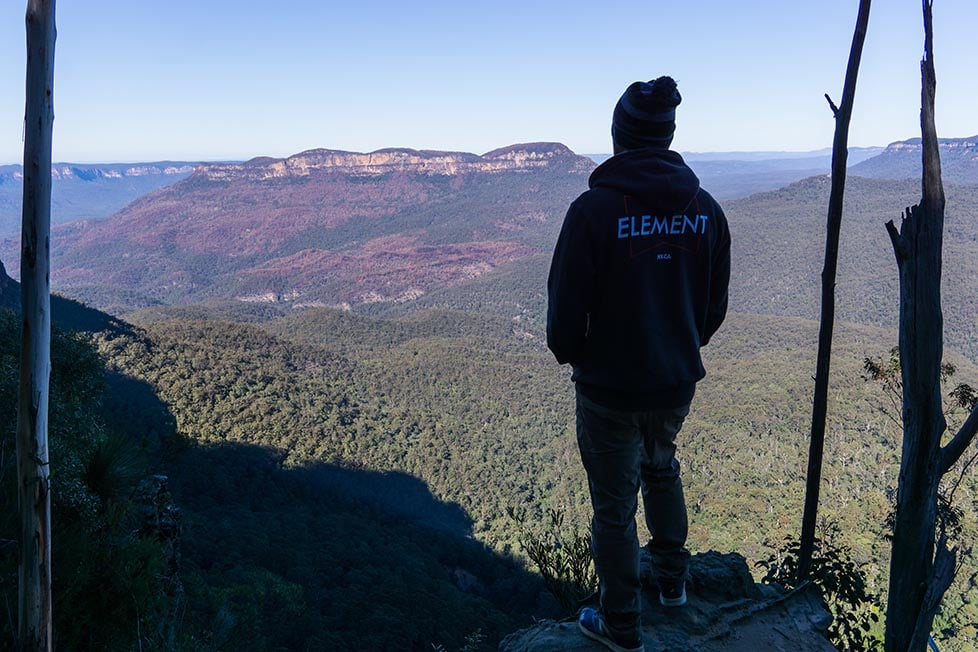
I always suggest getting a sturdy hiking backpack as well, especially so if you intend to venture deep into the wilderness. You’ll want the best you can find and not something that will eventually be held together by duct tape.
Below is a list of some of Australia’s best multi-day trails.
- Australian Alps Track (45-60 days, 406 miles) – Long and arduous hike that is only meant for the experienced or guided. Passes through the highest mountains of Australia. Requires food drops.
- Fraser Island Great Walk (5-7 days, 52 miles) – Walk across the entire length of Fraser Island, which is one of the most beautiful places in Australia.
- Larapinta Trail (16-20 days, 140 miles) – The ultimate Outback adventure! Fairly new trail and already one of the best in the country.
- Cape to Cape Track (6-8 days, 88 miles) – A stunning coastal walk that is conveniently located near Perth. Showcases some of the best scenery in the Margaret River region.
- Overland Track (5-8 days, 46 miles) – A walk through the finest mountain landscapes in Tasmania. Arguably the best trek in Australia.
Surfing in Australia
Surfing is as much a part of the Australian identity as kangaroos or shrimps on the barbie. Australia is extremely passionate when it comes to hanging ten and catching some waves.
Obviously, surfing didn’t develop in Australia by chance either; Australia has some of the finest beaches for surfing in the entire world and these attract thousands of surfers every year. You’ll have heard of the famous Byron Bay and its legendary surfing spots.
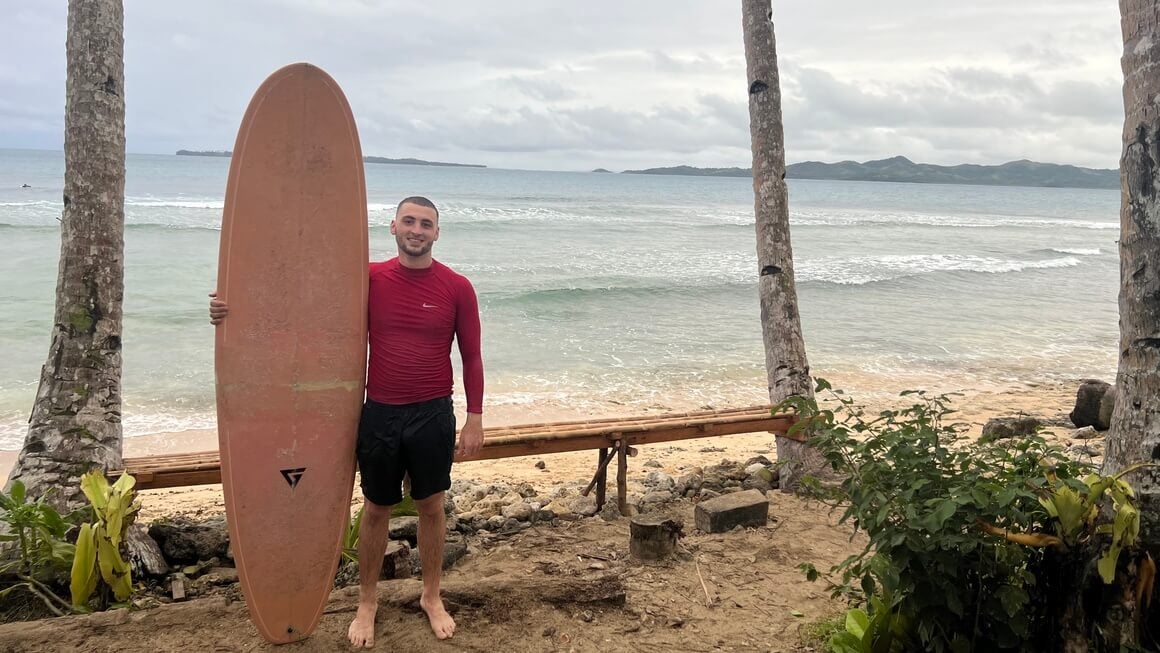
There are so many amazing surfing spots in Australia that it would seem more logical to note where you couldn’t actually surf. Everywhere you go there seems to be good breaks and swells.
Of course, you won’t be surfing in the Sydney Harbour or Melbourne Pier. But travel less than an hour and, boom, you’ll be right in the middle of some prime waves.
Below is a list of some of Australia’s top surfing locations. There’s a pretty diverse selection from all over the country. Though the Northern Territory is lacking in this regard.
Diving in Australia
Though the Great Barrier Reef on the East Coast receives the lion’s share of attention, there are plenty more options to go diving in Australia! Sprinkled throughout the Australian coastline are many gorgeous reefs, sunken ships, and sea caves that are just waiting to be explored.
These destinations definitely get far fewer tourists than the Great Barrier Reef and far more diving enthusiasts. You could even charter your own yacht and go snorkeling in several places along the East Coast if you’re more into snorkelling than diving.
If you’re really into diving, then definitely check out any one of these spots (that aren’t the Great Barrier)!
Backpacking the Outback
The Outback . The Bush. The Fuck-all Middle of Straya. The reason why most who want to go backpacking in Australia visit in the first place. Many have little clue though as to how large and how imposing this region actually is.
Few actually comprehend the Outback’s size or its conditions. That scene in the Inbetweeners Movie where Jay pisses on Simon’s face to survive springs to mind.
Though the exact number isn’t agreed upon, the Outback constitutes at least 70% of Australia’s landmass and is around 2-3 million square miles. The whole of India is 1.5 million square miles – that’s a lot of fuck-all!
Water is extremely sparse in the Outback. Temperatures vary widely depending on the season and time of year, from sub-zero to over 110 Fahrenheit. People die out here from exposure all the time. If you plan to venture out into the desert, you must be prepared.
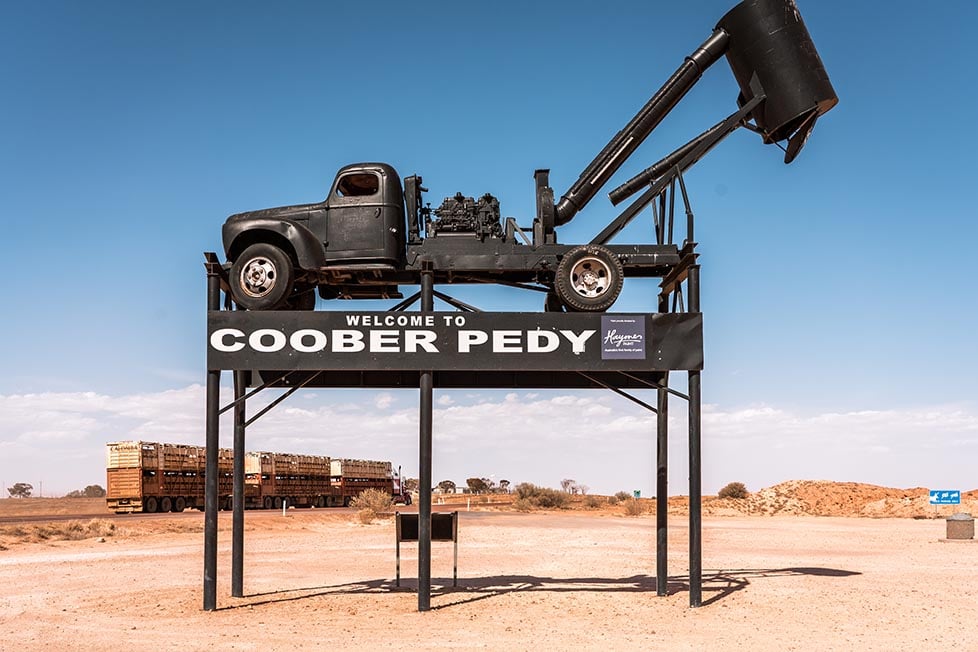
The Outback isn’t a singular destination that you just include in an itinerary – it’s a collection of several desert regions that form an unfathomably large ecosystem. You can visit parts of the Outback but there’s no way that you could visit the whole thing; there are huge swathes of the Outback that haven’t even been charted yet.
A few of the Outback’s top destinations have already been covered in this guide, like Alice Springs, the Kimberly, and the Nullarbor Plain. The last remaining portions of the Outback are relatively accessible. These places are, of course, minuscule in the grand scheme of things.
Join an Organized Tour in Australia
For most countries, when you visit Australia, solo travel is the name of the game. That said, if you are short on time, energy, or just want to be part of an awesome group of travelers, you can opt to join an organized tour.
Joining a tour is a great way to see the majority of the country quickly and without the effort that goes into planning a backpacking trip. However—not all tour operators are created equal—that is for sure.
G Adventures is a solid down-to-earth tour company catering to backpackers just like you, and their prices and itineraries reflect the interests of the backpacker crowd. You can score some pretty sweet deals on epic trips in Australia for a fraction of the price of what other tour operators charge.
Here are what people usually ask me about backpacking in Australia…
How much money do you need to go backpacking in Australia?
This is largely dependent on where in Australia you go, and for how long. But to be comfortable, I would try to budget for at least $60 USD per day.
Where should I start backpacking in Australia?
Most flights tend to fly into Sydney or Melbourne and both would make a great starting point.
What visa do I need to backpack Australia?
Most tourists who are visiting for less than 3 months will need an Electronic Travel Authority (subclass 601) or tourist visa.
Is Australia good for backpacking?
Absolutely! It’s one of the most popular backpacking routes in the world and it won’t disappoint.
I bloody love Australians, dude. Who else is happily willing to drink a beer from their sweaty shoe, just for a laugh? What a sick nation of people.
It would take a lot of effort to really piss off an Australian. Time after time, Australians just roll with the punches (quite literally sometimes), and then proceed to take a piss and forget about whatever may have had a chance of bothering them.
That being said, it’s still important to act like a decent human being and to show respect. No one likes an asshole coming into their country and stirring shit up.
Backpackers especially have been criticized because of their behavior and causing trouble. Let’s not be one of them dumbasses.
On a different note, be sure to tread lightly when it comes to interacting with Aboriginal Australians. They have been subject to unthinkable horrors in the past and are still treating the racial scars that are leftover. Though some White Australians still wallow in ignorance, Australia as a whole is trying to mend the gap.
Should you encounter an Aboriginal Australian and they’re open to conversation, be mindful of their customs and do your research on their terminology. Don’t take pictures or enter Aboriginal land without asking first. Be sure to speak using respectful language as well.
Other than that, have fun! Australia is a huge and diverse country with so much to explore and enjoy. No matter who you are or what you’re into, you’ll have a blast down under.
- Where to Stay in Fiji
- Best Backpack for Travel
- Best Hostels in New Zealand
- Best Travel Toiletry Bag
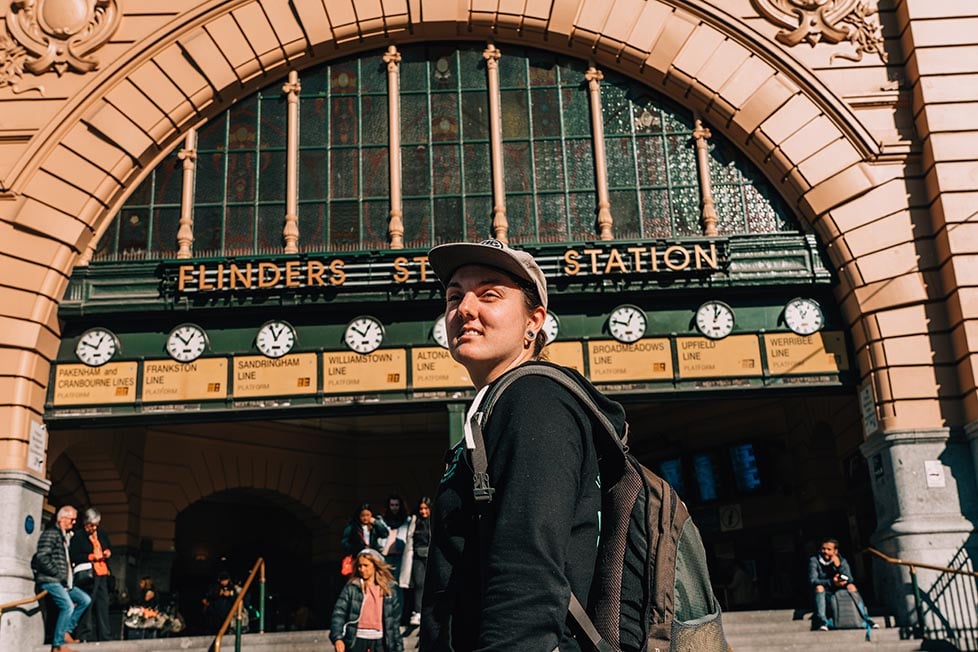
Share or save this post

This is a great read. It’s so thorough and helpful. It is helpful to start planning my trip .Thank you for all the tips and tricks.
You’re welcome 🙂
Leave a Reply Cancel reply
Your email address will not be published. Required fields are marked *
Save my name, email, and website in this browser for the next time I comment.
Notify me of followup comments via e-mail.
Travel - Experience - Share
- Philippines
- Netherlands
- Switzerland
- United Kingdom
- South America
- New Zealand
- Adventure Travel
- Culture & Heritage
- Sustainable & Responsible Travel
- Travel Products & Services
- Travel Tips
- Food & Restaurants
- Hotel & Resorts
- Travel Resources
- Published Work And Features
- Work with Us / Contact Us
- Search for: Search
Australia For First-Timers – A Travel Guide & 6 Useful Tips
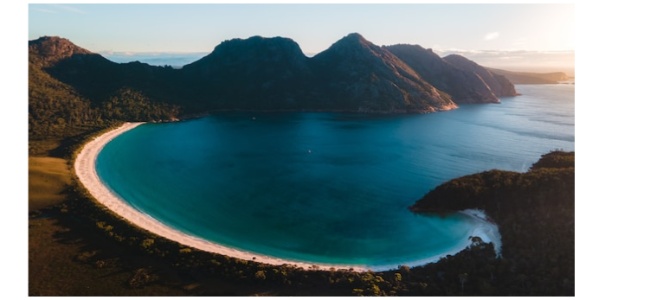
Discover the spectacular country – Australia in essence. This is the ultimate Australia travel guide – Australia for first-timers.
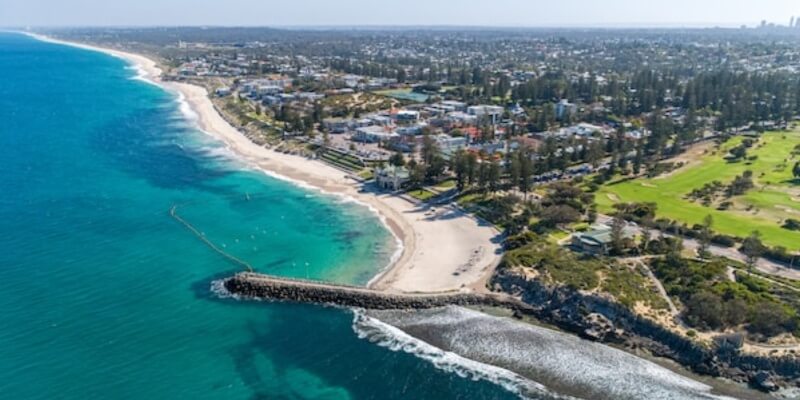
Australia is a vast and stunning nation to explore. There is so much to do and see, from sipping a Melbourne coffee to watching the sunset over Uluru. If you are visiting Australia for the first time, these tips below will assist you in discovering the spectacular country, in essence, it is a travel guide for Australia for first-timers .
Table of Contents
Australia Travel Guide – Australia For First-Timers
The most popular image that comes to mind when people envision travelling to Australia is the natural scenery. Cities bathed in sunlight, golden surf beaches and the vast, red outback all more than live up to the expectations. However, the lesser-known areas also provide enormous benefits. Tasmania, for instance, offers challenging hikes, quaint hospitality, and bizarre and fascinating animals. And compared to its competitors on the east coast, Western Australia’s coastline is wilder and less crowded.
Australia For First-Timers
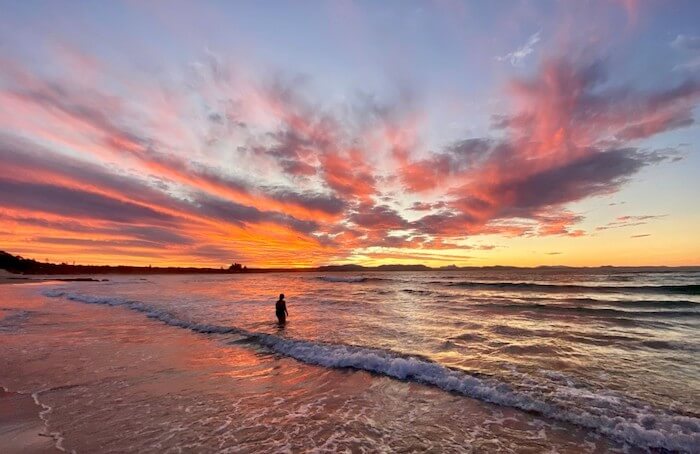
Australia is also home to one of the oldest cultures in the world, and a trip there without taking the time to learn about Aboriginal culture is similar to seeing the Great Barrier Reef without taking a dive. Learn about the Aboriginal people, their pastimes and their relationship with the land by visiting an Indigenous cultural centre or taking a tour with an Indigenous guide and taking your time to learn the history of Australia.
Here are some of the best things to do for first-time travellers to Australia! Australia Travel Guide – Australia For First-Timers.
Best Time To Travel To Australia – Australia For First-Timers
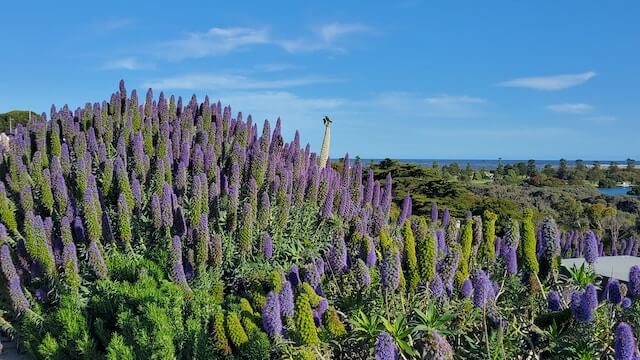
The ideal time to travel to Australia will depend on which areas of the country you are planning to visit. Australia has two distinct climates, with the northern part being the driest and easiest to travel in between April and September. Days that are warm and bright are ideal for visiting national parks and beaches since they allow for outdoor activities like swimming and barbequing.
From October to March, the north experiences more humidity and greater rainfall, however, this is countered by the region’s busy wildlife and revitalised wetlands and rainforests.
The summer months provide hot, drier weather to Australia’s southern half, making this an ideal time to visit these regions if you’re planning outdoor activities.
The majority of Australia experiences winter from June through August. This is the ‘dry season’ in the Northern Territory, making it the perfect time to travel to the north of the nation, including Darwin, the Top End, and the Kimberley.
Best Places To See In Australia – Australia For First-Timers
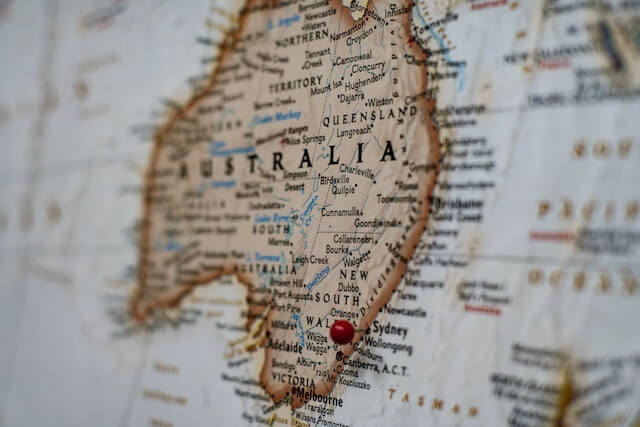
Australia is very diverse and offers something unique for every visitor, whether you are interested in experiencing the traditional way of life of the country’s indigenous people, unwinding on a sun-kissed beach, or partying through the night in a city hotspot.
Travellers to Australia are able to visit the wilderness of Tasmania one day and Kakadu and Uluru-Kata Tjuta the next.
To assist with deciding your travel priorities, I have listed some of the best places to see while you are in Australia:
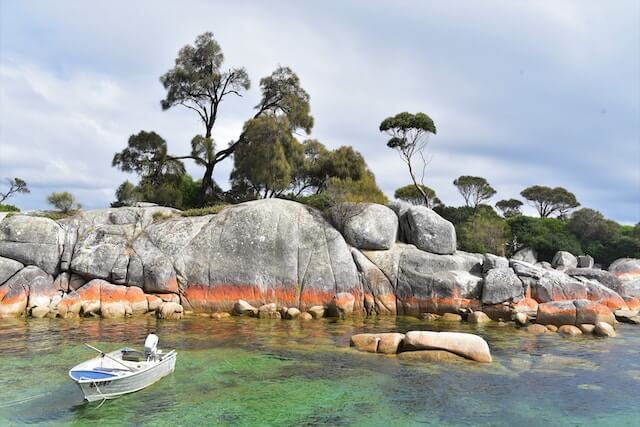
Visit the astonishingly beautiful island state of Tasmania to reacquaint yourself with nature, wildlife, and your sense of taste.
Tasmania has exceptional culinary and drink offerings, compelling natural beauty, and a broad range of cultural events. A true sense of Tasmania may be found in its fresh apple cider, cheeses, wine, and oysters. Its powder-white beaches and casual luxury are the reason this state is a hotspot!
In recent times Tasmania, and particularly Hobart have become favoured by the arts and foodie crowd. Cultural experiences like visiting MONA, or road trips through the island to taste the delicious food and wine of the region are very popular today. And with a short flight south (under an hour) from Melbourne, Hobart and Tasmania are a hotspot to visit in the warmer months, or in Winter for a truly cool climate experience!
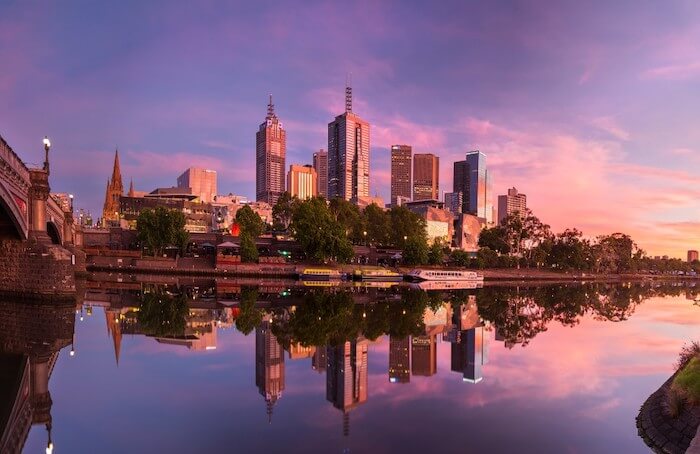
The sheer breadth of Australia is astounding when you look at a map and cast your eyes over it’s vastness. As a newcomer to Australia, there are many alternatives, and it might be difficult to know where to start.
Melbourne is a vibrant city that is a foodie and street art lover’s paradise. As a first-timer to Melbourne, it is highly recommended to take a walking tour, then you can venture off on your own. The greatest way to uncover Melbourne’s swankiest spots at night or delectable brunch spots is to saunter down laneways, winding your way through the city.
Melbourne is also the music capital of Australia, with live music on every night of the week. Find a gig guide and see and hear all types of music at one of the many jazz, folk or rock venues throughout the CBD and inner suburbs of Melbourne.
Also read: Day Trips from Melbourne, Australia
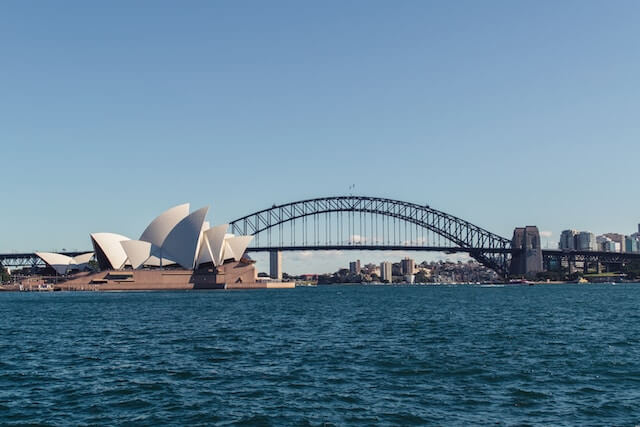
Sydney is a city you won’t forget, with its recognisable landmarks and gorgeous beaches.
Sydney is home to must-see spectacles like the Opera House and Sydney Harbour Bridge, but this Harbour City is always changing. New rooftop bars, dramatic plays, and designer stores are everywhere you turn. The energy of the city is perfectly balanced with afternoons spent relaxing on the beach. Sydney is also a great base for day trips and weekend drives because of the range of nearby destinations.
Popular things to do in Sydney include visiting Luna Park, Taronga Zoo, Manly Beach or Bondi Beach, brewery crawls, brunch in Surry Hills, harbour cruises, shopping, harbour view drinks or visiting one of the many markets.
Also read: A Road Trip from Sydney to Brisbane
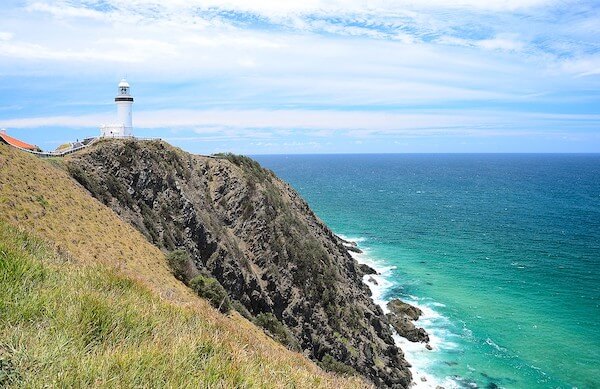
Byron Bay’s temperature, beaches, natural surroundings, and abundance of wellness professionals make it the ideal place for a variety of adventures and activities. Discover the beaches in the area by kayak, horseback, surfing lessons, or whale watching. Take a balloon ride over the mountains and coastal vistas or try skydiving and tick it off your bucket list. Byron Bay is the most eastern point of Australia and the diverse and interesting town is a must add to your itinerary.
Daintree Rainforest
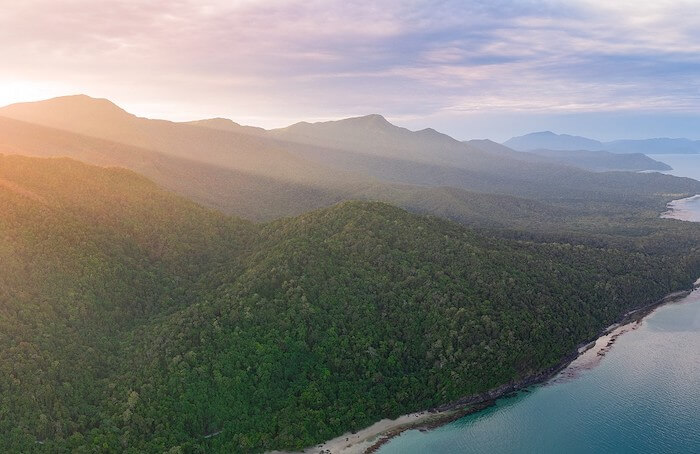
The Daintree Rainforest’s flowing vines and green canopy have been expanding for more than 180 million years and is the oldest tropical rainforest in the world. It should come as no surprise that travellers experience a sense of timelessness with each step.
The experiences you may have there, like crocodile spotting and spearfishing, are just as unique as the forest itself. Enjoy a luxurious spa, float leisurely down the river on a raft, and learn from the Kuku Yalanji, the region’s long-time guardians, who will impart their centuries-old wisdom.

Swap the business attire for the T-shirt and shorts of the tropics and explore Darwin, a thriving, diverse city. Visit the upscale Cullen Bay Marina, stroll along the wharf on a heritage trail, and indulge in diverse foods at the Mindil Beach Sunset Markets. Beyond Darwin’s small city hub, you can swim beneath falling waterfalls in Litchfield National Park and cruise alongside acrobatic crocodiles on the Adelaide River.
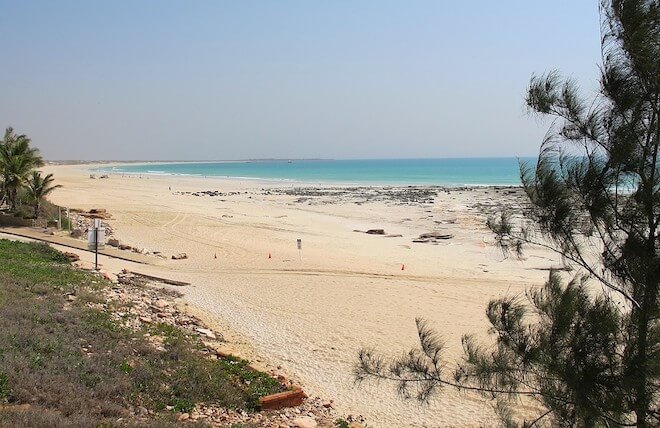
In Broome, there is a lot to see and do. Choose from camel rides on Cable Beach, town excursions, pearl tours, sampling the local cuisine while taking in the ideal sunset, shallow boat rides to observe dinosaur footprints, and more. Why not fly over beautiful scenery or go on a quick half-day cruise if you have more time?
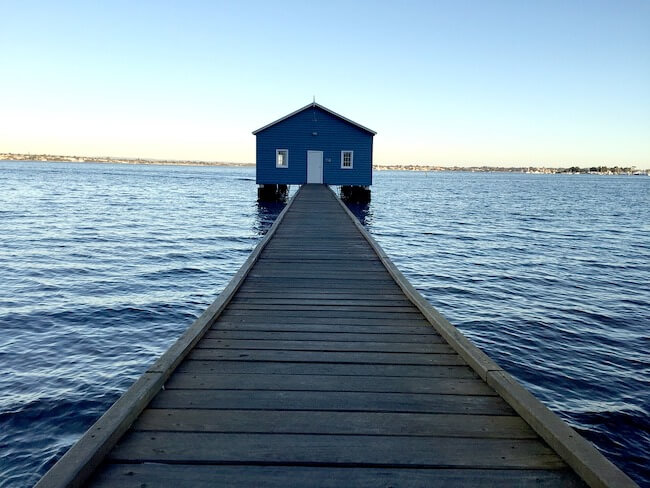
There are a variety of activities in Perth that are ideal for everyone, whether you’re a local or a guest. Take a helicopter ride over Western Australia’s capital city or luxuriate in a massage as you explore the lovely Rottnest Island by ferry, bicycle, or water. There are many must-do activities in Perth because to its gorgeous, crystal-clear seas, excellent climate, and incredible natural setting!
Also read: Day Trips from Perth Australia
Best Food In Australia – Australia For First-Timers
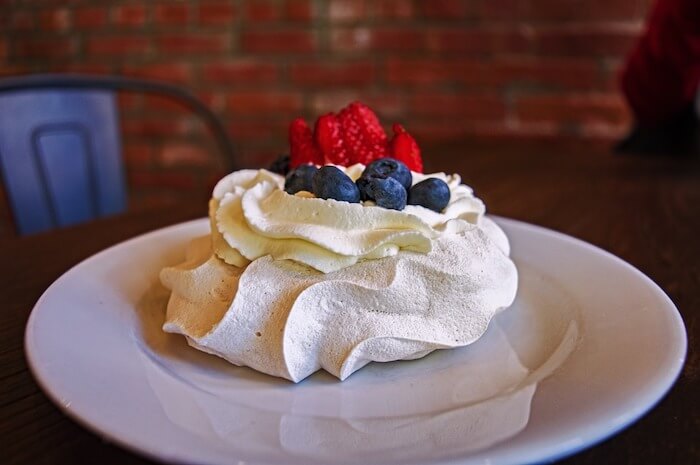
Are you considering a vacation to Australia soon and curious about the unique cuisine on offer? Or perhaps you want to start embracing traditional Australian dishes and sweets as soon as you get to Australia?
Australia is a cultural melting pot, producing a distinctive variety of popular snacks and distinctive cuisines. From traditional Australian dishes to the impressive array of foods from other cultures available, here is a list of some of the best food to try when in Australia.
Traditional : Aussie BBQ, Seafood, Vegemite, Meat Pies, Pavlova, Parma and Anzac Biscuits.
Other Cultures : Australia also has plenty of other cultures’ food available. From the incredible Italian Food and coffee In Melbourne, Asian food is available in Chinatown in the larger cities, Indian, middle eastern, and everything in between.
Transport in Australia -Australia For First-Timers
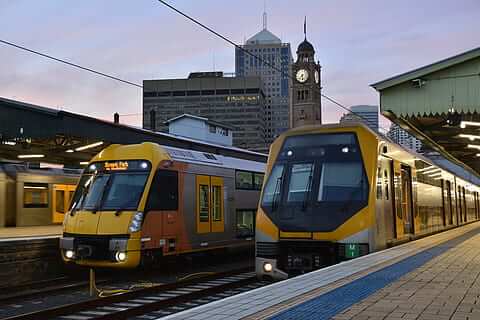
Trains, buses, trams, and ferries are all part of Australia’s public transportation network. In addition, cab services and Rideshare are available in all major cities and towns.
While larger capital cities normally provide a variety of transportation options, rural areas typically only have a local bus service as their primary mode of transportation. To see if you qualify for student travel discounts, check with your college.
Visa Information Australia – Australia For First-Timers
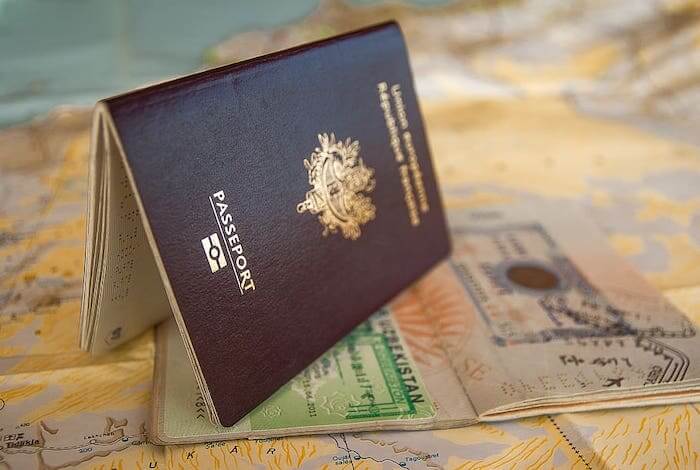
You will need to have a current Australian visa to be able to enter the country unless, of course, you are an Australian citizen. Passport holders from New Zealand can apply for a visa when they arrive. All other passport holders are required to obtain a visa before travelling, regardless of age. Use the ETA app or the Department of Home Affairs website to apply for a variety of Australian visas, such as working holiday and tourist visas.
Travellers to Australia can choose from a variety of Australian visa categories. It will depend on how long you intend to stay, if you have a current passport, and the reason for your visit, to know which Australian visa you need to apply for.
Australian Language – Australia For First-Timers

When you travel to an English-speaking nation, you start hearing some extremely odd slang phrases. Australian lingo is undoubtedly ‘interesting’! There are a few Australian slang terms that you should learn to help you navigate daily life, whether you’re planning a trip to Australia, have already arrived, or have lived on this enormous island of beauty for a while.
Despite the fact that Australia is an English-speaking nation, you can find yourself in some awkward circumstances if you don’t know the most common slang terms used there. It’s important to note that Australians frequently reduce the majority of terms in the English language.
Here are some common ‘slang’ terms:
- Maccas(McDonalds)
- It’s my shout! (I’m buying drinks)
- Chuck a sickie (Have a sick day)
- Trackies (Tracksuit pants)
- Chuck a u-ey (Take a u-turn when driving)
- Fire up the barbie (Start up the barbeque)
- Mozzie (Mosquito)
Foreign Exchange Information – Australia For First-Timers
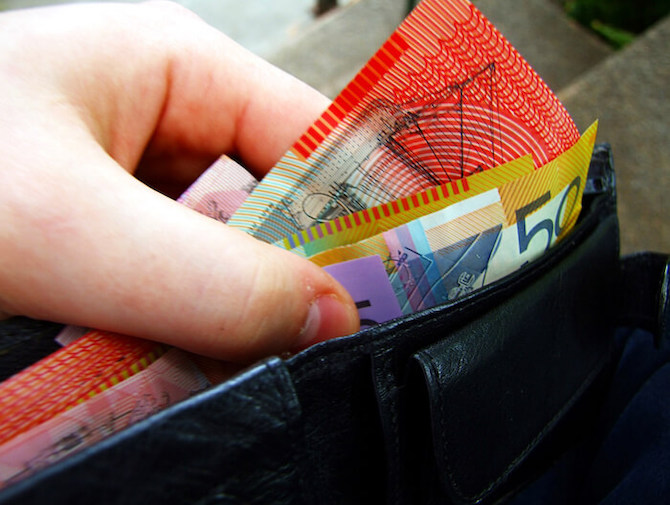
The local currency is the Australian Dollar. For current foreign exchange rates, visit The Reserve Bank of Australia.
Ultimate Travel Tips For Australia | Australia Travel Guide
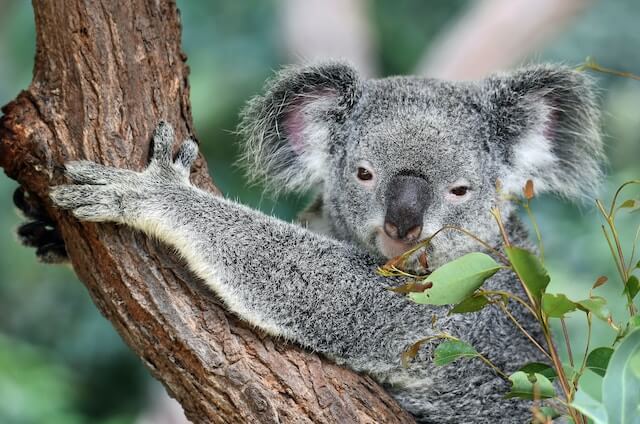
Planning a trip to Australia can initially seem difficult due to its size, but it can be a lot of fun with some advance planning and research!
With tropical rainforests in the north, arid desert in the centre, and beaches, mountains, towns, and valleys strewn throughout, the nation is incredibly diverse.
Whether you’re considering a work exchange, backpacking or simply visiting for a few days, it’s a good idea to have a basic idea of the local language, as well as knowledge of the appropriate currencies, plug adaptors, and visa requirements.
Some tips to keep in mind :
- It’s recommended to learn about the traditions and culture. You should ensure that you are integrating into the community with an understanding of the diversity and history of Australia.
- In Australia, the sun is stronger, which entails often applying sunscreen, donning sunglasses, wearing protective gear, including a hat in the middle of the day.
- English is the local language (but be aware of slang!).
- Tipping is not necessary.
- Driving is on the left side of the road!
- Australia has different electrical plugs than other continents
Reaching Australia
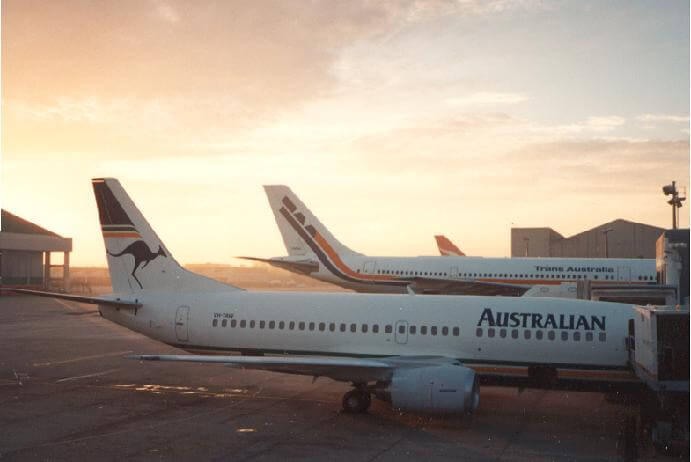
If you are planning a visit to Australia , you can book your flight tickets right here through Cleartrip or Makemytrip or CheapAir or Priceline and fly to your destination in Australia.
Where To Stay While Visiting Australia
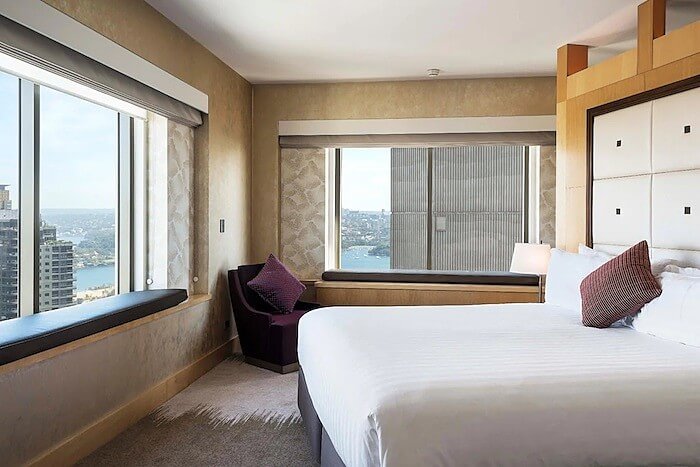
While planning a visit to Australia, if you are looking for a hotel, you can book the best hotels in Australia right here – TripAdvisor or Cleartrip or makemytrip or goibibo or Booking.com or HotelsCombined or Agoda and save a lot by getting the best deals on booking your stay.
Travel Around Australia
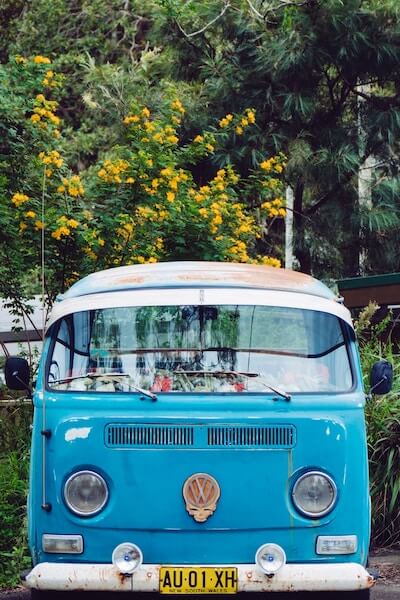
There is so much to see and experience in Australia . If you prefer package tours and looking for these, you can plan your Australia itinerary and book your Australia trips , right here. So go ahead and book online places to see in Australia and popular activities in Australia and cover attractions in Australia .
Hope these suggestions for travelling to Australia are helpful, whether you’re visiting Australia for the first time or returning after a while. Travelling to Australia is a genuinely remarkable experience, discovering a wide range of cultures and sights. Anyone who wants to visit Australia can have a fantastic trip if they brush up on their knowledge, plan ahead and be prepared for an unforgettable trip!
In the comments section, do let us know your thoughts about this post – Australia For First-Timers – Australia Travel Guide.
For more interesting and informative content, don’t forget to subscribe to our blog and join our monthly newsletter – Postcard From India . Stay connected with us on our social media channels as well!
We are a reader-supported site. This means, at no additional cost to you, we may earn a small commission if you book a flight or hotel, or make a purchase through one of our affiliate links. Thank you for your support!
Are you planning a last-minute Holiday? Below are some useful resources to help you book flights, hotels, and tours! And also clothes, luggage and accessories for your trip!
Flights – Cleartrip or Makemytrip or IndiGo or Cheapair or Priceline
Tours – Click to book top tours around the world . Book tours and activities here .
Experiences – Book your next unforgettable experience here , with flexible bookings and free cancellations. Reserve tours and activities now and pay later.
Hotels – Click to book the best hotels/resorts . Choose the best stay options with TripAdvisor or Cleartrip or makemytrip or goibibo or Booking.com or HotelsCombined or Agoda
Travel Insurance – Click to book Travel Insurance that covers a range of travel insurance and safety services including medical emergencies, lost luggage, trip cancellation and more
Visas and Travel Documents Application – Click here for Online Travel Visa Check
Online Passport Photo – Get Your Passport Photo Online here

Do You Love Traveling?
Do you want to know how to travel the world? We have put together a very useful travel resources page with the best travel tips . Go check it out now. Thanks for visiting our site Voyager - imvoyager.com and taking the time to read this post! If you wish to collaborate/work with us then reach us at [email protected] We’d love it if you’d comment by sharing your thoughts on this post and share this post on social media and with your friends. Follow our journey on our social media channels: Facebook X Instagram Pinterest YouTube
Start dreaming about your next adventure with Tripadvisor . Book your next unforgettable experience here with flexible bookings and free cancellations.

60+ Million Users Trust TripAdvisor With Their Travel Plans. Shouldn't You?

Sandy & Vyjay are a husband and wife duo who are travel content creators. They are co-founders of this travel website and are one of the leading travel bloggers in India.
Sandy & Vyjay quit their successful corporate careers to pursue their passion for travel and writing full-time. Their dedication has earned them the “Best Travel Writer” award and numerous accolades on both national and international stages. Focusing on India’s destinations, heritage, and culture, they are passionate advocates for nature and the environment. Through their content, they promote ecotourism and sustainable travel, inspiring others to explore and preserve the beauty of India.
Explore these posts:
Leave a comment cancel reply.
Your email address will not be published. Required fields are marked *
This site uses Akismet to reduce spam. Learn how your comment data is processed .
Privacy Overview
FLASH SALE💥 Book now for up to 60% off!
Fully Guided Tours & Trips in Australia
- Tasmania Fully Guided
- Kakadu National Park Fully Guided
- Victoria Fully Guided
- Western Australia Fully Guided
- Great Barrier Reef Fully Guided
250+ Fully Guided tour packages in Australia with 2,975 reviews

Sydney to Brisbane Adventure

- In-depth Cultural
UltimateOz - Gap Year | ULTIMATE
"Base camp was the best part! Should be extended another day" Sofiane, traveled in November 2019
- €35 deposit on some dates Some departure dates offer you the chance to book this tour with a lower deposit.
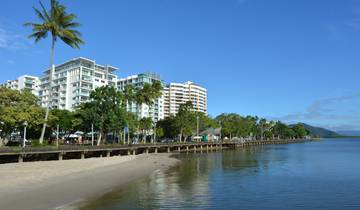
- Christmas & New Year
Australia: North Queensland Adventure (Sailing, 9 Days)
"Mark was excellent 5/5 to him." Curran, traveled in December 2022
- €100 deposit on some dates Some departure dates offer you the chance to book this tour with a lower deposit.
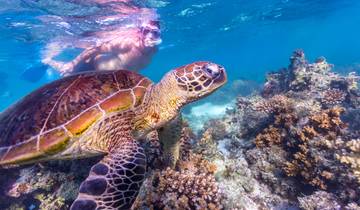
- Coach / Bus
7 Day Perth to Exmouth Explorer Loop
"We were able to see some beautiful places, helping us to appreciate the natural world. Everything was well organised, and it helps that the job to ensure it was organised was our leader, Geoff." Kayleigh, traveled in March 2024

8-Day Uluru to Adelaide Tour
"Amazing views, beautiful sunrise hikes, (bush) camping in swags and learning so much about geological and cultural history." Minke, traveled in April 2024
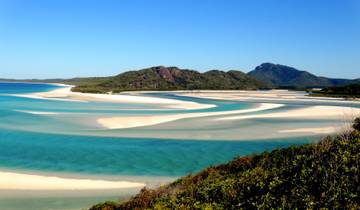
Brisbane to Cairns Experience: Sand Dunes & the Whitsundays
"I enjoyed having a smaller, intimate group for a greater opportunity to bond. Seen a lot in a short period of time." Alyssa, traveled in July 2019
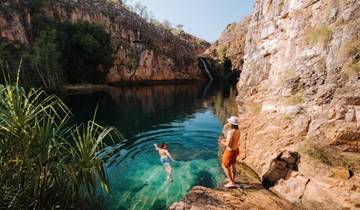
5 Day Kakadu Katherine Litchfield 4WD Adventure (Camping)
"Beautiful scenery, fascinating aborigeneous culture and traditions, amazing group of people." Philippe, traveled in August 2022
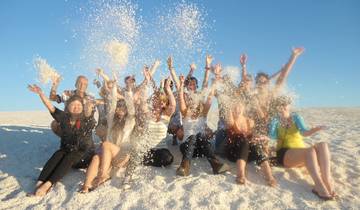
6 Day Perth to Exmouth Coral Coaster (One Way)
"Would definitely use Autopia for tours again! Most amazing place I've ever been!" Lydia, traveled in September 2023
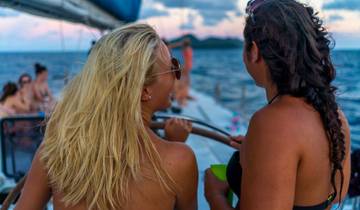
East Coast Highlights - 3 Week | ULTIMATE
"It was a fantastic tour! Encouraged us all to try new things and have an open mind." Jenna, traveled in March 2022
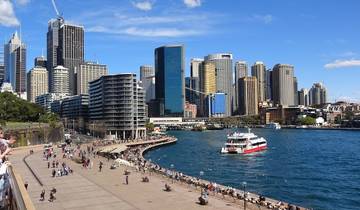
- Walking Adventure
Sydney to Brisbane Experience: Bushwalks & Surfing
"Wake Up was a nice hostel with a great breakfast included the first day. Byron Bay is a great surf town." Cheryl, traveled in April 2023

Australia: North Queensland Adventure (9 Days)
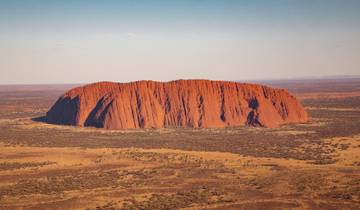
8-Day Adelaide to Uluru Tour
"Lots to see and do, appreciated flexible alternatives for those who might want to do a long hike." Richard, traveled in November 2023

Great Ocean Road & Grampians Adventure
"We saw a great deal of very interesting views and places. Well worth the upsets and confusion." maureen, traveled in March 2023
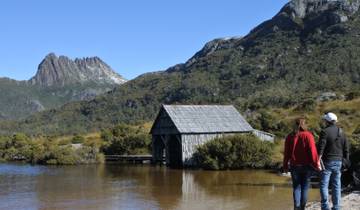
- Hiking & Trekking
- Mountain Hikes
Trek the Cradle Mountain Overland Track
"The track and the scenery along the way were wonderful, of course." Ian, traveled in February 2022
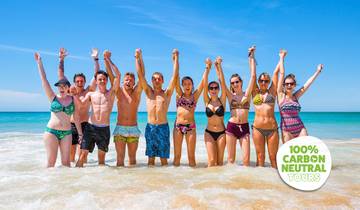
"Aside from that, my only further complaint is that Intro should be more picky about the hostels they put their guests in." Karlee, traveled in January 2024
What people love about Fully Guided Tours in Australia
Amazing experience, everything ran smoothly, and I couldn’t recommend it any more than - DO IT! Best time of my life on this tour, action packed days and it was so good to see different parts of Sydney and the wider area you might not have normally. Great value for money!
Mark was excellent 5/5 to him.
I loved every aspect of this tour. Geoff was an AMAZING tour guide!!
Top operators
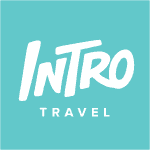
"The Oz east coast trip with Intro is an amazing way to explore the entire east coast trip fast! It is well organised and as described, with the option to do extra activities along the way too. My leader was Molly who has fantastic. She got the group to each destination safe and sound, without any hassle, and with lots of laughs! She also was extremely knowledgeable about each destination we went to and about the general Aussie culture. She was extremely approachable to any queries that you had and gave me lots of tips and advice for working in OZ after! It is also a great way to make lifelong friends and travel safely. I would definitely recommend. I would also suggest bringing a suitcase or wheely backpack as it is much easier to travel with. 😊
INTRO Travel is an expert in:

"amazing! Our tour guide Eli made sure we didn’t have to worry about anything because everything was taken care of. She was the best!! Always made sure we had something to do :)
Ultimate Travel is an expert in:

"Everything was Excelent
Trafalgar is an expert in:
Regions in Australia
- East Australia (130)
- Western Australia (105)
- Australian Outback (104)
- Australia Northern Territory (81)
- Tasmania (78)
- Great Barrier Reef (67)
- Queensland (59)
- Australia East Coast (46)
- Red Centre (46)
- Central Australia (45)
- South East Queensland (44)
- Uluru / Ayers Rock (41)
- Kakadu National Park (41)
- Australia West Coast (37)
- South Australia (30)
- Victoria (22)
Travel Styles
- Fully Guided
- Australia Travel Guide | All You Need to Know
- Best 4 Week Australia Itineraries 2024/2025 (with Reviews)
Discover TourRadar
- Kenya Safari
- South Korea Tours
- Northern Norway Luxury tours
- Golden Triangle with Ranthambore Fall-Autumn tours
- Crossing the North Pole - Transarctic
- India and Nepal Tour
- 3Day Desert Tour Farom Marrakech To Merzouga Desert Tour
- International edition
- Australia edition
- Europe edition
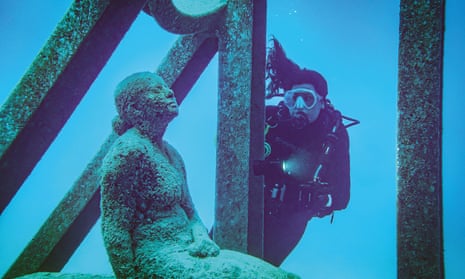
Australia’s 20 best travel experiences, ranked by Lonely Planet
Choosing Australia’s top travel experiences is not easy, and while many usual suspects appear in Lonely Planet’s list, some may even surprise locals
At 7.6m sq km, spanning eight climate and three time zones, Australia is a big country. So where do you start?
In making their new book, Lonely Planet’s Ultimate Australia Travel List, the travel guide publisher began by compiling every highlight in their existing books. “We then asked our writers, editors, designers and cartographers in Australia to reveal their favourite spots and experiences,” they say. From there, they solicited votes from a panel of travel experts and members of their community.
The result, “with hundreds of votes cast and a bit of mathematical alchemy, as well as a keen eye on sustainability practices”, is a new book of 500 experiences. They also ended up with “one very clear winner”.
Here is that winner, along with the rest of the book’s Top 20 experiences.
1. Fall silent before the majesty and gravitas of Uluru
Northern Territory/ Anangu Country
The landscape of Uluru changes dramatically with the shifting light and seasons. In the afternoon, Uluru appears as an ochre-brown colour, scored and pitted by dark shadows.
As the sun sets, it illuminates the rock in burnished orange, then a series of deeper and darker reds before it fades into charcoal. A performance in reverse, with marginally fewer spectators, is given at dawn.

Uluru is a beautiful, charismatic place. Its dimensions are one thing: it is 3.6km long and rises 348m from the surrounding sands (867m above sea level). If that’s not sufficiently impressive, remember this: two-thirds of the rock lies beneath the sand.
Uluru is a monolith textured with layers of profound spirituality and timeless beauty, the epitome of desert stillness and, in the plays of light and shadow that dance across its surface, one of the richest shows in nature. The sunset viewing areas are once-in-a-lifetime experiences understanding its singular beauty when surrounded by the vast desert around it.
You can also get up close by taking one of the walks that encircle the base. There are many options, but most fold into the Uluru Base walk, a 10.6km circumnavigation of the rock. Along the way, it passes caves, paintings, sandstone folds and geological abrasions and generally initiates you into the scope and detail of this remarkable place.
Sacred sites are everywhere; entry to and knowledge of the particular significance of these areas is restricted by local law, and knowing this only adds to Uluru’s mystery.
The walk takes you away from the crowds – very few visitors spend long enough here to get to know Uluru this well. There is no better way to experience the rock.
Around 1km from the rock itself, the Uluru-Kata Tjuta Cultural Centre adds depth and perspective to your Uluru experience. Displays and exhibits focus on Tjukurpa (Aboriginal law, religion and custom) and on the natural and human history of the park. Park rangers can supply the informative visitor guide, leaflets and walking notes, as well as other park information.
2. Be confronted and inspired by art at the extraordinary Mona
Tasmania/ Palawa Country
Undeniably eccentric, the Museum of Old and New Art (almost universally known as Mona) has ushered Hobart on to the world’s cultural stage.

Opened in 2011, and housed in a Nonda Katsalidis-designed three-storey bunker burrowed into the Triassic sandstone of a peninsula jutting into the Derwent River, Mona is a showcase for founder and owner David Walsh’s remarkable collection of ancient, modern and contemporary art, which is loosely curated under the themes of sex and death.
All cultural roads lead to Mona in January (for Mona Fofa, or Mofo for short) and June (for Dark Mofo) for Tasmania’s largest contemporary music festival.
SEE IT! Mona is 12km north of Hobart’s city centre. The best way to get here is on the museum’s ferry, which departs from Brooke St Pier.
3. Be mesmerised by the Great Barrier Reef
Queensland/Aboriginal and Torres Strait Islander sea country
The Great Barrier Reef isn’t just the world’s largest living organism. Visible from outer space, it’s also one of the planet’s most precious ecosystems – and a gobsmackingly beautiful one to boot.
Home to more than 600 hard and soft coral species and a colourful array of other marine creatures, from tiny nudibranchs (sea slugs) to huge manta rays, this World Heritage-listed area also has cultural significance to more than 70 local Indigenous groups, their connections to the reef dating back some 60,000 years.
It’s no secret, of course, that the Great Barrier Reef faces a number of threats. Yet from coral planting dive trips to Indigenous-led reef tours, there are more opportunities than ever to experience this fragile ecosystem sustainably, helping to ensure that this incredible slice of nature can be enjoyed for generations of visitors to come.
4. Find freedom on the Great Ocean Road
Victoria/ Gadubanud and Girai wurrung Country
As its name rightfully declares, the Great Ocean Road is no ordinary stretch of bitumen. This is one of the world’s bucket-list drives, a 243km blockbuster of breathtaking coastal vistas, koala-speckled gums, nostalgic holiday towns and rolling dairy farms. Officially bookended by Torquay and Allansford, the route takes in the arresting beauty of Port Campbell national park.
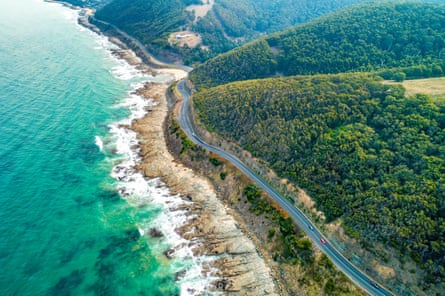
The entire drive can be tackled as a long day trip from Melbourne, though it pays to stay longer. Spend at least a few days riding waves and horses on Fairhaven Beach, chomping on fresh crayfish at Apollo Bay Fishermen’s Co-op and snooping around time-warped sites like Cape Otway Lightstation.
The Great Ocean Road weaves through Great Otway national park, where walking trails lead through temperate rainforest splashed by waterfalls. If you fancy a multi-day trek, ditch the wheels altogether and hit the 104km Great Ocean walk, the most intimate way to experience this fabled stretch of surf.
5. Walk alongside Australia’s highest sea cliffs on the Three Capes track
Tasmania/Palawa Country
Any list of epic Australian bushwalks is bound to contain the Three Capes track. Traversing a well-maintained path alongside the lofty sea cliffs in Tasman national park, this four-day, 48km trek kicks off after walkers are dropped by boat at the Denmans Cove trailhead.
The route links the cove with Cape Raoul, Cape Pillar and Cape Hauy before finishing on the sandy shores of Fortescue Bay. Scenery includes eucalypt forests, coastal heathland and ocean views for as far as the eye can see.
Accommodation is in ranger-supervised camps with architect-designed huts that are almost as good looking as the eye-popping coastal scenery.
You’ll walk up the slopes of Crescent Mountain and Mt Fortescue and down to Ellarwey Valley, seeing native flora and fauna aplenty. Daredevils can scale the well-named Blade Rock formation at Cape Pillar and plunge into the icy surf at Fortescue Bay. The track is described as being achievable for most ages and abilities, but some bushwalking experience is recommended.
WALK IT! Tasman national park is 100km south-east of Hobart. Boats collect walkers at Port Arthur. Daily walker numbers are capped, so book well ahead .
6. Explore the weird and wonderful rock formations of Bungle Bungles
Western Australia/ Jaru And Gidja Country The bizarre, ancient, beehive domes of the World Heritage-listed Purnululu national park will take your breath away. Known colloquially as the Bungle Bungles, these remote rocky ranges are the finest example of cone karst sandstone anywhere in the world.
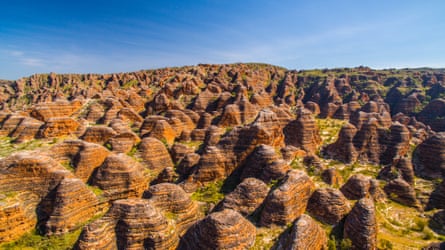
The distinctive rounded rock towers are made of sandstone and conglomerates moulded by rainfall over millions of years. To the local Gidja people, “purnululu” means sandstone, with Bungle Bungle possibly a corruption of “bundle bundle”, a common grass. The park is rich in fauna and flora, the walks take you through shady palm-fringed gorges, and the sunsets here are sublime. There’s refreshingly little infrastructure and it’s never crowded.
SEE IT! Access is via a rough, unsealed, flood-prone 4WD-only track from the Great Northern Hwy north of Halls Creek, or by air on a package tour from Kununurra or Warmun. For more information, visit www.parkstay.dpaw.wa.gov.au .
7. Enjoy the ultimate rainforest experience in Daintree national park
Queensland/Kuku Yalanji Country
The oldest tropical rainforest on the planet, the World Heritage-listed Daintree Rainforest is like a real life Jurassic Park, complete with living dinosaurs, from cassowaries to crocs.
South of the Daintree River, the Indigenous-run Mossman Gorge is the most accessible of the park’s two sections. Here an elevated boardwalk tracing the crystal-clear Mossman River connects to a scenic 2.4km rainforest circuit. Learn more about the Kuku Yalanji connections to this verdant oasis on a tour with Ngadiku Dreamtime Walks.
Some say you haven’t been to the Daintree until you’ve visited the Cape Tribulation section of the park north of the Daintree River, where rainforest meets the Great Barrier Reef. Allow several days to soak up this lush wilderness, dotted with rainforest boardwalks and idyllic croc-free swimming holes.
SEE IT! From Port Douglas it’s a 20-minute drive west to Mossman Gorge, and a 40-minute drive to the Daintree River Ferry.
8. Set sail for Kangaroo Island’s wilderness and wildlife
South Australia/Kartan Country
Kangaroo Island (KI) was scorched by bushfires in Australia’s “Black Summer” of 2019–20, but remains a veritable zoo of seals, birds, dolphins, echidnas and (of course) kangaroos. Island produce (wine, seafood, gin, beer), surf beaches and the kooky rock formations of Flinders Chase national park are also highlights.

These days, KI is rurally paced with a scattering of laid-back towns – the kind of place where kids ride bikes to school and farmers advertise for wives on noticeboards. The excellent five-day, 64km coastal Kangaroo Island Wilderness trail was ravaged by the fires, but trail reconstruction is under way: watch this space.
SEE IT! KI is big! You can’t see it all in a day. Bring your car on the ferry and explore over a weekend.
9. Marvel at the Milky Way in the Warrumbungle Dark Sky Park
New South Wales/Kamilaroi Country The night sky unrolls around you each night in the Warrumbungle national park, Australia’s first and only Dark Sky Park. The 233 sq km park has been internationally recognised for its stunning views of the stars due to its high altitude, low humidity and carefully monitored light pollution.

With four observatories to choose from, you can stargaze well into the night. Siding Springs Observatory is home to the largest optical telescope in Australia – with a mirror measuring 3.9m, the Anglo Australia telescope is capable of viewing quasars up to 12bn light years away.
The Warrumbungles still have plenty to offer once the sun rises. Avid bushwalkers are sure to enjoy the rugged volcanic landscape. The Breadknife and Grand High Tops walk will bring you close to the park’s most impressive formations. With over 190 bird species recorded within the park, birdwatchers should be sure to look out for emus, wedge-tailed eagles and the southern boobook owl.
For a more relaxing option, take a trip along the world’s largest Virtual Solar System Drive. The dome of the Siding Springs Observatory represents the sun, with scaled model planets stretching the whole 200km to Dubbo.
10. Light up your time in Sydney at the Vivid festival
New South Wales/Gadigal Country
During Vivid Sydney, video art and massive images are projected on to Sydney’s iconic architecture, with the sails of the Opera House, the arches of the Harbour Bridge and the sandstone buildings of the Rocks all transformed into leviathan canvases for a shimmering collage of spotlights, laser beams and electrified sky-high street art.
Journey on the harbour at night on the Manly Ferry for brilliant views, or join a chartered boat trip to take in the best of the glowing spectacle. Beyond the illuminations, music is also a stunning part of the Vivid experience, from big international artists to more intimate performances from the best of Australia’s emerging talent.
SEE IT ! The festival is held annually for three weeks. The 2022 festival will take place from 27 May to 18 June.
11. Go wild on mainland Australia’s southernmost point, Wilsons Prom
Victoria/Brataualung Country
Hitting rock bottom is a good thing when it involves Wilsons Promontory. Occupying the southernmost point of mainland Australia, the 305 sq km national park claims some of Victoria’s most varied, magnificent natural landscapes: salt-white Squeaky Beach, the Saharan dunes of the Big Drift, the lushness of Lilly Pilly Gully.

Walking tracks lead over ridges, across heathland and through headily scented bush alive with kangaroos, wombats, echidnas and iridescent birdlife. The Telegraph Saddle to Sealers Cove route (10.3km) is especially memorable, weaving through fern gullies and swampland to a forest-backed beach. It’s the first section of the challenging, multi-day Southern Circuit (59km), whose stops also include the monumental Oberon Bay.
A much quicker way to admire the bay’s sweep is from panoramic Mt Oberon, an easy 6.8km return hike from the Telegraph Saddle car park. Head up at sunset and pinch yourself. SEE IT! Tidal River is the park’s hub, with visitor information, a general store and accommodation. Avoid school holiday periods and book accommodation in advance at www.parks.vic.gov.au .
12. Experience wildlife and Indigenous history in Kakadu
Northern Territory/ Bininj/Mungguy Country
Kakadu ranks among the world’s great national parks. Its wetlands and escarpments shelter abundant wildlife and rock art that dates back 20,000 years. This is the land of the Bininj/Mungguy, whose presence brings soul and spirituality to any visit here.
In just a few days you can cruise on billabongs bursting with wildlife, examine millennia-old rock paintings under the care of an Indigenous guide, swim in pools at the foot of tumbling waterfalls and hike through ancient sandstone escarpment country. Ubirr and Nourlangie are the main rock-art sites, Jim Jim has the best falls, Cahill’s Crossing is terrific for crocs, and Yellow Water (Ngurrungurrudjba) is great for birds and other wildlife. Kakadu is very popular and can become crowded – in the Dry at least. But this is a vast park, and with a little adventurous spirit you can easily get off the beaten track and be alone with nature.
13. Be wowed by white sands and crystalline water at Wineglass Bay
The show-stealing centrepiece of Freycinet national park, curvaceous Wineglass Bay is Tasmania’s most famous beach for good reason. Its blindingly white sand and pink granite headlands splashed with flaming orange lichen are almost ludicrously photogenic, and a walk along its length to Hazards Beach is almost as rewarding as a swim in its gin-clear water.

Views of the bay are best appreciated from the Wineglass Bay Lookout, a 90 minute walk from the national park’s walking track car park. From here, 1,000 steps lead down to the beach. Those who choose to stay longer and walk further can set off on the Freycinet Peninsula Circuit, a three-day, 30km trek around the peninsula from Hazards Beach south to Cooks Beach, then across the peninsula over a heathland plateau before descending to Wineglass Bay.
SEE IT! Wineglass Bay is 200km north-east of Hobart, via the Tasman Hwy (A3) and C302.
14. Hit the Grampians for an epic hike in Victoria’s Garden of Eden
Victoria/ Jardwadjali and Djab wurrung Country
Hitchcock couldn’t have directed it better himself. A long, eerie crevasse; a sharp left turn, then – BAM! – Pinnacles Lookout and its knockout vista over ranges and plains.
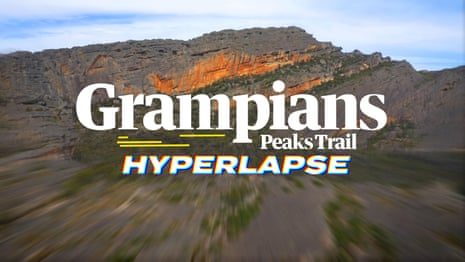
Gotcha moments are thick on the ground when hiking Grampians national park, its sandstone peaks rising like petrified gods. While there are plenty of short strolls – the 4km Mt William (Duwul) Summit walk is breathtaking – the Grampians Peaks trail is the ultimate lace-up adventure.
A 160km long, 13-day odyssey, it spans the entire length of the Grampians (Gariwerd), from Mt Zero (Mura Mura) in the north to the culinary hamlet of Dunkeld in the south. Along it, precious landscapes unfurl, from woodlands and waterfalls to cooling fern valleys. Harboured within: red-tailed black cockatoos, endangered pincushion lilies and the haunting handprints and figures of Aboriginal rock art shelters like Ngamadjidj and Gulgurn Manja.
HIKE IT! See www.grampianspeakstrail.com.au for trail information. Foodies should book a night at Dunkeld’s Royal Mail Hotel.
15. Elevate your Sydney experience on the Bondi to Coogee clifftop walk
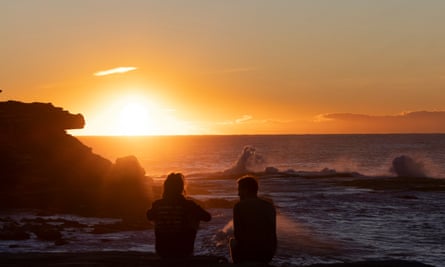
Say good morning to the perfect way to take in the best of Sydney’s coastal scenery. The simply sensational 6km Bondi to Coogee walk leads south from Bondi Beach along the clifftops via Tamarama, Bronte and Clovelly, interweaving panoramic views, patrolled beaches, sea baths, waterside parks and plaques recounting local Aboriginal stories. Pack your swimmers if the weather’s warm.
WALK IT! The trail begins at the southern end of Notts Ave near Bondi’s Hunter Park, and completes its view-friendly route near Dunningham Reserve at the northern end of Coogee.
16. Immerse yourself in the remarkable desert rocks of Kata Tjuta
There’s nowhere on earth quite like Kata Tjuta (formerly the Olgas), a striking group of domed rocks huddled together about 35km west of Uluru. The deep valleys and steep-sided gorges contain sites which are sacred to the local Anangu people.
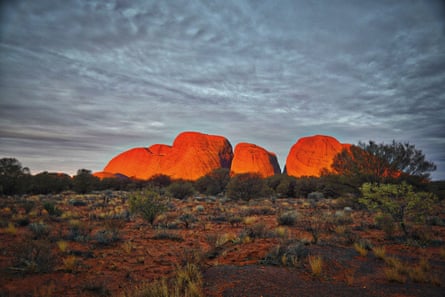
The tallest rock, Mt Olga (546m; 1,066m above sea level) is higher than Uluru. The Valley of the Winds loop, one of the most rewarding bushwalks in Australia’s Red Centre, winds through the gorges and past surreal domes in hues of the deepest red offset by the blue of the desert sky. Elsewhere, Walpa Gorge is especially beautiful in the afternoon, when sunlight floods the gorge. The views from the Sand Dune Lookout, off the road to Uluru, put everything in perspective.
17. Revere Port Campbell national park’s Apostles
Victoria/Girai wurrung Country
You couldn’t ask for a grander finale to the Great Ocean Road. As it shakes off the tortuousness of the Otway Ranges, forest turns to weather-beaten scrub, the sky bursts open and the route shoots west along a flat, narrow escarpment dropping away to terrifying ocean-pounded cliffs. This is Port Campbell national park, home to Victoria’s geological superstars, the Twelve Apostles.
Out of cold, savage waters they rise – monumental limestone stacks, abandoned by the retreating coastline. In truth, there are fewer than 12, but this fails to diminish their impact.
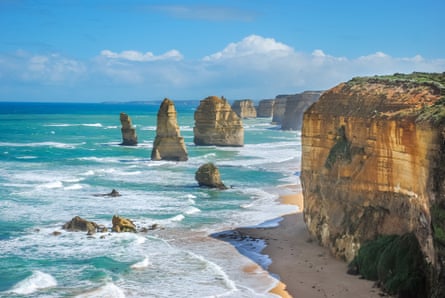
Less famous but no less spectacular are the Bay of Islands and London Bridge rock stacks, just west of sleepy Port Campbell township. Once a double-arched rock platform, London Bridge indeed fell down in 1990, leaving two terrified tourists marooned on the world’s newest island – they were eventually rescued by helicopter.
To the east of the Apostles, Loch Ard Gorge is where the Shipwreck Coast’s most famous and haunting tale unfolded, when two young survivors of the wrecked iron clipper Loch Ard made it to shore. From the clifftop, a path leads down to the cave where the pair took shelter.
The best time to visit is at sunset, not only for the optimal Instagram opportunities (and to beat the tour buses), but also to catch a glimpse of little penguins returning. Sightings vary, but generally the penguins arrive 30 minutes after sunset; don’t forget your binoculars!
18. Reconcile the laid-back splendour of Rottnest Island with its gruesome past
Western Australia/ Noongar Country
With warm water, sunken wrecks, diverse marine life and 63 beaches, it’s little wonder people flock to “Rotto” to swim, fish, laze, dive, snorkel, surf and sea-kayak their cares away. And of course, no trip to Rottnest is complete without the obligatory selfie with the incredibly cute, furry and all-too-trusting quokka.
Highlights include “The Basin”, a family- friendly seawater pool, and the 20m Wadjemup Lighthouse on the island’s highpoint. Wadjemup is a Noongar word meaning “place across the water where the spirits are” – rather apt, given at least 373 unmarked graves hold the victims of a harsh and cruel prison for Aboriginal people operating during the 1800s.
19. Catch the Manly Ferry across one of the world’s greatest harbours
New South Wales/Guringai Country
The Manly Ferry is one of Sydney’s best bargains for visitors to the city. Take in Opera House and Harbour Bridge views before sliding past the ritzy suburbs of Point Piper and Rose Bay and exiting the rocky promontories of the Sydney Heads.

Opposite Manly Wharf, refresh with a beer at the 4 Pines brewpub before strolling along the Corso to the surf, sand and Norfolk pine-lined esplanade of Sydney’s second-most famous beach. Pretty good for around $10.
CRUISE IT! The Manly Ferry departs from Wharf 3 at Circular Quay and takes around 20 minutes.
20. Dive into Queensland’s Museum of Underwater Art
Queensland/Bindal and Wulgurukaba Sea Country
As if the Great Barrier Reef wasn’t epic enough, you can now explore an underwater sculpture garden. The second instalment of the Townsville region’s Museum of Underwater Art, the Coral Greenhouse features 20 human figures performing conservation work in and around a submerged conservatory.
Designed by the renowned sculptor, Jason deCaires Taylor, in collaboration with Indigenous groups, the installation complements the Ocean SirTen sculpture.
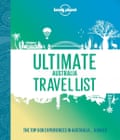
DIVE IT! Dive tours to the Coral Greenhouse run from Townsville and Magnetic Island.
This is an edited extract from Lonely Planet’s Ultimate Australia Travel List , $39.99. Available now.
- Australia holidays
- Australian lifestyle
- Queensland holidays
- South Australia holidays
- Victoria holidays
- Western Australia holidays
Comments (…)
Most viewed.

Change location
- Call us tomorrow from 10am
- 01993 838 925 01993 838 810 or
- REQUEST A QUOTE

Top 7 Aboriginal experiences in Australia
By Australia specialist Ian
Looking to travel meaningfully while in Australia? A respectful and authentic Aboriginal experience will elevate your trip, opening up some of the country’s most well-known yet rarely understood sights.
Where possible, I suggest spending time with a local Aboriginal guide, who’ll talk to you vividly about the Dreaming (Aboriginal philosophy and cosmology) and show you its power and relevance to everyday life. They’ll take you to sacred places — like the remote overhang in Arnhem Land where a colossal rainbow serpent slithers across the rockface, jaw agape. Or the cave in the Margaret River region that resounds, come nightfall, with the primal tones of a didgeridoo played by Josh, a Wadandi man and accomplished musician.
Unsure where to start? Here are seven rewarding ways for connecting with Australia’s Aboriginal heritage, from guided tours to art classes and walking trails, plus suggestions for how you can weave these experiences into various routes around Australia .
1. Arnhem Land’s standout rock art
Off-grid, often waterlogged, and punctured by fearsomely angular sandstone escarpments, Arnhem Land might look uninhabitable to outsiders — but like so many areas of the Australian bush, it’s also a living, breathing sketchpad. In this case, it’s the open-air gallery and collective cultural memory of the Yolngu people, the region’s traditional landowners. The rock art here is unparalleled in its variety and clarity, with new troves being discovered all the time.
What might you see? The artworks that stick out in my mind are the images of sailing ships, which include a steamer-like vessel, a record of first contact with non-Aboriginal visitors. Some rockfaces are an ochre barrage of figures and handprints, but your guide will help you identify depictions of animals and spirit figures — including a showstopping rainbow serpent, the biggest found to date.
Get me there: A stay in the luxe safari-style lodges of Bamurru Plains nicely complements your time in Arnhem Land. Then, journey further into the Northern Territory’s Outback aboard the Ghan .

2. Uluru through Aboriginal eyes
The tip of a behemoth burnt-orange sandstone slab, tilted 90 degrees by tectonic forces and buried deep in the Earth, Uluru exerts a hypnotic pull on most visitors to Australia. But, its geology is only part of the story. The rock’s spiritual significance to the local Anangu people (known as Anangu Traditional Owners) can’t be overstated, and exploring the monolith from an Anangu perspective is, for me, one of the best ways to take it in.
Options range from al fresco dinners accompanied by an Anangu storyteller to picnicking under the stars while you watch a sound-and-light-show. In the latter, drones illuminate the sky above Uluru, lavishly narrating the story of the Mala people’s first connection to the landmark.
For a most immersive experience, I suggest taking a tour with an Anangu host to a more far-flung area of the Outback. You’ll chat over tea around a campfire, talking about everything from bushtucker to why, perhaps, a local Anangu man or woman might describe a landmark as their “grandfather” or “grandmother.” Afterwards, you’ll witness the rock glowing at sunset from a sand dune, sipping a cocktail made with bush botanicals.
Get me there: This Northern Territory trip combines time at Uluru with touring rock art sites in Kakadu National Park and includes a stop in Alice Springs — the definition of an Outback town— with its many galleries of Aboriginal art.

3. Witnessing the Kimberley’s remote rock art… by sea
Australia’s northwest Kimberley region has one of the most fractal coastlines in the world, impossible for most vessels to navigate. It’s also host to natural phenomena like the world’s only horizontal waterfalls and Montgomery Reef, which disappears and reappears with the whim of the tides.
Exploring the Kimberley by expedition cruise is an invitation to view some of the country’s most unusual and hard-to-reach rock art. You’ll have the chance to dock at Raft Point, a bluff hiding a sandstone overhang. The rock is covered with images of Wandjina, shapeshifting spirits with halo-like features fanning their heads, plus a menagerie of animal depictions, from crocodiles to dugongs. In contrast, on Jar Island you’ll examine the spindly figures typical of Gwion Gwion rock art.
Get me there: Kimberley expedition cruises can be combined with time inland at El Questro Wilderness Park, where you can soak in hot springs, fish for barramundi, and roam the outback by 4x4.

4. Perth’s headline park, with an Aboriginal guide
At first, you might struggle to detect an Aboriginal presence in Perth, with its shiny high-rises — but step into Karrgatup (King’s Park), the oasis at the heart of the city, and you can pause for breath, taking in both the greenery and the park’s importance to the Noongar people.
The best way to appreciate the park is through a walking tour with a Noongar guide. You’ll smell and touch plants used in traditional bush medicine and hear Dreaming stories as well as — my personal highlight — an ethereally beautiful song, sung in the Noongar language. The tour also takes you on the Lotterywest Federation Treetop Walkway, which gives you, in my opinion, the very best view of the city’s skyline.
Get me there: Perth is the energetic overture to a trip around lesser-known Western Australia , where you might snorkel with whale sharks on the Ningaloo Reef.
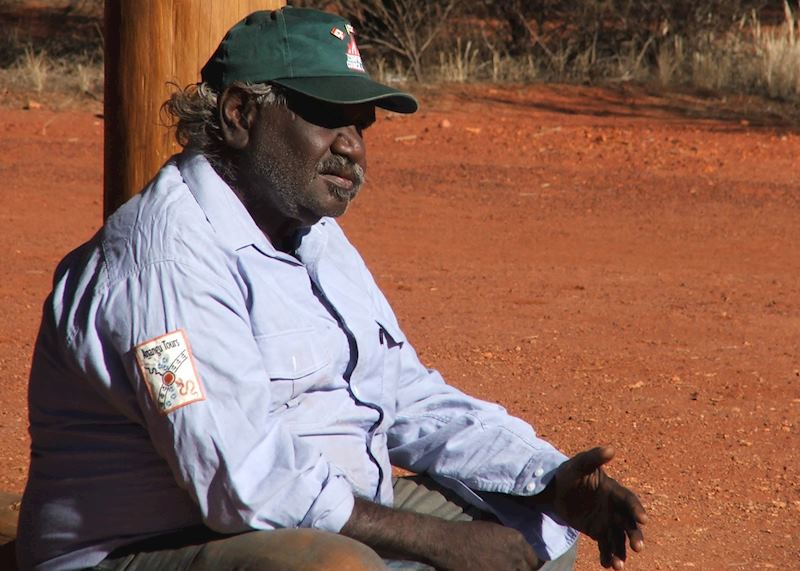
5. Walking in Aboriginal footsteps in Western Australia
Western Australia’s 125 km (78 mile) Cape to Cape Track, one of Australia’s official “Great Walks”, is a looker, no doubt. You mostly hug the coast, looking out onto the luminously turquoise Indian Ocean. Go in spring (September to November), and you’ll be distracted from the ocean views by the canvas at your feet: pink and purple splashes of wild orchids, the banana-yellow of acacias, and the bright green of scrub careering to the edge of granite cliffs. It’s also Wadandi country, land that has been trodden for thousands of years by Aboriginal people and part of a local network of bibi (paths).
We can arrange for you to complete the bulk of the walk in four days, with the bonus of gourmet picnic hampers and a stay in an exclusive retreat. You’ll take in features such as Ngilgi Cave, a karst cave system and one of several in the area that have profound significance for the Wadandi people. The route also includes coastal lookouts over renowned surf breaks, forests of towering karri trees, and beaches where you can stop to swim.
Get me there: This two-state trip pairs WA’s Great Walk with another: Tasmania’s mountainous, four-day Maria Island walk. Along with being a wildlife sanctuary and former convict site, the island is a repository of Puthikwilayti history that’s slowly being uncovered.

6. The sound of Dreaming spirits in Western Australia
There’s something about the sound of the didgeridoo that goes straight to your gut, that sounds wholly of the earth, or what the earth would sound like if it could speak. I always feel like the instrument could put you into a trance with its pulsating, primeval drone. If you’d like to hear and see the didgeridoo at its most authentic and powerful, head to Western Australia’s Margaret River region to hear Josh Whiteland. A Wadandi man and adept guide, Josh leads you first on a tour of Ngilgi Cave (see above). The cavern system is a sight in its own right, with its melting-wax-like karst formations and gravity-defying helictites. But, it’s all brought to life as Josh tells you about the Dreaming spirits who first inhabited the cave and shaped its history, as well as the cave’s continuing centrality to local Wadandi people and its connection to Country.
As night falls, Josh begins to play, using his instrument to imitate the sounds of the bush, like animal calls. He might tell you about the history of the didgeridoo and its role in ceremonies, and how — despite becoming a touristy emblem of Australian Aboriginal culture — didgeridoos are, in fact, highly specific to certain groups of people, and can only be authentically made in certain places under certain conditions.
Get me there: Josh’s tour is only one of many jewels in this expansive trip that takes you from the outback of South Australia to the winelands of the Margaret River region, via the offshore wildlife cradle that is Kangaroo Island.

7. Painting classes under the gaze of Uluru
You’ll see Aboriginal art everywhere in and around Uluru, from hotels to restaurants, as well as in the Uluṟu-Kata Tjuṯa Cultural Centre. Although eye-catching, it can be hard to understand its true complexity, beauty, and meaning, or appreciate the skill that went to its creation. If art is something that already interests you, I’d suggest taking a dot painting class during your time here.
In an “en plein air” class (under a shelter), you’ll learn how to identify the symbols of tjukurpa (creation stories) in Aboriginal art, as well as try out brushwork techniques using acrylics. As you work on your own piece, your tutor will narrate lyrical tjukurpa in Pitjantjatjara, a local Anangu language, interpreted into English by a bilingual guide.
Get me there: This 90-minute class can be easily slotted into most trips to Uluru — like this classic trip themed around Australia’s icons , which includes time in Sydney and the Great Barrier Reef.

Further reading
- The Top End: 3 essential experiences in Australia’s Northern Territory
- The Kimberley by land and by sea
- Top 5 places to encounter wildlife in Queensland
- What to do in Australia: our highlights guide
- Live (it up) like a local: why stay in a luxury Australian private home?
Plan your trip
Tell us about your plans and one of our specialists will plan a unique trip for you...
Request our brochure, The World Your Way

Order your digital copy via email.
A day hiker’s guide to Australia’s Great Ocean Walk

May 29, 2024 • 8 min read

You've heard of the Great Ocean Road, but did you know you can also walk this stunning Australian coastline? © Sarah Reid / Lonely Planet
Cerulean waves crash into limestone cliffs and plump koalas doze in ghostly white gum trees on the wild southwestern coast of Victoria , a rugged natural wilderness within easy reach of Melbourne .
This windswept stretch of the Australian coastline is best known as the home of the Great Ocean Road . One of Australia ’s most iconic road trips, the scenic 243 km (151 mile) coastal route weaves through a patchwork of national parks and kangaroo-dotted farmlands towards the surreal limestone stacks known as the Twelve Apostles .
However, that's not the only way to soak up the sublime views: the region is also home to the Great Ocean Walk (GOW) , a 110km (68-mile) one-way hiking trail that links Apollo Bay to the Twelve Apostles.
Despite its close proximity to the Great Ocean Road in some sections, the GOW is a wonderfully wild walk that feels further removed from civilization (and traffic on the driving route) than it actually is. Hugging the coastline more closely than the Great Ocean Road, the GOW rewards hikers with more dramatic vistas and a deeper immersion into the region’s beauty.
The good news is that you don’t need to have camping gear or a full week set aside to experience it. While the GOW takes six to eight days in its entirety, it’s possible to tackle much shorter sections, making it accessible to those with limited time, fitness or mobility. With the help of a hire car and local shuttle services that cater to hikers, it’s even possible to get a GOW fix and be back in Melbourne in time for dinner.
Here’s our pick of the best day, and half-day, hikes along the Great Ocean Road from east to west.
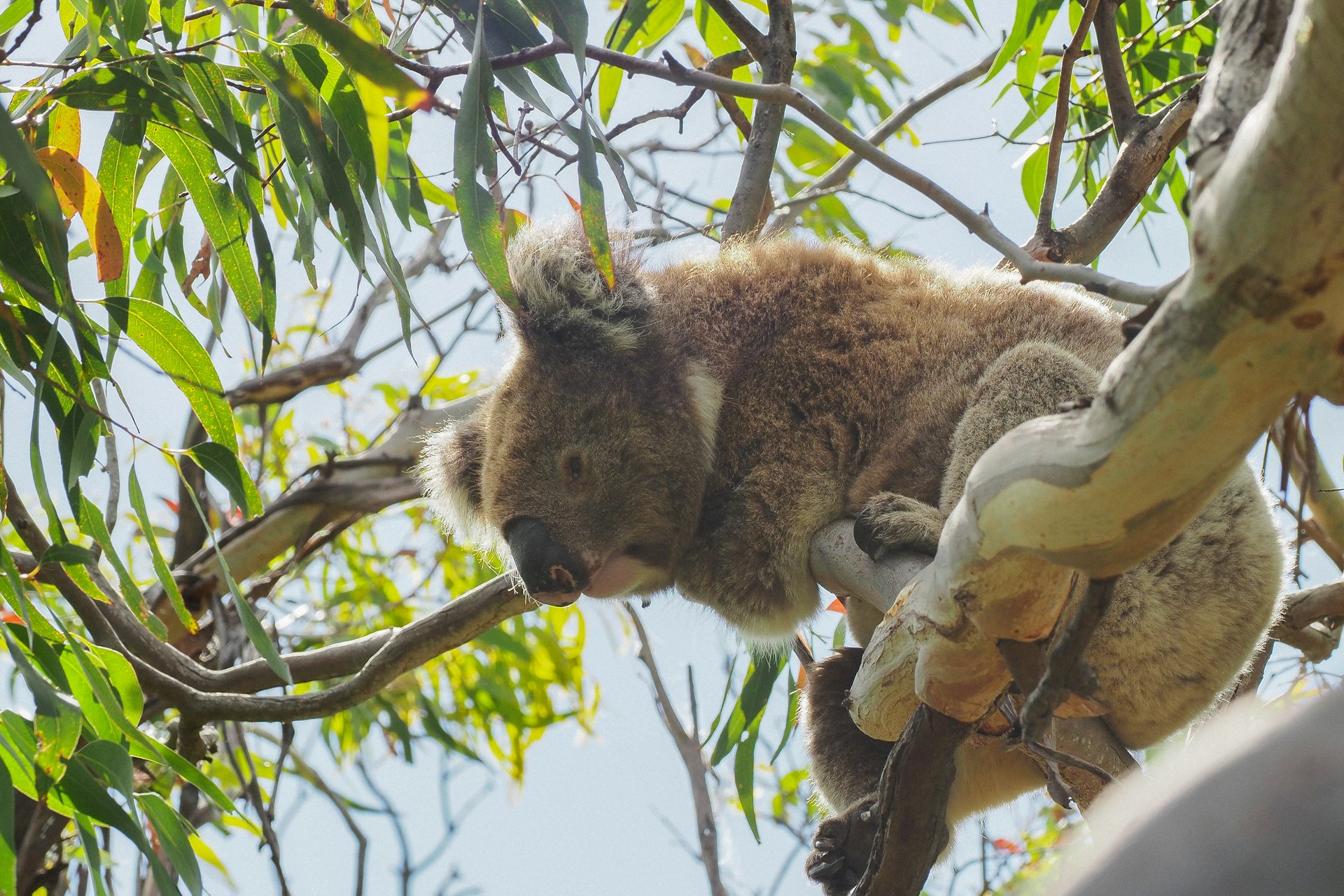
1. Marengo to Shelly Beach
Best for an easy ramble 4.4km/2.7 miles, 2 hours, easy to moderate
This relatively gentle hike offers a great taste of the Great Ocean Walk for travelers staying in Apollo Bay, where the GOW officially begins. There are three beach walking sections on this trail ending at the Shelly Beach picnic area, tucked up in the coastal forest behind the beach, making it essential to embark at low tide. If conditions allow, there are several additional spots you can opt to walk along the sand and rock platforms instead of sticking to the main trail tracing low cliffs. Swimming is possible in calm conditions.
How to do it: If you don’t have time or energy to do the walk both ways, leave your car at Shelly Beach picnic area and arrange for a shuttle to Marengo (3km/1.9 miles from Apollo Bay), where you’ll begin your walk. If you don’t have a vehicle, shuttles can be arranged at either end.
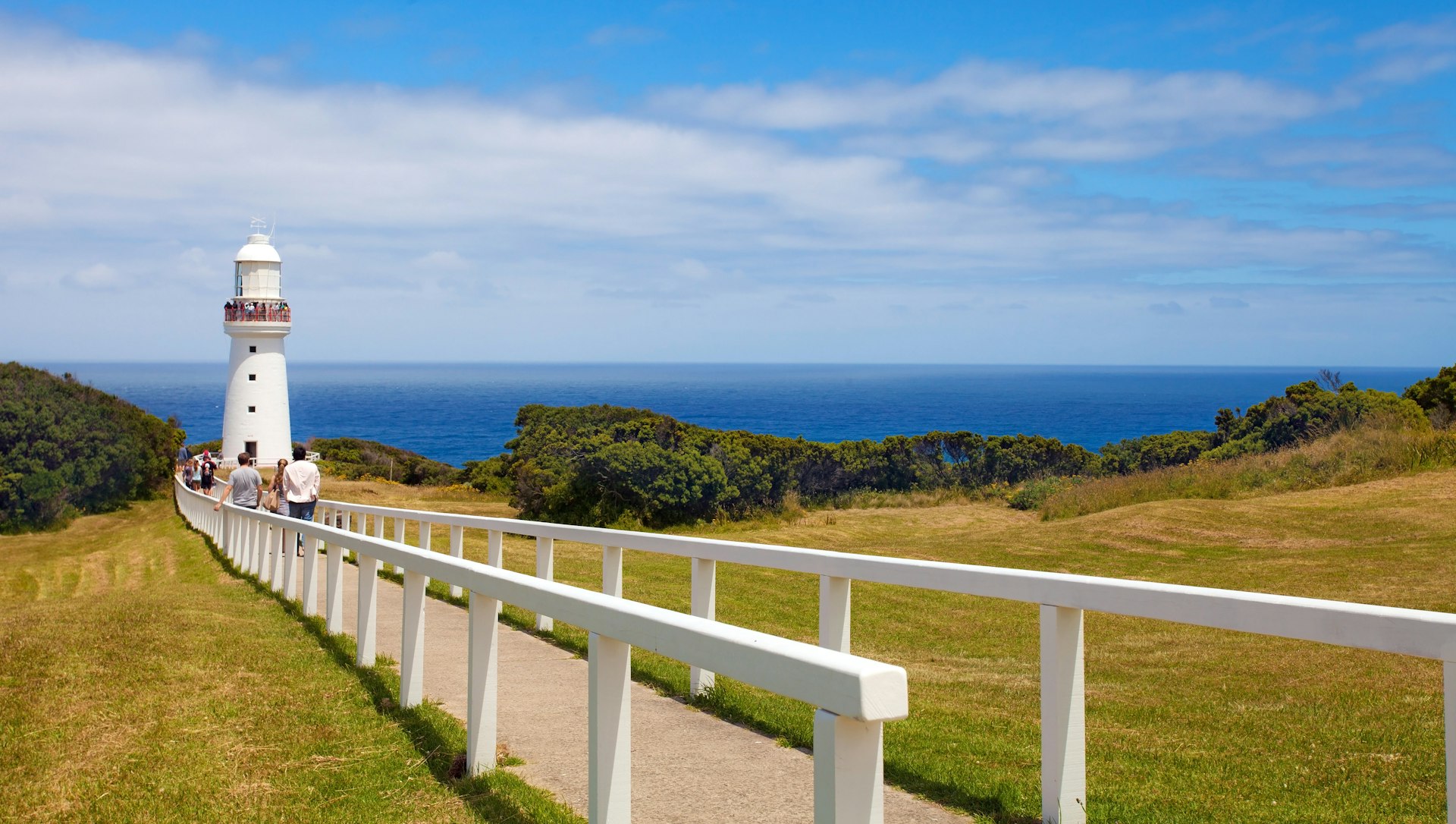
2. Blanket Bay to Cape Otway
Best for wild swims and history 11km/6.8 miles, 3-4 hours, moderate
This writer’s favorite section of the GOW takes you deep (or at least it feels like it) into the lush coastal forest of Great Otway National Park before popping out onto the beach at pretty Parker Inlet – a perfect spot for a swim. After crossing the inlet and rounding Point Franklin, the trail hugs the cliffs, offering stirring Southern Ocean views en route to Cape Otway, with another swimming option at Crayfish Bay.
Aim to arrive at Cape Otway well before 4pm to explore the Lightstation precinct (AU$10/adult), where you can learn the stories of the Cape and visit heritage buildings including the striking 1848 lighthouse once known to seafarers as the “Beacon of Hope".
How to do it: If you don’t have a car (or two) to leave at either end of this trail (Blanket Bay is 36km/22 miles from Apollo Bay), prebook a shuttle drop-off/pick-up.
Hire a car and check out the best road trips from Melbourne
3. Cape Otway to Aire River
Best for chasing waterfalls 9.8km/6 miles, 3-4 hours, moderate to difficult
The power of the Southern Ocean comes into dramatic focus when this trail opens up on the eroded cliff tops after about 2km (1.2 miles). If the sea is calm and the tide is low, you can opt to drop down to sea level and walk along the soft (read: challenging) sand of Station Beach for 2km (1.2 miles) before rejoining the main trail. There’s also an optional 2km (1.2-mile) return detour to Rainbow Falls, where colorful algae blooms along the vertical path of a spring-fed waterfall. Don’t miss the 19th-century Lightstation cemetery at the beginning of the trail.
How to do it: Prebook a shuttle drop-off/pick-up, or leave a car at either end of the trail. Cape Otway is 27km/16.8 miles from Apollo Bay.
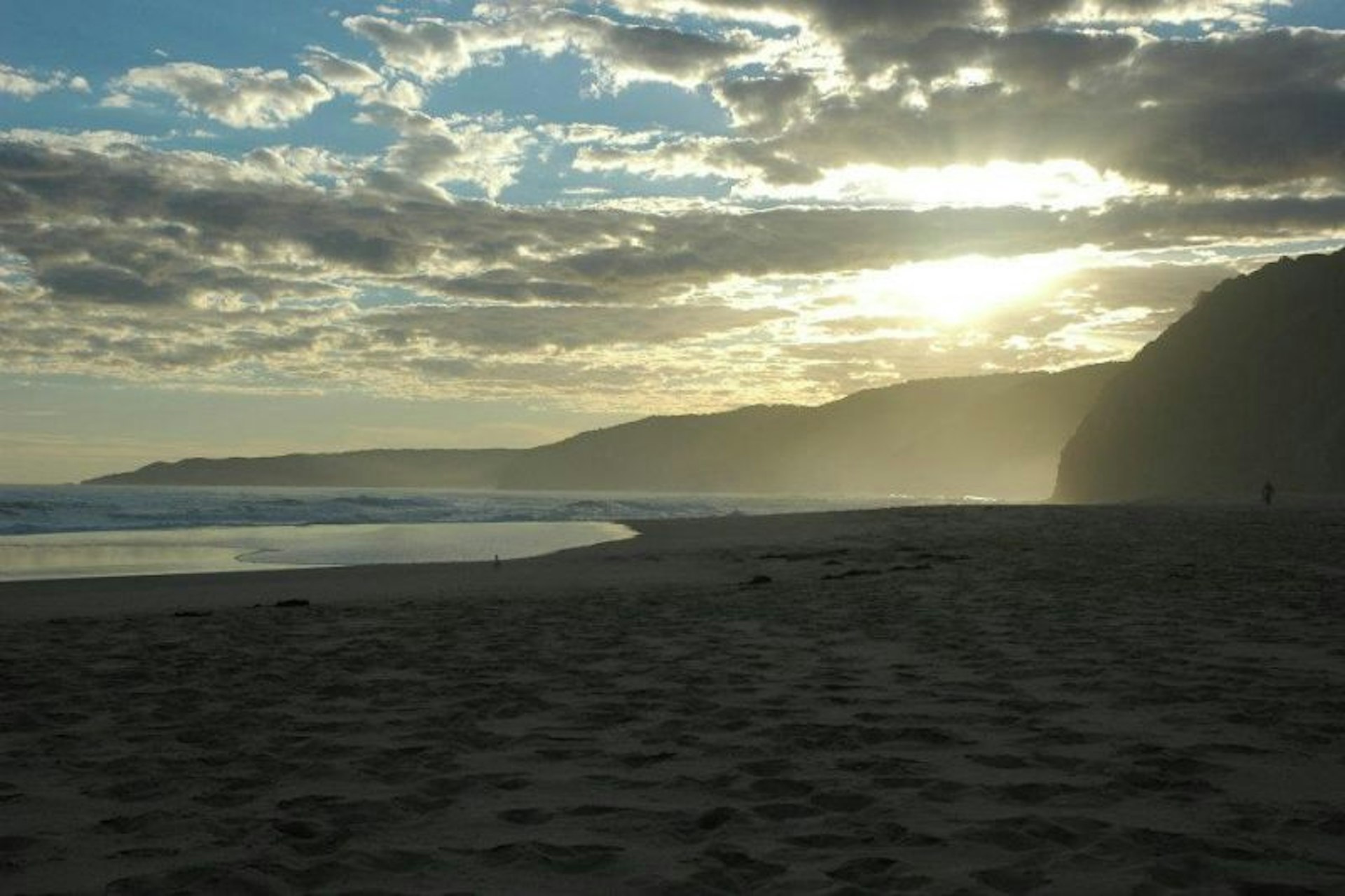
4. Castle Cove to Johanna Beach
Best for koala spotting 6.3km/4 miles, 2 hours, moderate
It’s possible to spot koalas and other native wildlife including wallabies, kangaroos and echidnas along the entire GOW, but sightings of Australia’s most iconic marsupial are particularly common on this leg, which begins with a superb lookout towards the cliffs of Rotten Point. The trail winds along cliffs and through prime koala habitat (don’t forget to look up!) before dropping down onto the golden sands of Johanna Beach for the final 2km (1.2 miles), which can feel like double that length in the soft sand. Powerful waves and strong currents make swimming risky – the safest spot is generally in front of the vehicle-accessible Johanna Beach GOW campground.
How to do it: If you don’t have a car (or two) to leave at either end of this trail (Castle Cove is 33km/20.5 miles from Apollo Bay), prebook a shuttle drop-off/pick-up.
Save this guide to the best national parks in Australia
5. Wreck Beach
Best for maritime relics 2km/1.25 miles, one hour, moderate
Nearly 700 vessels are thought to be submerged along the 130km (81 miles) stretch of coastline between Cape Otway and Port Fairy, also known as the Shipwreck Coast. This short walk (low tide only) takes you down 350 steps to the rocky beach where the rusting anchors of the Marie Gabrielle (wrecked in 1869) and the Fiji (wrecked in 1891) are haunting reminders of how treacherous the Southern Ocean can be. If conditions permit, you can make this walk a circuit by scrambling over the rocks past the Fiji anchor and connecting with the GOW trail for the return walk to the car park. Leave your swimwear behind – this rocky beach isn’t ideal for a dip.
How to do it: Drive to Wreck Beach car park or book a return shuttle to this remote area, 38km (23.6 miles) from Port Campbell, the closest town to the end of the GOW.
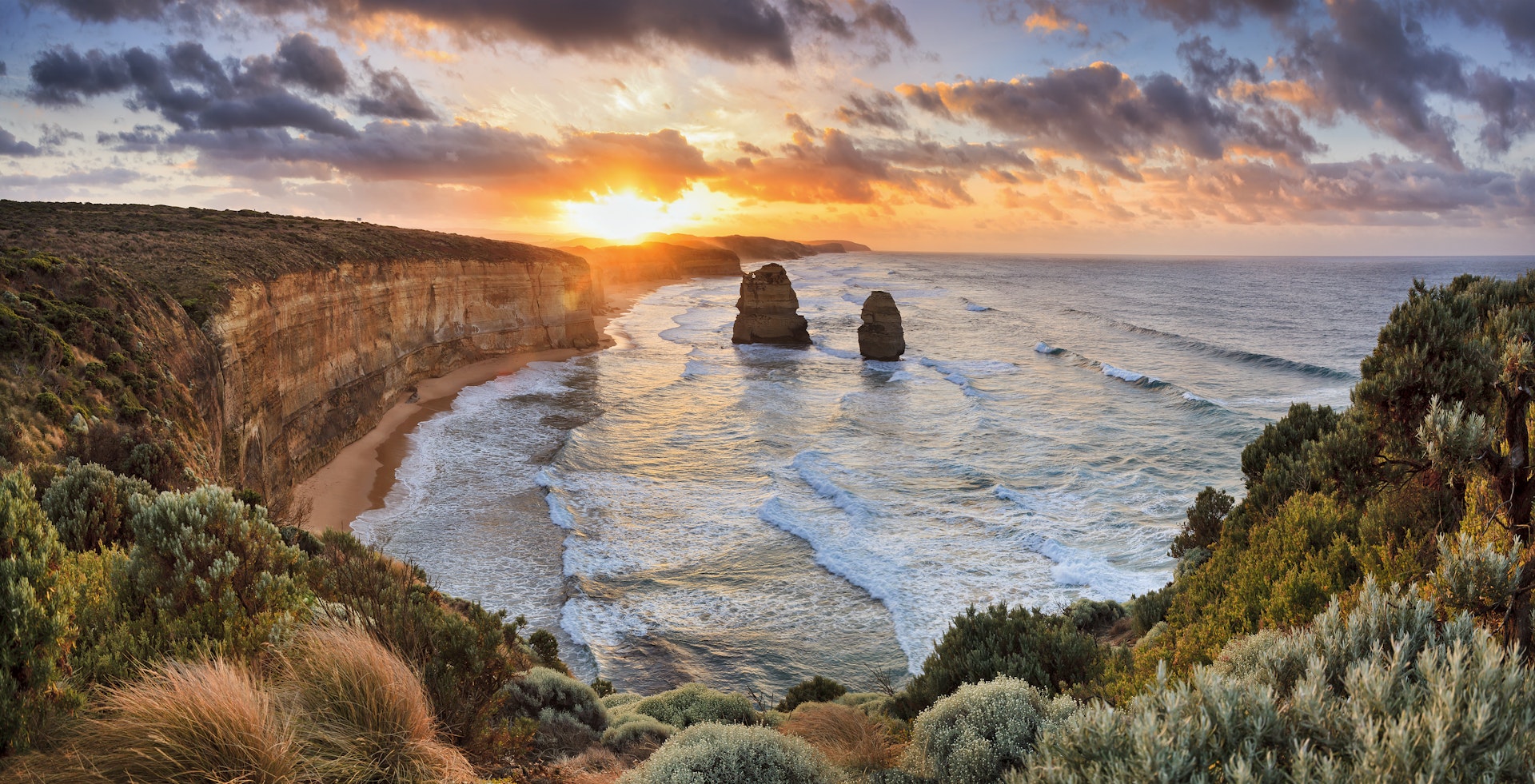
6. Princetown to Twelve Apostles
Best for admiring the Twelve Apostles 7km/4.3 miles, 2 hours, easy to moderate
It won’t be long before you get your first glimpse of the Twelve Apostles on this gently undulating, exposed clifftop trail. Set off as early as possible to beat the heat, and the day-tripper crowds from Melbourne. While only seven of these golden limestone pillars can be seen rising from the coastal shallows today, it’s an awesome sight that gets better as you hike closer. A viewpoint just east of Gibson Steps makes for a fine place to pause for a snack. Then take a short detour down the steps to savor the sea-level views before continuing onto the main Twelve Apostles viewing platforms (including the striking new Saddle Lookout) at the end of this trail – the terminus of the GOW.
How to do it: Base yourself in Port Campbell and drive or book a shuttle to the trailhead near Princetown (17km/10.6 miles from Port Campbell). It’s 11km (6.8 miles) to Port Campbell from the Twelve Apostles Visitor Centre.
Looking for something under-the-radar to see in Australia? Read on for some local favourites
7. Loch Ard Gorge Walks
Best for epic and accessible views 5.5km/3.4 miles, 2 hours, easy
It’s not technically part of the GOW (which officially ends 3km/1.9 miles east at the Twelve Apostles), but if time is tight or you have limited mobility, this trio of interconnecting, wheelchair-accessible trails in Port Campbell National Park takes you to some of coastal Victoria’s most memorable lookouts. The Geology Walk (900m/0.6 miles return) leads to the Razorback, a jagged hulk of limestone rivaling the Twelve Apostles. The Shipwreck Walk (1.4km/0.8 miles return) takes you along the rim of the main gorge, where the only two survivors of the Loch Ard shipwreck in 1878 dragged themselves onto its beach (not currently accessible); the cemetery where some of their shipmates were buried; and a lookout to Mutton Bird Island, where the Loch Ard met its fate. Hear the roar of the water surging into Thunder Cave on the Edge Walk (3.2km/2 miles return), which takes you further along the cliffs.
How to do it: Loch Ard Gorge car park is 8km (5 miles) from Port Campbell; self-drive or get a taxi.
Tips for day hiking on the Great Ocean Walk
- The V/Line bus runs from Melbourne to Apollo Bay daily, but local public transport is infrequent and taxis are in short supply; book shuttles in advance.
- If you’re hiring a car, ensure you can take it on unsealed roads, although a 4WD is not essential.
- All trails with unavoidable beach sections should be undertaken at low tide.
- Expect patchy mobile (cell) service on all trails.
- The GOW is remote – check the weather forecast before you go, but be prepared for all conditions.
- Bring plenty of drinking water and snacks; the only shop/cafe on the GOW is at the Cape Otway Lightstation.
- All one-way trails in this article can be completed as out-and-back hikes in a day.
- All three local snake species are venomous. Give these shy creatures space to move off on their own if you encounter one basking on the trail.
The writer traveled as a guest of Adventures in Good Company , which includes day hikes on the Great Ocean Walk, operated by AusWalk , on its Adventures Down Under tour. Lonely Planet writers do not accept freebies for positive coverage.
Explore related stories
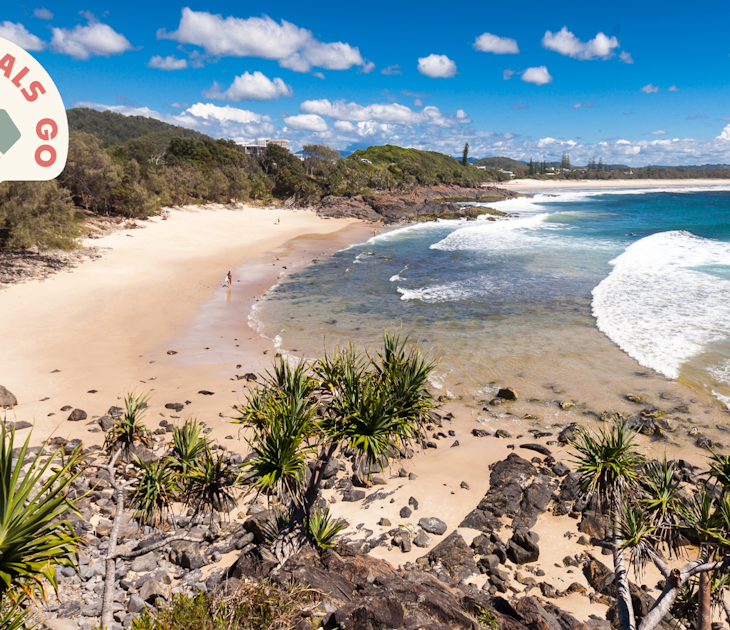
Feb 27, 2024 • 6 min read
Travel like a local in Australia with these under-the-radar vacation destinations.

May 21, 2024 • 5 min read

Mar 4, 2024 • 8 min read

Feb 12, 2024 • 10 min read
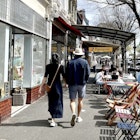
Jan 19, 2024 • 2 min read

Jan 5, 2024 • 20 min read

Dec 27, 2023 • 8 min read

Dec 2, 2023 • 7 min read
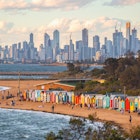
Nov 17, 2023 • 5 min read
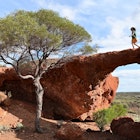
Nov 10, 2023 • 8 min read
- Book a room

North America
- Albuquerque
- Fort Lauderdale
- Indianapolis
- Los Angeles
- New Orleans
- New York City
- Palm Springs
- Philadelphia
- Salt Lake City
- San Antonio
- San Francisco
- Santa Monica
- Virginia Beach
- Washington, D.C.
Latin America + The Caribbean
- Buenos Aires
- Dominican Republic
- Grand Cayman
- Mexico City
- Panama City
- Puerto Rico
- Puerto Vallarta
- Punta de Mita
- Rio de Janeiro
Asia Pacific
Africa + middle east.
- Johannesburg
- Couples + Family
- Culture + Style
- Eat + Drink
- Health + Fitness
- Tips + Trends
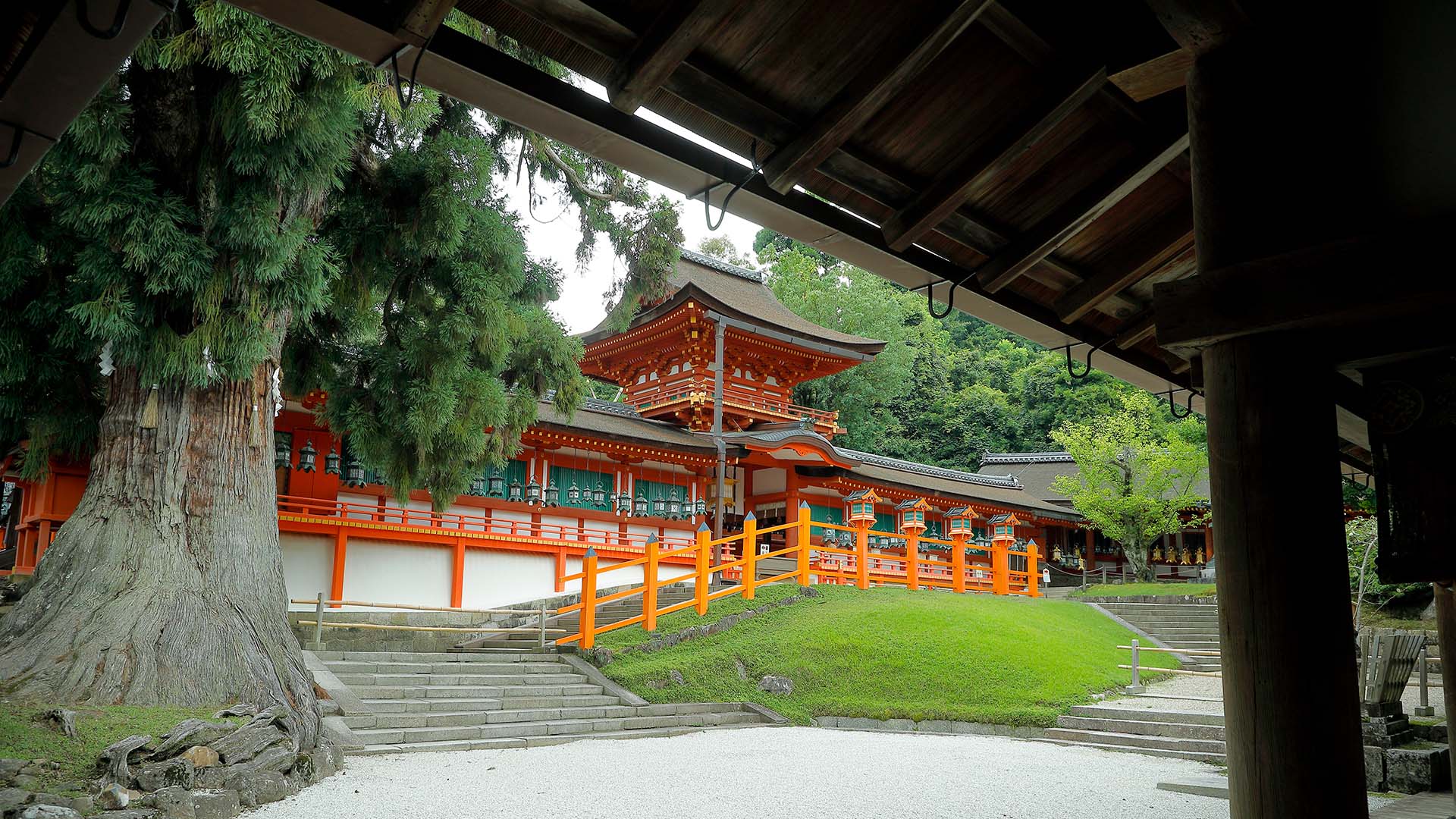
Explore Nara’s historic shrines and temples in this charming city steeped in history. (Photo: Marriott International)
3 Days in Nara: Discovering History and Traditional Cuisine in Japan’s Deer City
Nara carries the echoes of ancient Japan as it once served as the nation’s capital in the eighth century. It’s home to several UNESCO World Heritage Sites, including one of Japan’s most famous landmarks, Todai-ji Temple, and is a destination celebrated for its natural beauty, expansive parks and well-preserved traditions.
In this serene city, get up close and personal with Nara’s famous residents — the sacred sika deer that frolic freely in Nara Park. If you’re lucky enough to visit the park in springtime, watch it transform into a sea of white and pink during the vibrant bloom of the cherry blossoms.
On the charming streets of Naramachi, machiya townhouses dating as far back as the Edo period will whisk you away to another time. Local cuisine and traditional tea ceremonies also make a trip to Nara as scrumptious as it is educational.
Here’s your guide to making the most of your three-day journey through this historically rich city. As always, check for travel guidelines and closures before planning your trip.
Friday: Wander the Grounds
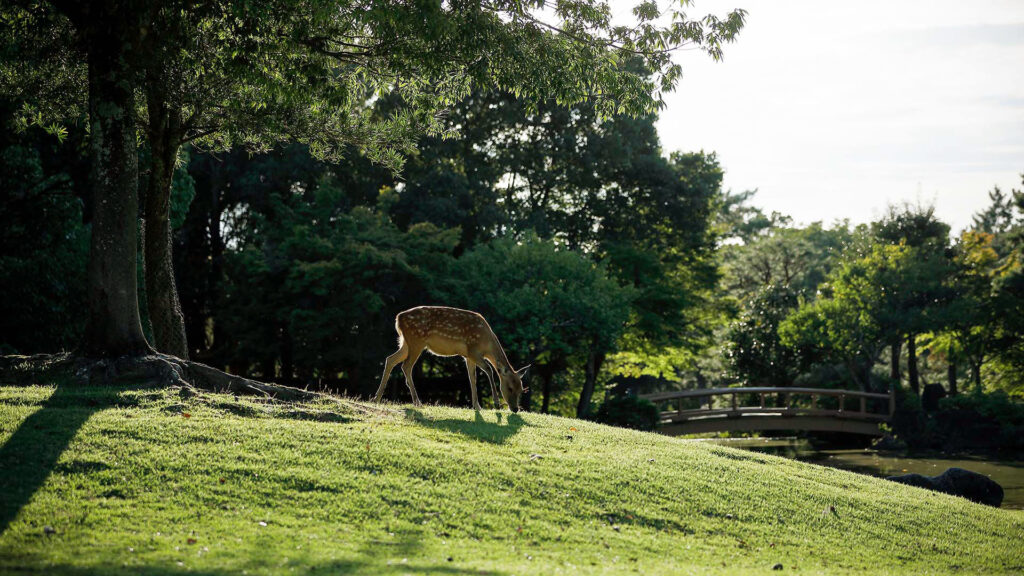
Start your day bright and early with a visit to Kasuga Taisha Shrine, with the option to observe the morning prayer held at 9 a.m. Marvel at the stunning vermilion lanterns that line the pathways to this awe-inspiring shrine.
Then it’s onward to Nara Park to stroll among the friendly deer . Be sure to purchase some deer crackers to feed them, but take note of where you’re keeping your treats. While they appear mild-mannered, the deer have no qualms about burying their noses in your pockets until they find their next meal.
After feeding the deer, it’s time to fill your stomach, too. Check out the cozy Mizuya Chaya, nestled conveniently within the park, for an affordable bowl of fried chicken and noodles.
Alternatively, visit Nagomi for an upscale teppanyaki experience — a style of Japanese cooking where meat and vegetables are grilled on a flat metal plate in front of guests. If you don’t feel like splashing out for the full works, the restaurant also offers bento boxes, where rice, meat and vegetables are neatly arranged into a box and served as a single portion.
Now that you’re fully fueled, make your way back to Nara Park to summit Mount Wakakusa. This scenic hike lets you take in the natural verdant beauty of Nara Park while spotting various historical sites like Todai-ji Temple and Kasuga Taisha Shrine.
The trail is beginner-friendly and not too steep, and you’ll most likely encounter more sika deer as you make your way to the top of the hill. The best seasons to climb Mount Wakakusa are spring and autumn, when you can catch the cherry blossoms and the brilliant orange-red fall foliage, respectively. The mountain is closed from mid-December to the middle of March, so plan your trip accordingly.
Alternatively, you can always explore the Nara National Museum to get a deeper understanding of Nara’s cultural history. The museum features an impressive collection of Buddhist sculptures, art and writings alongside archeological finds and bronze pieces from China used in ancient rituals.
Did you know that Nara is the birthplace of refined sake? It is said that monks at Shoryakuji Temple developed the technique of brewing Japanese rice wine back in the 13th century. Celebrate this fact by treating yourself to a late-afternoon aperitif of narazake (local sake) at the renowned Harushika Brewery Store .
To finish off your day, treat yourself to a dinner at a local restaurant within the narrow streets of the Naramachi neighborhood. Options include Harishin , which serves tempura (seafood and vegetables fried in a batter) in a 200-year-old house, or sampling some delicious grilled eel, also known as unagi in Japanese, at Edogawa Naramachi .
Saturday: Temple Tours
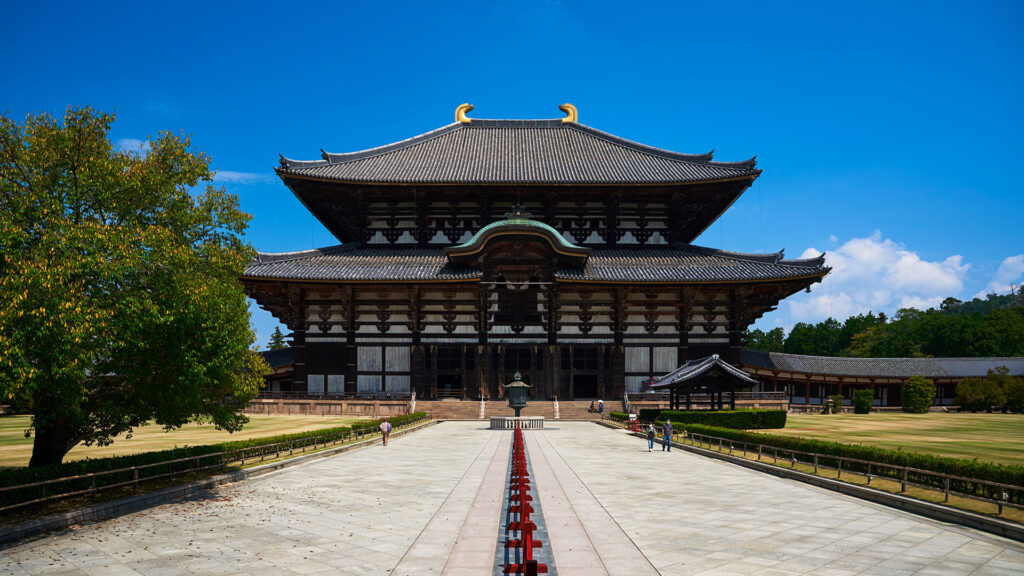
Nara boasts a tremendous number of historically significant temples, each more magnificent than the last. Spend your second day in the city visiting as many as you can, starting with a trip to two architecturally gorgeous UNESCO World Heritage Sites.
First up, Yakushi-ji Temple . Explore its stunning pagodas and beautiful gardens before taking a 10-minute stroll to the next UNESCO site, Toshodai-ji Temple . Enjoy your time exploring the grounds of this ancient temple created in the eighth century. Known for its serene surroundings and masterful wooden architecture, the main hall houses an important Buddhist statue, the Rushanabutsu, the bodhisattva of wisdom (a bodhisattva is a Buddhist deity that has attained enlightenment but delays their entry into nirvana to help others).
Enjoy a Japanese lunch near the vicinity of Toshodai-ji Temple. Visit either Yoshimura for soba (buckwheat noodles) with battered and fried vegetables or Nishida for a kaiseki (multicourse) feast featuring fresh and seasonal Japanese ingredients deftly prepared by its chefs.
Then it’s on to the next World Heritage spot, Heijo Palace Historical Site, a testament to Nara’s historical significance during eighth-century Japan. The palace was once the heart of the ancient capital, serving as its political head office. Wander through the grand audience hall to better understand what administrative life was like in those times. The grounds don’t just offer a window into the past; the palace gardens also offer a peaceful respite before you continue your journey.
Once you’re ready, head back to Nara Park. This time, you’re here to visit Todai-ji Temple , home to the Great Buddha Hall ( Daibutsuden ) — one of the world’s largest wooden buildings. Inside, you’ll find one of Japan’s largest bronze Buddha statues standing 49 feet tall.
After paying your respects, see if you can squeeze through the pillar with a hole at its base that’s said to be the same size as Buddha’s nostril — those who make their way through will receive enlightenment in their next life.
As night falls, treat yourself to some divine food at Yamatoen Honten , a casual gem that features game meat from the region, including venison and boar, alongside sashimi (sliced raw fish) — with the bonus of an all-you-can-drink option where you can have all the sake, beer or whisky you could want.
And if you want to keep the party going after dinner, head to Savant Bar , a local speakeasy for bespoke cocktails and a wide range of rare spirits.
Sunday: Escape to Nature
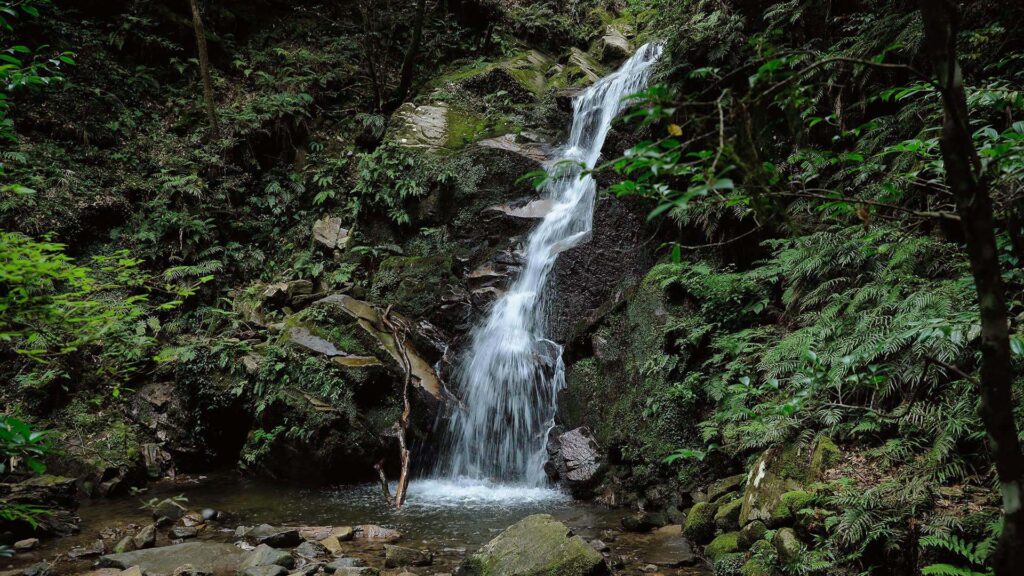
It’s your final day in Nara, but there’s still plenty to see and do. Embark on a journey to Kasugayama Primeval Forest where you can get lost in nature and breathe in clear, crisp air. This ancient forest, with its towering trees and lush undergrowth, offers a sense of calm before striking you with the beauty of Uguisu Waterfall.
Meander through well-marked trails that make navigating your way through the forest a breeze, and make a pit stop to have a packed sandwich, bento box or other food — either prepared by you or picked up from Le Case or any of the other restaurants in the complex near the entry to Nara Park — before heading back out to conquer the rest of your day.
After your nature immersion, return to Nara for a spot of afternoon tea in one of the many machiya houses (traditional Japanese townhouses that used to serve as both residence and place of business) lining the narrow streets of Naramachi, the quaint old town of Nara.
This is not just an English breakfast tea and scone; it’s experiencing a traditional Japanese tea ceremony at a local teahouse. These ceremonies showcase a formal preparation and serving of tea, a unique insight into transforming what some would consider a basic practice of drinking tea into a sacred experience made to savor every step in the process.
Try Sarusawa , which offers daily tea ceremonies at 4:15 p.m. But even if you miss it, there are plenty of traditional teahouses throughout the district, all with their unique spin on this cherished tradition. Make sure to book in advance so you don’t miss out.
If you have some time before or after the ceremony, pop into the Nara Crafts Museum to pick up some souvenirs and inspect some Japanese crafts, including traditional woodwork, calligraphy and pottery.
Then return to Nara Park in the evening to visit Nigatsudo, a structure forming part of the Todaji complex perched atop a hill, for a panoramic view of the city at sunset, a poignant way to end your Nara adventure.
Head back down to Naramachi for a final dinner at one of the many restaurants, including Omoya, a restaurant known for its fusion of Japanese and French cuisines (ooh, là là!), or Awa Naramachi for a more traditional Japanese dinner of beef and local fresh vegetables.
This article was created in partnership with Time Out.
Related Articles
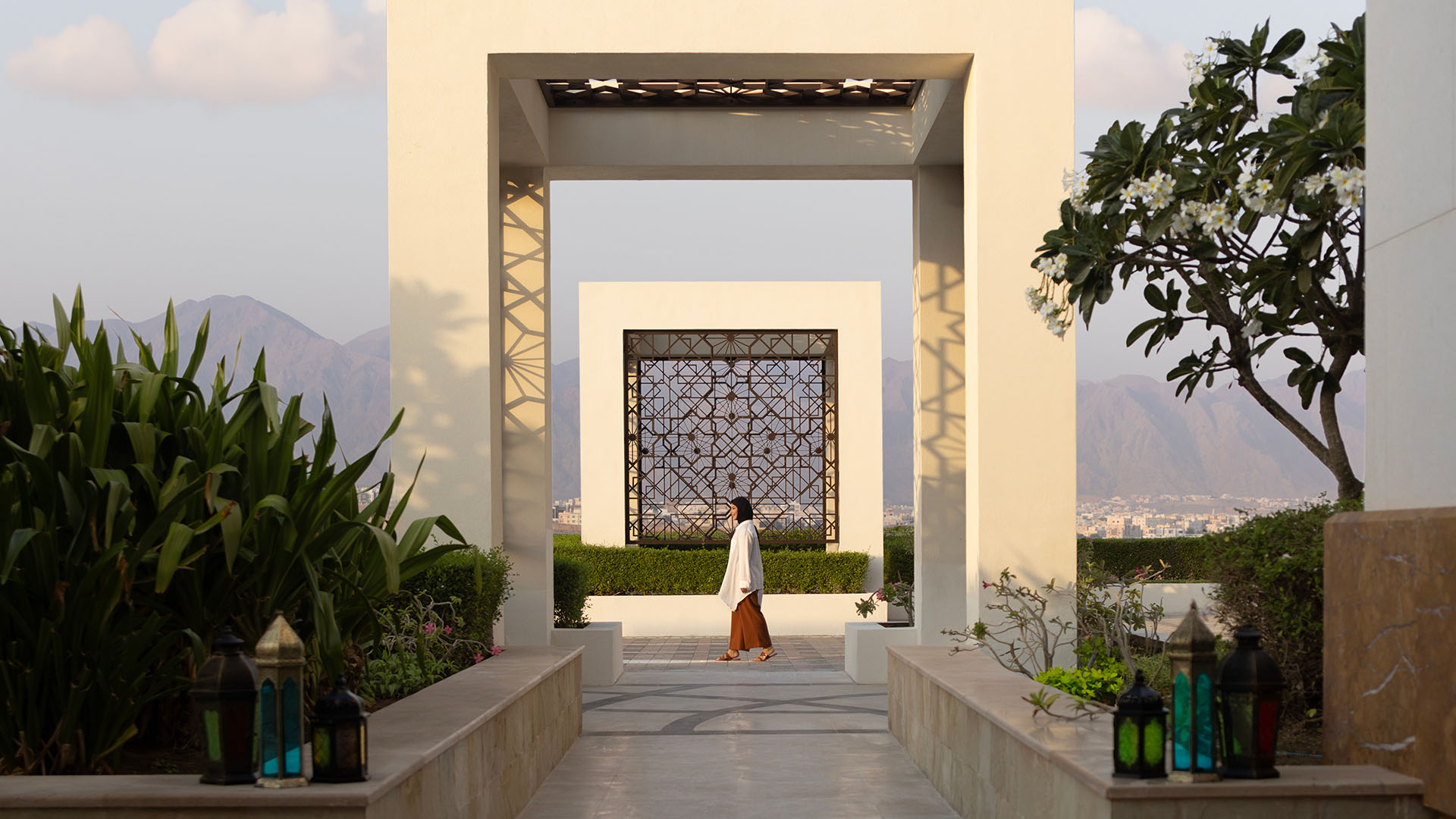
Weekend Getaways
5 hotels for spectacular weekend getaways in the middle east and africa.
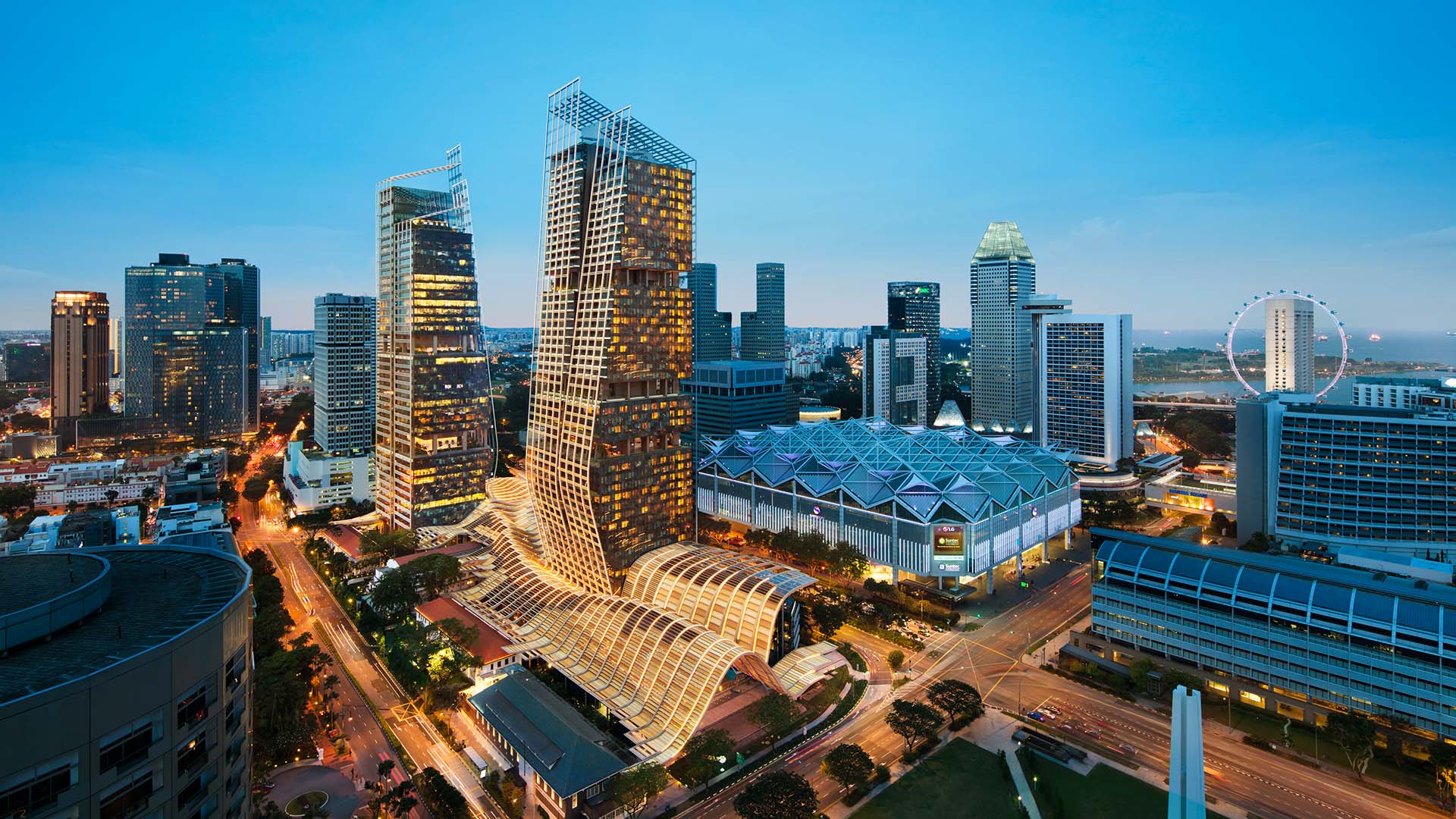
From Australia to South Korea: 7 Hotels for Weekend Getaways in Asia and the Pacific
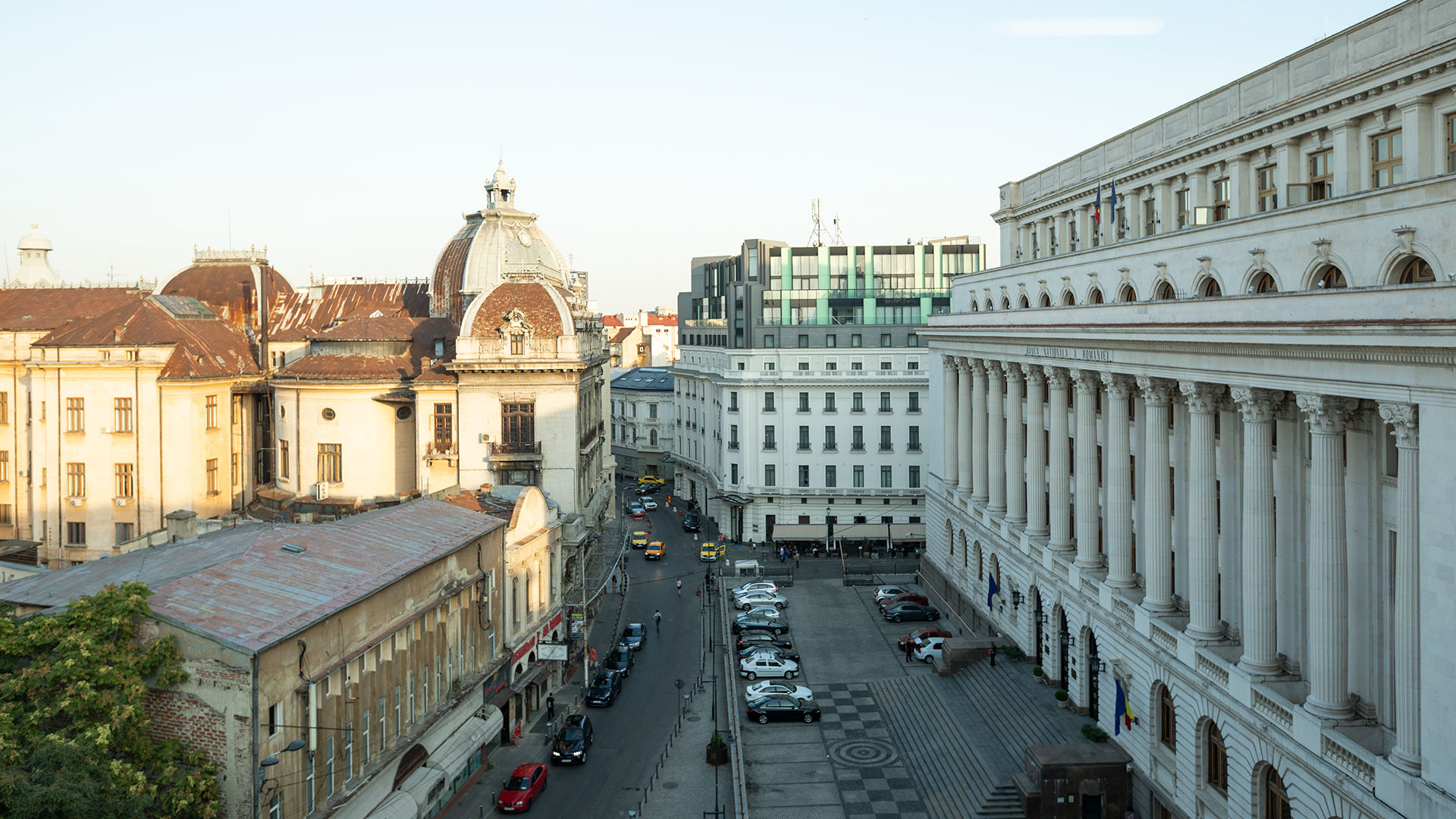
From Urban Oases to Seaside Retreats: 9 Hotels for a Weekend Getaway in Europe
More From Forbes
Father’s day gift guide 2024: the best private island vacations for dad.
- Share to Facebook
- Share to Twitter
- Share to Linkedin
Velaa Private Island in the Maldives, nestled within the constellation of islands that form the ... [+] Noonu Atoll.
No gift will stand out more this Father’s Day than the gift of a lifetime: a luxury vacation to a private island. These remote island vacations don’t sacrifice the elevated style and exceptional service that comes with luxury travel — they only exclude the throngs of tourists and commercial trappings of the most popular island destinations.
When scouring the globe for truly unique travel opportunities, these are the best private island vacations for Dad this Father’s Day.
North Island Okavango, Botswana - Father’s Day Gift Guide 2024
One of only four private tents within Botswana's North Island Okavango safari camp.
The captivating contemporary African design of North Island Okavango in Botswana blends style and comfort in four luxury safari tents, set against breathtaking views of a lagoon. Each tent includes a private plunge pool, indoor and outdoor showers, air conditioning and a fireplace. Wellness activities, desert tours, cycling, and flying safaris are just a few of the unique experiences on the menu at North Island Okavango. The 7-day Walk of Wisdom allows guests to spend time with the San people, the Indigenous bush scientists and nature masters of the Kalahari. A minimum of 25 percent of the amount paid for each safari goes directly to the support of the San people and wildlife conservation. All-inclusive rates start at $1,395 per night.
Cayo Levantado Resort, Dominican Republic - Father’s Day Gift Guide 2024
Beachfront villa at Cayo Levantado Resort in the Dominican Republic on the coast of Samana. The ... [+] resort website states they are the only luxury private island resort in the Dominican Republic.
Previously honored as the best resort in the Caribbean by TripAdvisor, the Cayo Levantado Resort is an all-inclusive property that occupies an entire island off the coast of Samana, on the Dominican’s northern shores. When he isn’t working out in the indoor or outdoor fitness areas, dad can enjoy spa treatments, outdoor meditation in a tropical garden, or simply take a walk by the beach. The six on-site dining options include Manaya, an international steakhouse with select cuts from Spain, the U.S., Australia and Japan. Cayo Levantado Resort earned the distinguished Four Star rating from Forbes Travel Guide for 2024, highlighting the excellent hospitality and experience the resort offers. Rates start at $665 per night.
Guana Island, British Virgin Islands - Father’s Day Gift Guide 2024
Sea view from a Guana Island cottage in the British Virgin Islands.
Accommodating only 35 guests at a time, Guana Island is a private island resort on 850 acres of lush wild beauty in the British Virgin Islands — perfect for dads who appreciate biodiversity, hiking trails through dense flowering vegetation, pickleball and endless water sports. The organic orchard supplies produce and herbs for the resort restaurant and spa treatments. Each of the 15 sea-view rooms and four villas has sweeping views of the Caribbean and the Atlantic, and are individually designed absent of televisions and phones. To ensure complete unplugging, there is no public bar, marina or any commercial facility on the island. The all-inclusive rates start at $995 per night.
Best High-Yield Savings Accounts Of 2024
Best 5% interest savings accounts of 2024, como parrot cay, turks and caicos - father’s day gift guide 2024.
Beach House at Como Parrot Cay in the Turks and Caicos
Set on its own private island, COMO Parrot Cay spans a mile-long beach and 1,000 acres of unspoiled foot-in-the-sand luxury. The teak and white-cotton accented accommodations span the rooms, suites, homes and villas. The cutely named “Love Pumpkin” villa is one of the most popular villas and homes on COMO Parrot Cay for the expansive main villa and guest house, and the lounge swings on the second floor. The luxury treatment pavilions in the COMO Shambhala Retreat overlook the North Caicos Channel. There’s also a jacuzzi garden, pilates studio and yoga pavilion with daily holistic wellness therapies on hand. The COMO Shambhala cuisine features nutrition-optimized options with healthful, pure ingredients. For dads who appreciate sustainable travel, farm tours and eco-activities abound at Parrot Cay. Rates start at $1,299 per night.
Velaa Private Island, Maldives - Father’s Day Gift Guide 2024
Inside the Velaa Private Island Nirolhu Private Residence
Contemporary luxury marries Maldivian culture to create an exclusive hideaway in the Maldives at the Velaa Private Island Maldives for jet-setting dads this Father’s Day. At the Velaa Golf Academy by Olazábal, dad can tee up on the seven-hole golf course, designed by Master’s golfer José Maria Olazábal, with one-on-one instruction from PGA professionals aided by the latest swing analysis technology. The Velaa Kids Club for children 4-12 is a playground where kids enjoy activities like Maldivian baseball, Koraa (an island treat hunt), and coral painting. The Velaa Kids Club also boasts the most extensive kids’ water park in the Maldives. Inside the Wellbeing Village , guests enjoy extensive wellness treatments, including holistic ayurveda treatments, mindfulness practice, and tailored nutrition with personalized menus and fitness classes for every level. Rates start at $3,150 per night.
Coco Plum Island Resort, Belize - Father’s Day Gift Guide 2024
The adults-only Coco Plum Island Resort, located 9 miles off the southern coast of Belize, features ... [+] an all-inclusive snorkel package starting at $3,579 per night for a four-night stay, May 30 - December 18.
With only 18 beachside bungalows and one over-water villa, Coco Plum Island resort is the adults-only private island vacation Dad has been waiting for. Opt-in for mainland jungle experiences like cave-tubing and zip-lining expeditions. All-inclusive snorkel packages start at $3,579 per night for a four-night low-season stay from May 30 - December 18.
Pine Cay, Turks and Caicos - Father’s Day Gift Guide 2024
Beachfront room at Pine Cay in the Turks and Caicos.
Pine Cay rests on a secluded private island, just a quick boat ride from Providenciales, on the edge of the world’s third-largest barrier reef. The 13 beachfront suites have all-inclusive rates and a treasure trove of experiences. The resort Aquarium is home to turtles and cranes, and a deep-sea fishing expedition gives you up-close views the eclectic marine life. Occasionally, guests can view the illuminating glow worms from a pontoon boat — a must for kids. Stargazing is spectacular during the evenings, while daytime adventures on dry land include cycling, hiking, tennis and yoga. Rates start at $1,800 per night.
Manta Island Resort, Belize - Father’s Day Gift Guide 2024
Manta Island Resort is located in Glover’s Reef Atoll, a UNESCO World Heritage site and protected ... [+] marine reserve.
Just a two-hour flight from most U.S. cities, Manta Island Resort is located in Glover’s Reef Atoll, a UNESCO World Heritage site and protected marine reserve. Adventurous dads will appreciate the intimacy of only 11 oceanfront bungalows and three 2-bedroom family-style villas. The deep-sea fishing is a draw for dads who enjoy fishing adventures; the wahoo, tuna and blue marlin are nearly always in residence. Kayaking, paddleboarding, snorkeling and complimentary water sports equipment make this an ideal family adventure destination. The all-inclusive packages start at $4,075 per night.

- Editorial Standards
- Reprints & Permissions
Join The Conversation
One Community. Many Voices. Create a free account to share your thoughts.
Forbes Community Guidelines
Our community is about connecting people through open and thoughtful conversations. We want our readers to share their views and exchange ideas and facts in a safe space.
In order to do so, please follow the posting rules in our site's Terms of Service. We've summarized some of those key rules below. Simply put, keep it civil.
Your post will be rejected if we notice that it seems to contain:
- False or intentionally out-of-context or misleading information
- Insults, profanity, incoherent, obscene or inflammatory language or threats of any kind
- Attacks on the identity of other commenters or the article's author
- Content that otherwise violates our site's terms.
User accounts will be blocked if we notice or believe that users are engaged in:
- Continuous attempts to re-post comments that have been previously moderated/rejected
- Racist, sexist, homophobic or other discriminatory comments
- Attempts or tactics that put the site security at risk
- Actions that otherwise violate our site's terms.
So, how can you be a power user?
- Stay on topic and share your insights
- Feel free to be clear and thoughtful to get your point across
- ‘Like’ or ‘Dislike’ to show your point of view.
- Protect your community.
- Use the report tool to alert us when someone breaks the rules.
Thanks for reading our community guidelines. Please read the full list of posting rules found in our site's Terms of Service.
National Geographic content straight to your inbox—sign up for our popular newsletters here
Why you should visit Victoria, Vancouver's little sister with a big history
British Columbia’s capital has grand architecture, First Nations art and Canada’s oldest Chinatown, all fringed by easily accessible wilderness.

On the southern tip of Vancouver Island, sailboats bob in Victoria’s harbour and chateau-style buildings stand beside leafy parks. The gentle pace of life in British Columbia’s compact capital is part of its appeal, yet it’s far from a provincial backwater. An easy journey from Vancouver, the city has excellent neighbourhood restaurants, breweries and coffee shops, while its museums and galleries showcase the region’s Indigenous heritage. It’s also surrounded by wild landscapes and makes a natural jumping-off point for whale-watching.
Presiding over the harbour, the British Columbia Parliament Buildings are the city’s centrepiece, an 1890s icon whose marbled interiors are open for free daytime tours. Across the street, the Fairmont Empress is one of Canada’s grandest hotels, with Elizabeth II and Rudyard Kipling among its storied guests. Afternoon tea in the opulent Lobby Lounge is one of Victoria’s quintessential experiences.
Through first-class exhibits, the Royal BC Museum delves deep into the province’s natural past (look out for the life-sized woolly mammoth), as well as its rich First Nations heritage. There are more than 225,000 artefacts in its collection, from masks belonging to the Haida people to traditional clothing from the Nlaka’pamux. Adjoining the museum is Thunderbird Park, named after the legendary bird and home to some of the museum’s most spectacular totem poles.
There’s much to discover in lively Downtown. Bibliophiles will love browsing the shelves at Munro’s Books , a shop housed in a former bank, with its coffered ceiling and spectacular painted textiles by local artist Carole Sabiston. The Mark Loria Gallery , meanwhile, specialises in contemporary Canadian Indigenous art.
Victoria’s Chinatown is the oldest in Canada, home to retro neon signs and restaurants such as Don Mee , which has served dim sum for more than 80 years. Fan Tan Alley claims to be one of the world’s narrowest streets; squeeze along the lantern-festooned lane for a range of quirky boutiques, from Saltspring Soapworks , which sells natural body-care products, to Just Matcha , which stocks premium-grade tea. Close by is Habit Coffee , a laid-back cafe with local art on its exposed-brick walls and Victorian suppliers on its menu — stop by to pick up beans from Bows Coffee Roasters or teas from Earth’s Herbal, both based in the city.
There’s more BC produce on offer at Wind Cries Mary , a moodily lit Downtown spot where the province’s oysters, mussels and salmon prop up a menu of sharing plates and cocktails. On the harbourfront, Red Fish Blue Fish is the place to go for jerk fish poutine, a fiery take on the Canadian classic.
If brunch is on the cards, try John’s Place , a kitsch, old-school spot serving waffles, pancakes and ‘Bat Out Of Hell meatloaf and eggs’, or head for the bubblegum-pink Floyd’s Diner in James Bay, where asking for ‘The Mahoney’ will get you whatever takes the chef’s fancy. For a tipple, Downtown’s Citrus & Cane mixes killer cocktails with a tropical twist (try the ‘ooh dat’s spicy’, made with Sons of Vancouver chilli vodka), while Boomtown serves a raft of BC porters and pale ales in its beer garden.
But there’s no resisting the call of the wild, with the Juan de Fuca Marine Trail, Goldstream Provincial Park and The Butchart Gardens within easy reach of the city. Dallas Road is also worth a drive or cycle — start in Fisherman’s Wharf Park, near the harbour, and wind east for six miles past beaches, bays and Beacon Hill Park, home to the world’s tallest freestanding totem pole at 128ft, before calling at the Oak Bay Beach Hotel . It makes an elegant stop for a glass of wine from BC’s Okanagan Valley, with views across to the Chatham Islands. For whale-watching, try Eagle Wing Tours; between June and October is the best time to spot Victoria’s marine residents.
Three wildlife spotting adventures in Victoria
1. Juan de Fuca marine Trail Keep eyes peeled for black bears on this 29-mile route through dense forests, over river gorges and along secluded beaches. It takes three to five days to complete, and there are chances to refuel at rustic diners along the way.
2. Goldstream Provincial Park A naturalist’s paradise, this park has quiet forest walking trails, plunging waterfalls and a challenging climb to the top of the 1,375ft-tall Mount Finlayson, with bald eagles screeching overhead. Autumn sees the spectacular salmon run, too.
3. Eagle Wing Tours This family-run company offers whale-watching trips in the Salish Sea with a team of guides. Seeing a pod of orcas or a humpback is a true highlight of a trip to Victoria, but ospreys, sea otters and elephant seals can also be spotted among the craggy islets on these three- to four-hour trips.
Introducing Nat Geo Kids Book Bundle!
Related topics.
- CITY GUIDES
- CULTURAL TOURISM
- FOOD TOURISM
You May Also Like

10 whimsical ways to experience Scotland

The essential guide to visiting Scotland

Northern California’s oyster capital is a hidden gem

10 best things to do in Switzerland

A guide to Perth, Western Australia's revitalised coastal capital
- Environment
- Paid Content
- Photography
History & Culture
- History & Culture
- History Magazine
- Mind, Body, Wonder
- Destination Guide
- Terms of Use
- Privacy Policy
- Your US State Privacy Rights
- Children's Online Privacy Policy
- Interest-Based Ads
- About Nielsen Measurement
- Do Not Sell or Share My Personal Information
- Nat Geo Home
- Attend a Live Event
- Book a Trip
- Inspire Your Kids
- Shop Nat Geo
- Visit the D.C. Museum
- Learn About Our Impact
- Support Our Mission
- Advertise With Us
- Customer Service
- Renew Subscription
- Manage Your Subscription
- Work at Nat Geo
- Sign Up for Our Newsletters
- Contribute to Protect the Planet
Copyright © 1996-2015 National Geographic Society Copyright © 2015-2024 National Geographic Partners, LLC. All rights reserved

IMAGES
VIDEO
COMMENTS
Uluru, or Ayers Rock, is a sacred monolith and it one of the most famous places to see on a trip to Australia. You have two options for getting to Uluru. Option 1: Rent a car in Alice Springs and complete the 5-hour drive on your own. Keep in mind it's also 5 hours to get back, so that's a 10 hour road trip in total.
Australia & Pacific. Australia is the unexpected: a place where the world's oldest cultures share vast ochre plains, stylish laneways and unimaginably blue waters with successive waves of new arrivals from across the globe. Best Time to Visit. Best Places to Visit. 01 / Attractions.
3. Sydney, New South Wales. Australia's best city for outdoor activities. Sydney is rightfully considered one of the world's most beautiful cities, where the natural splendor of cityside beaches collides with incredible urban architecture, including the Opera House.
Car Rental: Car rentals are the best option for traveling around Australia. Campervans and Caravanning is still a very popular way to explore the continent. Prices for car rentals start at $25 per day and can go up to $100 per day for a premium car. We've used VroomVroomVroom when traveling Australia.
9. Feel ancient Australia in Kakadu National Park, Northern Territory. Kakadu is the perfect kind of middle of nowhere. It's the wild Australia that you might have already daydreamed about. Waterfalls bloom from rock, prehistoric crocodiles thrash the wetlands, lorikeets sing, and Aboriginal guides bring ancient rock art to life.
Start planning your trip Down Under with our first-timer's guide to travelling Australia. From the outback to the coast, there's nowhere quite like Australia. ... or want to travel when things are most affordable, here are the things to consider. ... Why Australia is the best place to visit Endless sunshine, sandy beaches and stunning ...
Guidebooks. Our worldwide travel correspondents bring you the best and most up-to-date coverage of over 7,500 global destinations. Get information on Australia Travel Guide - Expert Picks for your ...
Read about itineraries, activities, places to stay and travel essentials and get inspiration from the blog in the best guide to Australia. ... Best time to travel to Australia. You'll find reliably warm summers at the coast with regular, but brief, heatwaves in excess of 40°C. Head inland, and the temperatures rise further.
It's hard to find a wrong time to visit Australia. Winter is June to August, when most of Australia hits a low season. This is the time to ski in the Kosciusko National Park or on Victoria's Mount Hotham. It's also the best time to visit northern Australia. Between May and September the Northern Territory, northwestern Australia, and ...
The best time to visit Australia all depends on where you're going and what you want to do. The temperatures are warm year-round, but the best time to visit the Great Barrier Reef is in the summer or spring months. While this is considered the wet season, the rain keeps away the large crowds that flock to the coast in the drier winter months.
A Coast-to-Coast Guide to the Best New Things to Do in Australia Australia re-opened to American travelers on February 21 with a host of new restaurants, hotels, museums, and more. By Ashlea Halpern
Australia Travel Guide. This Australia Travel Guide aims to provide you with simple and stress-free travel planning information and inspiration for planning a trip to Australia. On this regularly updated page you will find links to useful posts on The Trusted Traveller, budget information, details on types of accommodation available ...
Deals and travel packages. View more. Visa and entry requirements FAQ. ... First trip to Australia? No worries! Our Beginner's Guide has everything you need to know for the ultimate trip Down Under. ... Why Australia is the best place to visit. A handy guide to the Australian lifestyle.
Expect basic amenities like free Wi-Fi and self-catering facilities. Only some hostels include breakfast. For those traveling with a tent, a basic tent plot without electricity starts around 7 AUD, though most are 10-25 AUD per night. For budget hotels, expect to spend 100-120 AUD per night for a two-star hotel.
Australia Map. Adventure & Hiking Holidays In Australia. Australia Road Trip Guide. Australia Travel Tips. Barossa Valley Travel Guide. Melbourne Travel Guide. Sydney Travel Guide. Kangaroo Island Travel Guide. Other Places To Visit In Australia.
Sydney. #6 in Best Places to Visit in Australia and The Pacific for 2023-2024. Located in New South Wales near the foothills of the majestic Blue Mountains, Sydney is part fast-paced metropolis ...
2-Week Travel Itinerary for Australia: Sydney to Adelaide. 1.Sydney, 2.Canberra, 3.Melbourne, 4.Great Ocean Road, 5.Adelaide. See the best of Australia's metropolis cities on this 2-week itinerary around the southeast coast! You could start this itinerary off in either ofthe major cities, Sydney or Melbourne.
Australia Travel Guide. The most popular image that comes to mind when people envision travelling to Australia is the natural scenery. Cities bathed in sunlight, golden surf beaches and the vast, red outback all more than live up to the expectations. However, the lesser-known areas also provide enormous benefits.
Best of Australia. 4.7 (28 reviews) ... given how massive Australia really is. Our guide, Tamar, was an absolute sweetheart, knowledgeable, well travelled and very professional. ... Guides. Australia Travel Guide | All You Need to Know; Best 4 Week Australia Itineraries 2024/2025 (with Reviews) Discover TourRadar.
We would like to show you a description here but the site won't allow us.
The 20 best australia travel guide books recommended by The Philadelphia Inquirer, such as Frommer's Australia and Eyewitness Australia. Categories Experts Newsletter. BookAuthority; BookAuthority is the world's leading site for book recommendations, helping you discover the most recommended books on any subject. ...
Aboriginal guide. 5. Walking in Aboriginal footsteps in Western Australia. Western Australia's 125 km (78 mile) Cape to Cape Track, one of Australia's official "Great Walks", is a looker, no doubt. You mostly hug the coast, looking out onto the luminously turquoise Indian Ocean.
Driving time from Melbourne: 4 hours 55 minutes. Driving distance from Melbourne: 386 km. Best for: Skiers and winter sports enthusiasts. Passing through Kinglake National Park and the stunning Alps of Victoria, Falls Creek presents a scenic drive with plenty of outdoor activities for the whole family to enjoy.
1. Marengo to Shelly Beach. Best for an easy ramble. 4.4km/2.7 miles, 2 hours, easy to moderate. This relatively gentle hike offers a great taste of the Great Ocean Walk for travelers staying in Apollo Bay, where the GOW officially begins. There are three beach walking sections on this trail ending at the Shelly Beach picnic area, tucked up in ...
With numerous limestone islands, cliff beaches, white sands, cute little beach towns, and the constant backdrop of the piercing blue Southern Ocean, it indeed lives up to its namesake and much ...
Nara's friendly residents roam freely in Nara Park. (Photo: Marriott International) Start your day bright and early with a visit to Kasuga Taisha Shrine, with the option to observe the morning prayer held at 9 a.m. Marvel at the stunning vermilion lanterns that line the pathways to this awe-inspiring shrine.
Como Parrot Cay, Turks and Caicos - Father's Day Gift Guide 2024. Beach House at Como Parrot Cay in the Turks and Caicos. Como Parrot Cay. Set on its own private island, COMO Parrot Cay spans a ...
1. Juan de Fuca marine Trail. Keep eyes peeled for black bears on this 29-mile route through dense forests, over river gorges and along secluded beaches. It takes three to five days to complete ...